Richard Stout - The Cave of Making
Patrick Healy
F.I.U. Amsterdam, 2018
Introduction
As part of the research for this study, on behalf of the Free International University, Amsterdam, and as a contribution to study of the Free International University World Art Collection, FIUWAC, I conducted interviews with the artist Richard Stout, who had donated works for the FIUWAC, and tried to explore how it was he saw his own work as a painter and his personal development The interviews allowed also a relatively recent account of Stout’s own thinking about his work and how he views the activity of painting today. Since this study concentrates almost exclusively on Stout as a painter, his personal view can serve as an introduction and a statement in itself.
Stout emphasized the performative quality of being a painter. In this sense he sees painting as an action, which requires practice. The action is not abstract; it is enacted at a certain time:what he would call ‘making a particular time’.
His recommendation for teaching is to encourage the student to find a conclusion in a fixed time, not to return to the work and try and constantly correct. Students need to pay attention, because if something false has entered and stays, it starts to gain authority, ‘and you build a shaky house that way’.
The process of painting then should be a true experience, like taking a walk, going through the forest. In his earliest studies the emphasis was placed on the idea of the experience of space. He was in fact directly inheriting the teaching of Hans Hofmann, Stout summarized his principal concerns since his days of study in Chicagom from the September, 1953, relatively rapidly.
He stressed that he emphasizes space in his work, and that he learned the value of breaking a surface apart in order to ' allow the energy within to rest and be interesting’.
This was a rupture with the conventions of display which came through the French tradition. Good examples were available in Chicago, such as, Bonnard and Vlaminck. Even at that time he was in a critical mode, and found what he saw as a weakness in Bonnard: the edges. It was for him significant that the edges were where the strength of the pictorial composition showed most, and not across the surface, where the painting always risked being full of holes and a void, which for Stout meant it had been reduced to a pattern.
Stout’s notion of the ‘real’, in his late adolescent work, was directed not to the idea of faithful re-production, but to an intense sense of working with the material of paint and seriously questioning the different strategies of display and conventions of pictorial representation which had gained ascendancy in the moderns. His notion of reality was really set against the idea of the artificial, or the sophisticating of a visual vocabulary.
He characterizes his understanding via remarks on Mondriaan, whom he sees as an artist searching for a solution, searching for the truth, whilst Cubists were looking for an adventure.
This can be explained, he suggested, as the essence of the problem for the modernist of 'visual' culture.
One can trace this back to a day in the late 19th century, for the purpose of argument, when Van Gogh painted his sun flowers, where it has been argued that the issue is the visual, and not the optical effect; with the further claim that painting is visually more expressive if it is treated for what it is, -a flat two dimensional medium.
Secondly the visual reality depended on structure and simplicity, that is the power to abstract into sensation the most intense affect and release them in a unified and organic whole that indicated a geometry of feeling.
The search in Stout's student days took him through struggles that can only be glimpsed.
Part of the work of any artist is the self-defeating frustration of failing to realize a conception in its very execution. He had approached the canvas as a window on a scene. The experience became more and more limiting, and as with naïf painting the ‘water would go out of the corners’. This effort to fix the paintings led him to an impasse.
The painting should be a release, not just the record of the tracks taken, he suggested he wanted the painting to be complete, a whole, but one that was now ready to literally sail into the open, that it should indeed be like a sail boat.
One can mark the literal fast forward in his thinking and practice as a student from a work of 1956, entitled Landscape with a White Sky, the first painting of his reproduced in a national magazine. He discovered the work of Malevich and had known Mondriaan. In Chicago he felt he was directly tacking the European tradition, but the real pull which left him conflicted was of the pair the American Graves and the Dutch Mondriaan.He remained oblivious to the appearance of Pollock, who had already been featured as a public artist in Life magazine. When speaking of his past Stout has a remarkable memory, and remembers it through his works and paintings as much as through individuals and experiences of the social.
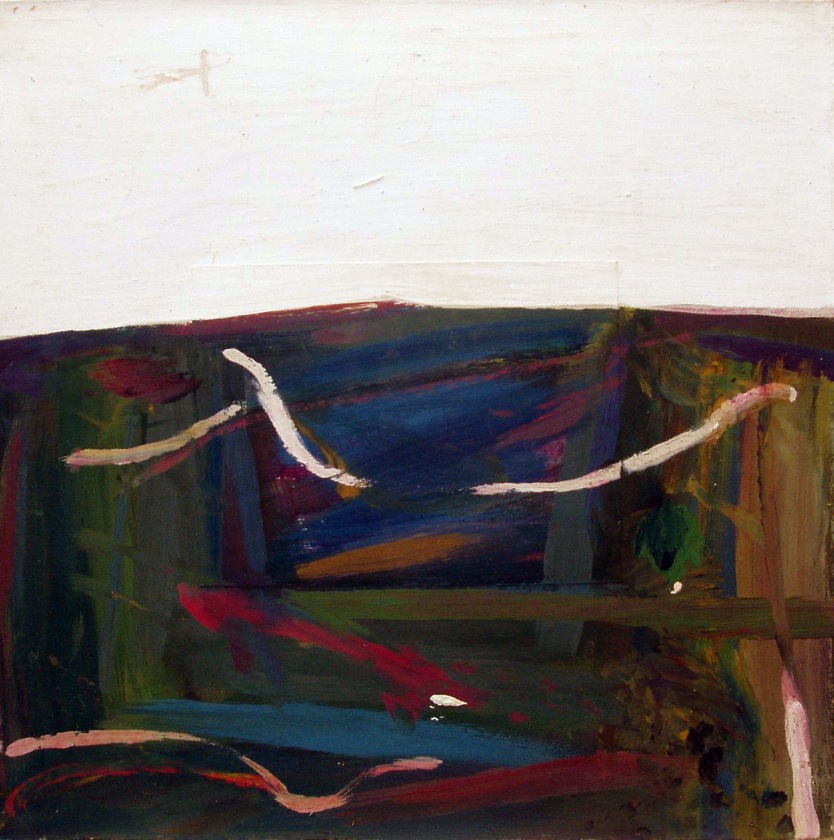
Part of the particularity of experience was indeed his visceral reaction to what he was doing, the tension of finding from the movements of corners into the canvas a whole, and at the same time leaving nothing ‘under the rag’. A punctilious parsimony, a bleak and cold calculation of the very spaces in which he worked pushed him towards greater freedom. He recalled from his student days that as students progressed in the class, they were moved to a smaller room, away form the main teaching area with a low ceiling and sky light, and they had to work in very tight areas, where it was hardly possible to step back and see what was being done. This intense claustrophobic setting pushed the young artist to seek a way out.
The note of suffocation and stress is hinted at in later comments. He needed to find a way out. The cluster of influences, the pressure of faculty, and the pressure to give an account in a certain way, to explain himself, was too demanding, and he sensed that it was an effort to rush the mysteries, the slow inchoate process which was stirring inside.
He had in an unusually precocious development set himself a task. This very explicit commitment did not run to the process itself. In fact he had little success in thinking of painting as something you do in a certain way. There was no primo pensiero, there was no predetermined way to go on, and remarked:“I never could have started with a predetermined way of making the surface. I did a lot of things and they came naturally like those big pastel drawings. I think the refinement of a surface comes slowly over time and from different directions.” But, Stout candidly admits that such a narrative of influence and formation hardly goes to the experience of his artistic life.
He had a fierce commitment to his method of creating a surface, painting wet in wet, in order to avoid what he saw as the over worked and dry surfaces that had become a kind of orthodox minimalism. He wanted a fat even waxy surface like a ripe plum, to discover the wetness of water, as he put it. In the most complex composition he understood, from his musical training, that the art of composition was in the transitions.
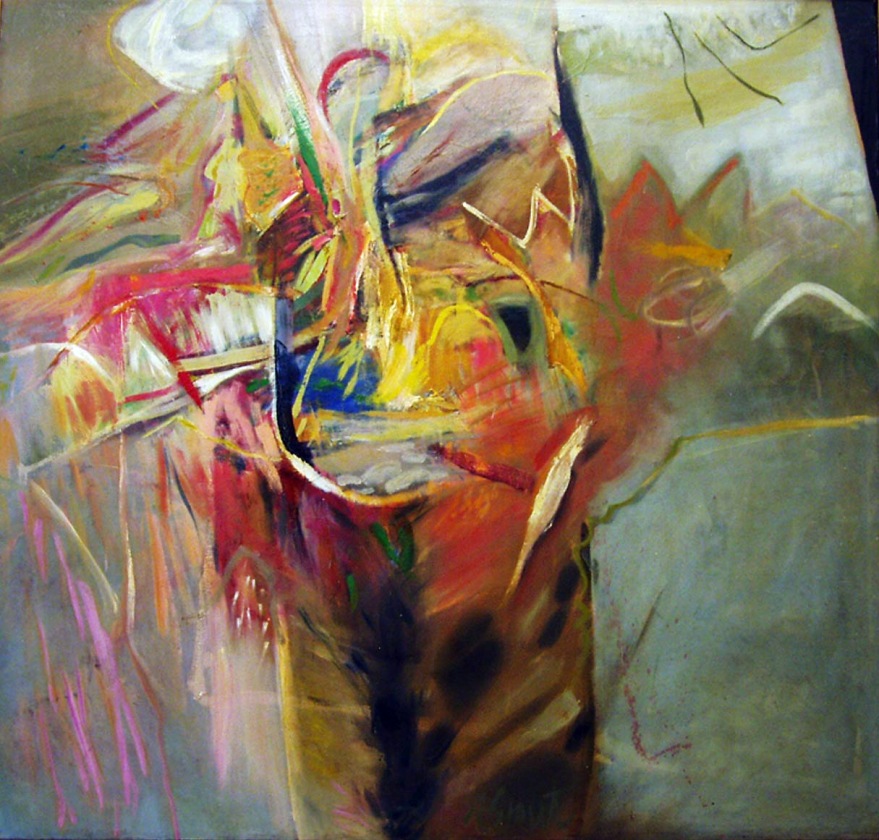
He was fascinated at this time by the work of Webern.It was the logic of movement which also moved towards abstraction, the need to simplify, and make clear, and at the same time to allow the active expression of color and line an unencumbered life. The art of transition was also the means to the wholeness of the surface, so that it was not made up of pieces, like a sculpture, whose unity was preserved by the contour or silhouette.
What becomes clear is that Stout is himself very much on the edge. He has not only the compression of his day to day life, but in his work, all through the late 50’s there is the dramatic crisis, which only the works communicate. He experiences within his confrontation of the surface a genuine swirling vertigo, which he stabilizes in his actions.
Each painting is a rescue from his own collapse, the insertion of the view is primarily the expression of the tension between edge and invisibility: “ The things I used to make the paintings bear are invisible to a large degree. They have to do with edge and invisibility. The paintings happen in between.
For me the painting is everything between the edges. It is not something that goes on and on. Any painter I admire, stops at the edge, even Mondriaan, going around the side, he did it in a very hesitant way, carrying and augmenting the colors at the edges, but even in the late shows he wasn’t satisfied that it could work out, to carry it around the picture.” There is a deeper point in this which needs to be explicated. What has stalked the painter, haunted him, through his classes is a fear of immobility, or the reduction of the expression to a mechanical collage of parts.
This 'not seen ',is the ‘invisible’, of which he speaks; and the creative search for this invisible, is the clearing within the path itself. The painter stands mute before things, is involved, and even enmeshed before any direct thinking. It is what Merleau-Ponty says about the struggle of a child to say a word, who mumbles and goes over the word with delight, half pronounced, and then the explosion of the expression itself, because the expression has found its home, its way to be.
What is over the horizon is the 'empty' it is that to which one wants to give shape.
Throughout there is a distinct feeling of the 'frontier', a search for what lies beyond. .
The painter is only the moment of involvement in that primary experience.
The time of which he had spoken, is nothing other than the time of movement, where the expressed becomes its expression.
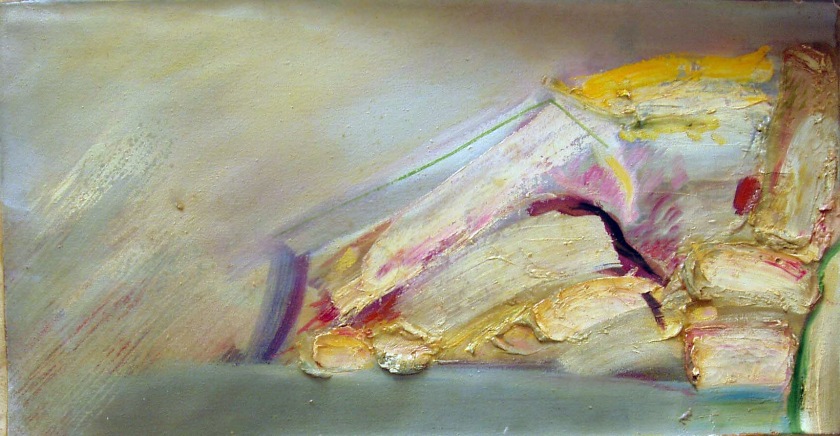
The image of expression here and the search for the whole helps explain Stout's constant return to the problem of working from the corners .
Stout recognizes that his painting is not a kind of meta-painting; only about how one understands the problem of abstraction and expression. His concerns with the edge were also in some way metaphors for the sense of life which he faced, what he tried over many years to track. This could be called a certain awareness of not being at home, and a quality of isolation, longing and stillness.
Even a relatively recent publication at the Beehive Museum (2010)stresses this dimension of Stout’s sense of the existential and fearful, which his encounter with space has deepened and hallowed. Thomas Mc Evilley has called attention to work from the mid 50’s which express a kind of muted sadness, and points to the fact that many works of these years present hazy or misty views of landscape , in a subdued palette of brown and grays sparked with mellow hues of primary colors. He cites a work Untitled – now known as Blue Gibraltar-from 1957-maintaining what he calls a soft focus and gently modulated palette but ‘ with increasing inner turmoil that cannot be clearly seen as it seems to transpire behind a filmy veil”
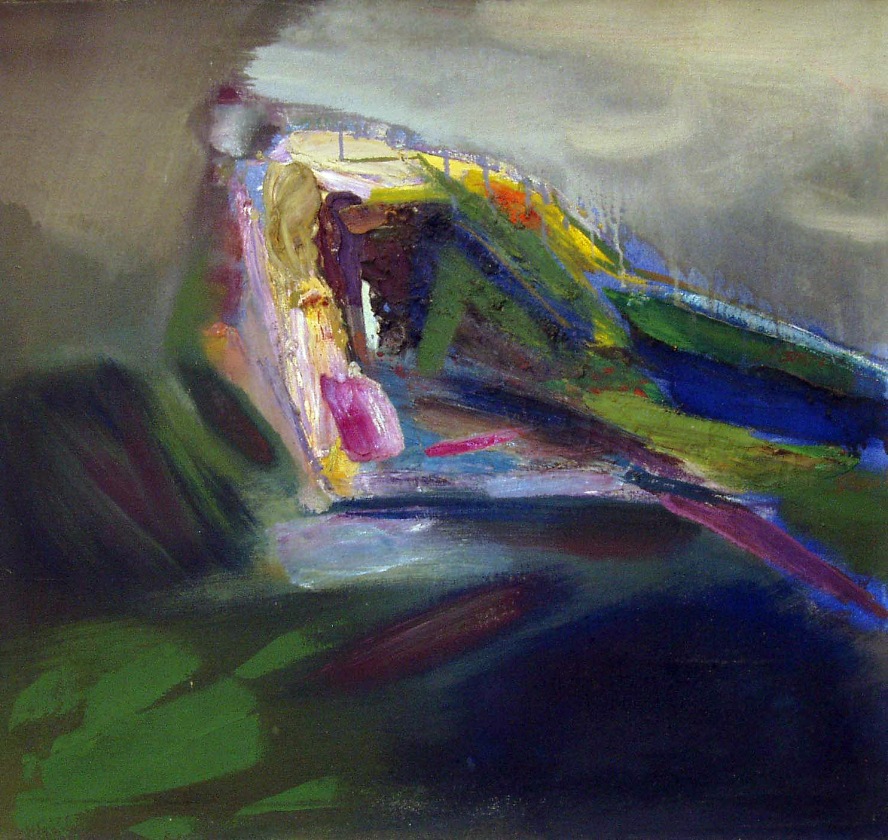
Mc Evilley also sees the modernist commitments of Stout, and his relation to the teaching of Hofmann, “…Stout’s oeuvre retains a shadowy sense of the Hofmannesque pictorial space in which he was trained-though he carried the push-pull principle to extremes in his near and far principle”( Approaching the limits of Space…pp.16-17) It is again strange how easy it is to occlude what is taking place within the abstraction to try and find its real referent.
Stout‘s thinking about the edge is an intensification of the formal consideration for the process of composition, that also triggers a way to track his commitment to meaning in the landscape and work of the late 50’s.
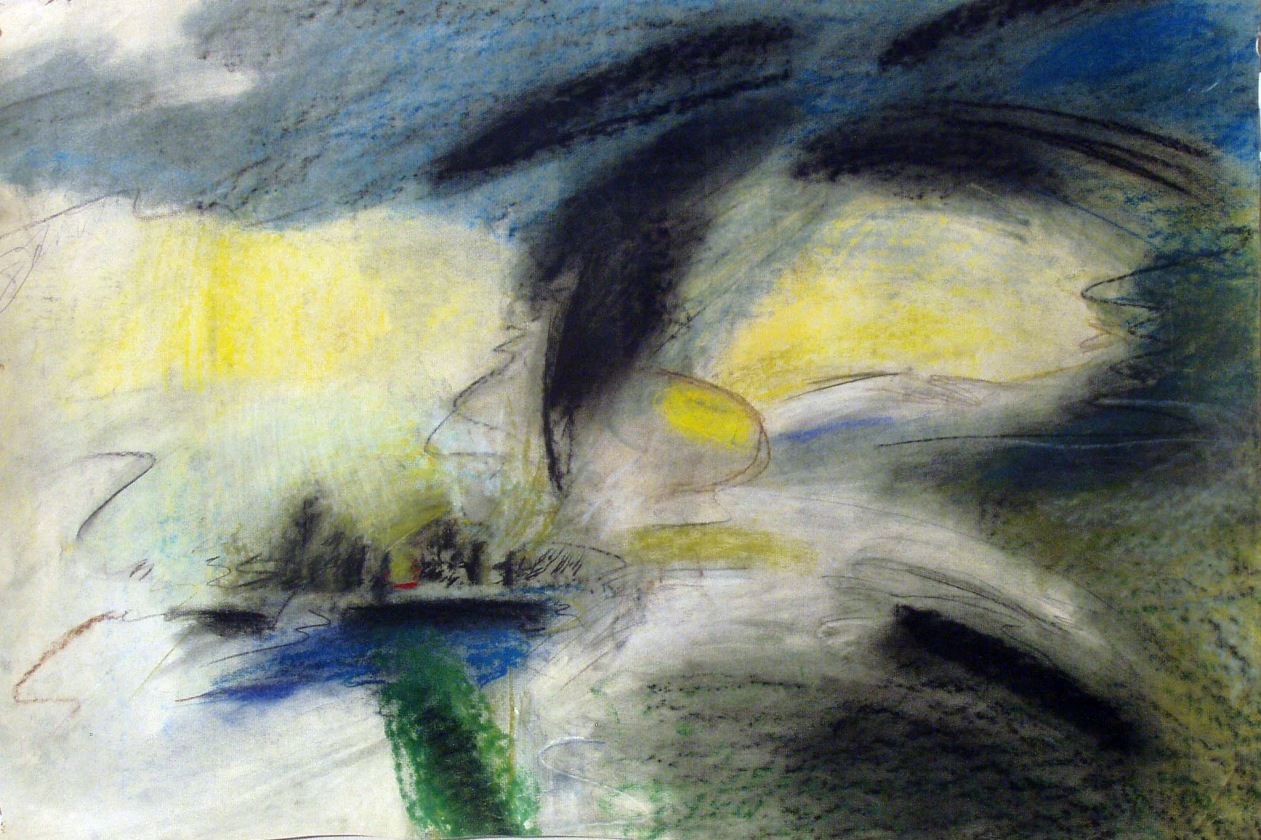
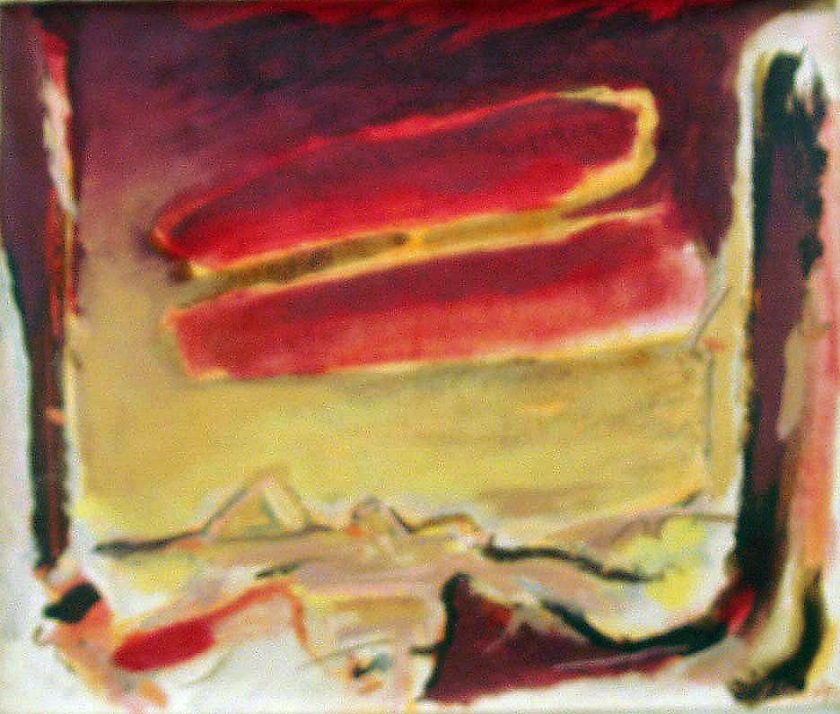
It is not the case that Stout relinquishes anything, rather he works with a constant variation and theme. The variations do not do anything other than exist as re-focalized parts of his story and search.
Thus,from 2003 there is a work of defiant scale and monumental grandeur which speaks of threshold. This is no longer the threshold that punctuates the experience of the city, and which underlies all physiognomy, but a vaster threshold between a sublime horizon of disappearance, the artist’s self extinction, and a finite and defiant assertion of the power of illusion ad construction. Part of that primal fear for the artist is being caught in the very process of habit and repetition. Many of the breaks in Stout’s development are literally confrontations with his own deepest practice.
What remains strange of course is the engagement with landscape. His earliest works focused on interiors, and these inner worlds that fascinate him, are the specific interiors of his family life in Beaumont in Texas. There the threshold experience is related to the way the edges of objects and space contain powerful expressive energy for the artist.
There is a feature of Stout’s work which is a puzzle for a student.
There is no neat narrative story of Stout’s development. His beginnings are always intact.
He returns to them at various stages as he moves along the tracks he develops and re-capitulates what has taken place. One example of this must suffice for the moment, namely the shock of the work he produced in the early 1980’s, which was treated in a short lecture that is of considerable interest in terms of this problem of his own active re-working of biography and past, as again a work in creative relations in the sense of Hofmann, and here becoming almost reflexive: entering an intense loop of his own making. One could think of a fugual autobiography in paint. The higher third in the making is the artists own identity. It is precisely this 'coming-and-going' that a later commentator picks up on in considering Stout's development in the 1980's.
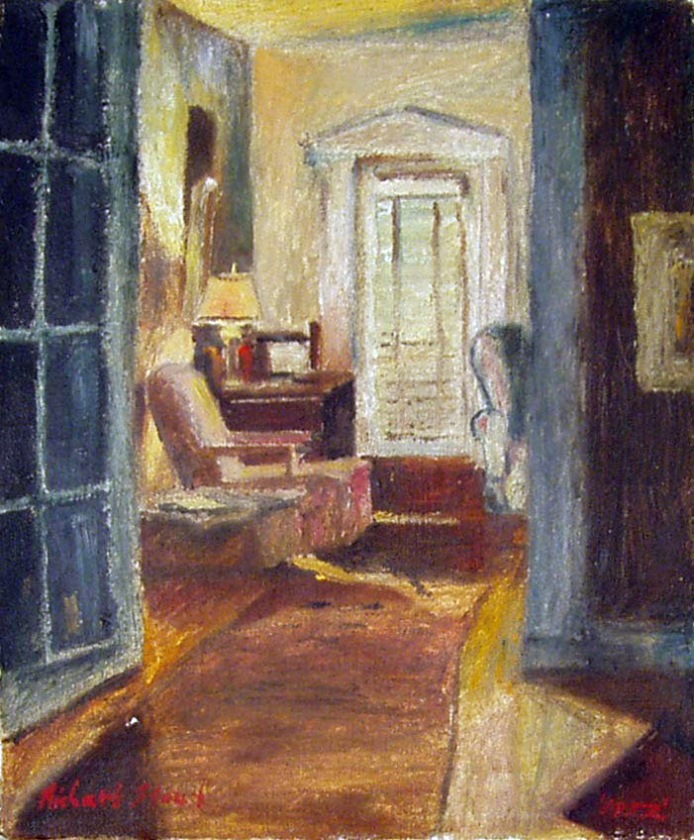
The lecture which is dated April 83, and survives in a typescript among the artists papers, observes that Stout ‘s recent paintings – early 1980’s-repeated two lessons in art, the unpredictable course of an active searching artist, and the seemingly contradictory tendency of the artist to rework his past ‘ particularly’ the spirit of his first serious work. The essay continues: “After two decades of essentially abstract and expressionist paintings Stout’s new figurative works are unexpected and jarring. Little matter that human images and landscapes began to emerge in his work over two years ago – i.e. 1981 –They simply do not prepare us adequately for the emphatic imagery of these dramatic, symbol-laden paintings With a second effort, however, familiar features begin to register –a sense of drama in the contrast of light and dark passages; a feeling for colors which evoke moods and mystery; a sensuous manipulation of pigment, and a preoccupation with content.
For those viewers whose acquaintance with Stout’s work goes back to his early mature works in 1955-7, the sense of recall will be more remarkable. The paintings of those years, like those of the winter of 1982-3 were dominated by landscapes and human figures, expressionistic in their distortions, charged with emotions and nourished in part by authors whose books are still available in Stout’s studio.
These books include Lautréamont Les Chants de Maldoror and Edmund Burke’s A Philosophical Enquiry into the Origin of our Ideas of the Sublime and Beautiful. The new paintings of figures and landscapes are different, of course. They are more representation, complex and thoroughly self-referential. Stout considers every figure to be a self-portrait every landscape a personal metaphor.” t flows backwards and forwards and the logic of events remain marked by this personal signature, even a kind of learned inter-iconic tension, which is only available from a deep familiarity with the work. The subtle shifts and the sudden swerving from catastrophe such as registered in the work of the early 80’s is also a kind of horror before the possible closure which early work brings about, a revulsion to the inevitable dead-ends that he has faced when coming to literally the edge.
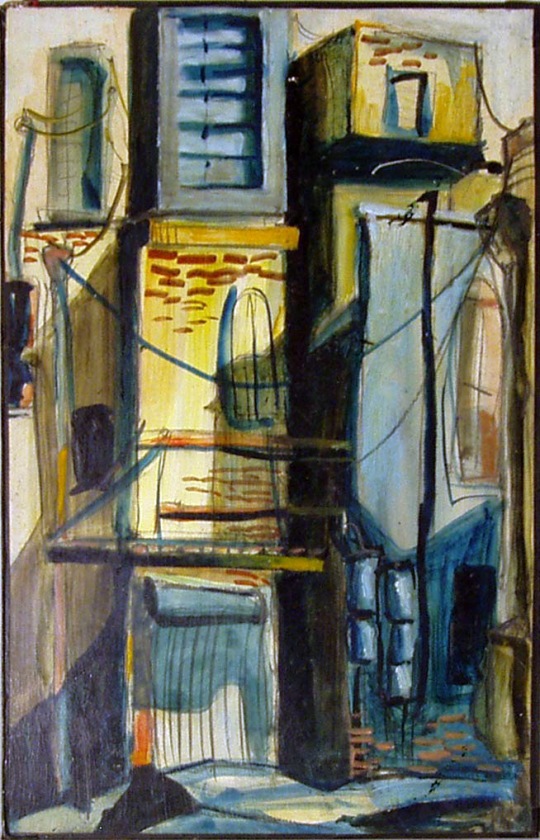
Here we can consider, for example, the very work of the 1950’s which become aggressively counterpointed in the early 80’s almost 30 years later: the themes are jagged and use figuration as a form of anarchic, and personal revolt. The figure paintings are in the words of the lecture typescript:”arranged to stress profound and often ambiguous psychological relationships of separation, liberation, rejection and linkage.”
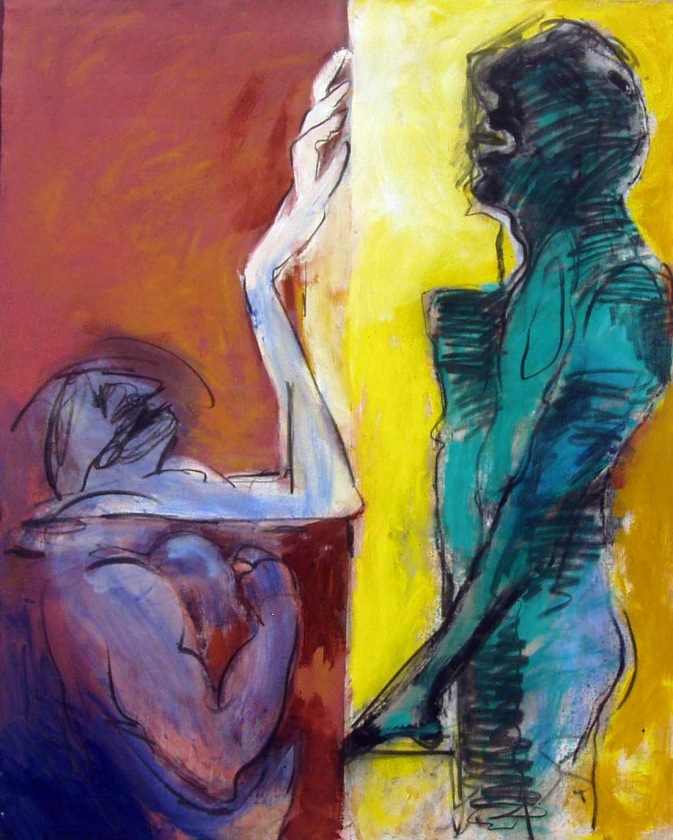
One can see in the work Supplication, a complicated and programmatic theme.
“ Separation is underscored by a willfully fragmented composition, by conflicting indications of interior and exterior space, and by a standing figure in a light, open space opposed to a squatting , supplicant figure, Lazarus-like, in a darker area with a tomb.
The latter performs a role of judgment – one hand appears to accept the supplicant figure; the other hand rejects.” tout clearly at this point, wants the metaphorical, wants even the self-destruction which breaks up his own past, as if the de-construction will liberate another source of energy.
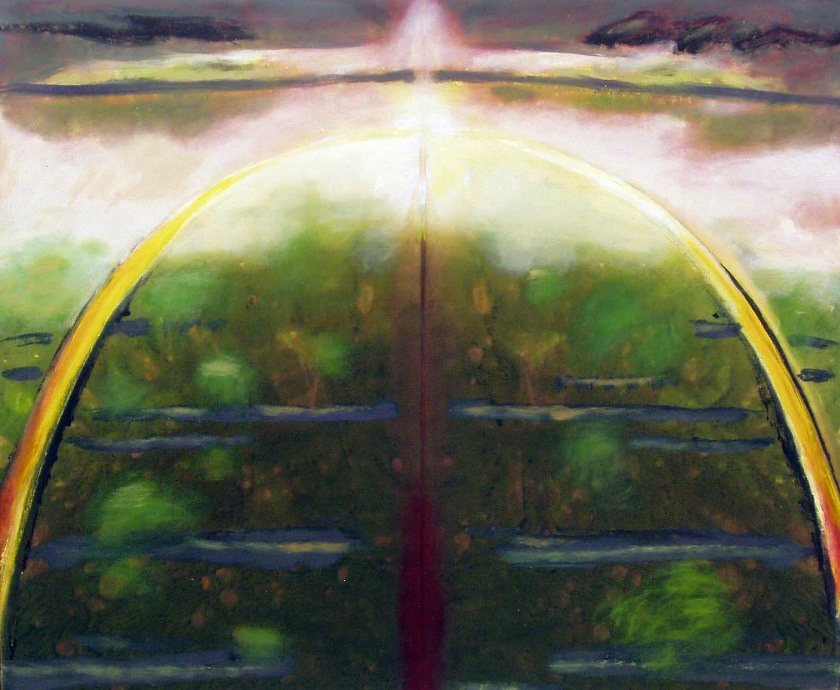
It is a way the artist finds to go on.
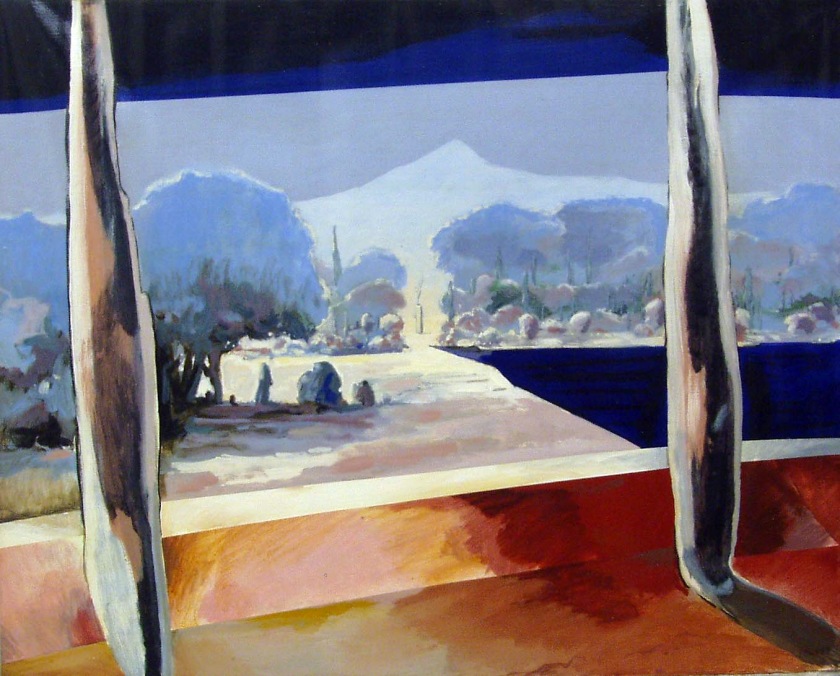
Again almost 30 years later he returns to landscape with a sketch, romantic abandon, making of his love of place another country in which to flourish.
He happily confirmed in 83 his references, his books, the solitary figures of Holder, and a painter to whom he often makes reference, Friedrich this is visible from his work Paradise Dream, which is a sensuous and rich visual exploration of the luxurious effects of light and color. There are trees, or upright forms, menhirs, columns which with the resource of allegory wish to explode the possible web of relation and meaning out beyond the very particular which have engaged the most intense even melancholic scrutiny.’
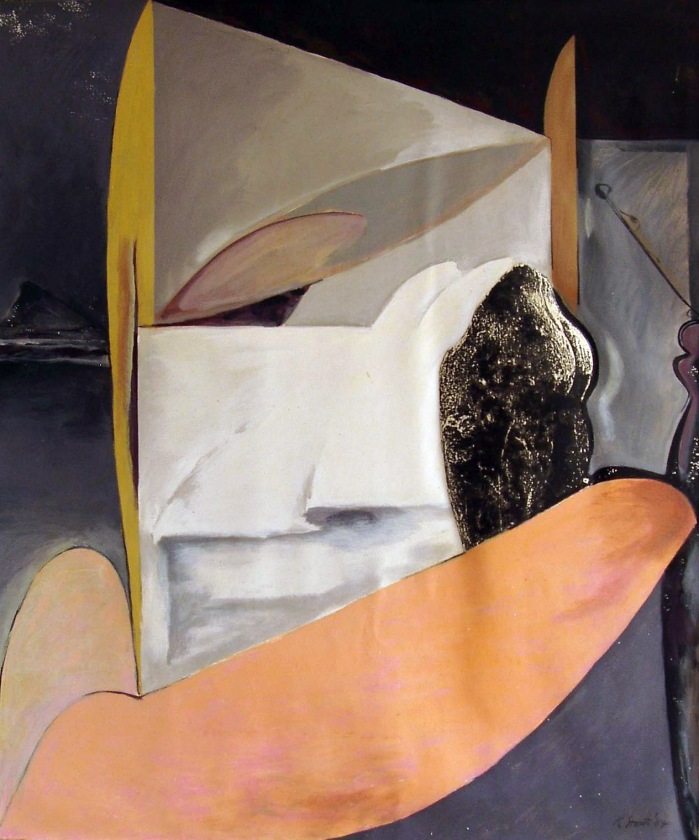
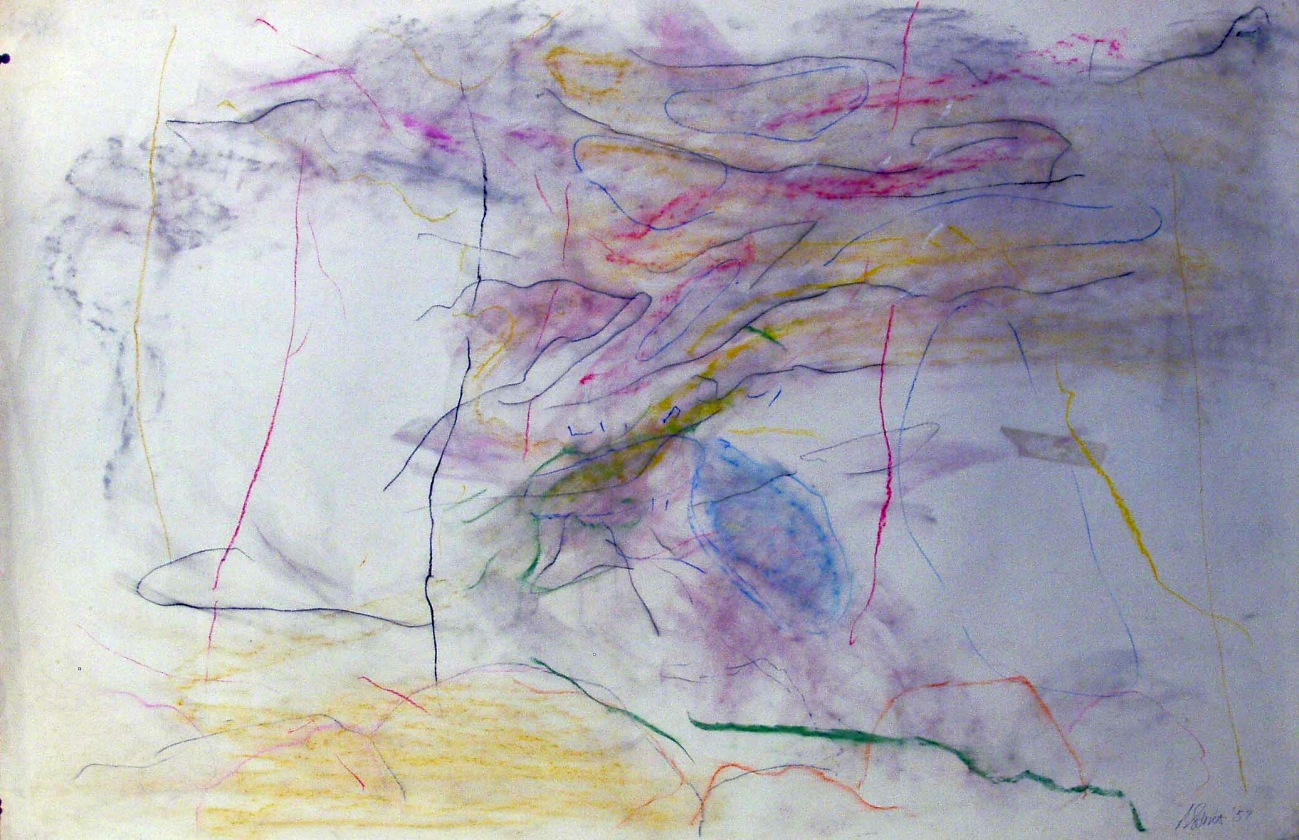
“Mysterious colors, the mountain, and ceremonial trees, statues, menhirs,recall an Allegory, while Fate of Knowledge reappears in abrupt spatial divisions and the theme of the walled paradise/garden. Stout describes his concern in this painting as the ‘sensation of having been at a place (the walled garden) but at a distance “as though in another time and place. Such an event actually occurred form him when the space-time experience of a dream was subsequently rediscovered in a panting by Rubens.”
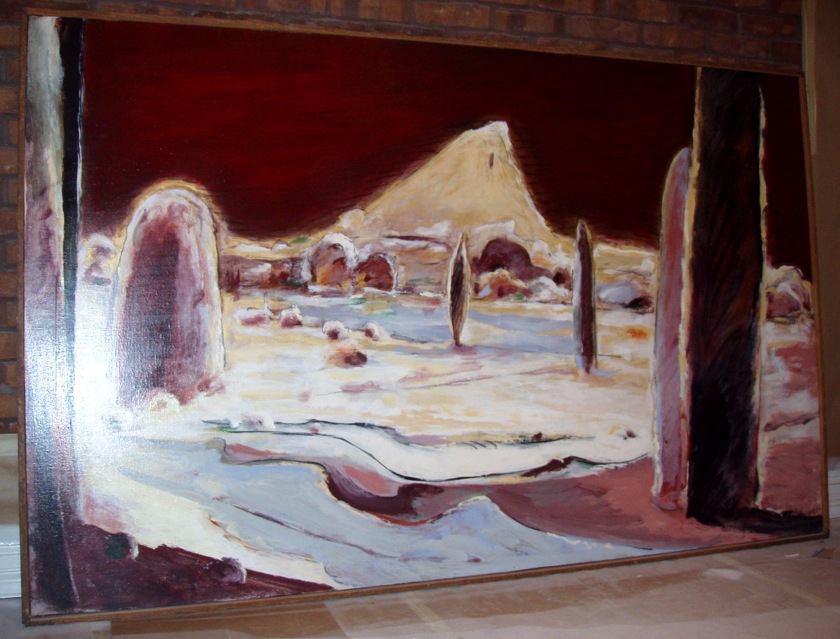
The lecturer notes that in the painting of Rubens, the foreground trees and wall like planes of color do stress nearness and presence in contrast to the more distant blurred paradise-garden – yet they are also more abstract and linked visually and conceptually to that walled paradise. In the elusive quest to unite form and content Paradise Dream is a stimulating work; in its effective synthesis of past and present, distant and far, dream and reality, “ it seems representative of Stout’s present re-evaluation of his work from the 1950’s.” t is also possible to add something to this perceptive account. The return which Stout makes that has as its apparent first gesture and act of destruction, a moment of self confrontation, belongs to the difficult confrontation in which his earliest choice of life in art is situated. Speaking about this he pointed to the presence in his childhood and upbringing of various influences, and one which surprisingly remained for him both a keepsake and a continual challenge.
The theme of nostos, return, with its inevitable wanderings and delays is most appropriate to Stout, and also the danger for him of nostalgia. It is like the wandering of Odysseus, he must bear the brunt of whatever experience, often in pained silence, in order to get home. He has alluded directly to these classical themes in bronzes of the early 2000’s .
The image of the volcano, with its forces and energy moving from an inside to an outside, spewing out and destroying and letting things start again through a destruction, captured his imagination. He refers also to works like Gibraltar, and the painting Oedipus which are a motif of his longing and desire. These inchoate suggestions are linked by him with a real person and presence in his youth which seems to function as an ensign of the freshness and intimacy of art which he wanted to create.
Morris Graves the artist had been at the High School in Beaumont where Stout received his primary and secondary level education. In a small town of 60-70,000 people the presence of the artist was a matter of public interest and awareness, Beaumont had had been enriched by the oil business from the turn of the century 1901, and by 1931-2 a second generation society with its accumulated wealth turned to inspiration in better architecture and patronizing of art.
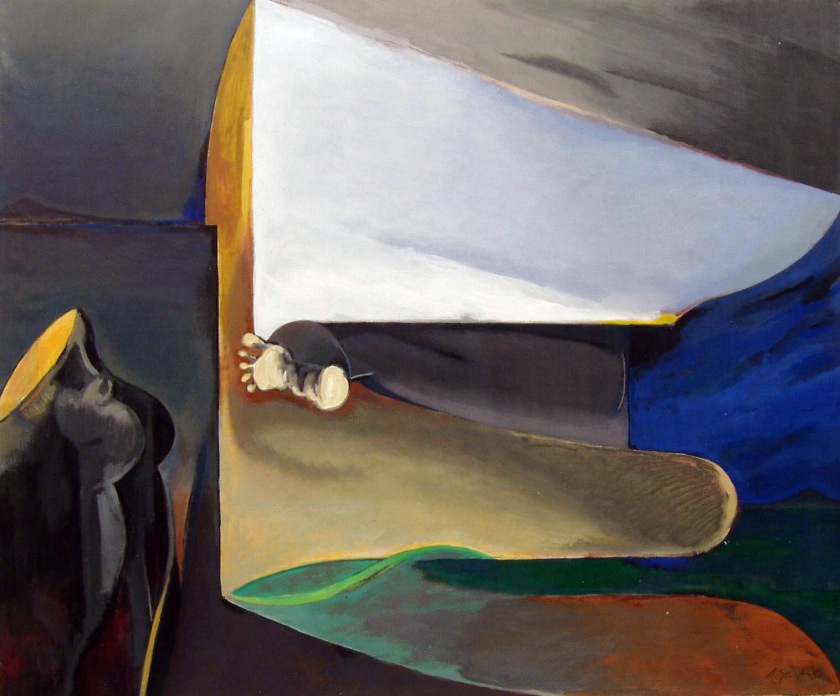
Stout was astonished by the work of Graves, and repeated his sense of how exquisite his drawings were, the exquisite touch in his work. ‘There was a beautiful innocence in his work, of what he observed and remembered, he looked at birds and remembered such a lovely innocence.’ The metaphor of the volcano is also for Stout the process of painting itself. He points also to the period of the late 70’s’s the way in which a kind of secret life was exposed, differently than previously, because earlier he believed he could show and at the same time reserve his secret, his inner self. The fragility of that self was always in question.
His return to the past was a way of shoring up the idea of a continuity of identity. He searched for his inner persona by going over the past, and this also was akin to a spiritual exercise.
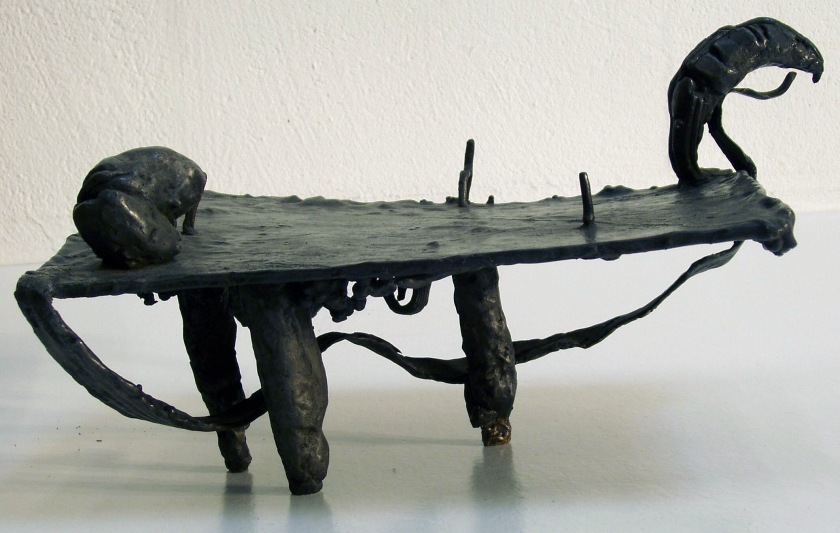
The disruption for him is also expressed in compositional terms, and indeed painting is how he retrieves the whole of his past and thinks of a future, it is squaring this that constitutes the only stability for his life. He commented specifically on the compositional usage of a strong central axis in his work, as a personal anchoring.
One again the theme of journey, sailing, harbor and anchoring are sounded together. It as a compositional emphasis is also for him a fundamental human inflection, our ability to stand up straight, look up to the sky, the ability to hold things in care and balance; whilst moving at the same time.
There is then an abrupt shift, in the interview he refers to his considerable fear of water and drowning. He had had an experience as a young child of almost drowning, and being rescued by his cousin in Arkansas, which he found ‘terrifying, yet powerful’ that is when I did the volcano drawing, I never learned how to swim. I was always fascinated by water, that it was flat, ‘ With absolute confidence, and critical acuity he points to the work from 1956, and his first Gibraltar paintings, as the most significant of his works.
It wasthe work in which he felt free from the impress of the teachers dicta, he was no longer encumbered by commands to perform, and ‘I had a sensation in the break-up of space.’ It is there the eruption begins for Stout.
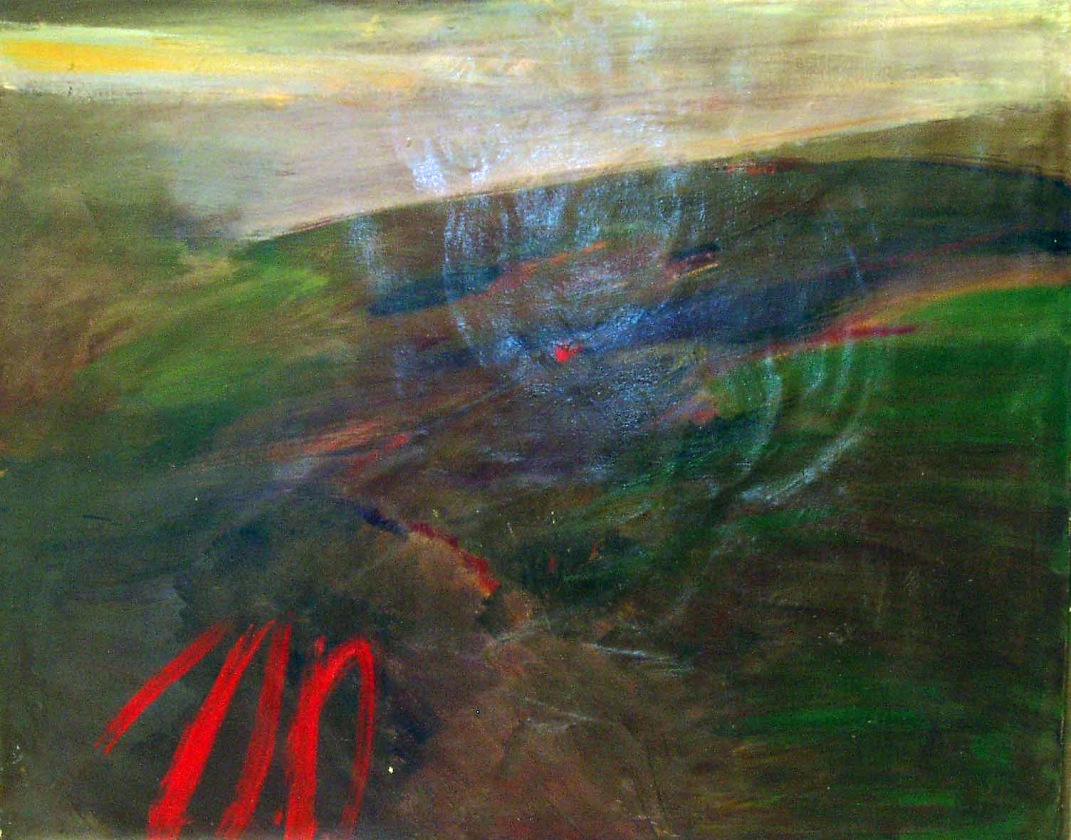
1950’s
To consider the decade of the 50’s I turn to a document which survives in Stout’s unsorted papers, and which can be securely dated only to the academic year in which it was written, written in pencil, it belongs to either the beginning Fall of 1953 or the Spring of 1954, and is in the handwriting of Stout. This statement belongs to his first year as a student at the School of the Art Institute of Chicago.
‘To being is only to find the proper place to put the pen upon the paper.
Then life like the pen moves from goal to goal analyzing nature into a continuum. A part of nature ever growing and ever changing with it – that is the way I choose to live to paint and let my senses explore the whole world around me. Man mustn’t put himself against nature but become a whole and part of it and always inch his way (forward) as does a worm or a bird – fights his battles when he hits a rock and swims in rain – and in the simple changes that nature plays each day – The sky the leaves – the sky again the dry leaves-the fog-the sharp blue sky the brown limbs the fogged leaves all this changing and needing to be seen and recorded and enjoyed and above all is the first source of inspiration the life of man as he lives is another well of beauty –death-birth-death again and birth before death and birth after death – birth from the womb of a dead mother -ah such is our life-not our battles that only the imperfect wage, but the beauty of birth and death that are the most important – let this be of importance. Tho of less high and beautiful nature the idea of man artist looking at imperfect and society and recording its tragedy and inadequacies is more than just interesting from this point of view I can get a clearer picture of the various positions of various people and myself and of perhaps show some idea of what can be improved upon – but this to me isn’t quite so beautiful an idea as the form – I have my goals – to do the most beautiful”
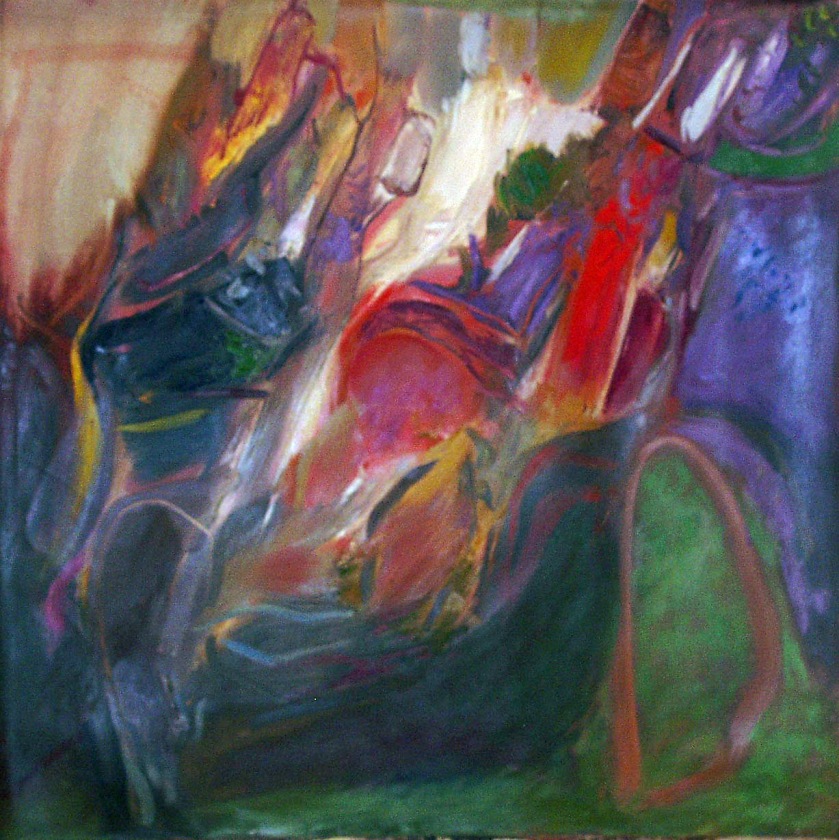
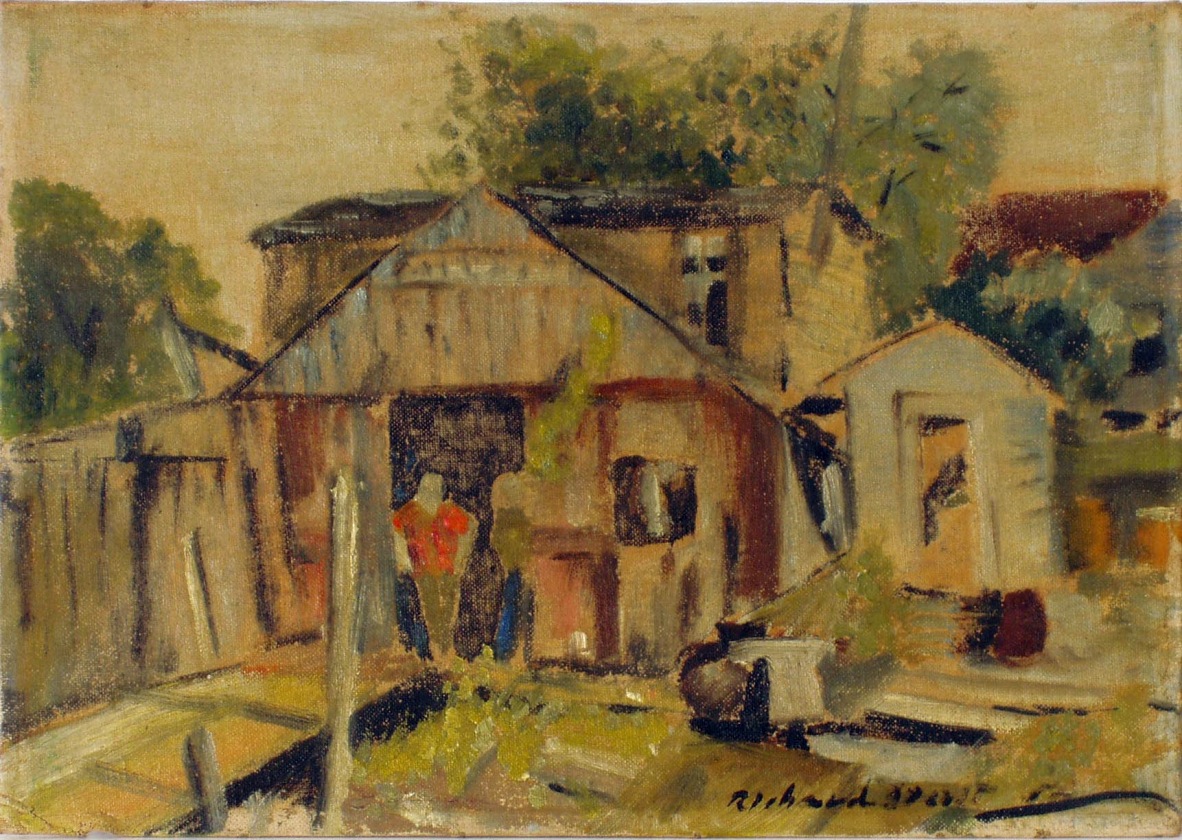
Within the stumbling syntax, and his running sentences together, one senses the pressure for the artist of a discovery, and his own recording of really beginning. There is a grandeur in the romantic idea of being one with the continuity of nature, in its variability and continuum, and at the same time a moral element, the issue of the imperfect and the struggles in which people engage, which takes a secondary place to the express will of the artist; to create , in this case, beauty. Stout lays out the simile of his work of the slowly advancing worm, the bird struggling in the rain.
The naturalistic detail points to the labor of nature and not its rich fertility: the slow even plodding sense of a task that will be long in aim and achievement.
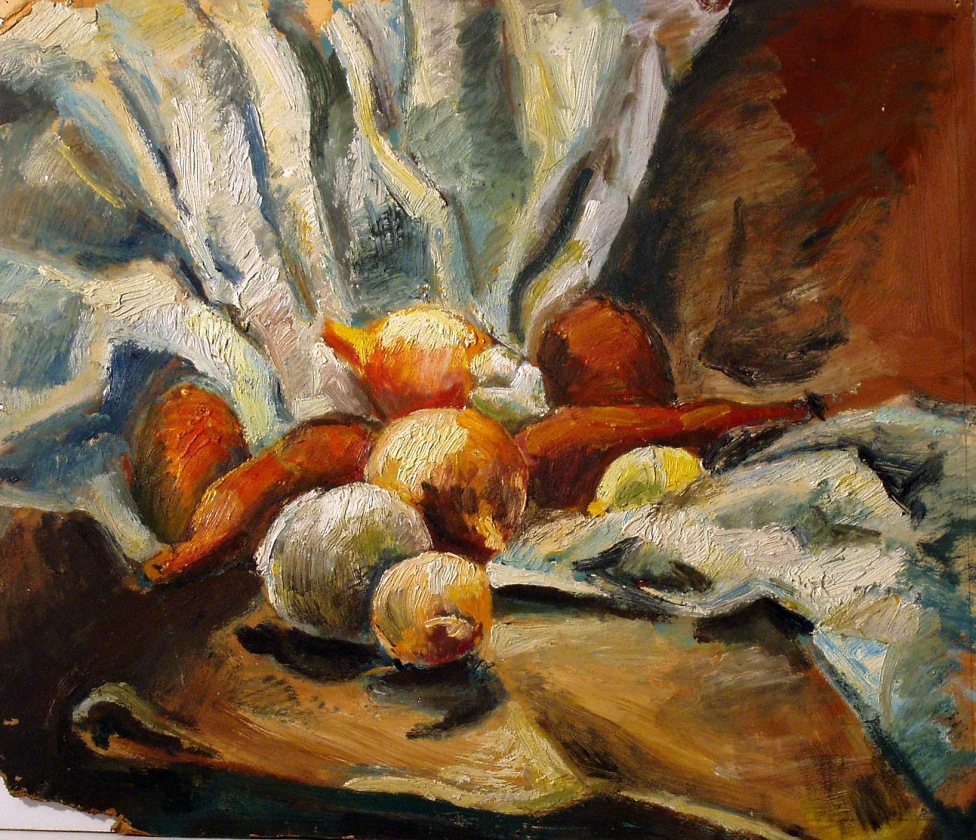
There is no pantheistic hymn to nature, rather, a complex mix between the social, the personal, and the natural. The phrase ‘let this be of importance'-places his own decision of beginning as the crucial part of the document. His goals are focused in his own work, finding the proper place to put pen on paper.
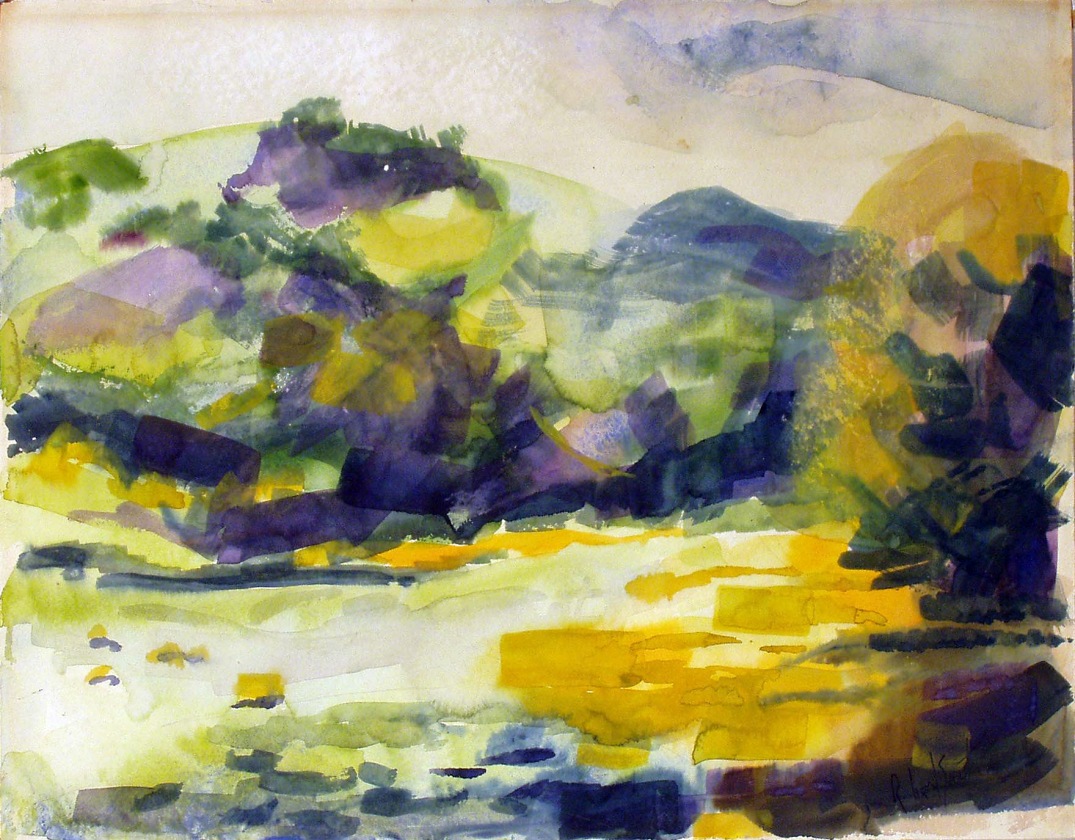
The enthusiasm of the melding into the process of nature as analogous with the activity of the artist is tempered by his awareness of generation in birth and death that necessarily belong to each other, and are not in opposition to life. Life includes death, and this is where the artist in the imperfect social world operates, in the space between.
The space between is where Stout, for many long years, will insist he finds his inspiration and task. The resolution to work forward and slowly is already in place.
There is also, one can say, a necessary tension between what is an abstract goal and the imaginative focus on the singularity of things: the repetition of the relation of the leaves as foggy, the dry leaves, the very individual, specific things that catch the eye, the leaving oneself open to the world of the senses. The artist must record with precise observation and still serve goals that cannot be seen, only, if successful, that can be shown.
Here too there is the in-between where a struggle takes place.
We can briefly track some of the background to this document in the earlier activity and education of Stout. Much of this early work is difficult to retrieve.
If the document is to be dated as Spring 54, then at this date we have some report on his public activity and early exhibitions. A small notice of his exhibition in 1954 was carried in a local newspaper, ‘ A second showing of the works of Richard Stout, gifted young local artist is now being held at 595 Mariposa and is open to the public Mrs.
Dan Milling also an artist and member of the Beaumont Art museum and Beaumont Art League is sponsoring the exhibition…….About 20 casein, oil and water color works are in the display, and none have been shown here previously, Mrs.
Milling said. Most of them were painted last summer when young Stout was studying art in Cincinnati.
Also being shown currently is an exhibit of paintings by M.Stout and Richard Kline of Florida at the Beaumont Art museum. Both are scholarship students at the Chicago Art Institute. The Beaumont youth is the son of Mrs. C.G. Stout of 2404 Avenue. A.’ In an article by Anna Lipscomb published in The Sunday Enterprise the notice on Stout is exceptionally favorable. The short article is effectively a puff or advance notice on the forthcoming exhibition in the Beaumont art museum for Kline and Stout who are in their first year of study at the Chicago Art Institute. We have some information that Stout: ”whose studies outside his regular school work, have been under Mrs. William Hoffman, and Denis Mc Carthy of Beaumont, and Jacob Getlar-Smith of New York, …is regarded as one of the most gifted of young Beaumont artists and the trend of his work is followed with great interest in local art circles.” rom contemporary newspaper sources we can then see he held his first one -man show in the museum in the spring of 1952, and exhibited in the Beaumont museum annuals in 1952 and 1953, and was accorded a one-man show in the Beaumont club.
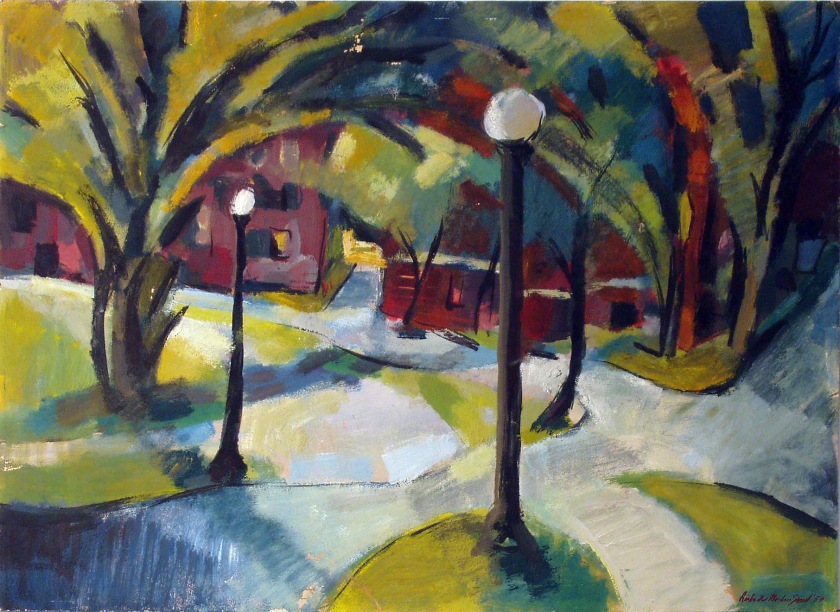
Lipscomb provides also the additional information that the work of both the artists Richard Stout and Richard Kline was done “upon assignment to special problems in painting in the Art Institute is the result of their half year’s work and is concerned chiefly with the problem of space.”
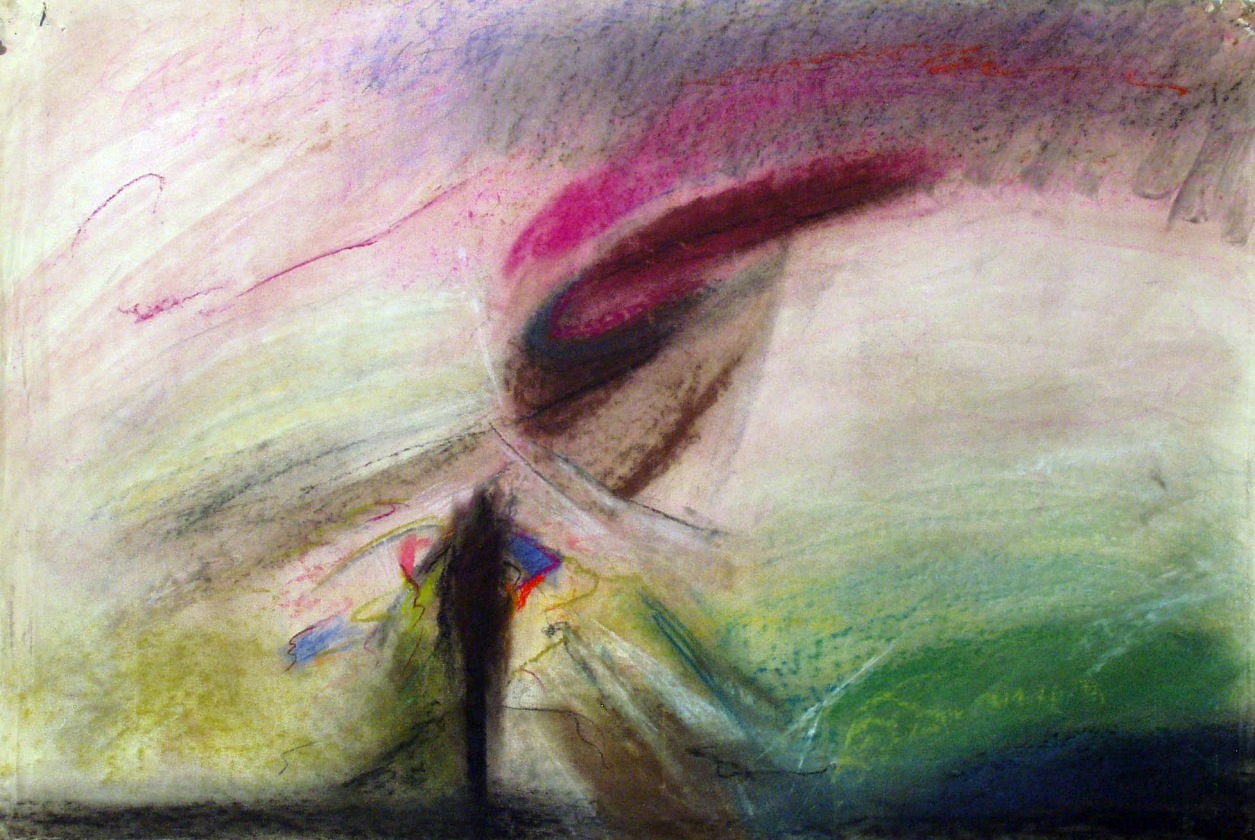
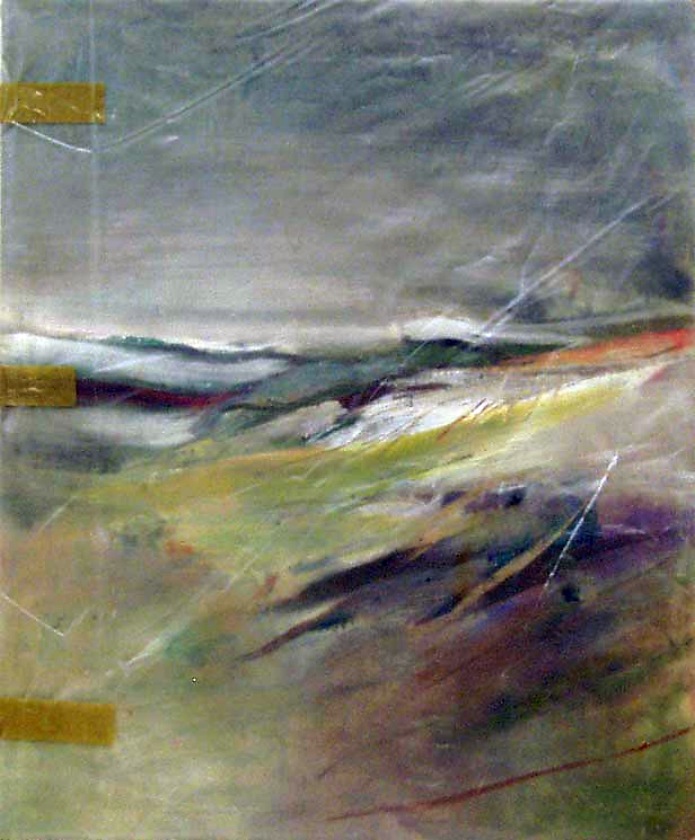
Both artists are read as being busy with experimentation in the impressionist style, “and both as colorist are unusually gifted.” The work of Stout which illustrates the article is that of the “deep recess of an alee (sic) in a city park”.
Stout had been taking art classes from his fifth grade. His art teacher Mrs. Fanny Jones was later to be a friend of the family and died in their home. This family home had been purchased in the 1920’s and was a large bungalow style house.
One of the early oils of Stout from 1952 with the etiquette ‘interior of my Home’, also has the view of the middle of the house to the back, and shows what he refers to as ‘dad’s chair’. This chair will become a motif of later work, and in the first decade of the 21st century becomes a massive sublime presence on the horizon of a sea scape where absence and oblivion are equally invoked. The solitary chair is a mark of his loneliness and desolation throughout his work, a symbol of mourning, which becomes transformed into a vast hieratic throne by the late 90’s.
The house had something of the feeling of a gallery, since the doors were painted with shiny white enamel, and the bungalow contained crisp pine floors.
However the earliest work from the hand of the artist which I have been able to trace dates to May 9 1946 and it is a small surviving pastel of a landscape showing a setting sun with a gate in the foreground, trees and a meandering path way. It is signed Dick Stout, and the main color accents in the foreground gray, blue white, magenta, and in the back ground red yellow and green. To the right foreground is the suggestion of an open gate, the y-post tree on the left and the receding background suggest a clear grasp of compositional devices for organizing landscapes. For a twelve year old it is assured and one could say precocious.
The work of Stout was also advanced by the involvement in the new museum in Beaumont, where he attended painting classes, and drawing lessons. For the early fifties there are sheets of surviving drawings which indicate interest in working from the female model, and this element of figuration can be seen in the strange elongated shapes during the decade, a style of figuration to which he will return in 1983, inspired by looking at statues-He made a sculpture of Santa Claus in gypsum at this date, and contributed to a Mural decoration at the Beaumont art school.
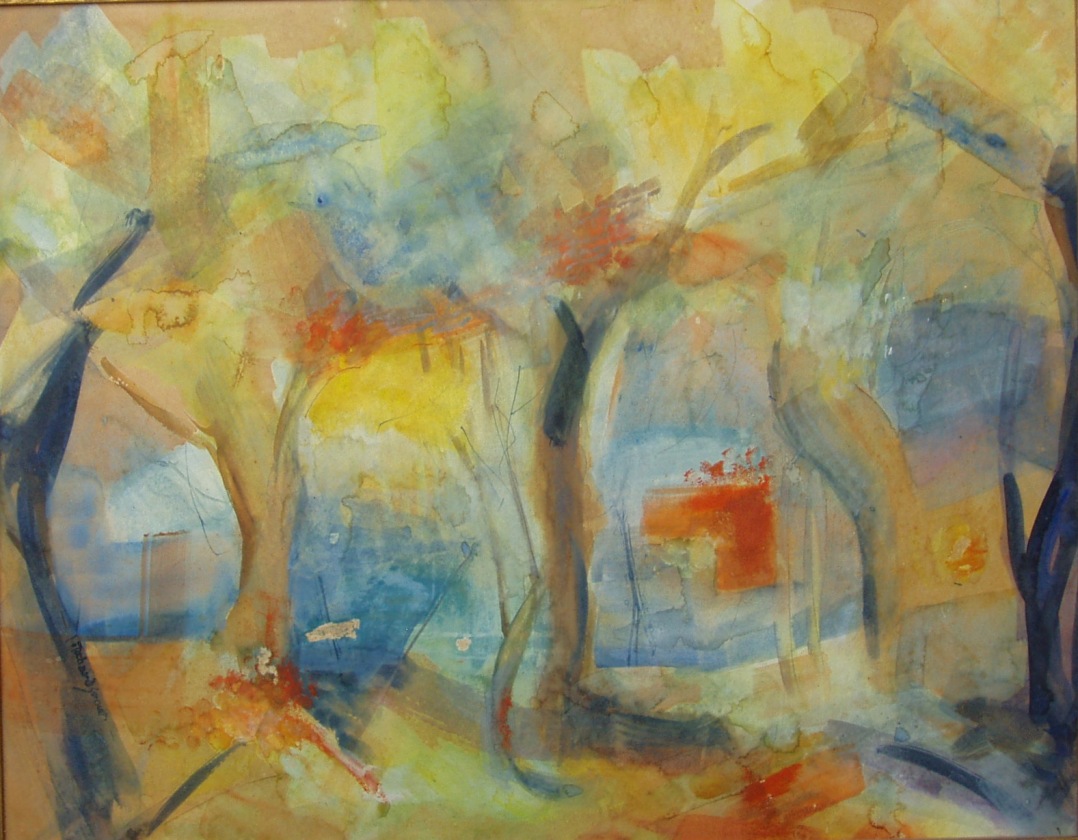
A key question in his development of his work is of course what happens to the figurative, and the way in which, given his deep adherence to abstraction from the latter part of his studies in Chicago, the human body irrupts from time to time in his work.
His solution to the underlying tension is found through a metaphorical transformation of the unresolved conflict, by turning to a strong motif in nature, and by the end of the decade this has launched him on path to which he will adhere for decades to come.
An very early photograph of Stout, which was published, shows him working on modeling a clay sculpture which is clearly influenced by the figures of Henry Moore – Mother and child-being created at this date, in the early 50’s, and Stout was also keenly aware of the work of Giacometti. He will resume sculpture again 50 years later leaving a small and impressive sequence of works.
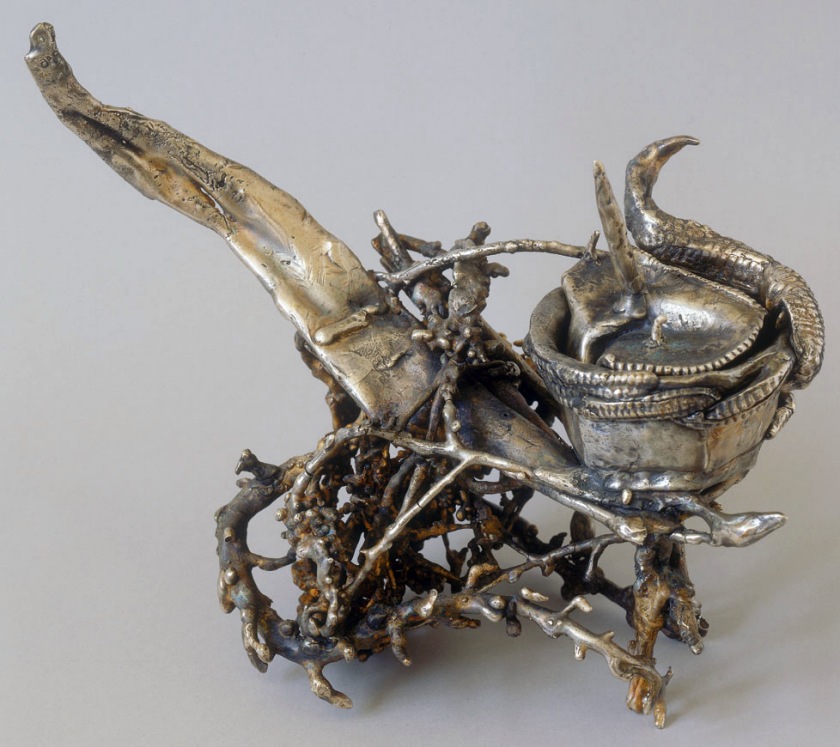
There is surviving evidence of his work of designing the frontispiece for the school magazine, a design for a bookbinding cover, and his awakening to the work of older artists, especially Maurice Graves and Reginald Marsh. The interest in the human figure was explored, but would not have its full development until the mid 1980's. Stout was still looking at landscape and making of his feeling a move to refined abstraction and allowing himself to be open to outside artistic influences.His teacher Mrs. Hoffman at the Beaumont museum was responsible for transmitting French influences, and he had made his own personal discovery of Giacometti, and suggested that he ‘ was always working in response to this’.
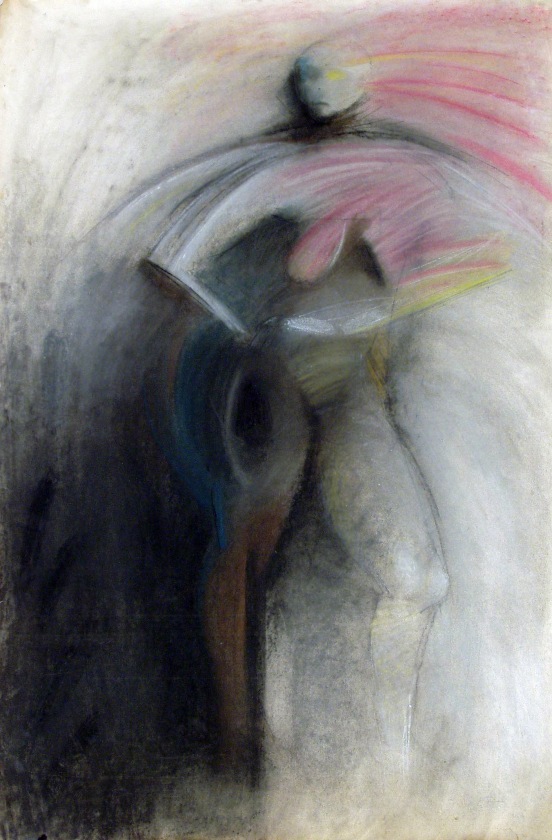
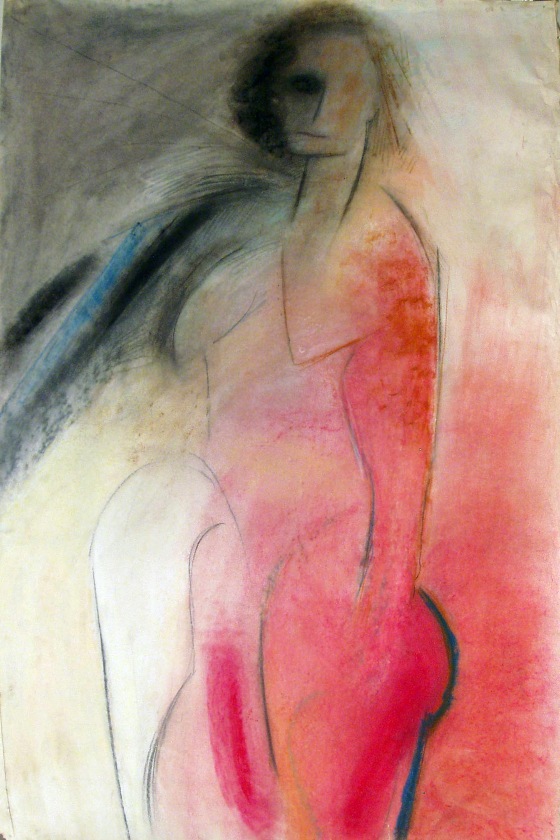
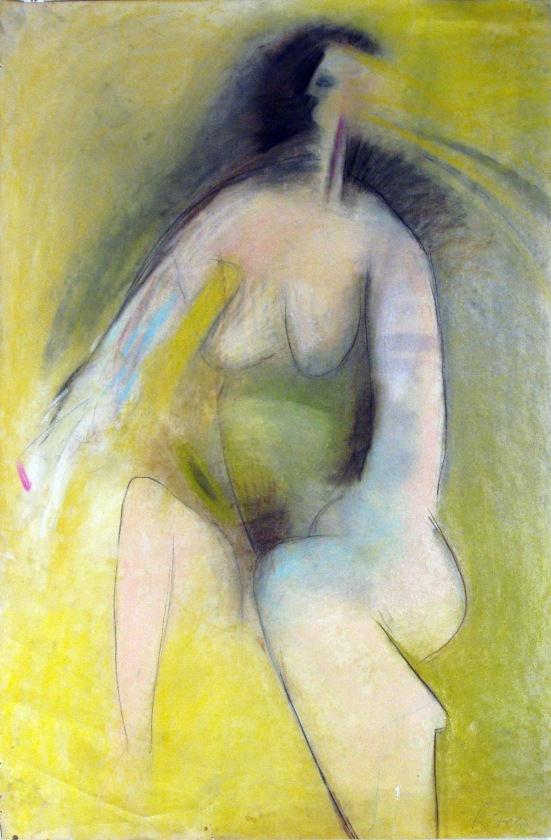
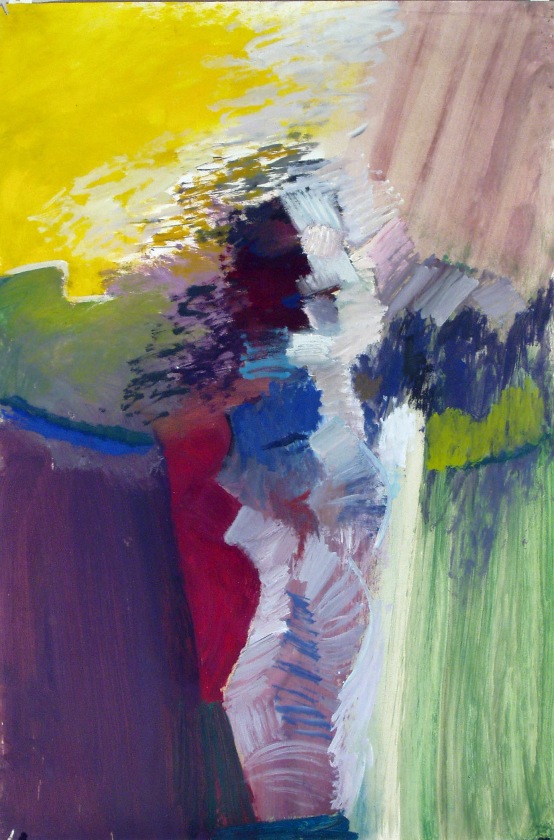
Shortly after the death of his father, he seems to have quietly set aside religious observance.
His mother had obviously detected this and in a long letter to him 3 years later, urges him to go to church when an art student if only because there he will meet with people and have social contacts.
Stout was a direct beneficiary of the increased cultural activity in Beaumont, and was from early on regarded as the brightest emerging talent of his generation.
Thanks to surviving letters from his mother and aunts one can say, that after the death of his father, when he was only 15, he was taken care of almost in the manner of an orphan.
A letter from Lilian Hayes, with whom he exchanged intimate feelings and shared his youthful ambitions and insecurities, and with whom he discussed art, gives the tone of the support and attention he received ‘I want you to know how well everyone likes your Exhibit. … Again I want to say how proud of you we are, and I am glad I can say I own early Stout…' Lillian Hayes, whose mother ran a bookshop, where he discovered publications on modern art and first heard the name Rauschenberg, may in a disingenuous note have stumbled on the mysterious reserve of the young man, noting that she never understood “why you paint cool over warm”.
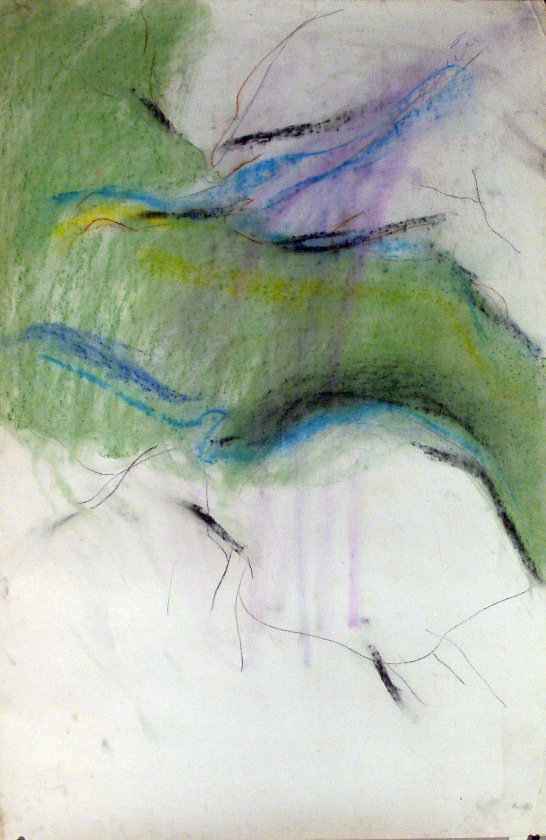
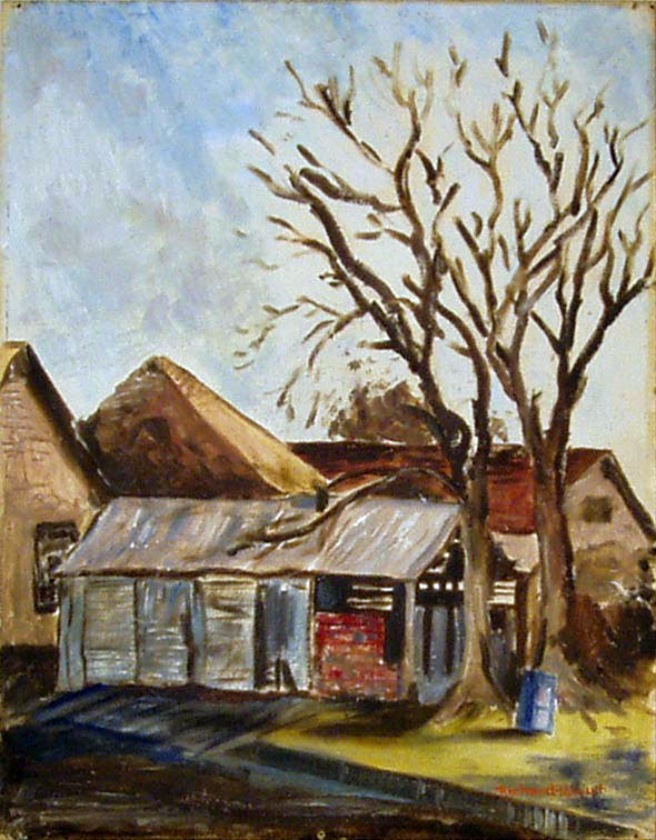
Stout had at this age a broad command of technical means, for making sculpture, drawing, painting, and lithographs. His lively visual curiosity and charming manner made him something of a cosseted darling among the philanthropic art lovers of Beaumont .In Cincinnati he visited his aunts during the summer and took lessons there.
The use of water colors allowed him experiment with different relations, the speed and sudden movement of the hands, and limiting the flows on the paper, which also suddenly released unexpected effects were a physical relief from the more laborious work in oils. And with the medium he discovered how to place cool over warm.
It was the very choice which puzzled Lillian Hayes.
By 1953 his work was seen as ‘abstract’ and there is a note in the Beaumont Journal for Friday September 11, 1953 observing; “Richard Stout, one of Beaumont’s youngest artists for whom many predict a bright future, explains one of his abstract painting to Jane Milling. His work was within a year being purchased and presented to the Beaumont art museum for the permanent collection, a report from May 23 1954 in The Sunday Enterprise illustrates his winning work ‘ Windy Spring Day’ which was purchased by Elizabeth Halliday for $100, which has in its composition a distinct echo Beaumont .In Cincinnati he visited his aunts during the summer and took lessons there.
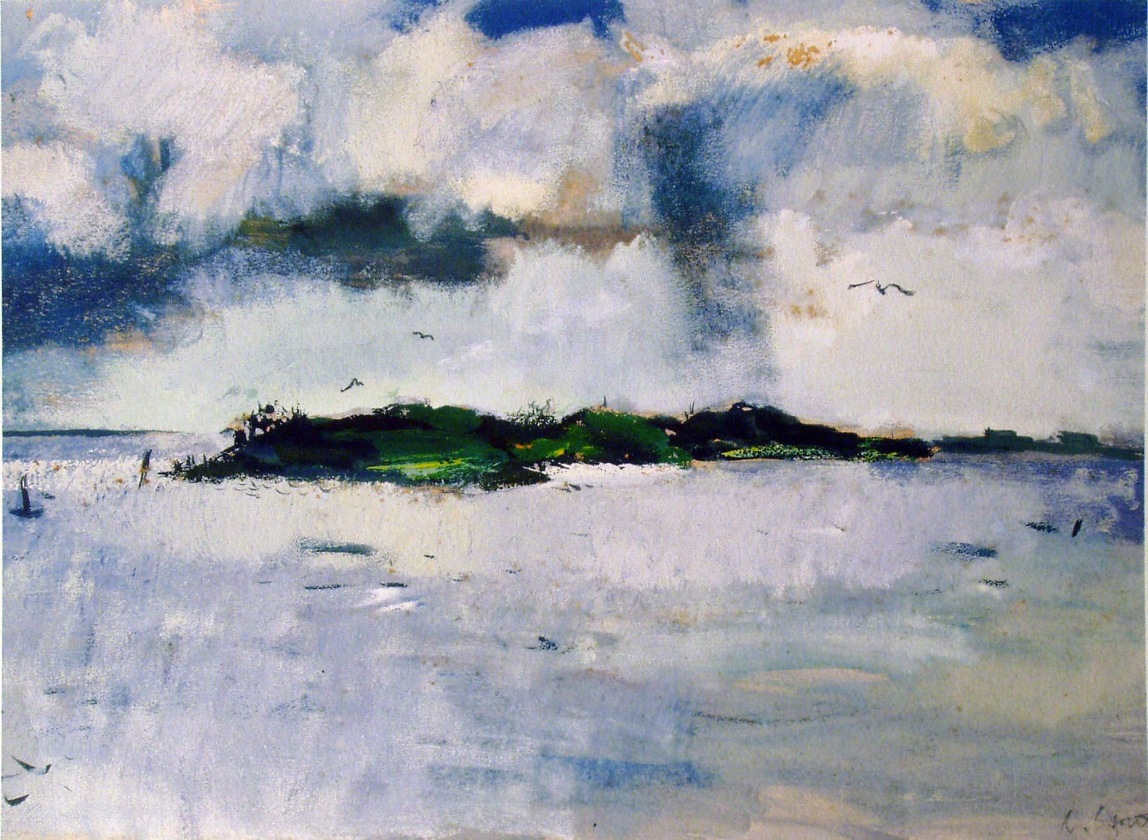
The use of water colors allowed him experiment with different relations, the speed and sudden movement of the hands, and limiting the flows on the paper, which also suddenly released unexpected effects were a physical relief from the more laborious work in oils. And with the medium he discovered how to place cool over warm.
It was the very choice which puzzled Lillian Haye Stout then it can be seen had developed in an ‘abstract ’direction before enrolling at the Art Institute of Chicago, where he was to begin studies from September 17th 1953.
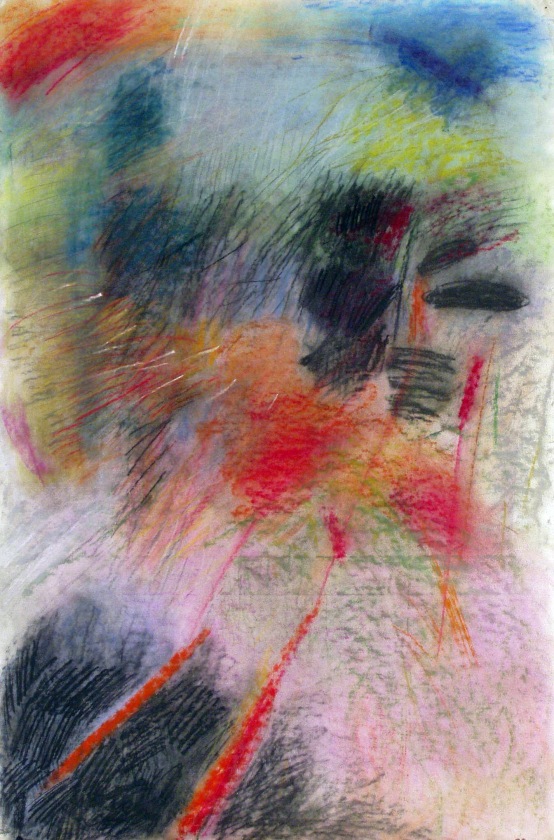
In the same month he had gained a strong idea from seeing an exhibition at the Metropolitan in New York of contemporary art in Israel, where there were “new ideas to me such as balancing a very busy area with an almost completely negative one, and dividing a picture for all practical purpose in half with a window frame” t Moma he had seen a Jackson Pollack which he found very interesting “but I can’t imagine a whole life of them”.
Letters from his mother and Lillian Hayes in his early period of study indicate the tough minded concern of which he was the recipient, and the worry about how a young artist could make a living. A letter dated October 1st, from his mother, reports she is suffering from hay fever, indicated a shrewd and practical concern. She asks for his schedules, and offers advice on lodgings, and emphasizes the need for eggs for breakfast, the eating of good food and especially vegetables. She cautions him on the expense of writing checks and emphasizes that he needs to be aware of making money.
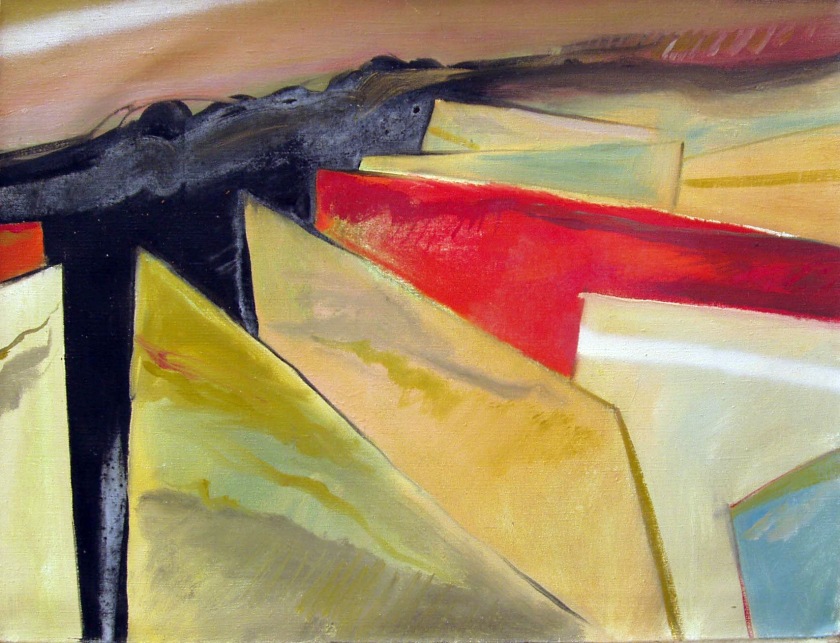
His mother is already planning his return, and reports that she enjoys going fishing, and there is food to be kept in the deep freeze ‘ so I can feed you up when you get home’.
She then asks bluntly: “Have you found a Church to attend yet? You will make lots of friends that way and it may lead to a place to stay also. Look for a Church and go – don’t get out of the habit.” letter from Lilian Hayes on the 18th of the following month, November, sounds a very different note: “Dear Desperate One Many people here think of you as the most promising painter since old (inner eye) Graves…….I couldn’t understand the way you make your colors neutral by warm over cool and vice-versa..” he then suddenly advises Richard against speed and the need for applause: “This is the best time to learn your craft – so you will be able to say what you have to say in the best possible terms.” ome months later January 16 1954 she would write in less restrained terms, as the exhibition in which he featured was attracting attendance figures of 125 and more per day; “Most of the people spoke favorable of your work and Dick’s… Mrs. Davis found great improvement in your space and color. Parker liked you alley and Dick’s door.” is aunts in Cincinnati would also write and report that the art teacher Mr. Chedlaw had said ‘ that boy will do good things’, and offers an interesting response from a Mr. Helwig who is said to like the landscapes ‘ and is very interested in 'bent space'. The little phrase is crucial to understanding Stout for this period, and also we are fortunate to have some further insight given in an interview to Toni Beauchamp, in 1999(Artlies, Fall 1999 pp.30-35.) Beauchamp noted that Stout had had a very supportive network for his art from the beginning, and offered a brief summary of Stout’s early situation, namely, ‘ You were born in Beaumont in 1934 to a family who encouraged your interest in the visual arts and music. Although your parents struggled through the depression years, both were working after you were born. They provided private lessons in addition to your public school art classes, and you had a mentor in the Beaumont Art Museum board president.
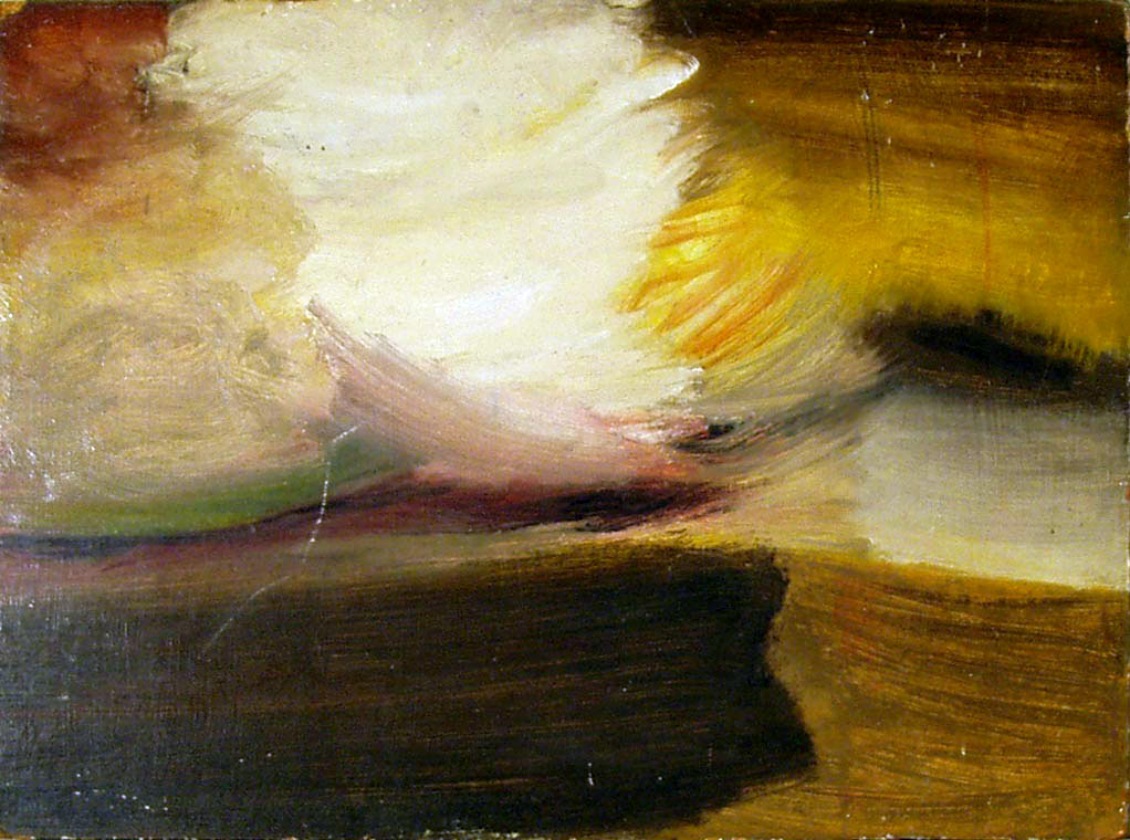
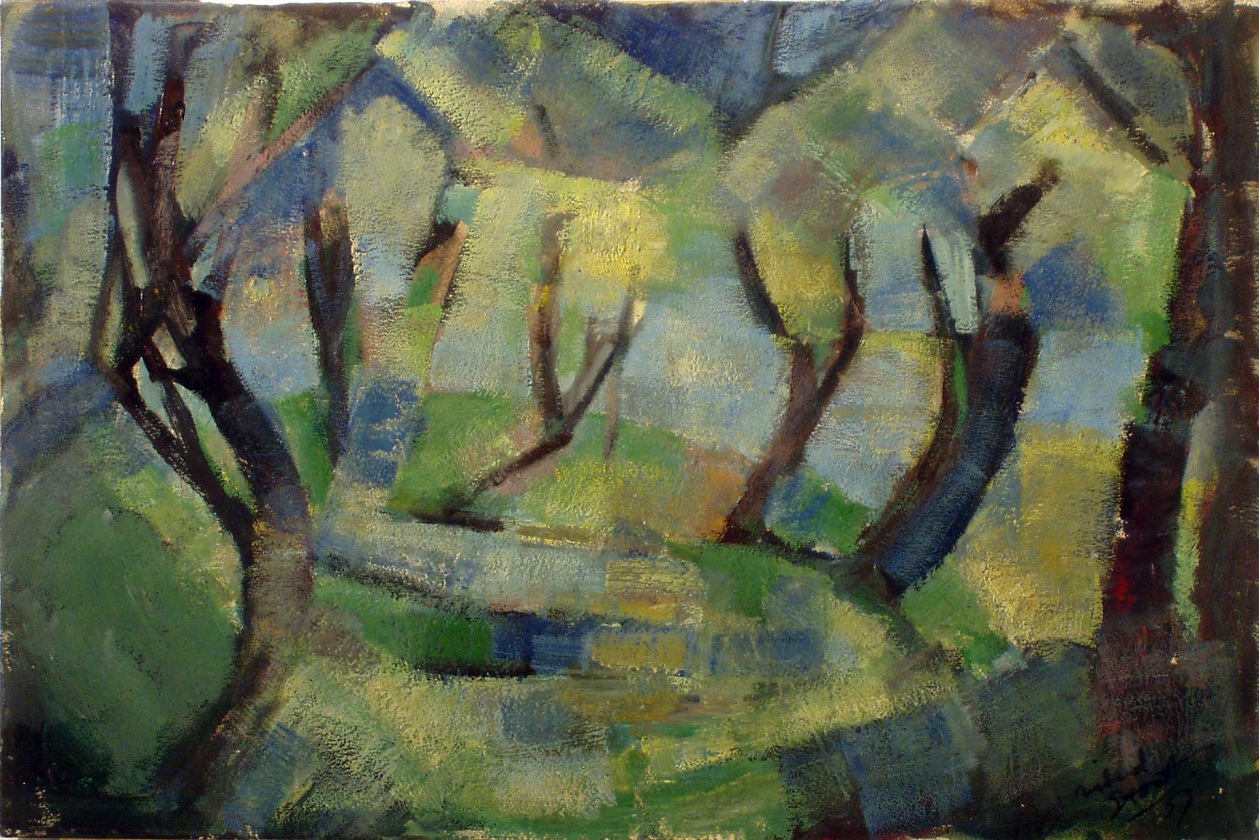
You won so many art awards (in) your senior year that they subsequently changed the rules, and you were given a full scholarship to the Art Institute of Chicago” o which Stout replied: ‘ Yes, the three of us on fellowships wound up rooming together-Jack Beal, Dick Kline, and myself” He continues “ Our one really great teacher, Isabel McKinnon studied with Hans Hofmann said that she knew more about what he was trying to teach than anybody else. And all of it had to do with pictorial space. We were all referred to as the “space cadets”.
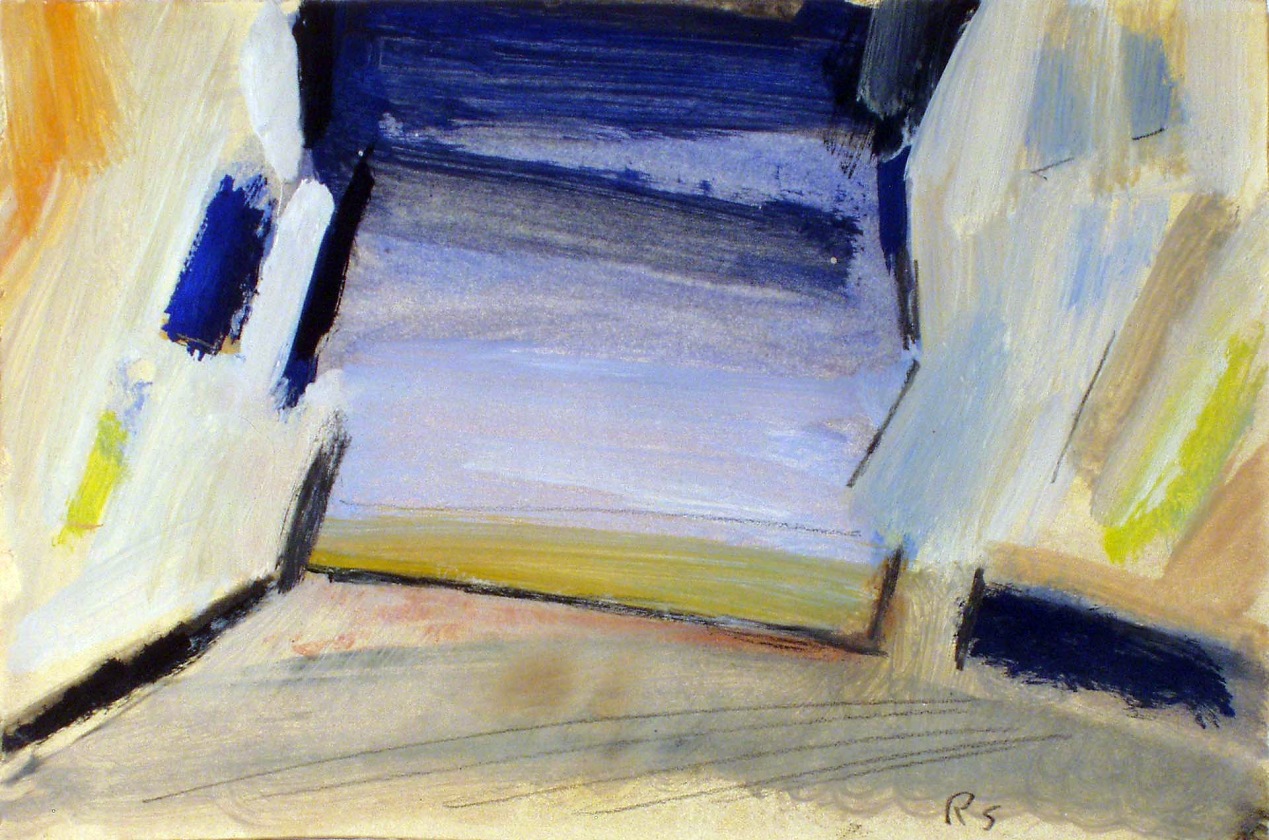
Stout recalls: “Mrs. McKinnon was absolutely ruthless. You would come in with a piece of charcoal paper and leave with a piece of charcoal paper that was smudged with only two lines, but it took you three hours to get those lines in just the right place so that everything in between twisted the space in such a way that the pictorial space had a lot of weight on its own.” hat one may ask was the inheritance of the teaching of Hofmann, and how should it be understood, also what is meant by speaking of the expressionist commitment in the art of Stout, and more broadly how has Abstract Expressionism often seen as the defining style of post War American art been understood against the specific historical inheritance exemplified in the teaching of Hofmann, and in the reading of Expressionism itself? The notes on which I am drawing, taken from surviving notes of Hofmann's teaching. They are based on the summer session teaching which began on June the 16th 1947. The notes are made of criticisms which Hofmann offered, and are in no particular sequence. They can be summarized to give an over-arching view of Hofmann’s teaching. The dovetailing of what is contained in these notes, with what Stout offered in interview as his own approach, as indicated above, is quite remarkable.
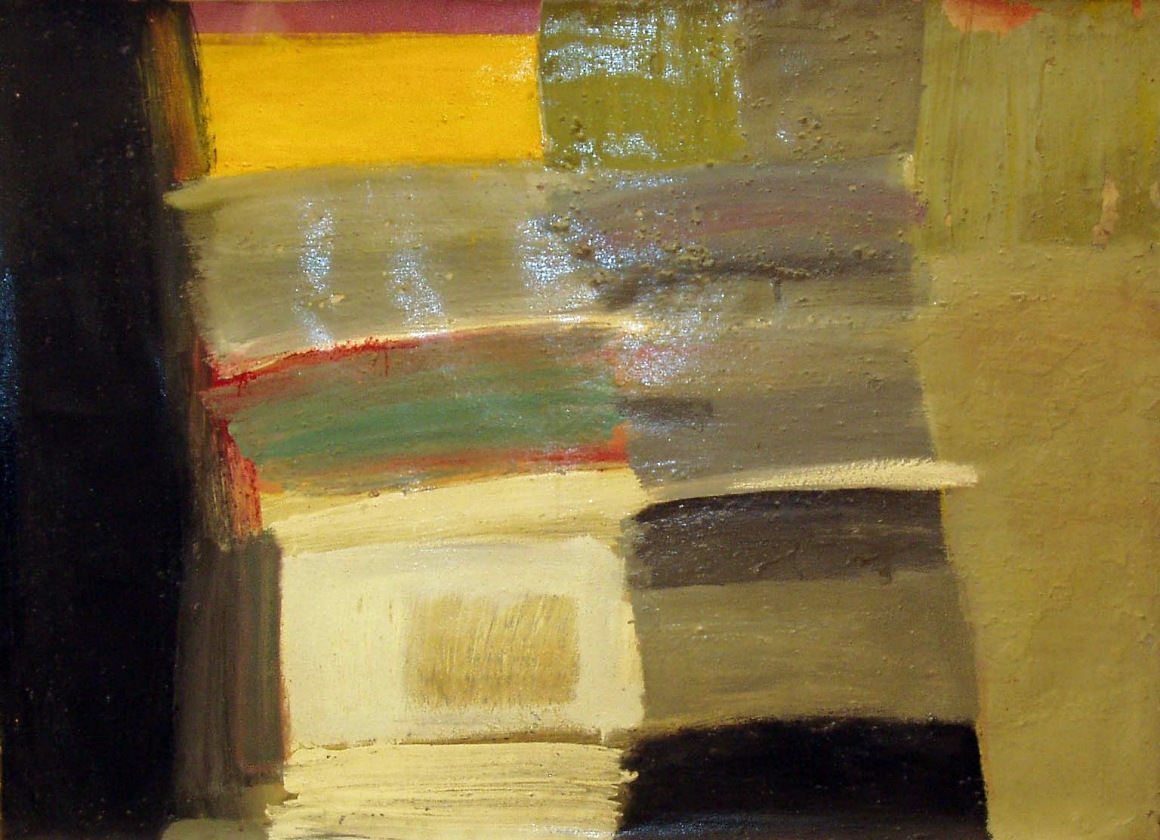
Speaking to one student Hofmann emphasizes that the artist is free to do everything, and what counts is the result. He then comments; “Art is empathy, feeling into a thing, not thinking. If it is mechanical, there is too much brain, not enough vision. For Hofmann perspective is set against the pictorial, because the perspective has only one direction is taken from a stationary position. For painting the key fact is that one has to understand pictorial space that is what goes in and out of depth. A direction must be counterbalanced by a counter direction’ you must reach the edge of your paper.
What goes to the edge of the paper in the end is what is most important. The quarter inch on the edge of the paper can be the greatest part of the space in your work.
Hofmann is insistent that abstract work should have as much meaning as realistic work.
It must express something that the artist has really experienced in nature. It is not enough to be plastically satisfying. An abstract drawing is expressing something that is present to your vision. He then adds. ‘We are not abstract out of a desire to be abstract.
But to express our experience, and to express the greatest with the simplest means.
“ Here we have moment of specialized vocabulary which needs some expansion, namely the conception of the plastic arts, and the task of abstraction. Whilst it can be shown that Hofmann is very much in tune with the earliest theorizing of expressionist writing on abstraction, it is his plaidoyer for plasticity that needs further elaboration.
The notion of the plastic is the term he uses for the rediscovery of the life endowed picture surface as a plastic means. These ‘plastic secrets’ of the picture surface he says were lost during the Renaissance with the discovery of perspective.
Plasticity means to bring the picture surface to ‘automatic” plastic response. The picture surface answers every plastic animation ‘automatically” with an aesthetic equivalent in the opposite direction of the received impulse. Push answers with the corresponding equivalent of Pull, and Pull correspondingly with Push. A plastic animation into the depth is answered with radar like echo out of the depth and vice-versa. Impulse and echo establish two dimensionality with an added dynamic movement.
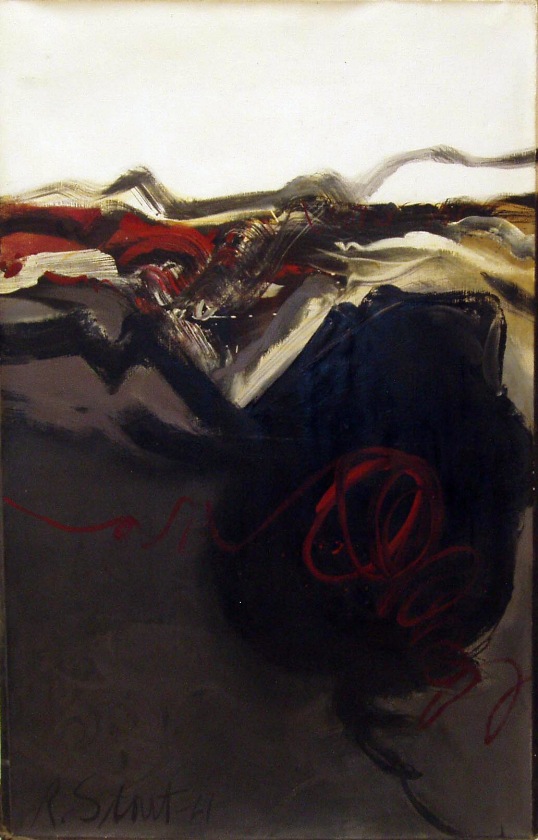
The problem of depth is identified is as one of the most controversial for pictorial creation.
The following extract points up indeed what Stout had in mind when speaking of holes and voids, and why the problem of surface and edge was so central to his aesthetic concerns: “The depth problem is one of the most controversial problems in pictorial creation. It is hard for the layman to understand that a pure two dimensional projection on a flat surface should result in a three dimensional realization with out destroying the two dimensionality of the picture. The Renaissance perspective is the exact opposite of it, it makes the picture surface into an immense hole, and the picture consequently makes an imaginary hole in the architectural wall. The Renaissance perspective was only one direction into the depth. Depth does not answer back pictorially. This produces a sterile space which is the exact opposite of ‘pictorial space’.
The mirror also (like bad painting) produces only the illusion of ‘naturalistic’ space. But pictorial space is an authentically created space and is as such as real as nature. Its reality is based on the Reality of the hidden inherent laws of the picture surface. The entire depth problem in the visual arts culminates in this way in an emotionally controlled aesthetic projection into the hidden laws of the picture surface.” hat then conceptually we experience as depth in nature transforms to the picture surface in an act of shifting, and the physical carriers in this act of shifting are the pictorial means employed in the act of creation; points, lines, planes, with diversity of color, light and tone as attribute of color can have an independent function in ‘pure painting’.
Hofmann again insists on the lively quality of depth, that is not inert, but rather that it is created by pictorial placement combined with color saturation. As experienced in nature, depth is a concrete dynamic, fluctuating, ambiguously dominated by force and counter-force, by movement and counter movement; ‘all of which summarizes into rhythm and counter-rhythm as the quintessence of life experience'.
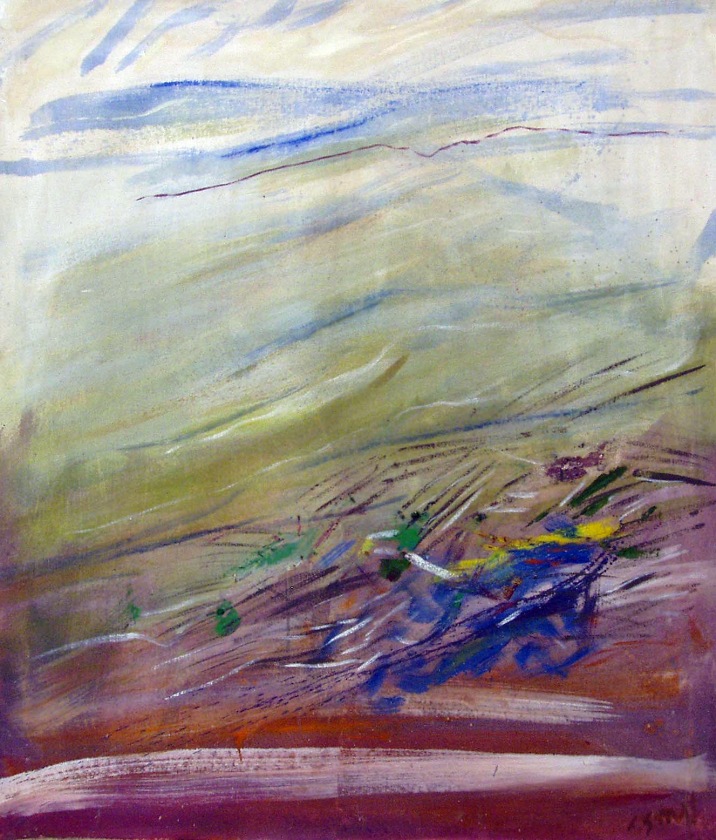
This reference then to the inherent law of the picture surface is the way in which the pictorial development is permitted to be in complete accord with the experience of nature, when one know how to activate the pictorial means to reciprocal plastic and psychological response.
Thus, every plastic activation of the picture surface creates not only ‘real’ two dimensional ’suggested’ movement in the sense of push and pull, the sense of in and out of depth. The interplay of the dual motion produces a combined two and three dimensional rhythm with an ambiguous interpretation of its plastic fixations.
This is what is meant by ‘pictorial space’ Pictorial space is an activated fluctuating space. Plastic depth relations can produce expansion and contraction. Flat design not considered plastically only produces decoration, which is ornamentation.
Hofmann leaves the language of German theory and also then points that in order to understand what is at issue one must grasp the ‘magic of creative relations’, and this is really his core pedagogical aim, to communicate the creative relations to the student, to stress their dependence on the inner vision of the artists, a vision which is only reached in the expression, and sustained through relation of things that are in the process of metamorphosis.
What is need for creation is not the arrangement of things, and isolated patches, but rather the intensification of the senses which is for a supersensory gain, as he put is.
There is always a higher third being sought in the meeting of and effecting of two physical carriers. The higher third is the aesthetic affirmation itself, and ultimately the power of the imagination.
This I produced by the form of the intervals, on which plasticity and any other form of creation is based. Intervals are the expression of emotional differentiation and especially in regard to intensity, to force, to timing, to emphasize and suppression and so forth. As such intervals represent psychological peculiarities in the expression of which they must function in a set plasticity, but ambiguously within the pictorial whole it follows that the equivalent of one relation can be related again with the equivalent t of another relation. So for Hofmann ‘relations under relations’ are the highest form of aesthetic extension.
“The outcome of each and every relation is constantly modified. It is a metamorphosis from one state o development to another and leads progressively to a potential increase in sensorial intensity until the qualitative content of the work has reached the highest point of perfection, where the message of the work and the work itself must be considered physically and spiritually realized as a work of art.” ofmann will compare the interval to the thirds in music “C-E-G’ which are not heard separately but fused into a higher third. If this does not happen in painting it becomes a matter of taste and not creation.
Each sway must have a counter sway. The fundamental shape of objects is usually very simple, to make it plastic you only have to adjust it; it is not the modulation but the negative space which his important. One section of a unit must go up, the other section as a unit must go down. The fundamental character of a space from which everything starts is from a fundamental up by a third division is created a fundamental down.
He give the example, in this area is a chair, it is not the chair that is important but in this area one caught certain things, so another space division can arise. It is from these right relations that pureness arises. By giving space you give the masses, and so it is not necessary to draw the volumes.
The various elements of line plane and volume must be considered. The line, for example should also work spatially, in relation to another plane.
In a strict sense the line is the expressed of the point when it carries a depth element, the line flows in and out of space, which is what makes the drawings of Matisse so beautiful.
But is easier to think that the line is controlled by the plane, and that every object every shape is fundamentally a plane.
Hofmann also stresses the hygienic quality of modern art, something that is also insistent in the reflections of Stout. ‘In modern art physical and mental cleanliness is the most important thing”.
Plastic sensing is what is important, there should be no accident, and you deal with the space around the whole object. Everything in the background counts. Plastic means everything is related to the shape of the paper. It is how you adjust the object outside to the picture plane. The really great artists have the capacity to make one thing big through other things. The problem of the plastic is to use the model to create certain spatial impressions. One should not draw one part right over another, often a beginners fault but like this. Planes can be used to create rhythms.
Even for color it is composition that gives the possibility of free movement, since color intervals are not dissimilar to intervals of music. One must be guided by creating a color volume, creating a contrast in the weight of color.
Less is more, “you must say in the least the most, not in the most the least”.
What is at issue here is that living space is created by living means. If you do not have a perfect two dimensionality, if this is destroyed then naturalistic space is created.
Composition must be in planes.
Here Hoffmann makes the point to the painter – one which will ultimately be of such moment in the work of Richard Stout-create the space as an architect creates the space, by use of planes. This gives the possibility of eliminating unnecessary things.
Otherwise the result is chaos. Even the most complicated relationships are based on elimination.
Mc Kinnon had also insisted that her students should spend several hours a day with life drawing, and Stout would use drawing as a means of preparing his larger works.
So, for example this had been the ideal preparation for the teaching in Chicago with Paul Wiegart who had been a former student of the Bauhaus, and had come under the influence of Itten.
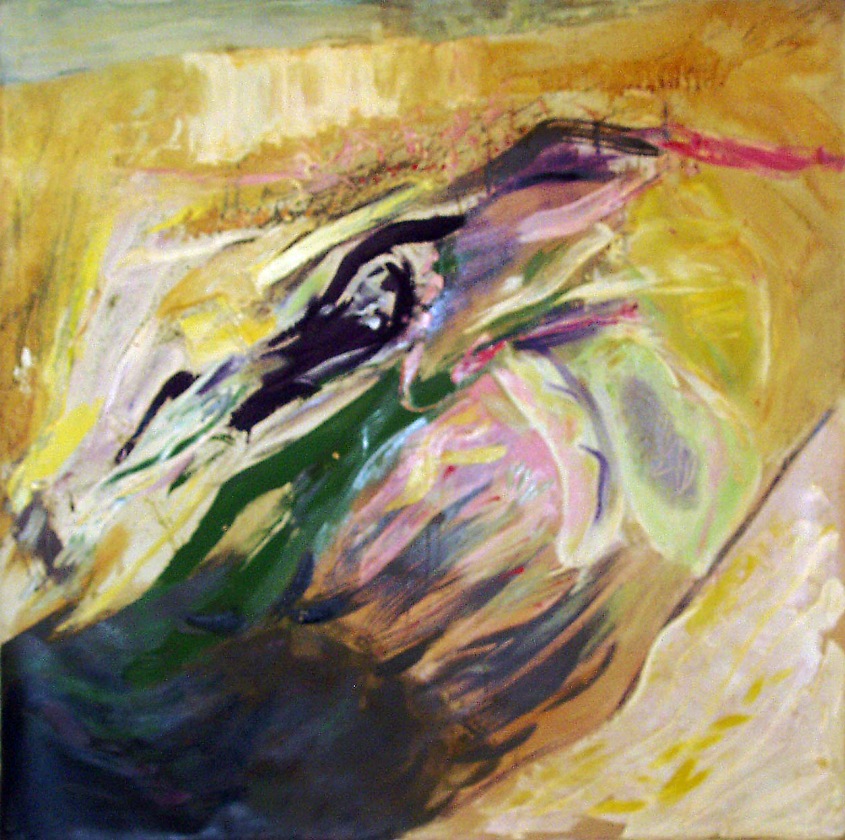
Wiegart insisted on abstracted figure studies, and was fond of repeating the maxim “you must understand the form”. His classes were very crowded, and people worked literally an arm's length away from each other, there were often 30 to 40 students, and even though there was emphasis on working from the model, there was a lot of freedom in respect of the model. What was very specific in the teaching was instruction in the creation of plastic space, and of course this is as discussed earlier a direct Hofmann inheritance.
Stout was a workaholic, a point he would make in interview in the 1980’s.
Already during his years at the Institute he seems to have produced with a maniacal intensity.
The result was that in his final year he faced almost physical collapse, contracted hepatitis, and missed out on a traveling fellowship. His mother and aunt came to Chicago in a Studebaker. They rented a U-Haul trailer and piled a few ‘hundred paintings, several thousand drawings, and dozens of editions of prints’.
However illness or not he had a garage sale in Beaumont, raised enough money to go to Yale Norfolk for more study, and spent six weeks there. It was not altogether clear that he wanted to live in Texas, and he took to the road.
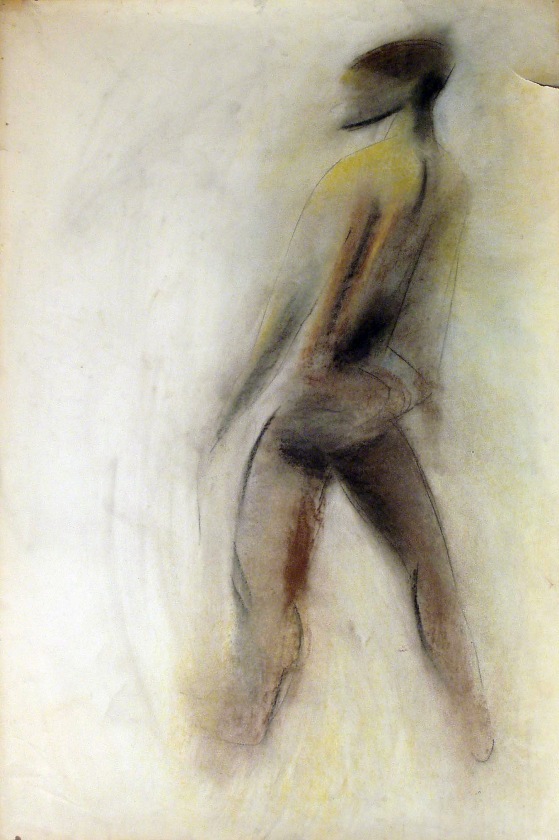
In a way Stout could not really settle in Beaumont.Even after graduation in Chicago he was still only in his very early 20’s.
During his father’s illness he had received the commission to do the mural for the school, and also spent some time cycling out to old oil fields, which remained for him memory as an intense fragment.
The fact of fragments became a challenge to his own sense of what was a composition.
His physical problem was that the space of the painting into which he wanted to enter, was itself a fragment of a larger whole and the translation was not a loss of meaning in duplication but was what was available, there was no slipping behind the mute encounter that took place, and layering with meanings that could be transported via the material realization, in pigment, or water color, oils or graphite.
The puzzle remained for him that the sensations and expression were somehow mute, there, given and yet elusive. He couldn’t just think of himself as an artist either as an aggregate of the experiences and lessons he had received, there was for him a guiding profound sense of unity, but this could only be manifested in action, and that action was for him the real. This intense awareness made him refuse some very obvious choices which young artists might have considered inevitable, namely to move to New York, to be where the scene was. He could feel constantly the continuum from small impulses and experiences which had even congregated in his mind during the last illness of his father. The response to the oil-field was a mute equivalent to the sense of being dumb in the face of the whole of the visible world. The heaviness of the field, their charred stumps, the blackened earth, and rusty debris, had also a weight and intruded itself into any ideal of a landscape. This was no locus amoenus: there would be no lyrical and pastoral fantasies in light of this exhausted earth.
He had been a willing student, and had acquired skills. More significantly he had understood the limits of an intellectual vision, that is to say he knew from his experience, and his later desire to be a teacher, that teaching was realized in the student’s act of learning, and that learning was a process to learn how to learn. If the principle teaching of Wiegart was to know the form, then the relation to the object for the human mind remained simply an achievement of attaining the character of the object, often and only indirectly and from its effects. This could lead to a grasping of the real as a process of construction, making models, whose main satisfaction was intellectual .In such an understanding on could not posit that there was indeed a grasping in intuition, which bypassed the constructivist paradigm.
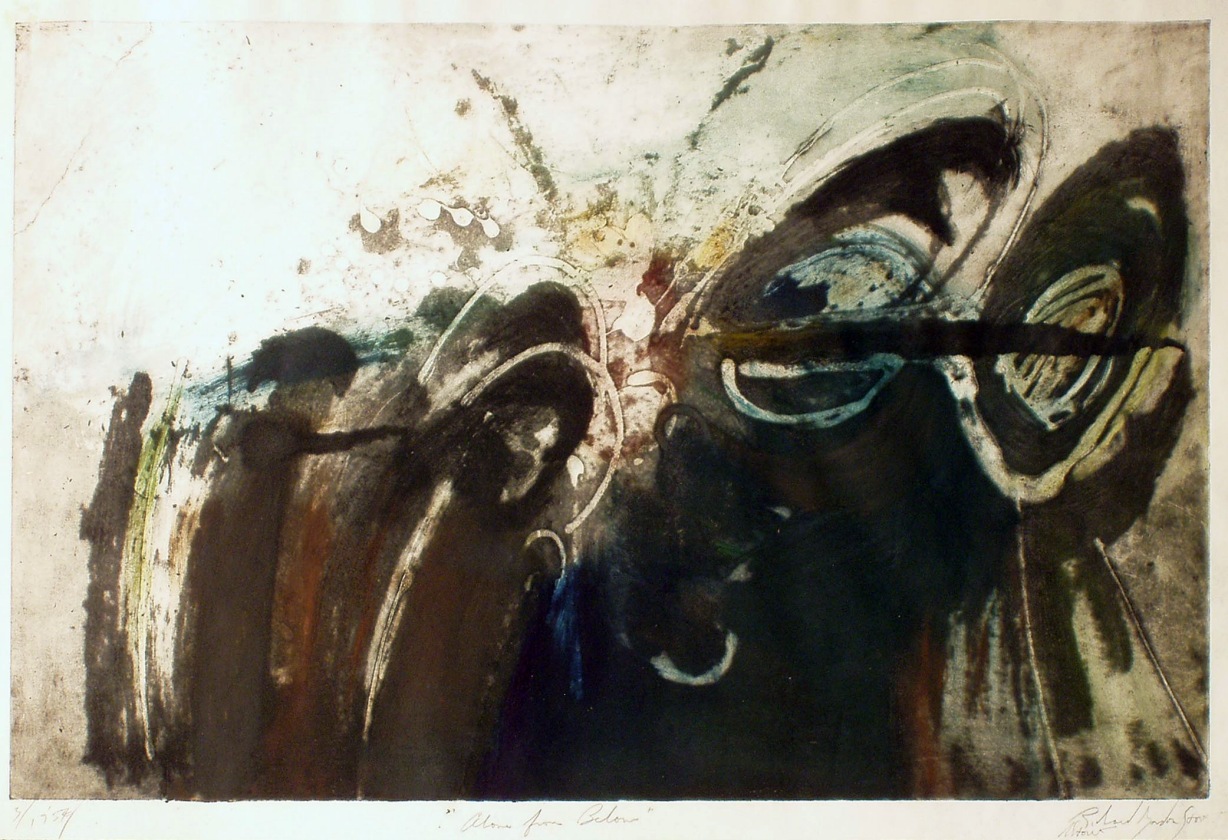
Nevertheless it was only through the material and intellectual realization that the intuition could be crystallized and held as if in suspense, to await the viewer to release its energy and participate with the artist in the original feeling of the creation itself.
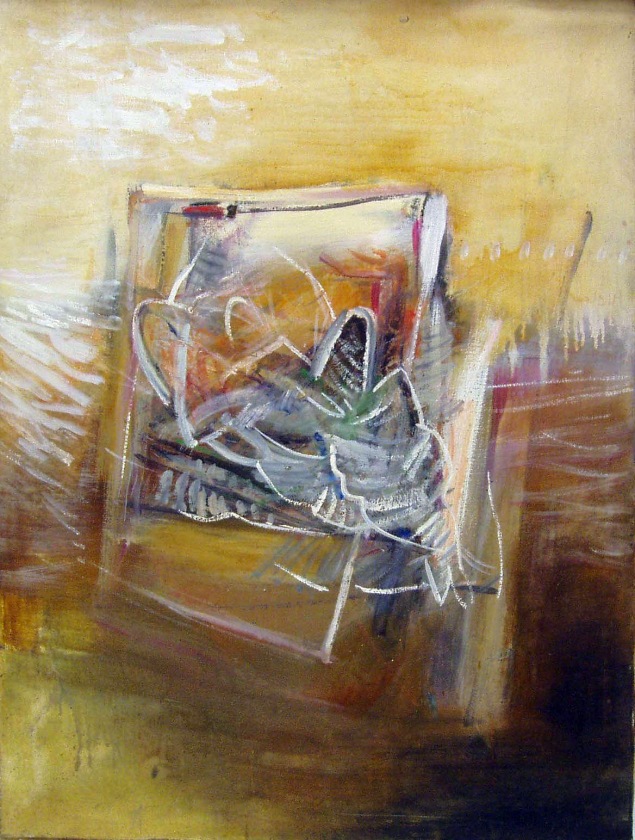
If however it was the case that one could only grasp accidents, think through the fragments, then what was the sense in which capturing the structure of the real could yield any criterion that was not circular for judging its success? The emphasis in his learning had been on the process, the melding of sensation and the creation of pictorial space. Perception on that account had to be efficacious; it emerged from a pressure of the past, the sense of continuity and the derivation in which experience cam to be understood. Since we experience in time, the experienced world gives itself to us as coherent in the temporal flow, and thus Stout’s understanding of the daily performative exigency of painting practice.
If the search in the painting was to create this twisted space that had weight, as Stout puts it, then this was also a torsion which came from his understanding of nature. The early statement was obviously dependent on the ancient hypothesis that things occur in nature as if they were ordered towards an end. Yet, the experience of death and love both seemed to make a mockery of such coherence. He had discovered death as a fruitful place. This was a kind of guilty secret.
He wanted the process to be an adventure, to be really open, not in the sense that the door is open in a room, or a window, rather he needed the push and impulse towards the new and the richness of what is given only in flashes.
This gave him a sense that the world could renovate and change; that new values could be created, and most significantly he would be given to himself as a subject. His musing which can be found in letters and jotted notes, very much echo the thinking of the philosopher Bergson in his Creative Mind,: emphasizing the sense that the matter and life which fill the world are also within us, and that the forces that work on all things can be felt in ourselves also, and whatever may be the inner essence of what occurs we are also of that essence.
Stout understood that such making kept him in an intense, enclosed space, in which he had to trust.
At the same time, during the 60's, Stout paints in direct response to named artists such as Manet and Van Gogh.
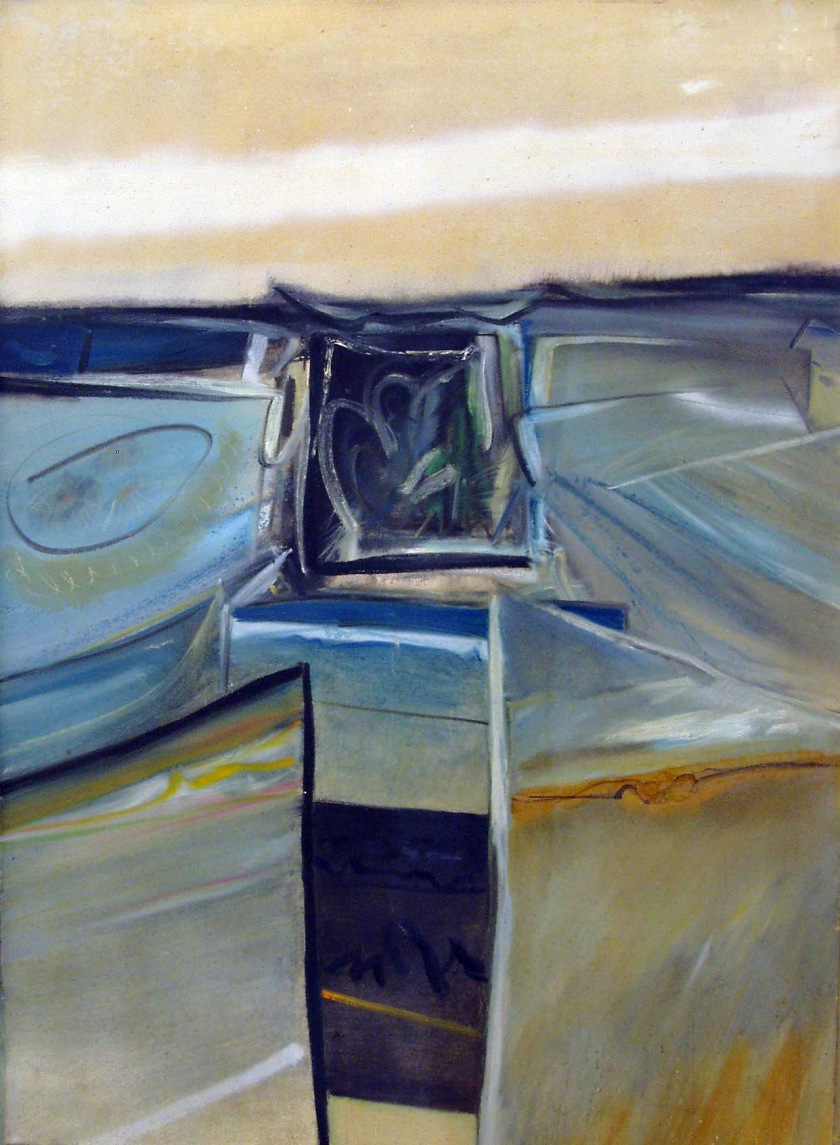
The demands of teaching were for the student to understand when a work was right.
They needed a combination of the psychological and plastic where every expression had a plastic base – to again use the language of Hofmann.
Beautiful color became meaningless if it was not bound to a shape, and the use of hues which touched so much on the emotions, fell into the sentimental if not carried through. The planes had to be for the painter as the wall for the architect; however color planes had to avoid looking like cardboard, which indicated that the creative process did not flow.
Color then lies on the surface and is not absorbed. For a successful work the color literally had to be woven in the surface. It had been the most insistent point of Hofmann’s advice to students.
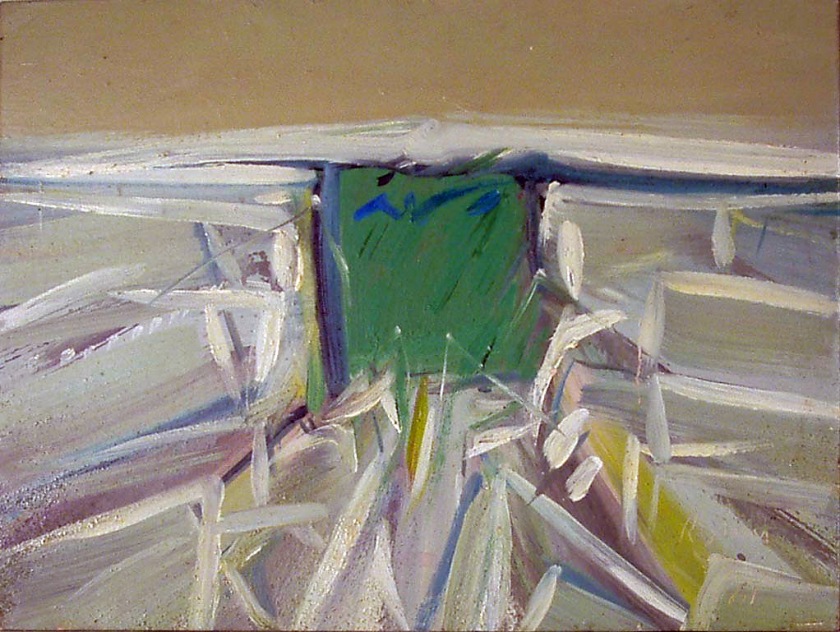
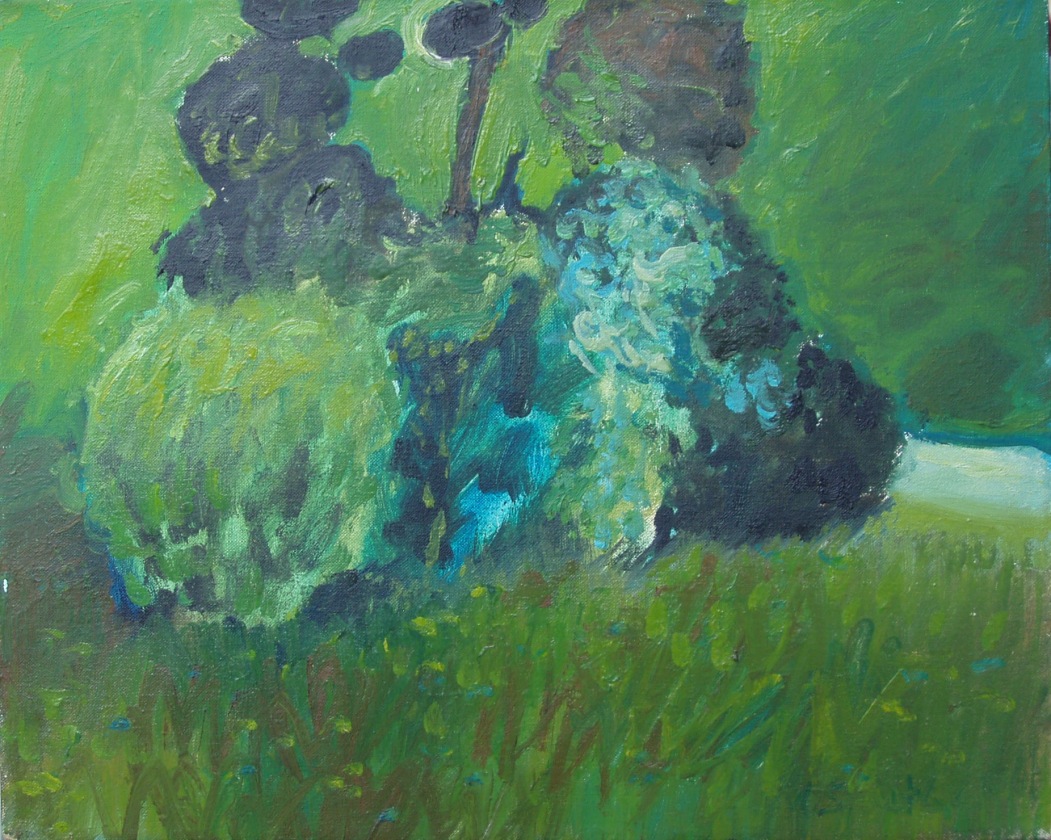
“Living space, created by living means. Should have a perfect 2 dimensionality. If this is destroyed naturalistic space is created. Composition must be in planes – in color-to recreate an absolutely new flat surface. Composition must be there, no matter how powerful the color, even pure color is not enough, if composition is not there. Modern painters must know the use of planes for a certain purpose. If you have planes in a tonal sense, no negative space is created – there is no in between planes. Has to be openness in creation brought back to 2 dimensionality. Expansion from the inside makes the work. One must look in a picture, not on it and one must have the sensation as if the painting would explode. Matisse – through intervals color becomes even more beautiful than it is as color – e.g. between black and red is a big interval.” he literal dualism of the 2 and 3 dimension of reality is taken in this system as the gap between reality and appearance. Through contemplation and spiritual projection there is a development of the sense of space. This projection is making of the carrier a kind of screen in which other material realizations takes on communicative and expressive potential." (Hofmann's Teaching Notes, 1947.) Stout in interview given in 2003 spoke of this time as one of an effort to ‘get into the painting’.
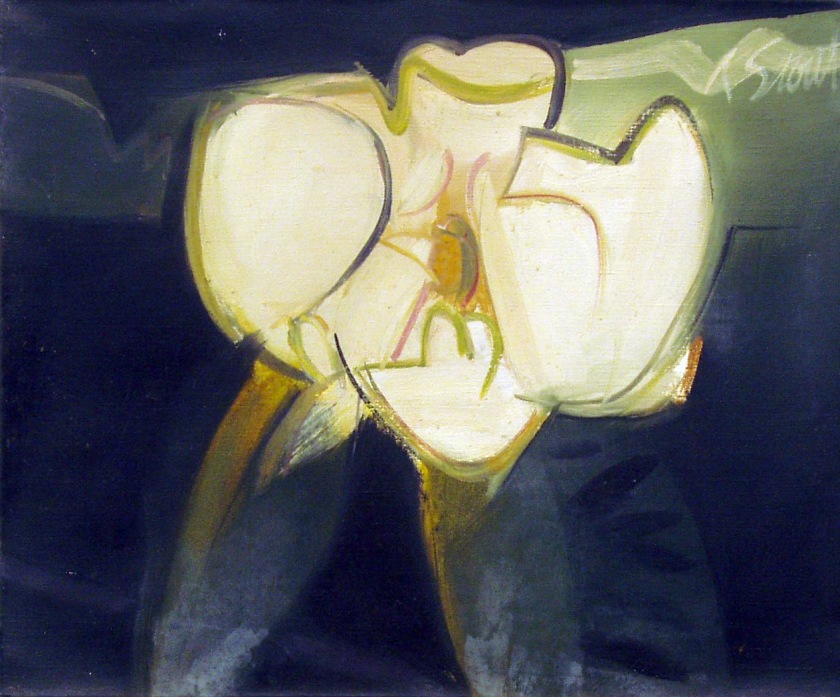
This is an enigmatic phrase, repeated often by the artist and left without commentary.
In effect it had a very precise sense of the practice of painting as a daily encounter with the possibility to do something.
The work ethic remained from his puritan religious background even if his religious sensibility had become effectively pantheistic. Leaving art school he now had to face himself, and face the uncertain future. Being precocious has a short and merciless time limit.
We can detect a double turning here, the turn into experience, and the turning towards his own inner conflicts, and search for responsibility.
The illness at the end of his studies and the movement around America to find a place to settle was the beginning of a new phase of activity, and it is to works of 1956/7 that one needs to turn to see what is a new intensification and confidence in Stout’s work.
Pictures from this time remain among his own most cherished. It is likely that they are also the freeing into the zone of the painting that he was so actively trying to achieve, and which he could only accomplish by being away from the daily influence of teachers and academic curriculum. He achieves what Hofmann had spoken of so urgently, the feeling of a sensation ‘as if the painting would explode’.
The artist had to learn to absolutely trust his own feelings and sensation. It was not a question of looking at nature and reporting what was seen. Such a mechanical view of perception could not yield any real insight. The task was much more daunting.
One had to reflect on experience itself, and trust that this also showed the main structure of process in nature.
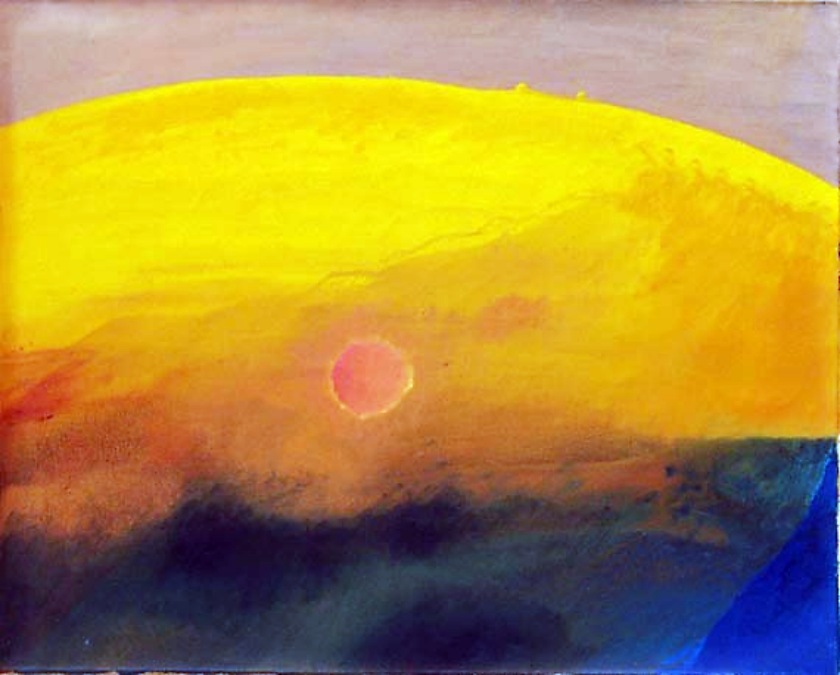
The need to create ones own value became more and more evident in this self-reflective activity. However the way in which the artist manages this activity of reflection is also one of constant refuge, by changing the situation, there is resolution and flight, a thickness of emotion, and like a fold in the surface of living makes a new figure and ground. The demand of spiritual projection the grasping of the space and sense of space, was always modulated by the insistent sense of the flow of time, of things also escaping from attention .This escaping was also the way in which the expression would offer the difference, which re-presentation could not advance, remaining abandoned in the mirror of similitude. Stout needed the folding in movement to enact the sensation even when giving it a direction that was as much mind as body, as much body as mind.
Stout had made the resolution to harness himself and face this as a task where being present to the possibility increased his ability to discover the necessary unity of his own experience. If he could not continue to paint his emotions, to actually move his movement of feeling into the fact of the world as he experienced he would fail to exist.
The question of where he had been was itself also a matter of interval.
The technical summary of instructions in painting, were equally an existential handbook which showed him how he was traversing even wider intervals than between black and red, what kind of unity he himself had become.
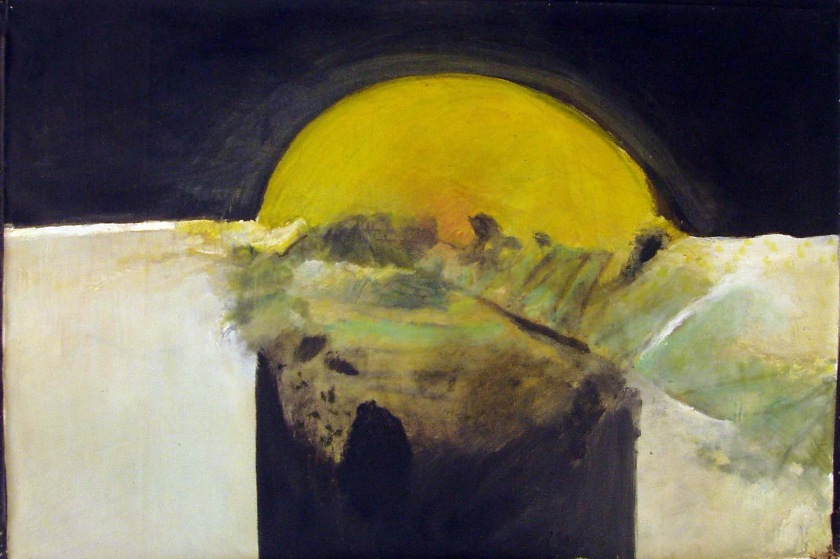
His commitment to expression was also necessarily an undermining of the richly representational strategies of much of the history of painting in America. It is difficult to imagine what the tradition would have been without the impact of the European avant-garde, and the release from the burden of depiction which Hollywood made for painting.
The advent of television in the post war period also freed painters to move more easily to an abstract expressionist work, action painting, and ultimately color field, and minimalism. The challenge to abandon mechanical vision, for someone richly talented in traditional means of depiction, a darling of the Sunday School painters, was in one sense suicidal. He would have to bring his public along with him, even as an artist become an educator.
Joan Seeman who worked at the Department of Art University of Houston, writing in 1977, gives the earliest clue to the source of the explosion in Stout which we can date to 1956.
Again there is an inter-iconic self reference, as the work which is discussed Monument Valley, is seen literally as a re-emergence of the form, the composition, the aggressive style of the Gibraltar painting Stout did in 1956 where slashing paint strokes simulated the ferocious coupling of man and shark in Lautréamont’s Chants de Maldoror, a work admired by Stout .
The literary work of Isidore Ducasse, (1846 Uruguay-1870 Paris) under the pseudonym Comte de Lautréamont became a favorite discovery of the Surrealists, who viewed it as an explosive premonition of a theatre of cruelty, and a deep allegorical reworking of themes of Gnostic and romantic rebellion. The text is organized in six cantos, with their coruscating phantasmagoria of fictional, emblematic being, Maldoror, who rails against creation, and mixes Byronic-diabolic delight in evil, and shows an unrelenting belief in the hatefulness of humanity and the evil of the creator, who sits on a throne of gold and excrement and devours blood of victims and their flesh and bones; it is a Moloch set against the figure of Maldoror who can transform into giant octopus and in this apocalyptic Sethian Gnostic scenario, is constantly pitted against the Creator, whilst rejoicing in the seduction of especially the young to evil.
Raw eating and rage go together, and hate is a pure passion, without pity or remorse, and tenderness when shown is utterly willful.
The various metamorphosis of which Maldoror is capable include the satanic bestiary, and the character during one of his self apostrophizing moments recognizes his love of blood-sucking with the character of the vampire, but assures the reader he is alive. The artefactual creation of the text itself is mockingly referenced in the final 6th Canto, and the work is made up of Gothic novels like Vathek, by William Beckford, and Maturin’s more famous Melmoth the Wanderer, closer to home in Paris there is also the concoctions of the work of Sue, and the literature of ‘evil, which Praz had studied in his 1933 The Romantic Agony.
Walter Benjamin thought though that if the book had any lineage at all, it was that of insurrection.
The flagrant delight in cruel destruction and physical disgust carries with it a sacral imprint. Zones of obscenity and social conventions are breached time and time again, and in the chilling address to pederasts, the story of cruelly mutilated and wounded lovers, finding each other again in a set battle, and transforming into spiders to feed on their Maldoror, gives a sharp and vivid jolt to the excess of which the imagination is capable.
Artaud admired the work fervently. In a much neglected text of the philosopher Gaston Bachelard there is a sustained reading of Maldoror in a book length publication entitled Lautréamont, first published in 1939. He sees the work as a phenomenology of aggression, in which the devouring of time characterizes the animal vitality and the immediacy of aggressive impulse, where everything is action and infliction on others, little is undergone, or endured.
The devouring of time is also an explanation for the enormous references to biting, kissing, the mouth and tongue. It is an inhuman fable which revisits the brutal impulses in he heart of man. The immediacy of action is also intrinsic for the form of violence in the work, which is animal, and is ardent. An entire sequence of paintings by Stout in the 1980 can be read as an exemlification of this very oint.
The frenzy of the character is a way of occupying new psychic spaces, it is less interested in the human than even the world of the Marquis de Sade, or Casanova’s animalizing of the female, as a place of predictable pleasure. Maldoror seeks destructive metamorphosis. This is the most instant way to experience a vigorous act.
There is a desire in the action and gesture for attack, which release energy. Kafka, Bachelard suggests is a negative of this, where time is not increased in vigor by action, but lives in the zone of dying, of dissolution even in the process of metamorphosis.
With Maldoror one is in the joy, the explosive energy of decision. Man appears in the work as the sum of vital possibilities, who becomes a “suranimal”; that is has every possibility of animality at his disposal. Placed with this one must also put the moments which are more human, criminal, engaged in rebellion, even heretical and sacrilegious gestures.
The notion of vengeance is dominant, and belongs, Bachelard argues, to 'ressentiment d’adolescent'.
From here Bachelard reads the form which the frenzy takes, as revolt and rebellion. It is a revolt against fathers, teachers, authority, God.
It is a rebellion against the imposition of patriarchal requirements even in the culture of youth and teaching, the metaphor of violence and desire in Maldoror reflects the cultural brutality and play of power and forces. The source of cruelty in reason and mathematics is not the issue, rather that this is the form in which it eventuates; pure coldness.
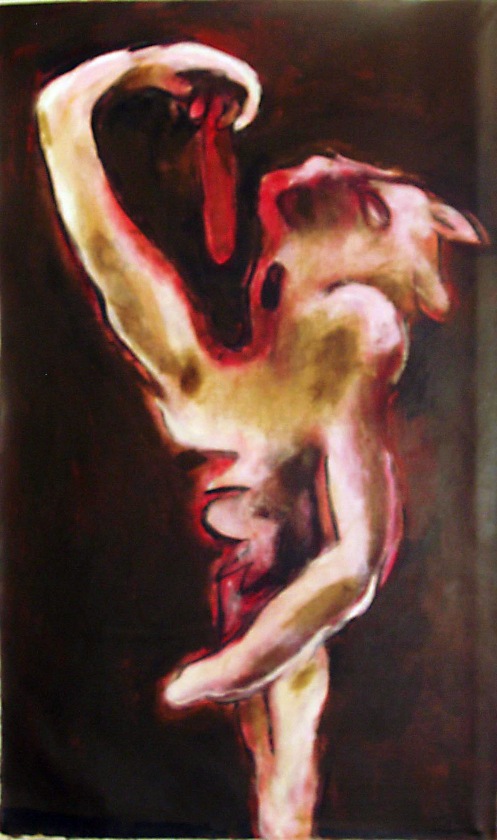
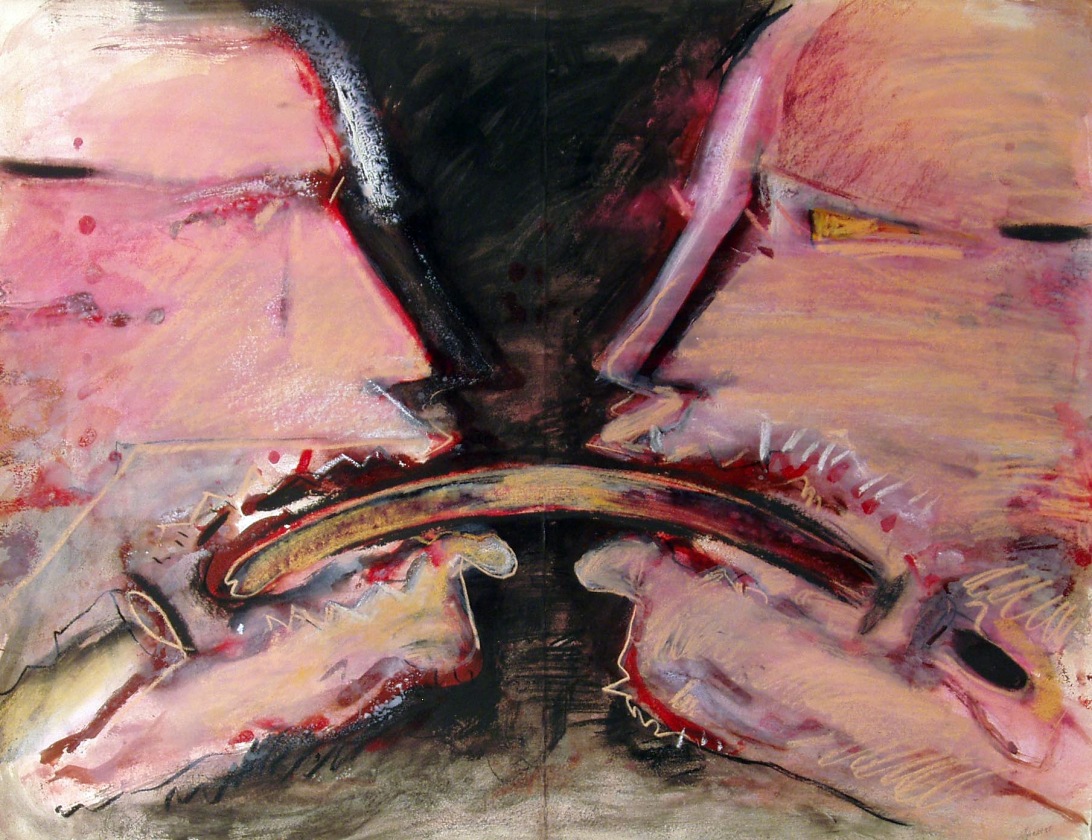
Bachelard notes the Surrealist delight in the phrase of the meeting of a sewing-machine and an umbrella on a dissecting table –une machine à coudre et un parapluie sur une table de dissection”.
What is urgent in the work is that the book invites a life that is unlivable. Everything is to become an expression, a language, but instantly. To coin a word he seeks only ‘expsychment’, pulsions and explosions, not in words, but in sense and senses.
Ultimately the gesture and expression is a muscle of action, of vitality and not reflective acts of consciousness. The universe of Maldoror screams, it is active, and as Bachelard notes’ energy is an aesthetic’.
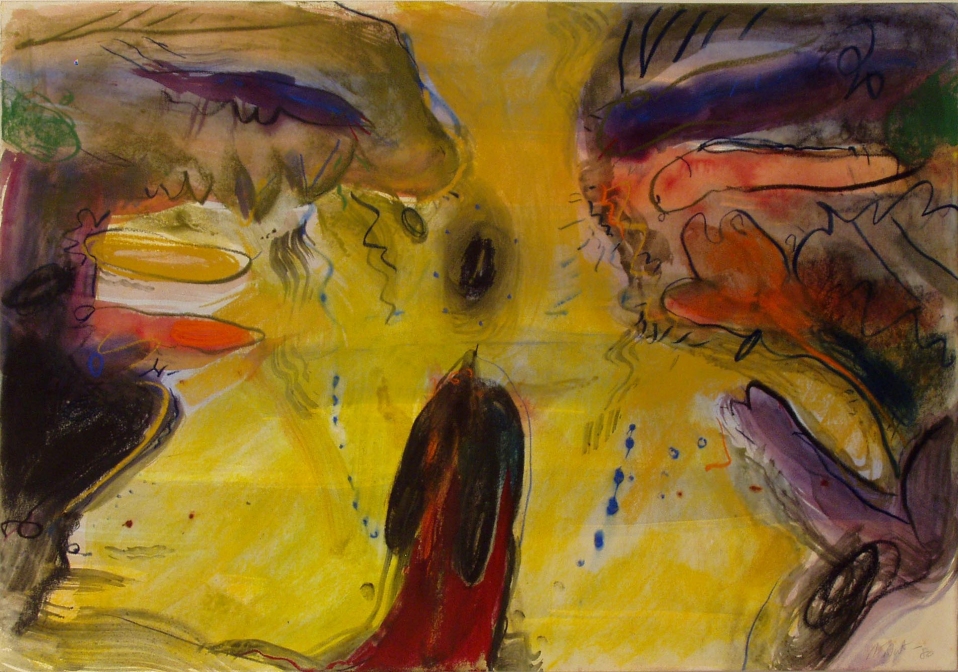
Thomas McEvilley writing in 2004, agrees that the series of paintings from 1955-6 shows the early vision from which much of the later work can be seen to have evolved, citing, among others Study for a Swamp and Rice Field, Sunset Landscape, Landscape and White Sky. Part of his analytic strategy is to see the paintings of the 50’s as moving a decade later to a harder edged and sharper focus Before turning to consider this, it would be useful to outline the move of Stout to Houston.
The choice when made was to be, as we can see in retrospect, a direct commitment to the city of his adoption for the greater part of 5 decades.
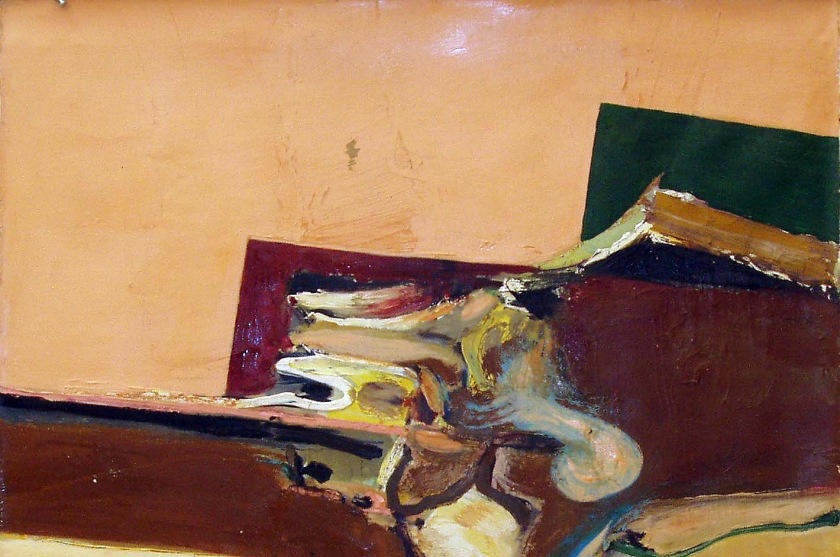
Texas was not the obvious and immediate choice of the Stout.
Stout went on the road, but unlike the Beat generation, he made it a point to visit the Chamber of Commerce in each city that he visited, and with a methodical and pragmatic eye, he would literally analyze the data on the intended place of his translation, thus finding out as he put it ‘all the figure’; the wealth figures, the foundation figures, who pays for what, what are the taxes like, what’s the cost of living, what’s the growth potential, and as he says, ‘ what’s the climate like. He only was set against living in California, although he liked to visit Los Angeles. He wanted to be in a place where he could breathe, and didn’t want to go to an art center, such as New York then was, to have his art world:''put into a pencil sharpener of any other city to hone it down.” e knew Washington, Baltimore, and Cincinnati – where he appreciated the German element – Chicago. He traveled to Milwaukee, and would find Minneapolis too cold, he also visited Kansas, St. Louis, and Dallas.
Eventually after a month an a half on the road, he checked into a fleabag hotel in Houston, proceeded to find out the facts and figures, and on that basis Houston was the best choice: “And I love the climate, I love the people. Its home for me”.
In what indicates the open nature of the society in which he chose to operate, he could report that within two days he had ‘arrived’. Within two years he had finalized his commitment to the city by purchasing a house, with the help of his mother, which is still his principal residence.
His debut took place at a party in the house of Henri and Lelia Gadbois’s home on Bingle Road. Within the growing art world of Houston there were the CAM groups and the people of the Menil. Stout was so taken with his meeting with Jermayne MacAgy ‘I decided that I was going to be one of the Menil people”.
He also had the offer of a gallery, although his first connection with the Cushman Gallery proved short lived, they asked the artist if he was planning to do any figurative work soon, to which he replied; ‘no’. They suggested he might be ‘more comfortable’ at Katherine Swenson’s Gallery, to which he duly moved..
Stout would comment much later “I was still young – twenty three – and this was November of 1957 when I arrived”.
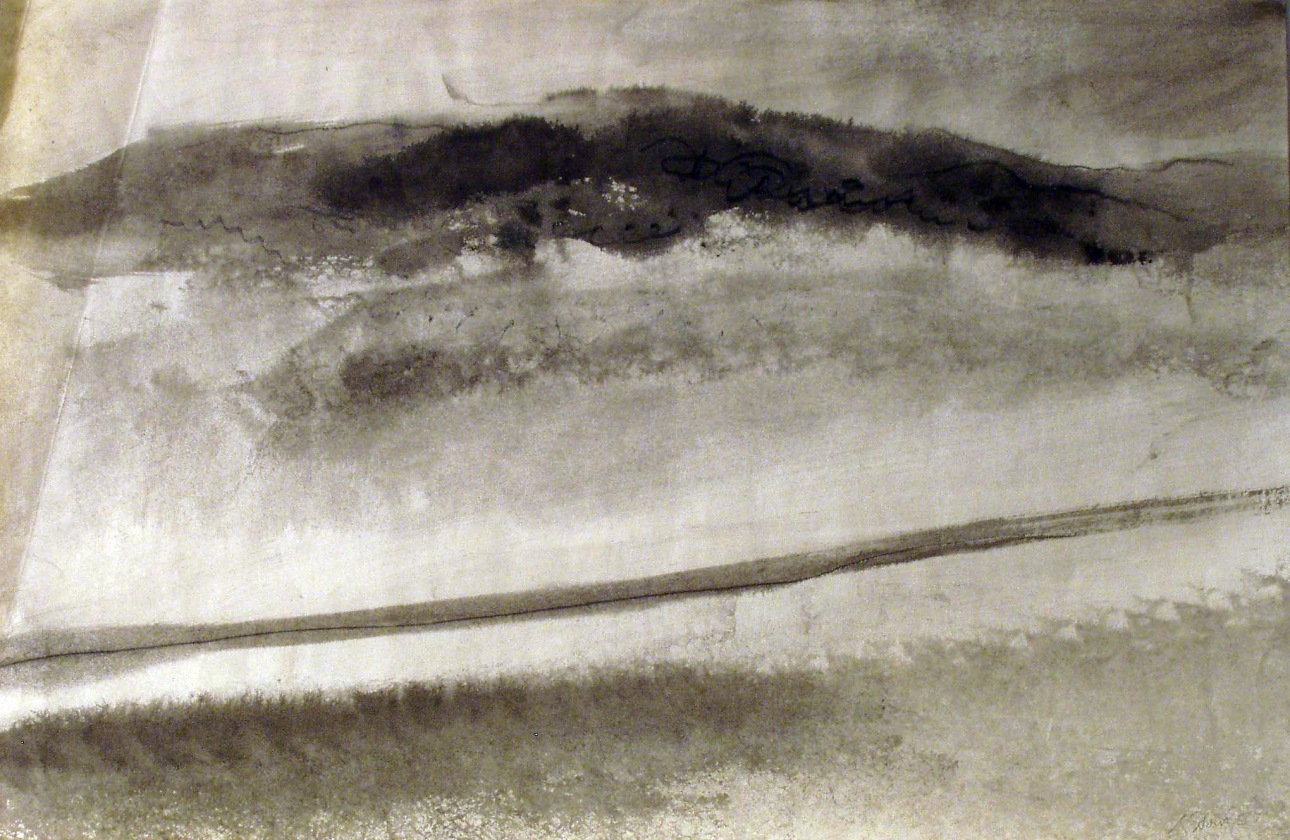
Again one can find a more detailed sense of what the city meant for Stout, in an article by Morris Edelson which appeared in February II 1985, in the Houston Digest… where Stout now settled almost 30 years, freely reminisces about the Houston of his first choice to live.
The interview reveals details not otherwise available. He had surprised Edelson by making connection in conversation and the canvas which were a kind of jolt.
Who else, Edelson asks, would relate the austere landscape of Simone Weil and the existentialists, and the oilfields of Beaumont? Stout focused on the contrasts, the jostling of what he called absolute beauty with ugliness, of the good with that ‘deadly thing’ evil, so confusing yet appealing to the Symbolists.
Edelson continues: “In Beaumont, for example, he saw the city’s social center, the Country Club, and just across the river, the “bloody Vidor”, known as a haven for rednecks, or the large Catholic Charity hospital, Hotel Dieu, sitting right on the port turning basin: “I had a sense of conflict, a sense of responsibility” he said of his boyhood, when his teachers and parents were applauding him as a prodigy. ‘Things weren’t balanced and at peace – the church told me they should be, but they weren’t. …..I work very hard in Houston.
Houston is a city for hard work, no place for the weak or timid. It takes workaholics.
There is a charm, a sense of neighborhood, continuity and privacy.
There’s an extraordinary level of tolerance here, an almost arrogant self-confidence.
That’s why I’m here.” hat he meant by work he confided to Edelson :'I have many ways of working, I might draw 15 or 20 charcoal sketches on the canvas, wipe out and re-do, until I have a sense of rightness. As I go on the work must continue to possess this shifting sense of rightness – the work takes on its own fabric. It’s an extremely complicated reductive process”. The words are uncannily reminiscent of Hofmann’s reported teaching advice, especially the phrase ‘shifting sense of rightness”.
Stout’s view of Houston had an early airing which resulted in a minor disaster for such a socially sensitive person.
The article carried a photograph of Stout in front of his work Oedipus, and has him comment on the nature of contemporary society:''much of our society has to do with oedipal ideas – the murder of the father and the rape of the mother, and the consequent loneliness”.
The laconic summary without further comment points to a dimension of Stout that really catches one off guard, especially if lulled by the delicate, slightly hypochondriacal inflections of a Southern gentleman.
Lowell Edmunds in his recent publication Oedipus has contributed indirectly as to how one might read this work of Stout, and the richer implications of an abstract expressionist work on Oedipus as its title. It is possible that during his travels in 56 Stout had seen the famous painting of Ingres in the Walters Art Museum, Baltimore.
Lowell draws on abundant evidence to show the mutation in the reception of the myth of Oedipus through the romantics, down to the highly critical work of Levi-Strauss in the 50’s.
Briefly Hölderlin in his prose poem The Lovely Blueness had read and translated the Sophocles version of Oedipus the King and in the notes stresses that the act of Oedipus is the defiance of the divine that is nature. He is possessed of wondrous, angry curiosity which is a raid on the transcendental. Hegel emphasizes in his interpretation that the act of Oedipus is that of riddle solving. Oedipus has given an answer to the Sphinx, and yet is unable to understand his own life. The conflict in Oedipus for Hegel is internal.
The Symbolists favor an eroticized version of the new iconography of the nude, heroic Oedipus initiated by the version of Ingres. This erotic theme can be traced from Moreau’s Sphinx of 1864, and is released through various works in sculpture of Christophe, paintings of von Stuck, and the Belgian Knopff.
The gesture of Ernst towards the Ingres figure, via collage creating a mutation of the new iconography, is the acknowledgment of the truth of the modern – post Hegelian – view of Oedipus as the rebel, and great transgressor.
As will be seen later it is likely, given the painting of the Fate of Knowledge at the time of the re-working of Oedipus Stout is best seen in terms of the problem of the conflict between experience and his artistic production which itself constituted the constant push and pull of his life: there is also the issue of techniques and his aesthetic judgment, his judgment of taste, which was also his way of living, and not some external resource which could be chosen among a host of possibilities.
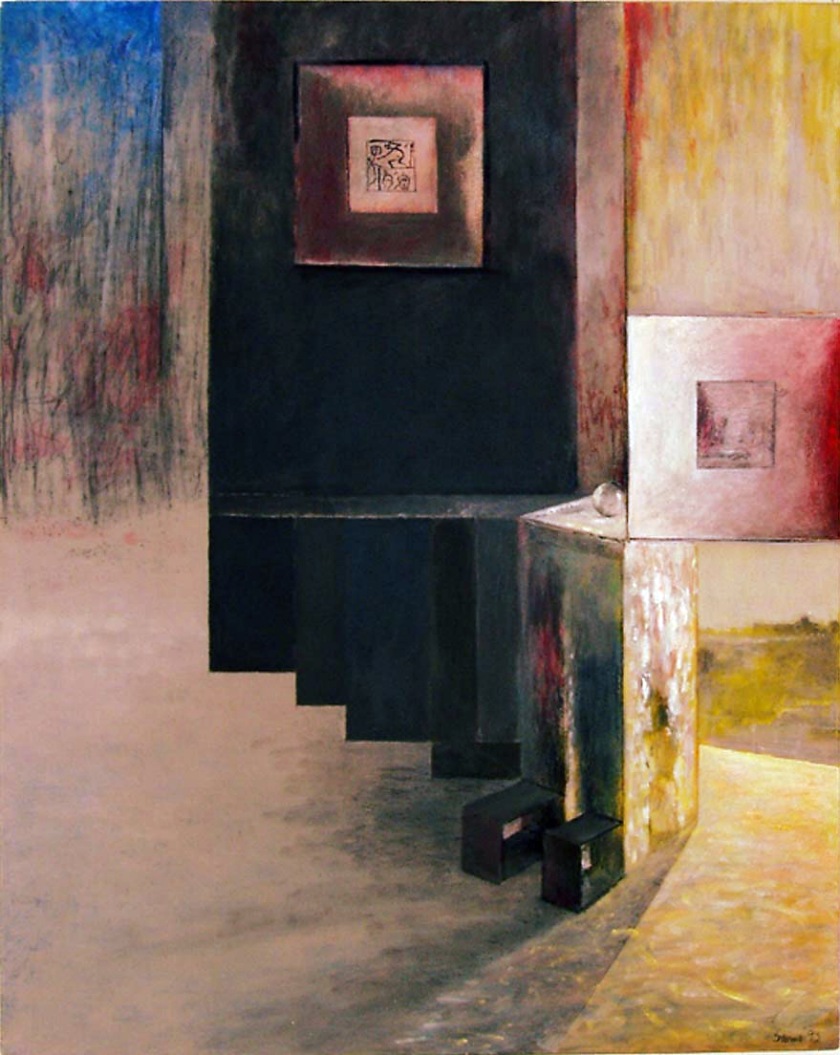
Oedipus is on the account of Sophocles, it can be argued, one who remains psychologically the same from the beginning to the end of the drama. Otherwise we are presented with a figure that remains pervasively double. Oedipus comes to see the contradiction he has been all along, but the peripeteia of the play the ‘reversal’, is not about some kind of metanoia, or conversion experience, a born again Oedipus; he does not become someone else.
What is disturbing for anyone with such expectations following recognition, is that here Oedipus defeats the so called notions of identity and logic of excluded middle.
He is a noble ruler and a criminal, he saves the city and is its curse, he is the first and the least among men; he can solve riddles and himself remain a riddle, a man of keen intellect and a victim of his own mental blindness, the hunter and the quarry.
He is both what he appears to be and what he does not appear to be.
The phenomenon is one of unmediated ambivalence. It is better to think in terms of a constant shifting, a mobile ambiguity, in which the logic of contradiction of behavior and the notion of a unified identity is not just blurred but constantly inflected in which no limited term is available. It is as if the human person is a constant frontier capable of complete reduction or expansion, of containing irreconcilable traits that cannot be harmonized, and who is only transparent in projects or even capable of deeper awareness in moment of extreme rapture or sluggishness.
Again it is possible to return to the earliest surviving statement about his intentions and find that Stout has intuited the lines of force, the way in which demarcations work.
The relation to nature is gained by an exacting effort, and at the same time, the project of perfectibility of the social, is now simply a highly subjective site of endeavor that may or may not have objective correlates. The artist also insists on the illusory and imaginative, as a higher power, which goes over the realm of the understanding or even the process of the immediate intuition. The artist cannot create from nothing, and so it is only the space between void and chaos that becomes his imaginative topology.
His early stated distaste for the holes of Bonnard, indicate his horror of the void. It is a fear of empty space, of trying to think of space as nothing.
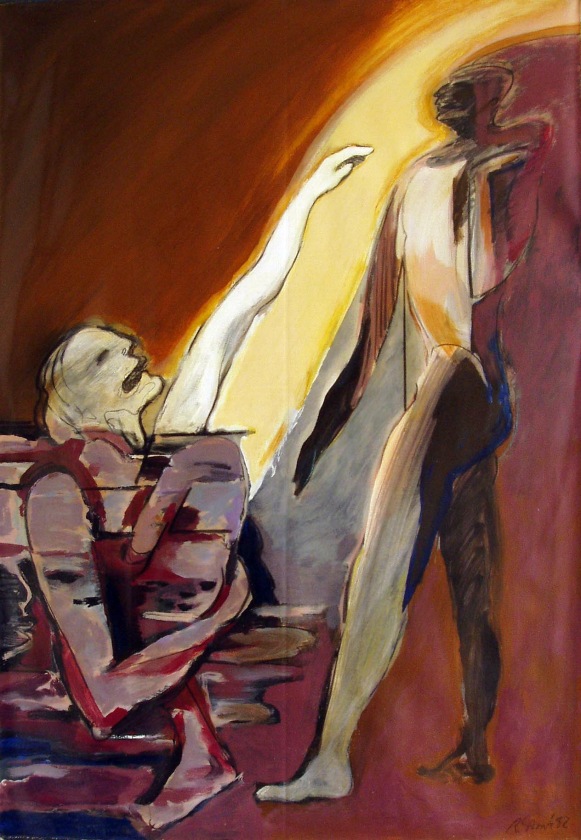
Analogous to such a horror vacuii is trying to imagine our own death. We picture death by imagining ourselves picturing death. This escapes representation..
To be represented there would be no one to imagine it .In his essay on ‘Lucretius and the Poetics of the Void”, the distinguished classical scholar and student of Nietzsche and Philology, James I Porter provides a scintillating analysis of Lucretius’s De Rerum Natura, which offers I believe one of the most suggestive readings of the problem of the topology of imagining death, and the issue of the void. Thus, Sometimes there can be no reconciliation, and in dealing with the sense of the scarred oil field, and the death of a father, and the creation of a mural, and later the saturated memory of plaisance which becomes a net of memory over times of considerable social and financial difficulty. Stout will always return to the oil fields, to the coffin which he viewed in a picture with ‘fierce’ mockery, to the enigma of life coming from non life, or the abolition of such a distinction. His mother will continue to guard him, and direct him, and be a fearful source of attraction, love, repulsion and complex repressions. He will bear responsibility for everything that has happened, and await what Edelson called ‘his severe reward”. He will not be deflected from his epic mission, and he will accept the mortal consequences of what must be endured.
Like the crafty Ulysses, who knows the minds of men and many cities, everything can be foregone, all endured, if one can go home .The craft which he builds for the journey is the work of painting. The goal remains elusive, he comes to each day, looking forward and backward, double and still searching.
However, to understand his feelings about Houston, one should set the comments to Edelson against an article which appeared in the Houston post a little over a decade after his arrival in Houston. The article was entitled 'Houston a Rich, One-Horse Town, Says Artist'.
He is reported as saying that Houston as a place ‘has no class; the city is just a big, rich one-horse town.’ Reading through the disjointed quotes Stout is objecting to art being treated as a commodity, that the scene in Houston is and has been fairly stagnant, and attitudes towards the arts convey indifference if not contempt. The dubbing of the Calder Sculpture in front of the Museum of Fine arts as an ‘ugly crab’ by a local city councilman, or as a ‘hunk of concrete’, or the support for the suggestion that wrestling take place in the Music Hall, are cited in support of his view.
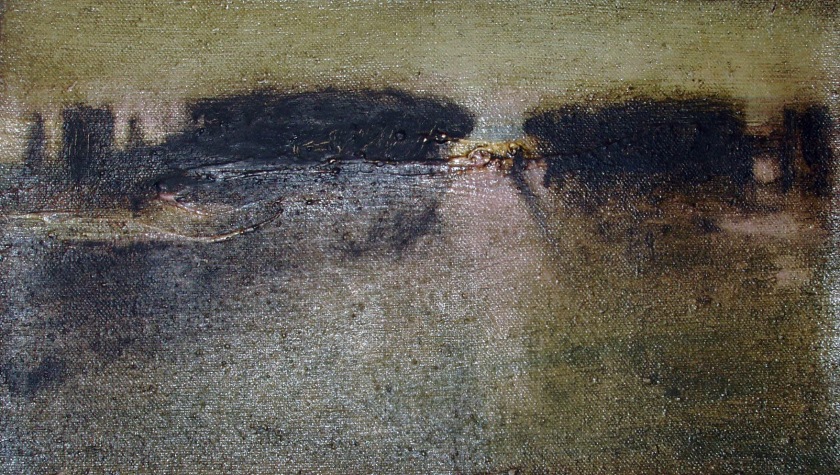
Unlike Dallas or Santa Fe Houston could not afford bringing the Met to perform, due to lack of attendance. Despite having a famous symphony orchestra, more than 30 art galleries, a ballet foundation, opera association, four art museums, and at least five theatrical groups, Stout is reported as questioning whether this is really just a case of fancy facades ‘ to claim that the boisterous country boy is now a smooth city slicker, attempts to cover up not catch up”. Ignorance and apathy are the reasons for the cultural lag.
The following day after the appearance of the article, Stout sent a letter to Sound Off, The Houston Post, Houston Texas: “Dear Sir: Whilst appreciative of being asked, during a telephone conversation with your reporter, about the cultural growth of Houston over the past ten years, I feel no responsibility towards the virulent and editorialized statements attributed to me in the July 1 article. I take particular exception to the third paragraph of the article wherein I am quoted as calling Houston a “ one-horse town”, and feel strongly that these “quotations” unfairly malign both my judgment and that of many dedicated and culturally responsive Houstonians.
Yours truly Richard G. Stout, 1213 Bonnie Brae, Houston, Texas, 77006.” n terms of his work, one of the most immediate effects of his arrival in Houston is that he leaves off with drawing. The main painting of 1956/7 had been the study Gibraltar exploding and Gibraltar at rest. His description of this as a crucial work has been supported by subsequent criticism. It is pivotal in that it signals a new release of energy for the artist.


From the Fall of 1956 we can point a new discovery of material and technique. It relates to a work that was the subject of a lecture in 12 August 1983, and which saw again an immense and fruitful contradiction giving way to what can only be called the overpowering of the emotions and senses, and an experience of the sublime.
The Gibraltar work and the Maldoror work, together point to the large turn made by Stout in this year, and also the deeper sources of his work, in one case the romantic feeling for the sublime, in another, the ‘bizzarie’ of the psychology of Lautréamont”.
The jostle of unlike things was also the shock effect for Stout which he experienced in the city, and the boom-town of Houston had a kind of frenzy and lack of regulation which was felt by him as exhilarating. It is the same jostling and shock that Bergson in a note on a school edition of Lucretius suggests for an atomist account of matter, “there is something of incontestable grandeur in the notion of infinity of atoms falling eternally through an immense emptiness” (quoted Porter, art.cit. p 217, f.61) The problem for Stout remained that of facing himself and also is to facing what is both fascinating and fearful; to actually address what is not capable of being integrated into his understanding. The issue of the void, or the rejection of the nothing which is only that which is beyond all understanding, or the complete privation of matter, the dissolution of body are options he will not countenance James Porter in his reading of Lucretius shows that in a thorough material understanding of the world, ‘death perfectly replicates what is fearful about Chaos; it maps out a deep metaphysical absence, one the mind refuses to picture. And the reverse is true as well: void conjures up the same horror. One of the important 18th century additions to the discussion of the sublime had been to understand that it was a kind of delightful horror, where both horror and voluptas mingled.
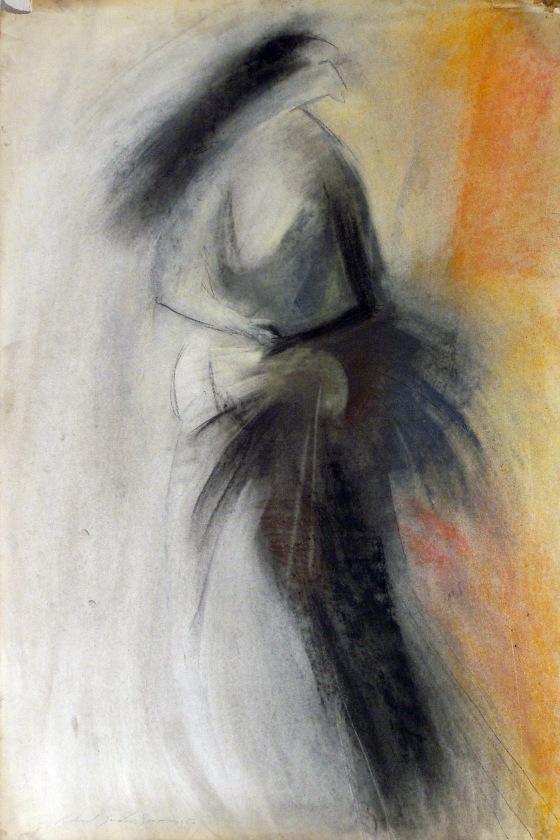
This is given in the text of Berkeley where he sense the satisfaction of the survivor on the shore on see a ship wreck take place by storm. Burke in his Enquiry into the Origin of our Ideas of the Sublime and Beautiful, registered the sublime as having to do with terror, chiefly, and wonder, evoked by size, and darkness, obscurity etc contrasting it against the features of the beautiful.
The focus is book 6 of Lucretius, and there we have the whole amalgam of catastrophic and cataclysmic events which evokes a disturbing insecurity for our being in the world; bodies lapse into emptiness, there are earthquakes, volcanic eruptions, cloud formations, empty spaces and .. Thunder pulls apart. The containing worlds, winds causes cloud formation to split and explode. Clouds thickly massed become suffocating like heavy mountains and valleys, the clouds become prisons for raging beasts.
Thunder and lightning are agents of destruction and death. The hollows in the clouds can be filled with the darkness of Lake Acheron, traditionally said to be bottomless… and be made into ‘shapes of black fear’. This is also possible in the microscopic level. As Burke understood, a scorpion can be as frightening as a raging elephant.

In Book 6 the void functions actively and threatens all stability and points only to vacuity.
There is a menace in the gaps of the earth, where whole mountains cave in, erupts, spew out the entrails of magma and rock.
The deeper the experience of creation, the deeper the fear of the end of the world. The artist like the lover must avail of the idea of the ‘eternal’ what suspends the frailty and mortality of any earthly vow, the fear of the loss of the world, is more profoundly a fear of the abyss.
The scene chosen by Lucretius, point not to the imminent threat of the natural phenomenon, but rather to the fear of a horror vacuii. The material bene fundametum of things can be withdrawn, disappear, and result in utter lack of trust.
Atomism threatens commonplace ontology, Porter suggests, ‘what we think exists is not, or not in the way we believe it to be, whilst what exists is at bottom just as good as naught, at least from the first person perspective. If you have any doubts about it, Lucretius says, just look down at the ground beneath your feet….. The spectacle of earthquakes evokes that of bodies rushing through the unresisting void, ‘Death” mproperly names the fear…. Properly named, the fear is a horror of void.Porter adds that the ethical alternative to fear may well be the sublime.( All of the above from Porter James I. ‘ Lucretius and the Poetics of the Void’, in Le Jardin Romain…, mélanges offerts a Mayotte Bollack, ed. Annick Monet, UL3, Université Charles-de-Gaulle, Lille, 2003, pp.197-227. I have also been much influenced by the meditation of the philosopher Comte-Sponville, in his essay Le Miel et l'Absinte, Hermann, Paris, 2008) Again one must face forward with chronology to try and understand what was seeded in the mid 50’s and again note the ‘push and pull’ in the artists own biography, where material from the past pushes into the future and is pulled from there, a valence we only recognize much later, for example at the beginning of the 80’s .
Mansbach, a colleague at the University of Houston, notes in a lecture of 1983 (typescript with corrections in Stout papers,Houston) that “Richard has been analyzing pictorially and psychologically the isolated figure since the mid-50’s. In fact, the standing figure before us, Maldoror, dates from 1956. What we are encouraged to see here is the artist himself; we are led to recognize the artists’ “self”.
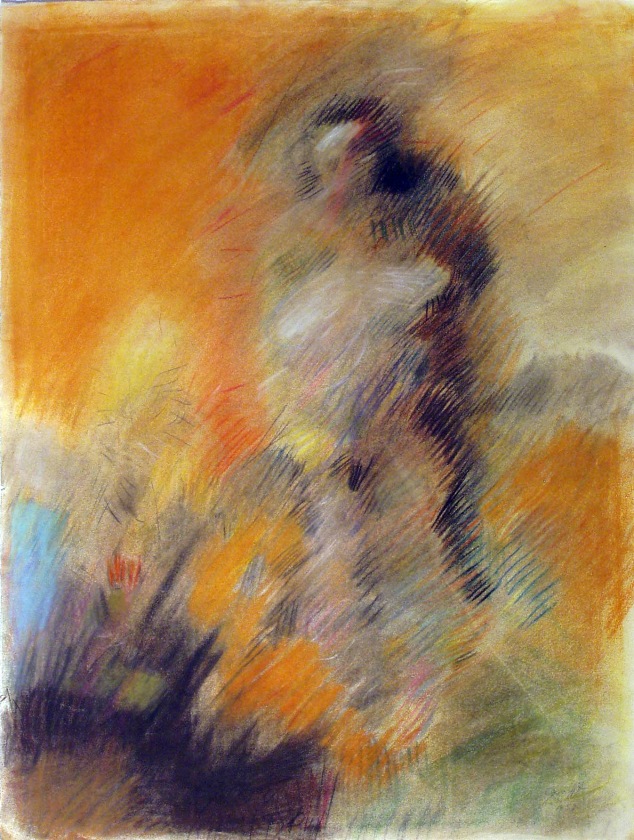
Yet the subject is not merely the artist; it is the artist who is looking outwardly. For Stout this serves as an effective metaphor for artistic creation; and for us it may serve as a restatement of one of the issues we’ve been discussing tonight; the painter as his own subject matter. The inner focus, the strong vertical which is its sign, is elaborated by Stout by a fascinating motif – doubling.
The motif of doubling to which Mansbach refers takes one to the beginning of the 1960’s: doubling in the vertical element. What has happened to the Maldoror image is that it has been turned into a more abstract element. The taming of the vital impulses and the discipline which he imposes on himself remain an ongoing and fruitful tension throughout the oeuvre of Stout.
The ricorso in Stout’s work is also to be seen in the fact that in 1956 he makes two plaster heads, and effectively abandons sculpture for almost fifty years, when he returns again in early 2000 with a series of sculptures. (For these see the essay/catalogue Richard Stout, The Arc of Perception, Houston, 2006, by Ileana Marcoulesco) Within ten years of his first surviving landscape, Stout has chosen for painting, and for solitude.
He has not fully abandoned figuration, nor has he left behind the youthful ambition of re-composing the relation of nature and society in his early .manifesto’.
It will come as no surprise that the subject or motif of Oedipus returns again in the 90’s, and continues a secret echo with the earlier works The artist is alone, whether he figures the image of Maldoror, or Oedipus, the forces with which he engages are not just those of an intellectual finding his expression in an external balance through pictorial means, rather in the struggle with paint, and the identification of the sublime and lonely figures whom he has aligned, there is also a frank acknowledgment of the limits that even the greatest art which wants to be a genuine ‘poesis’ and a real phuysis, nature meets: the facts of material embodiment, the finite which must render without theology, or mythology the meaning of feeling and life for the individual working alone, in a world whose values of consumption lead to a surface without depth, where Stout has always sought and brought into realization a depth which shimmers and gives radiant feeling its surface as a unified picture.

The 60's Levelling out.
Looking at the early 60’s we see that the tumult of the late part of the 50’s has subsided.
The various possible directions which could have been chosen, have settled for the time being into one dominant direction, and this points towards greater abstraction and color field.
Looking at the direction of the paintings one can see a move away from the late 1950’s, the artist has literally cooled down. This is most noticeable in the chromatic of the early years of the decades when cool blues and gray enter his palette, and there is a new fascination for green.
Secondly the works of the period explore a different edge for the paintings, and are more linear and there is a strong interest in the overall design of the surface. The shift in compositional formats leads to a more robust explorations of shapes and geometrical forms, the circle, the triangle and its larger extension the pyramid.
In one sense the artist has moved away from the explosive energy of the large works of the 50’s which are intense psychological documents, and containing monumental figurations, and fascination with eruptive sites of earth, to a much more nuanced and even domesticated series of often virtuosos exercises.
At the same time as he becomes more preoccupied with the relations of good Gestalt and color – there is a movement again to external nature, and the mysterious pictures of the moon can be found in the 60’s and again in the early 70’s.
A good example of the way in which the artist is moving is the homage to Manet, which is a recapitulation of his debt to the ‘modernist’ tradition, which from around 1912 had been historically seen as having its roots in the work of Manet, a fact also acknowledged by Cezanne’s response to the painter. This is worth reflecting on at this point in the essay.
What was at issue in the 1860’s was the choice of the ‘realism’ of Courbet, or the direction of ‘pure painting’ which Manet explored. The notion of pure painting need not be taken to mean anything more than an emphatic adherence to the proposition that only the visible world exists. The concept is not ‘modern’ in the sense that it is tied to the discovery of the 19th c century, such a material stress on the visible is central to the work of the poet Lucretius. What is world for Manet however is how the whole of the visible is captured as a structure and in tonal values, that is to say the status of the object is no longer determining, or the issue of representation as such, it might be said that it is a question of ' making present' which eschews depiction and interpretation.
For Stout the attraction of pure painting remained intense. His painting of the flowers as homage to Manet with their consummate delicate feathery brush work, and gorgeous color arrangement, indicates that he knows where he is coming from, and at the same time shows that he resists the full lure of a pure visuality that would result in color field alone, or, take him in the direction of minimalism.
There are biographical and social factors which kept Stout from fully embracing what was the larger direction in American art at that date. In Houston he was to become associated with a small group of artists who have been termed as the Houston School.
Stout, as seen above, modestly declined to be seen as the leader of such a group, and even cast into doubt the meaning of the word School. There were friendships and a loose social bond of which the most direct for Stout was to be Dick Wray and Michael Tracey.
To this we can also add the names of other Texan artists, who would eventually be presented abroad as the de facto Houston School, and who were distinguished from New York artists and the trends in American art at that date, precisely on the basis of their more ‘symbolic’ commitment.
What is significant for Stout, and remains throughout his whole work, is how one can have a profound expression as a painter, artists, without religious or mythological themes.
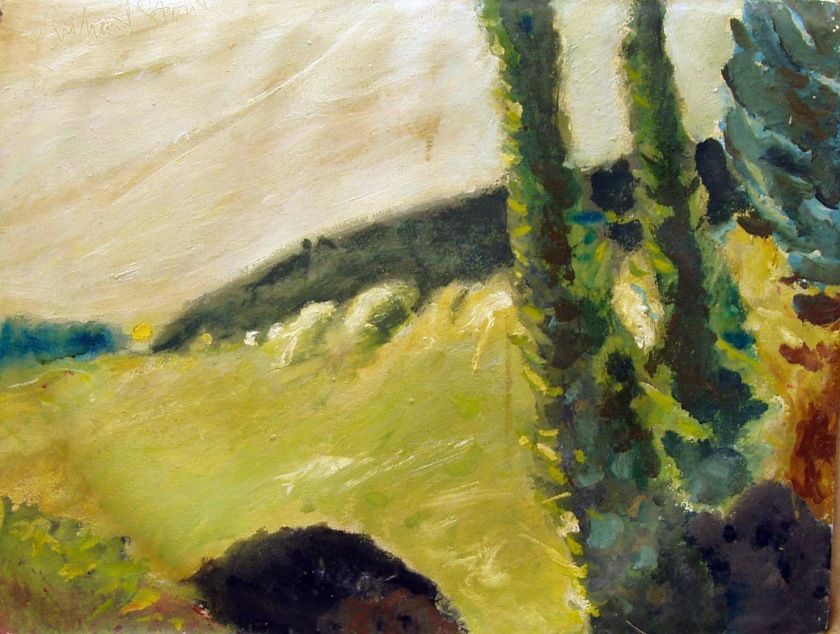
Can the self which has the role of center and is what is expressively constantly externalized find forms and shapes, literally in painting, to communicate what is after all the personal and the murmurings, the hesitations, the movements, bolstering of daily attitude? Within the American scene the dominance of abstract expressionism was almost complete.
Stout had admired the new departures of Rauschenberg, and was aware of the work of Rothko, Still and most of all Arshile Gorky. With his fellow Houstonians and friendships the ‘little band’ in the Burkean sense would soldier on.
It is worth taking a short look at some of these other artists, simply to indicate that whilst emphasizing the very solitary nature of Stout’s own development, it did impact on other artists, was influenced by personal friendships, and would have significant out-reach with Stouts’ later highly visible and active role as a teacher, and even art organizer and administrator. Houston could still inspire during its boom years a sense of frontier and exploration by visual artists, who were determined not to have only New York as the unique possibility of an avant-garde center, or utterly dominating art metropolis.
Part of the freedom in living in Houston was that the artist could explore with less restrictions in terms of official art culture their own person path, without having it taken up by critics and promoted as a signature style, which often left artists unable to explore new directions. The pressure to become a recognizable single theme, single system of signature and style was increasing by the early 60’s, and indeed the movement to such radical abbreviation and public accessibility was a feature of almost all photo-realists and pop artists of the decade.
Looking ahead slightly, one can see from the show organized under the title New Art From A New City, the which ran at the Salzburg Kunstverein from 8 June to the 3 of July 1983, and from the 19th of July and the 5th of August in the same year at Villach, the motif and intentions of the group of artists with whom Stout identified. A note in the German catalogue tells this without any complication. Cynthia J Miller the Cultural Attaché wrote a foreword to the show which made the point to a European audience that whilst New York was the principal city with the largest Kunstszene art scene-in America that this exhibition demonstrated that a rich variety of artists had found other places to work, and the exhibitors -not all Texans – had worked, at least for 10 years-in Houston, and that their work was independent from and independent in its effect and was not isolated from the art movements of either Europe or America.
The cultural aim of the show was to indicate that New York and San Francisco were not the only active place of art, and that in some ways one could say the exhibition was a corrective to the broader way in which American art after the war had been presented, especially in the cultural purview of the Museum Amsterdam under the direction of Sandberg, the legendary curator.
If the stress was on emphasizing that regional traditions could have independent status, it was also a way of showing that the hegemony of Paris and New York and London could be challenged.
The Museum of Fine Arts in Houston had supported this exhibition in Salzburg, and it was Richard Stout who had acted as the co-coordinator. From the 60’s he had begun to have more direct involvement in the official art world of Houston, whilst retaining his own ‘underground’ in the form of friendship circles. The 1983 show gives one an excellent ‘backward glance’ at what had been brewing in the preceding two decades, and really flies the flag for what had been cautiously believed but rarely directly stated claim, that regional art and artists were every bit as significant as the more extravagantly celebrated workers in New York etc.
Professor William A. Camfield of Rice University contributed an extensive preparatory essay and I have drawn on the typescript to elucidate the circle of artists with whom Stout directly links and identifies. This also rescues Stout from being considered an overly esoteric and self-referential artist, and one of the features all these Houstonian have in common ,as will be made clear, is the question indeed of meaning ,which is not about social realism, and their strong attraction to symbolic and personal expression.
The question of Houston Modernism has been studied by Alison de Lima Greene, and what emerges from her article is the significance of strong personalities, and the power of the patronage which is still breath-taking in its ambitions, some 60 years later.
Camfield is a good example of what the art patrons De Menil could accomplish, attracting a rising academic star from Princeton to come and teach at the Catholic University of St.Thomas.
A key figure Jermayne Mac Agy who had come from San Francisco to the CAA in 1955 to be its first director. Mac Agy who was deeply admired by Stout from the time of his first meeting with her, had famously set out to challenge the vision of Modernism in America as laid out in the work of Alfred Barr and the power house of propaganda that was MoMa in New York, which with its resources of scholarship, and its innumerable travelling exhibitions functioned as the missionary centre, the Propaganda Fidei for the story of modernism, modern art and America.
These exhibitions of Mac Agy introduced, in the late fifties and until her death in 64, the first hand experience of modernist work for many local artists as director of the Contemporary Arts Association, her shows were of singular importance in the local scene.
She was also the head of the Art history Department at St. Thomas and ran its gallery.
It is the contention of Alison de Lima Greene that it was Mac Agy who challenged the ‘ Moma canon of Modernism”… ( ‘ Modernism in Houston’, Art Lies, no 41.)Houston it was noted in the catalogue of recent contemporary acquisitions was collecting and ‘collecting fast’.
Among her early break-through show was the exhibition on tribal art, which echoed the fascination with such production as had been to the surrealists. The trends from 1957 show an eclectic mix, with European and American artists being included; some work of Raymond Parker and Hassel Smith, mosaics of Jeanne Reynal, constructions of Joseph Cornell, works of Forest Bess, Morris Graves, Chagall, the Irish painter Louis le Brocquy, gifts from the famous insurance salesman and hobby artist who would later have a one man show,Freed, showing the art crowd with a cartoonists sense of burlesque.It gives some sense of the pressure and energy with which petroleum City undertook to create its modern identity.
A good example of the challenge of which Lima Greene talks about is the show from 1957 – and which must have had an enormous impact on Stout-called the sphere of Mondriaan, where Mondriaan is identified as ‘ one of the essential pillars of nascent abstract art’, and the public is introduced to the work of Malevich, Kandinsky.
But the exhibition which really contended with the defining of the modernist canon, and which gave an enormous power and sweep to the Houston scene was the show entitled the Romantic Agony, named after the famous work of Italian scholar Mario Praz, who studied the demonic/romantic tradition in literature and art.
The show was held in the Contemporary Arts Museum. Among the exhibits were works of Franz Kline, Piranesi, and Matta, Still, Pollock, abstraction and symbolic figuration was where the fundamental forking of the path occurred. he famous bulls’ head of Goya, works of Dubuffet, Soutine and Rouault, the latter three artists were impacting also directly on artists working in Tel Aviv at this date, who were equally contending with the expressionist German and Paris inheritance.
Works of Francis Bacon from 53 and 54 were also shown, and with this Mac Agy had leaped over the tighter, sterner interpretation of Barr’s as identified the deeper roots in Piranesi – and Goya for what can be called the dark side of the enlightenment. This way of reading would also open up the significance of the ‘medieval’ past for the German expressionists, and include the literary topos of romanticism, which first emerges with Burke’s discussion of the ‘sublime’.
Returning to the artist comrades of Stout in this period also throws more specific light on the way in which Houston artists were working. Camfield’s essay is still the most informed map of these complex relations.
Camfield is somewhat vague on the exact dating of when artists, art dealers, collectors and critics in Houston began to think that, as he puts it, for the first time in their lives Houston might be on the verge of becoming a major art center. It was not that he suggested Houston thought of itself as a rival to New York, but rather that it would be a place sufficiently vigorous and distinct to command serious attention.
This really was a direct result of the capitalizing of the city, the heady boom years of the 70’s, although it is really in the late fifties as Lima de Greene shows that the decisive contentions for Houston are taking place:the increase in patronage and collecting through the 60’s, strengthening of institutional ties, the opening of the Menil Collection, movement of Art department of St Thomas’s to Rice, the growth in the number of galleries .
The Museum of Fine arts and the Contemporary Arts Museum were flourishing.
Collectors had expanded in sufficient numbers to support ten significant galleries, and a competitive edge had emerged among corporations in their support of museum exhibitions and purchases for their office buildings. Part of that support was also seen to enter the public domain, with campaigns of bill-board posters of chosen art works being launched and disseminated throughout the State of Texas.
Houston did not only house local artists, two examples of foreigners resident and working in Houston was the Marseilles artist Bernard Brunon, working in a conceptual/minimal direction, and a first generation ‘pop’ artist from London Derek Boshier.
The presentation of the work of Houston to Europe was something of an illusionist feat.
Firstly the request for the show limited it to works on paper, and secondly the specification ‘Houston’ also raised problems, as some artists had not been born there, and other recently moved in. A further complication was a request for visual/intellectual coherence, amounting almost to a thematic demand, which the very individualism of the artists seemed to exclude in principle.
Camfield rejected then the idea of a Houston School, or any dominant movement, and opted instead to emphasis that the best art available to show was very individualistic.
Nevertheless he was able to suggest some common ground in the eleven artists chosen, only five of whom were born and raised in Texas, and only two of them in Houston.
What his judgment holds is that for the most part the common ground is a prevalent ‘concern for meaning and communication’. Houston artists, he contends, have been relatively unreceptive to the main currents of the 60’s and 70’s, such as minimal and conceptual art, op art and color field painting. The concern for meaning and communication did not on his view preclude significant abstract art, but varieties of figurative art were more numerous, and ‘even the abstract artists are concerned with meaning.' Camfield clustered the artists chosen as indicating three or four ‘tendencies.
He puts together the work of James Surls, John Atlas, and Dee Wolff as being figurative work with qualities of naïve, primitivist art.
The second group or cluster was Earl Staley, Gael Stack, Richard Stout and Dick Wray whom he saw as producing work ‘ with an expressionist base whether it is figurative or abstract” He set aside the figures Dorothy Hood and Michael Tracy and treats them separately for their work in collage and their ‘ uniqueness’.
Philip Renteria and Robin Utterback he took as working in vastly different styles of abstract art.
In relation to Stout one cannot exclude the artist Tracy if only because of their close friendship and companionship over long years, and the impact that Stout directly acknowledges from his meeting with Tracy in the latter half of the 1960’s.Earl Staley also crosses any neat division between naïf, figurative primitivist and abstract. He is similar to Stout in sharing a passion for the abstract expressionist style of Arshile Gorky, yet in his work there is often a ferrying between abstraction and primitive figurative styles, derived from tribal and folk art.
In Staley’s case this was also to include Mexican folk art. Staley is also an example of an artist influenced directly by Dubuffet from the exhibitions of the Mac Agy . The reaching out to mythological sources and the influence of Mexican landscape, and shamanistic magic practice, fuelled by his reading of Jung and Joseph Campbell, The
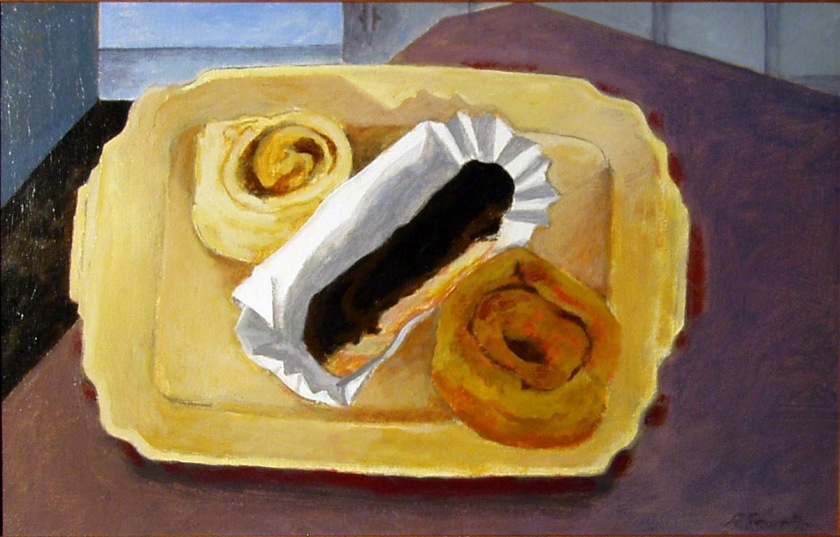
Mask of the Gods, opened his work in directions of surreal delirium, and grotesque eroticism, yet there is also an intense romantic love of nature, and after two decades of work a movement towards Greek mythology, which had been significantly re-read because of the publication and teaching at Berkeley of Dodd’s, whose book The Greeks and the Irrational, made for the death throes of all interpretations of the classical that flowed from Winckleman’s compelling reading, which had only been first seriously challenged by Nietzsche, and finally laid to rest by Dodds work. Even to this day the impact of Dodds on a scholar such as Walter Burkert can be seen, with his emphasis on the significance of shamanism for the early traditions of Greek philosophy and religion.
One can draw parallels with the interest of Stout, although the sources and directions of the artists work are very different. Part of the strength of Stout’s work is that he controls the terrible fascination of the magico-religious through the development of technical and other resources and holds contrasting tensions, the Apollonian and the Dionysian in balance, this is rarely sundered, and when it is usually results in figurative work of a Swiftean disgust and menace. This was actually nowhere more evident than the works he submitted for the New Art New City show.
Again the links with Gael Stack for Stout are relatively obvious. She too has her roots in Abstract Expressionism. Camfield then makes again his major single point that she asserts her individual direction by her concern with ‘meaning’.
This is indicated by the inclusion in all her works of small images, inscriptions, symbols and even titles themselves.
There the comparison with Stout is negative, as he almost never includes inscriptions, apart from his own signature on the picture surface. Stout completely avoids for many of his work even titles, and in inventory books kept in his archive pictures are often simple referred to by the dominant palette used.
Stack also has a much more complex relationship to the surface, not only loading it with iconological referents, but often applying multiple layers of paint and bruising in and out images and including the scratch process of here own process, leaving a richly worked surface which contains the traces of earlier stages-this led to critics comparing her work with Cy Twombly.
In one case noted by Camfield a work of Stack For Juel dealing with the burial of her mother, was a work which contained numerous forms competing for attention, and the painting is one of turbulence: there is a prominent patch of white paint towards the upper right, gouges in the surface, slashing marks in black, white orange and green pigments, and suggestions of symbols. There is even letters from an unfamiliar alphabet, probably short hand notations-and the marks are said to be operative at the formal and symbolical levels. The large white form is associated according to the artist with her mother’s soul, the vertical and horizontal marks at the lower left refer to the graveyard fence, however, such private and precise references would hardly be available, Camfield notes, if the artist did not supply the commentary. But, the harsh turbulent world of the work is effectively conveyed by form alone, and Camfield concurs with this opinion of the artist.
Although including Stack in the cluster with Stout, Camfield is at pains to contrast them when he comes to deal with Stout directly.
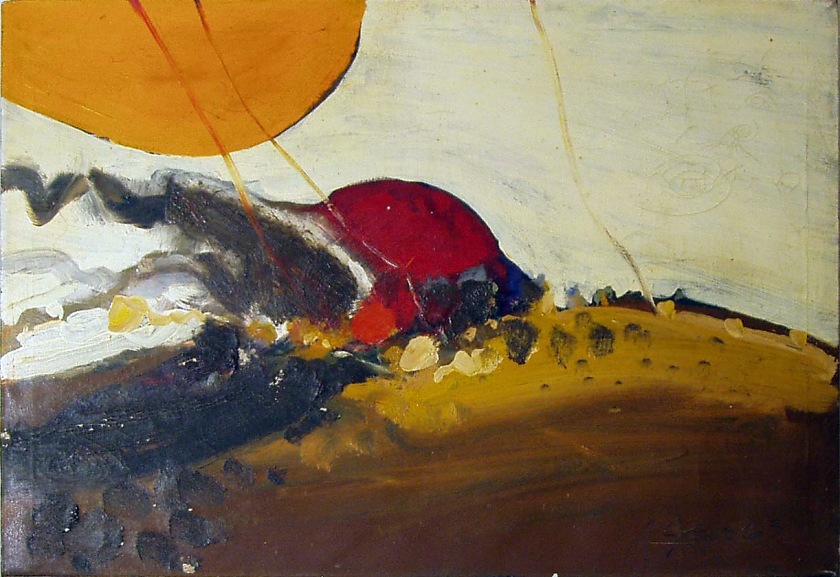
Stout is one of the artists, who have lived all his life in or near Houston, save for student years in the mid-west, and for travels in Europe, especially Germany.
Stout he argues shares the abstract expressionist to which he has remained faithful, with Stack, but that his concern for meaning is conveyed by the expressive manipulation of such formal properties as color, light, line, space, form and texture. Stout’s themes are less preoccupied with the self, and his paintings are more thoroughly abstract.
Dick Wray, also a fellow Houstonian, had like Stout in the 60’s developed a new personal style within the tradition of abstract expressionism, instead of responding to the efflorescence of new styles in New York: Pop, Op, Minimal, Conceptual, Color Field and New realism.
Dick Wray had been an architecture student at the University of Houston, but remained undecided between architecture and art. In 1958 he traveled to Europe, primarily to Germany where he worked in some architectural offices, and at the Künstakadmie in Düsseldorf, where the architect Herrich was teaching, but sometime before the arrival of Joseph Beuys.
The European work he found interesting was the COBRA group, and the work of Tapiès.
When he returned to Houston, he became interested in what one could call the second generation abstract expressionists in America, namely Johns and Rauschenberg.
It is almost impossible however to chart the closeness of Wray and Stout, as much of the possessions of Wray including a large part of his own personal artistic production was destroyed by fire in 1980. Nevertheless the commonality of their interest and concerns seems obvious enough.
What is clearly different between Stout and Wray is their approach and working method.
Wray constantly allowed in his work a struggle between architectural order and the non-tectonic, the de-form of his own day to day world. He also celebrated chance, and invented joking emblematic figures in his work, a feature he shares with Earl Staley.
Where works survive one sees the overlap with the approach of Stout and their closeness in this decade, especially in the palette of the warmer canvases which are loaded with generous orange and pinks suffused with radiant yellows and pushing towards the hottest sun-set red. Wray clearly from his architectural training was prepared to jostle an wrestle the field of control in the painting, and turn it into a brusque playground of energetic collisions; thus he’d set against vigorously scrawled planes, and as Camfield says, abstract forms in contrast to illusionistic images: lines lying sometimes on the surface suggest overlapping walls or planes, delights in the manipulation of contrasts, there are geometrical shapes pitted against free flowing lines, unmarked planes However there is one drawing in the exhibition of 81 which points to the deeper affinity of the two men, and again it is noted by Camfield, it is a drawing which is thoroughly abstract and the geometric shapes of a Malevich composition ‘ containing the strong color tensions of Hans Hofmann .” he very beginning of the 60’s saw Stout move to landscape. Perhaps we can track it directly in the work whose title announces his Going down to the Sea.
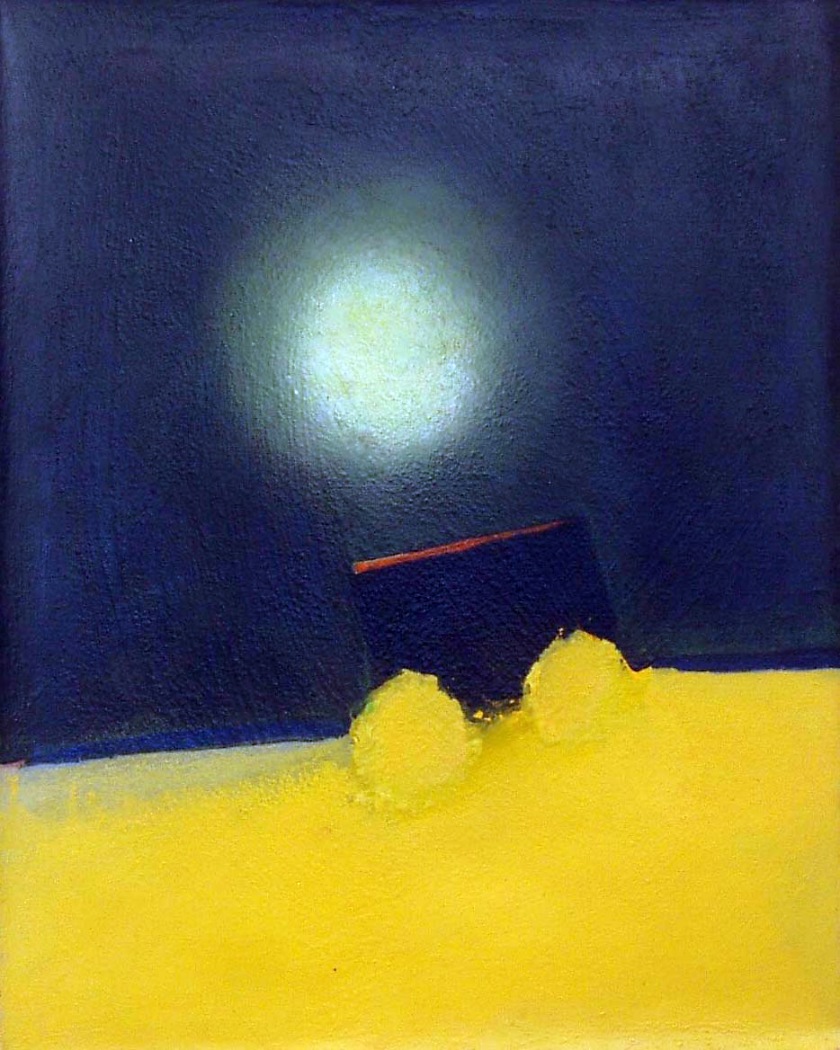
This seascape will become of increasing significance in his work, as will the closer relation to the interiors of his home, which he had just purchased a year later.
In the 90’s to the beginning of the first decade of the 21stcentury we will see how this eventuates in the most compelling scenes of grandeur and sublimity in the entire work of the artist.
The return to the sea also took the artist to another palette. Not only the obvious blue and gray, and the white of the wave breaks, but also from observation of the evening descending on the shore, the dark indigo towards violet that can be seen on the shadowing surface, and even the heavy black-red towards sun set. One work landscape with white sky achieved immediate distinction, being purchased by Hallmark Card Inc. and being displayed in the Wildenstein Gallery. The work was acquired for the 5th International Hallmark Art Award at the cost of $250. At the same time as he was awarded this honor the collector Jerome Tannenbaum wrote to Stout in May of 1960 offering help with the purchase of his works, and adding in a letter ‘ I know several others, however who appreciate modern canvasses and may be able to arrange something for you”. One of the closest surviving accounts which give some indication of his working practice at this time can be found in the details of an interview granted to the Houston Post and published in their issue of May 19th, 1963, where Stout is reported as having stated “I work in series of sensation rather than in series of subject matter or style. Therefore my paintings may vary a good deal as to subject or recognizable style. I am most interested in achieving a plus quality in my work by painting beyond the eye and past the mind. I believe that a painting must have a personal element of magic. Among my current favorite painters are Hopper, Bonnard, and Ryder”.
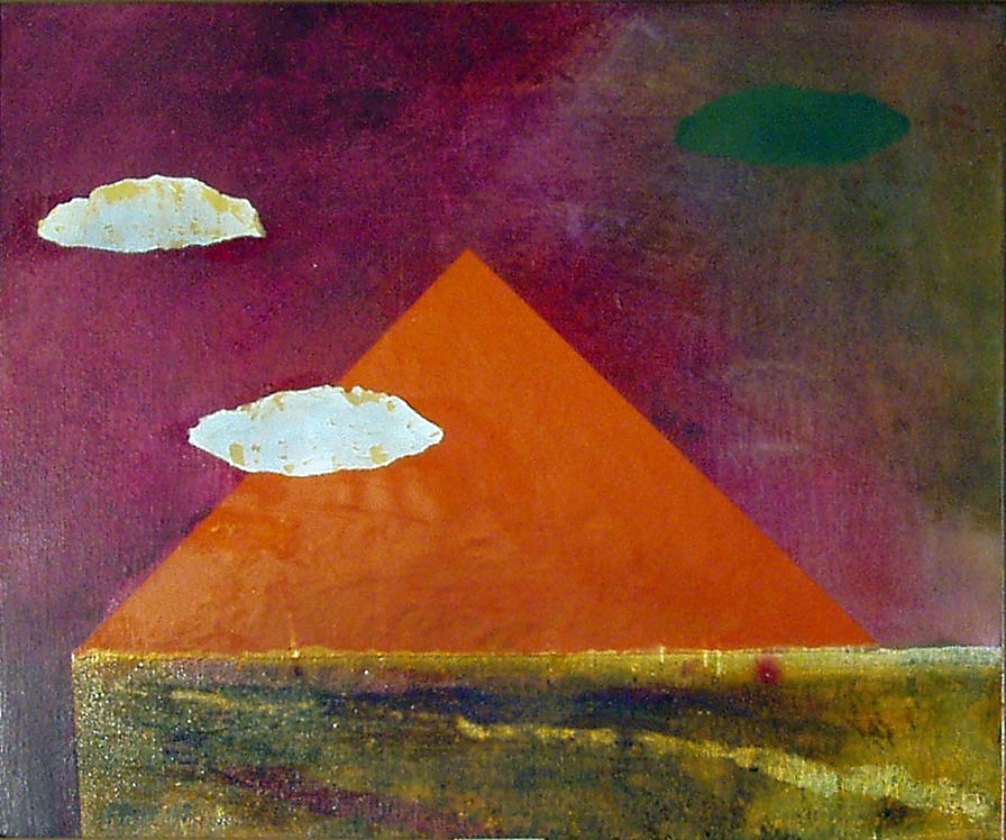
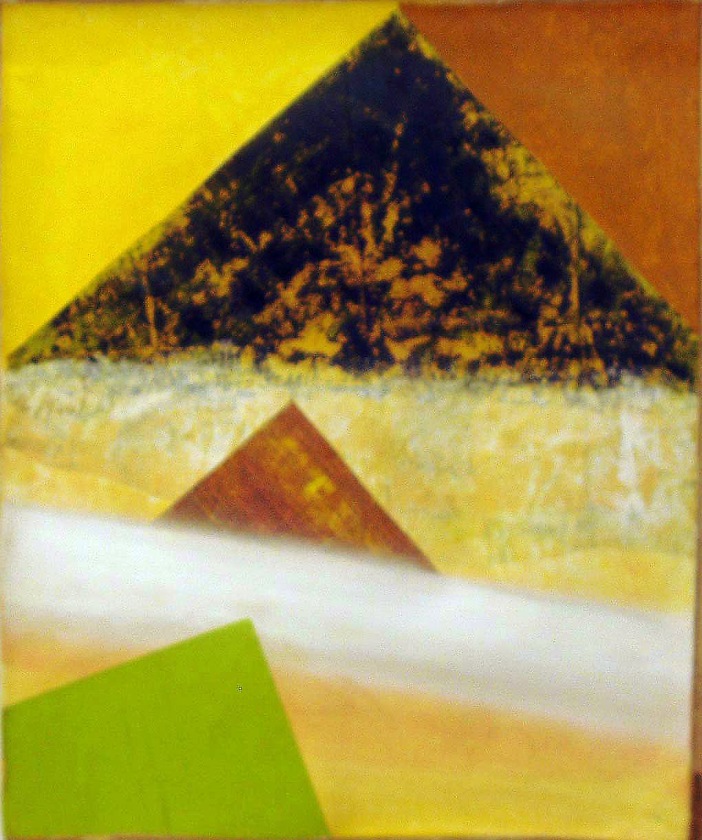
The variation in style and subject matter was a new experiment which he was allowing himself, advising his collectors not to expect a fixed and settled Stout manner, and it wasa means of keeping himself busy with his studies.
What the lack of a fully organized art scene gave to the artist of Houston was the ability to avoid collapsing their entire artistic quest into sale-for-signature pictures.
From a range of paintings in the early 60’s one sees that Stout has returned outward again to nature.
Nevertheless the paintings are almost all made in his studio, and some of the ideas are sketched al fresco, but like the great tradition of landscape the artist returns to his facture under stricter conditions of light and atmosphere. The expansion of his work can be seen in his new delight in broad areas of monochrome, and often much simpler juxtapositions of color and shape than in the work of the 50’s.
There is also a search for stability and anchoring of forms, by inventive compositional changes, and ultimately the line will come to have a harder and determining edge in the work. By the end of the decade the naturalistic referent has been abandoned and his constructivist work which his more and more geometrical and architectural, inclines towards very rigid organization of planes, and the expression of broader treatment, flatter areas of color for their own sake.
It would be tempting to think of these having symbolic weight. What seems at play is that the very intricate streaks of color and their tense push and pull in works like Gibraltar have now been smoothed out, and the chromatic ability of color to sing against the other modulation of his palette is explored in a less conflicted way.
The color becomes expressive for itself. Part of the change can be seen in the introduction of ranges of color which are picked for their qualities of warmth and cold, and are not set against each other as oppositional element, rather they are composed through spaces of generous extent and allowed to vibrate and give the surface of the picture greater optical luminosity, the use of tonal values between colors and the balancing out of these relations becomes more and more the aim of the period in question and one can see that part of the inner polarity of the artist is the movement through elemental source, the sea, the sun, the moon, the earth and finding equivalences and correspondences for his visual experience which is then relayed by modulation of interval and broad chromatic harmony against sometimes jagged compositional elements.
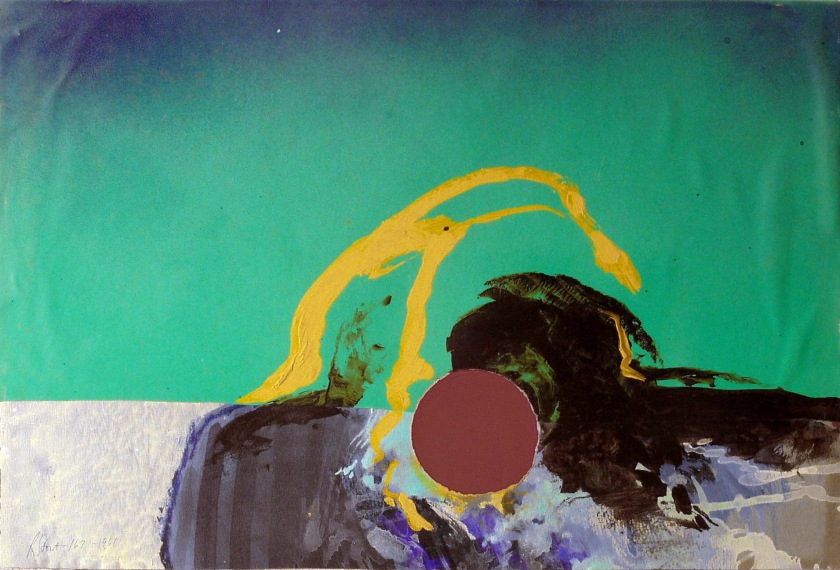
One suspects that he is alive to the analogy that all composition is about transition, movement of passages from one to another, the intensity and pitch of color becoming the basis for his harmonic realizations. It is of course no accident that the composer he most admires at this period is Webern, and also he finds excitement in the work of Busoni.
Another key source for the changes in his world, expressed as color, and dominantly color, is the trips made to Mexico, a passion he shares and discovers with almost all the Texan artists with whom he is in contact, and which became over the years a landscape and refuge, often allowing him re-generate his creative forces in the dryer and less humid heat of Oaxaca.
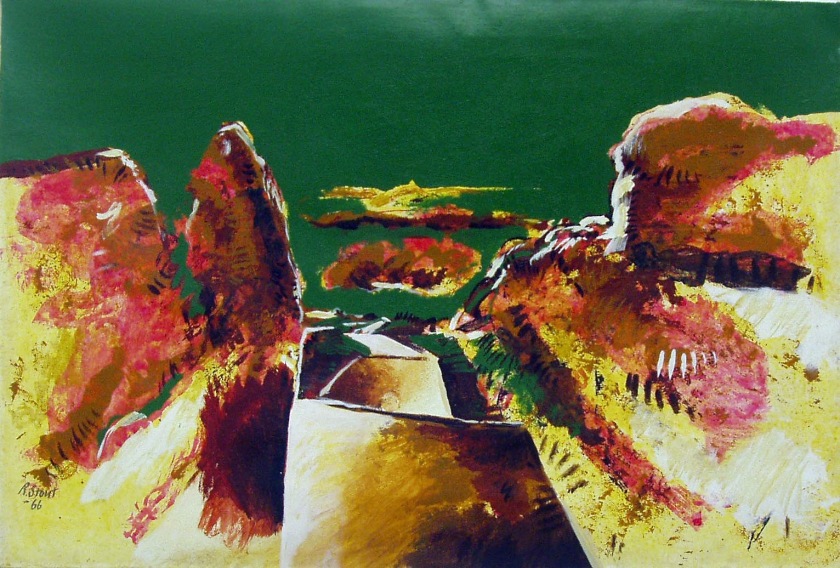
Behind all of this lay also a more fundamental inheritance of the modern, the loss of the object.
Kandinsky’s reports his overwhelming sense of that loss of the object for the picture when in Moscow he had seen Monet, .For painting the loss of the object and the relation of color and composition became one of the deepest challenges for art. As discussed earlier the fear of the non-representation for the deepest subjectivity was that of one’s own dying. There was something fundamental that could never be shown, or directly figured. Delaunay had announced in ringing terms the problem for artists no longer concerned with mimesis, or providing a ‘window’ through which to view the world.
He also saw that turning to formalist concerns alone did not answer the problem of the object-less work by some kind of substitution of concern.
What was required for art was to approach the limit of our harmonic vision, of clarity itself.
Clarity is color and proportion, and these proportions were made up of various simultaneous measures ‘in an action’. The achievement of the painter was to capture the synchromatic movement, the simultaneous visibility of light as color, and its various intensities, and this would be the representation of harmony, and not the harmony of representation.
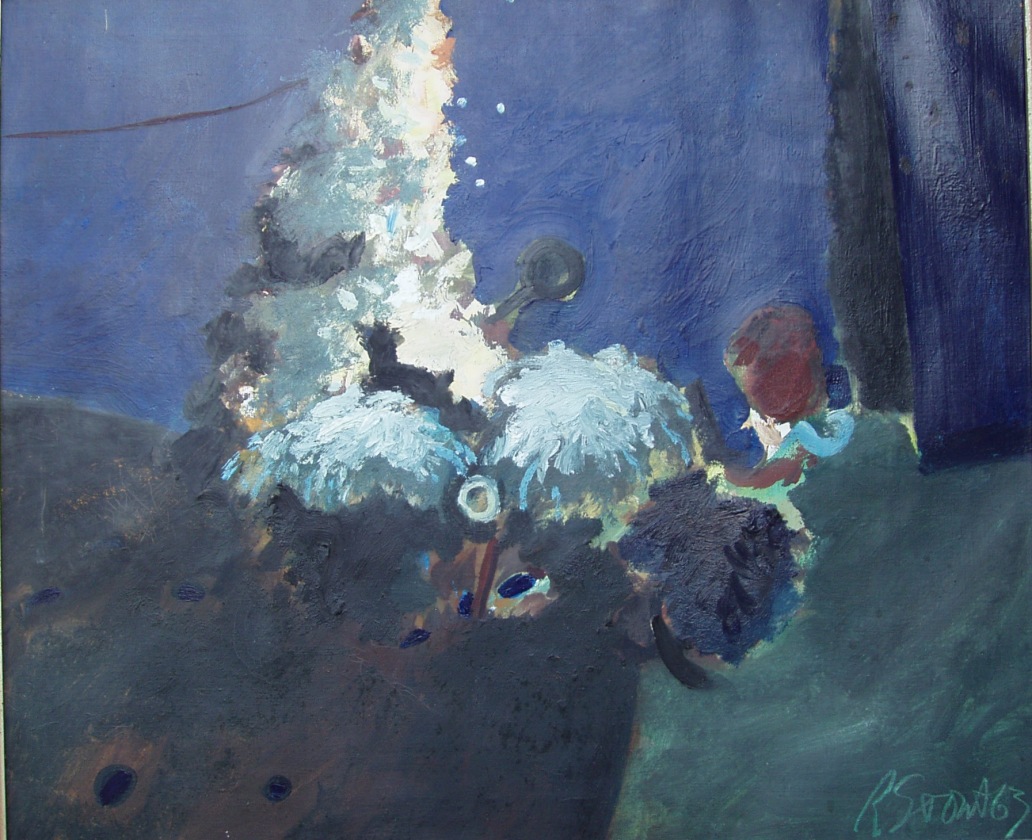
Paul Klee would take this text of Delaunay from 1912 and translate action synchromique as ‘ synchronische Aktion’, the translation capturing the inner sense of simultaneity which was important to Delaunay, but misunderstanding the way in which the focus is ‘color’ and not movement in time, in other words Delaunay is talking about a rhythm which is immediate in its thickness and density, is not some abstract line of duration, it is spatial and occurs in a place of appearance as color, which is simultaneous not on account of temporal succession but on the basis of contrast.
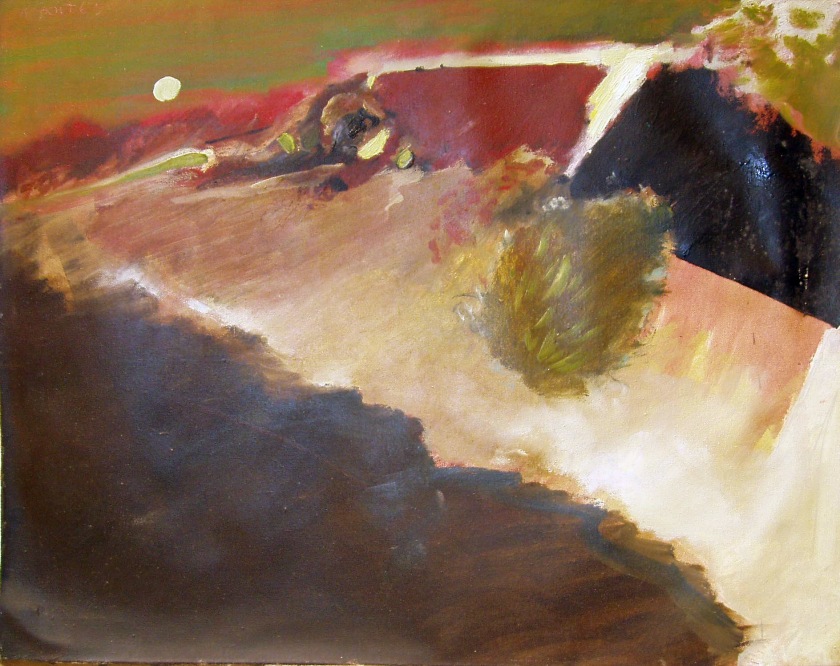
Delaunay had proposed a theory of la peinture abstraite vivante which was influenced by analytic cubism, but which was attempting to see how a successive temporal interpretation could be objectless when considered as synchromatic.
This is a complex problem in theory itself, in other words what way the value of color and construction belong, and if indeed without color one could talk of any visibility at all.
Delaunay wants the dramatic contrast of simultaneous contrast in colors, attaching a slow movement to complementary colors, and a rapid quality to dissonant colors.
One can imagine the speed at which an orange would vibrate on the canvas, and the different speed of vibration if a purplish-blue is placed nearby; the purplish-blue will not only vibrate at a different speed, it will also release yellow from the neighboring orange, and all the other colors in range will vibrate and resonate according to dominant chords and measurable intervals.
Both static and dynamic elements can be captured and felt by the eye, which then feels the vital energy of the world. Color does not have to move to a first order symbolic system to have meaning. It is expression directly, and is given to the mind and shaped by the mind in immediate and simultaneous apprehension.
As Max Imhdahl wrote of Delaunay, the painter in this view has one task and that is to manipulate optical provocation, not as some kind of aesthetic play, nor to allow as it were colors to be seen as such. rather it is the message which results from the painter’s knowledge.
In color the message and the medium become one.
Even when it is well accepted and understood that the relation of the world of painting and objects do not necessarily overlap: there is still a fear associated with pictures, or even images that only appear like a mirage, if they do not describe the so called perceived dimensional world. A rugged skepticism finds itself suspicious of ‘abstraction’, and whilst allowing for the translation of sensation, always wants to prioritize the source of the sensation as a realist and describable one, it will not allow for ‘just sensation’, and refuses the intricate intertwining of feeling and world always attempting to stress either one or the other.
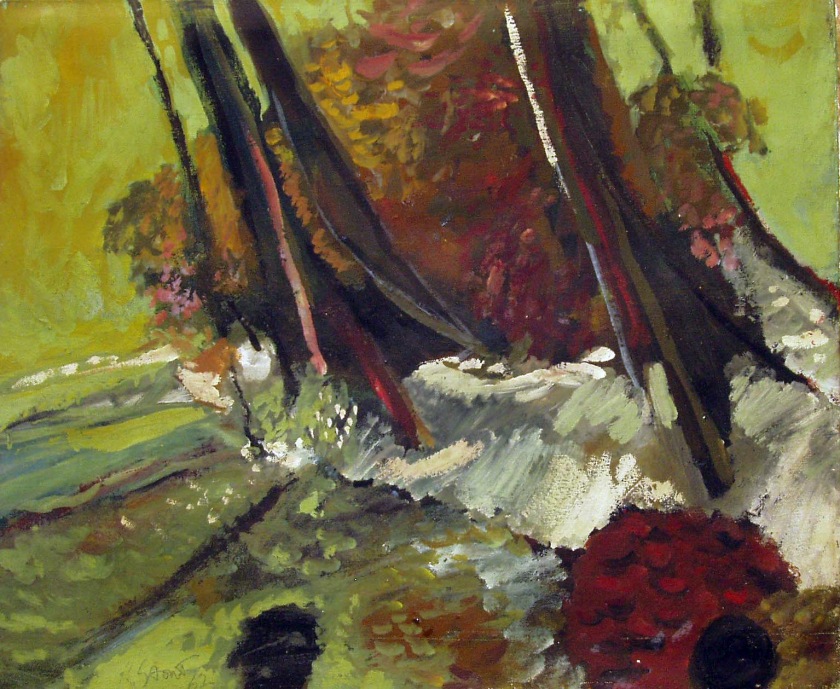
The overview of discussions in artistic and theoretical circles on color studied by Max Imdahl in his book-length work Farbe, Wilhelm Fink Verlag, Munich, 1987, remains an excellent account of the various debates and positions on ‘object-less’ painting.
Imdahl starts by considering Kandinsky and considers a text which Kandinsky wrote when he, the artist, was in his late 40’s, where he freely reminisced about his development as a painter. Referring to his childhood in Moscow he recalls his, 1965. awareness of the sun setting over the city, and identifies it with an orchestral finale in which the resolution of the symphony sounds in intense living colors. Each color was like an individual song. His memories of childhood travel in Italy is also transmitted through color, although in Venice it is the dark shadows of the water which he recalls, not the high pitch of the open sky which gives so much atmosphere to the city, not the pink, blue and yellows so beloved of Tiepolo.
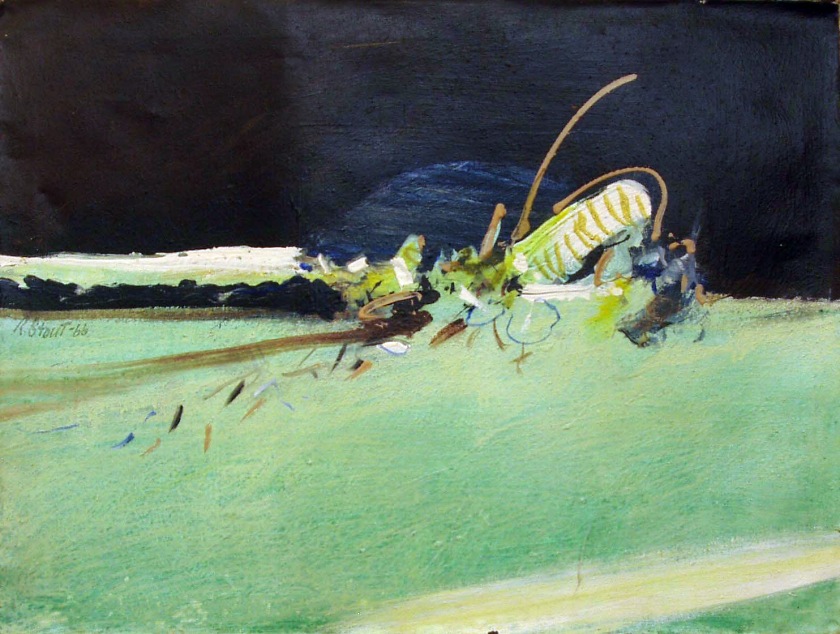
Kandinsky recounts his encounter with the Haystack painting of Claude Monet, and how it was this work which convinced him that painting could be an image This was a prelude to another discovery, a discovery connected to music; he had heard Lohengrin by Wagner, and the performance called up to his mind’s eye the forces and colors of the setting sun over Moscow.
This kind of synaesthesia had become common at this date, and Scriabin the composer would, for example, identify colors with different musical keys, and at the same time painters were happy to talk about chromatic scales and tones, and musicians about the richness of the orchestral palette; in short a domain of freely mixed metaphor.
Kandinsky felt the gap between what he could feel and what in fact he could achieve in painting. His own colors did not match the trumpet sounds he found in Rembrandt, nor the polychromatic intensities and fusions he found in Wagner’s sound world. Part of the problem for the painter was that the transitions of which Wagner was a master in terms of composition, allowed him create a dense mingling and fusing of tonality and texture, which could not be so easily achieved in painting. The very material realization of painting, the medium, the different use of pigments or chemical and synthetic colors, the reactions of priming agents, the effects of light on areas of thinning on the canvas, ongoing chemical reactions, added immensely to the difficulty of creating a planned area of transition in the composition, of arranging with clarity the pay of shape and color free of physical incident.
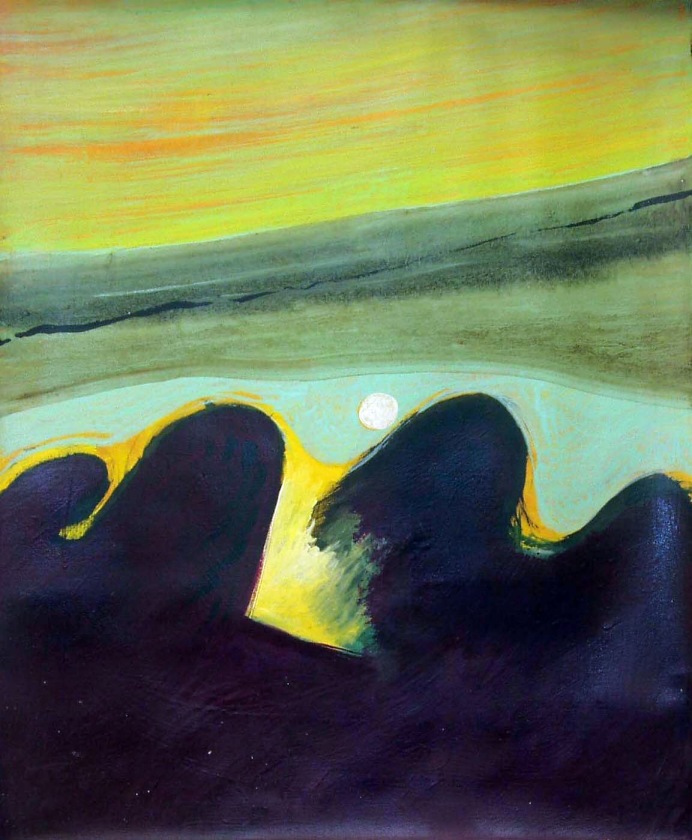
Kandinsky received a very encouraging impulse in his work from the peasant art he saw in Wologda, and this attuned him to the overwhelming physical reality of color.
This was the experience that taught him, as he put it, ‘to live in the picture’, a conception as we have seen which had deep implications for Rothko, Motherwell, Still etc.
Kandinsky gained a richer sense of the reality of his own paint box and that the strong feeling he had for different colors were ‘a world in the making’. At the same time he felt the distance of the colors of nature, and his experience of making, painfully aware that the rankest amateur can have the most exquisite of visual experience, and the amateur savoir the information of the art historian, without the smallest creative demand.
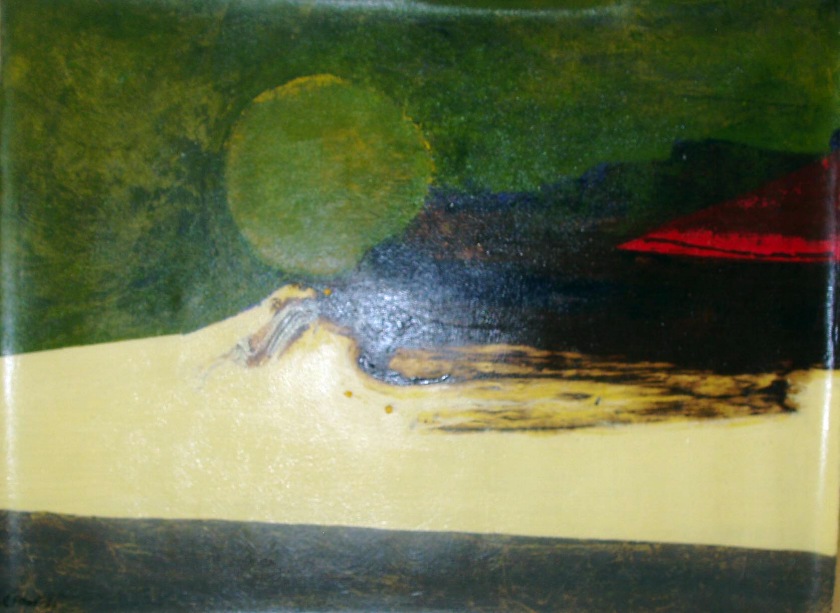
Kandinsky saw clearly what he could create from experience and what he could see in nature, remained at odds. The man-made order and the natural order could not be reconciled, however they could vibrate together, and the artist could work as a medium for such harmonic sounding. It was a search then for creating an equivalence in feeling and material realization; a search for form out of the singular reality of the inner elements of feeling.
Imdahl establishes that by 1912 Kandinsky had developed his chromatic theory, seeing yellow, for example, as an earthly color that could not have deep meaning, an intermixture with blue, he thought, rendering it sickly. Vermillion was for him a red with a feeling of sharpness. Orange is like a man convinced of his own powers. Violet is sad and ailing.. What this points up is the very subjective nature of what Kandinsky was advocating for theory of color, none of this deriving either from Newtonian physical theories of optics, rather it was more inclined the then current impact of Goethe on Theosophical speculation such as found in the work of Rudolf Steiner, and applied directly by him in the construction of Dornach. Kandinsky makes the struggle an individual quest.
It was this which Bridget Reiley the 60’s op artist found so exciting, that there was no conceptual basis, no guiding principle on which a tradition of color could be reliably founded.
This meant for her that each individual artistic sensibility had a chance to discover a unique means of expression.
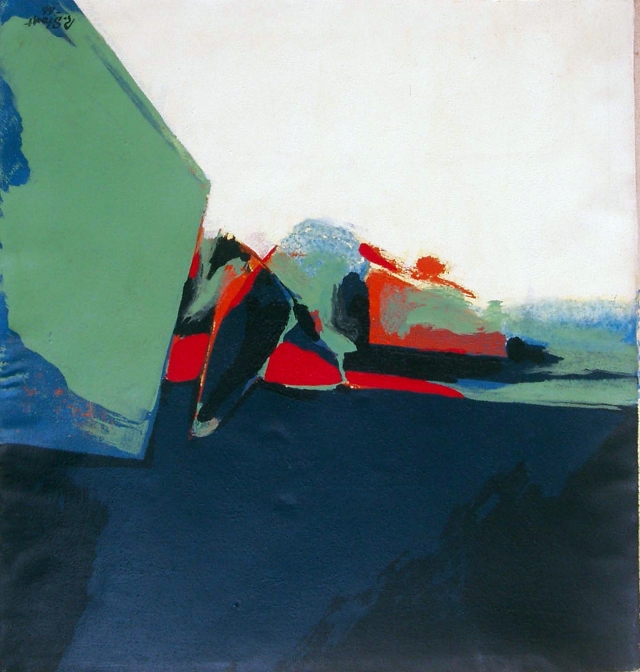
Kandinsky however believed that thee was another possibility to ‘replace’ the missing object.
He thought it was possible to orchestrate the impact of colors and shape, and that this composition could create response and emotion such as one has in music.
Kandinsky believes further in an essential dynamic life between colors. This is directly dependent on Goethe, who viewed the ‘color circle’ as founded on the proposition that color is born out of the play of light and darkness.
Yellow and blue are taken by Goethe to point to this underlying fact. They, yellow and blue, were the elementary colors, and essentially opposite the pure experience of one exclude the experience of the others; but, they have a tension, or a tendency towards each other, and whilst being separate, pure, even opposite, they are inclined to mingle.
For Goethe the tendency to think of black and white as the fundamental opposites, to think of darkness and light as being opposed is a drama that is senses as being played out in matter itself. However even in the mix of gray in this play there is something lifeless, and that the simplest colors arouse a vital impression compared to this ghostly zone:
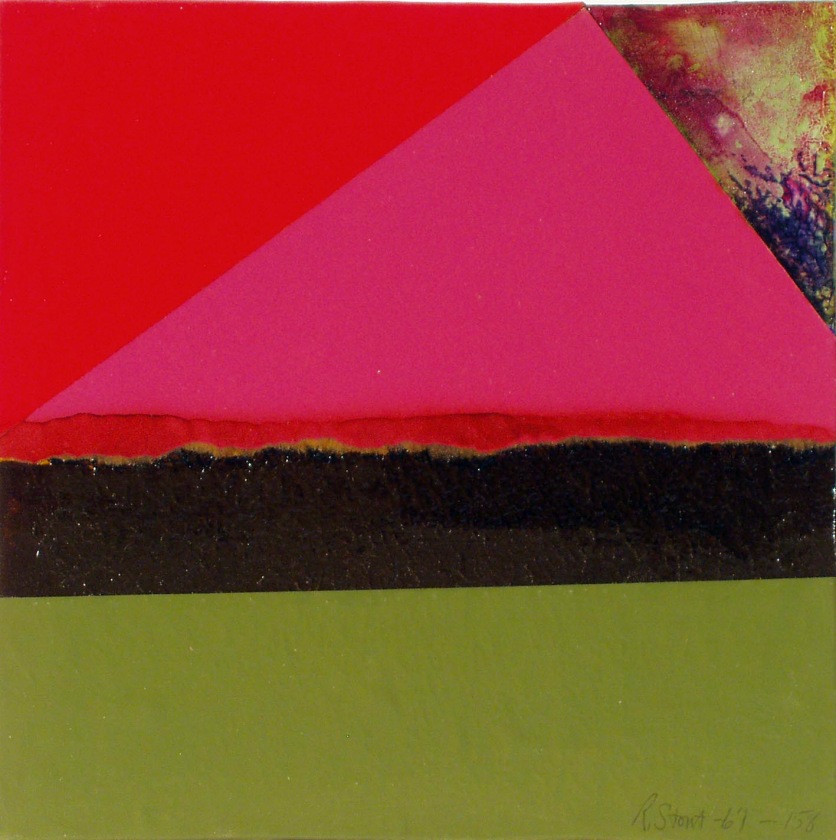
Schwartz und Weiss eine Totenschau Vermischt ein niederträchtig Grau (Black and white, a death parade Mix to make a common grey).
The production of color, even in the Grey Zone, is still the result of the process of mingling.
The opposition in yellow and blue is of another polar tension to what exists in the Grey Zone, which shows rigidity, immutability and deathliness.
With yellow and blue their opposition is not contradictory, they are an inclination towards each other, and thus are living. The stimulating energy with which color affects the eye, is not to be confused with the brightness with which white affects it, Goethe gives the example of an orange color surface set against a white one, and makes the claim that this will produce more effect on the eye, not merely because it is brighter, but it has more stimulating energy.
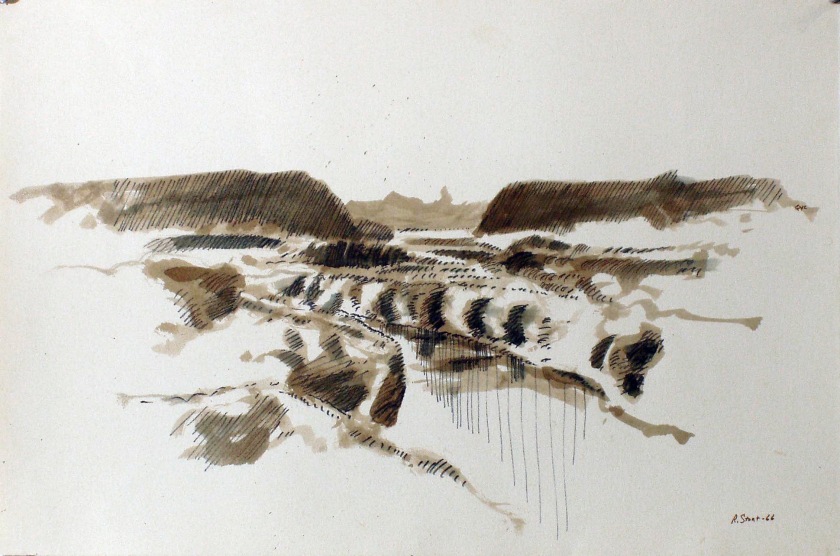
In this theory color literally comes alive. Color takes on and bridges the polarities of light and dark, of black and white, of grey and chiaroscuro. The light is alive, and in material resonance it creates amplitudes and singular intensities which are not simply the sum of what is thought to be the physical constituent of matter. The work in hand for the painter is a bridging phenomenon, as it was in the first instance, when the bridging was how to understand the dilemma of the disjunction art/nature.
Henrich Proskauer in his The Rediscovery of Color, makes the point that for Goethe the color circle was the harmonious whole, achieved when color , which was one-sided, found its enhancement in another color, and thereby achieved a harmonious whole.
It is not the case that this consists of colors ‘making up white’. Black and white is rigidly opposed, by virtue of how we become aware of them in material realization.
Single colors emerge in the dynamic interweaving of the polarities of light and darkness, in the words of Goethe they are ‘deeds of light, deeds of suffering’. The intensification of the stimulating energy in the release of colour comes through the creation of a reconciliation of polarities at a higher level; out of the fully developed dynamic of the complete state. Light on this account grants visibility.
Where one can detect that Kandinsky and Mondriaan are wedded to the relation of shape and color, the effort to find sympathetic equivalences in the material world for the ‘spiritual’, the different emphasis in Hofmann’s teaching, however much influenced by the expressionist theorising outlined in this treatment, rather emphasises the vision of the artist and the subjective wilfulness of art, which for Hofmann is not on the final account about mental effort, but rather about empathy.
As Hofmann insisted, abstract work must express as much meaning as realistic work.
It also must express something that the artist has experienced in nature. Thus, it is not enough for the abstract artists to provide a satisfying arrangement, he or she, must, to what is essential and present to one’s vision: ‘ We are not abstract out of a desire to be abstract, but to express our experience, and to express the greatest with the simplest means” hus space is handled in quantities of light and shade, which has almost nothing to do with the object, and if there is an object it functions in relation to these quantities.
One has to use texture, as a light making medium, a color without texture cannot give you what you want, and so Hofman enjoins: ‘ you have to go deeper and deeper.” raque’s painting, for example, is mostly conditioned in a light-making effort, and Hoffmann adds, anyway, every painting must express a mood, and the mood is a pure sensory affair. ‘Pure color is not what comes from a tube. Evenness when you finally create in painting is sureness. Pure color means you mix it and bring it to one meaning”.
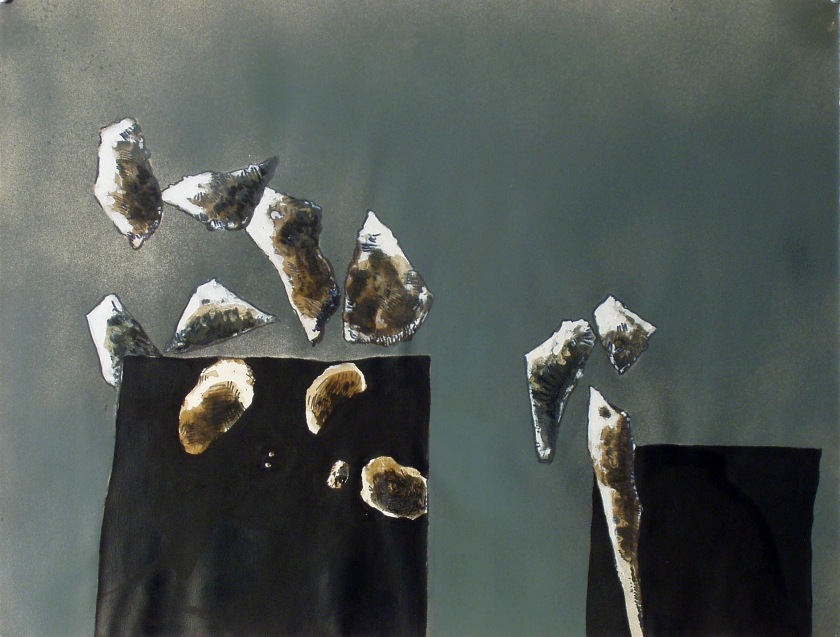
For some artists that meaning, which Camfield sees as so distinguishing for the Texan artists he surveys, and in which he includes Stout, is often surely just the process and the painting, the mind that chooses, the singular work that eventuates as material realisation.
There is no appeal to a divine or transcendental quality, such as ‘the spiritual’ in Kandinsky, and later Rothko, just ‘things’ and manipulation, matter and appearance, that arouses in the viewer pleasure or displeasure, the source of the aesthetic judgment, and which ultimately is the basis for how one judges the quality of the work.
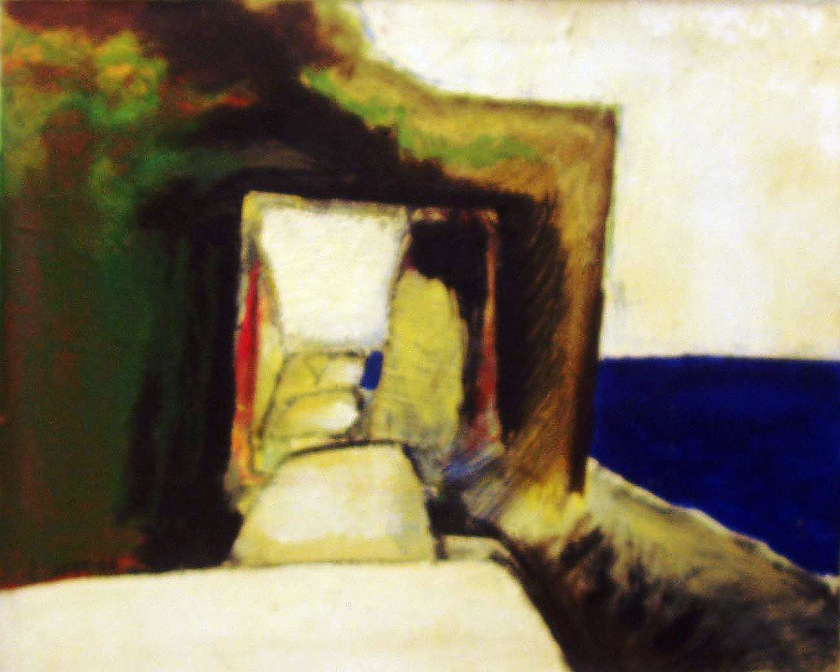
It is difficult to assess the new simplicity and reduction in the work of Stout at this period without positing the experience of primary phenomenon which Stout had in traveling in Mexico. One could say that his awakening to color again was no longer mediated by the availability of professional artist’s colors in tubes, or the theories which had such a dominant effect in school days, yet on the other hand one cannot claim that the artist was in possession suddenly of Ruskin’s innocent eye.
Rather he had through the experience of Mexico and moving through mountains opened up his visual awareness, and helped him free the relation of color and geometry in his work. It is fair to say that Stout is an immensely informed artist, aware at this date of the theories of Kandinsky, and Malevich, and the significance of Mondriaan, nevertheless he is also very visceral, and the physical sensations he mentioned in the interview seem always to have the upper hand for him. He did not paint because it would belong to correct stylization or fashionable consumption, he painted because he was emotionally dependent, and the daily actions of painting and work were his life blood.
At this date in the early 60’s he writes to his aunts to tell them the hours he is working, and indicates that he is able to live from his sales. He indicates that he spends 25 hours a week working in the studio, and that he has some teaching obligations. He has even, he notes to them in correspondence, some promising students.
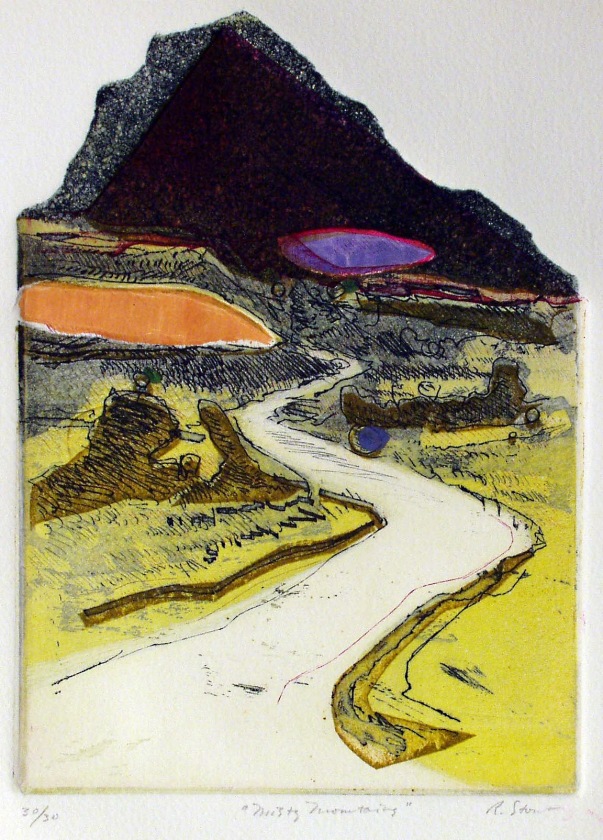
During this period he would exhibit almost every two years with Meredith Long and Company, and had shows at the New Arts Gallery in Houston in 1959, The Beaumont Museum, Beaumont Texas in 1961, By 1964 he was a consultant for exhibitions and installations in the Museum of Fine arts Houston Texas, and had shown his talents in that direction with the earlier 1960 exhibition he arranged for Chicago Printmakers held at the Contemporary Arts Museum Texas in 1960.
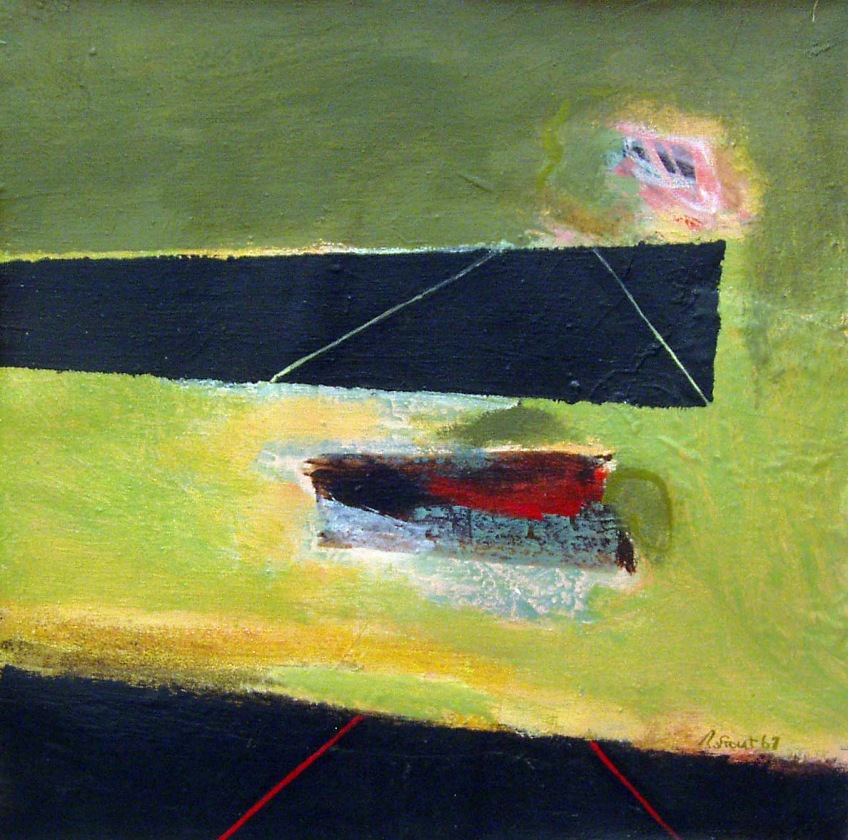
Turning to the painting we can see that the process of abstraction has led in Stout to a kind of renewal of his own vocation as a painter. He reaches out for simplicity, and working almost with the sensibility of a poster designer he reduces the areas of color to a small select band, even if one finds in close detail that there are often complex hues at various points, he has opted for the most part for a simple, clarified and direct color expression.
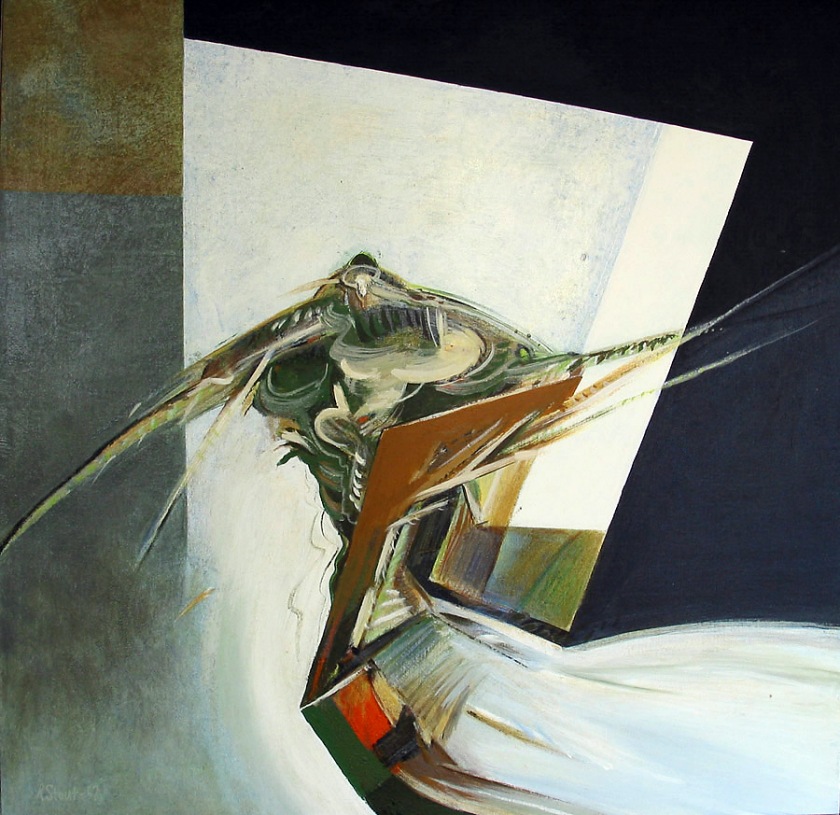
By returning to landscape he returned to his earliest artistic efforts, and again the contrast with the works from the 50’s is dramatic.
In the blue picture of 1961 he has gone back to the very vertical emphasis of his street scene and abstract from his own earlier work, and created the re-entry to landscape, with the sky having no dominant value, but being pushed from under by the strong rectangular form which swells in and out because of the way the relation of blue to black is observed. It is difficult know if there is a temporary structure in the foreground with an extruding roof, or whether this optical effect is created by the meeting of the long horizontal under the swelling box rectangle that pushes into the horizon line, with the sky area left white and neutral in relation to the values and tones in the lower ¾ of the picture. There is often in the works a deliberate visual ambiguity with regard to shape, as he proceeds with his rapid and obvious highly enjoyable works he will develop a closer and more structured treatment of the design of the picture and even allow his sensation go increasingly towards a mathematical and geometrical expression.
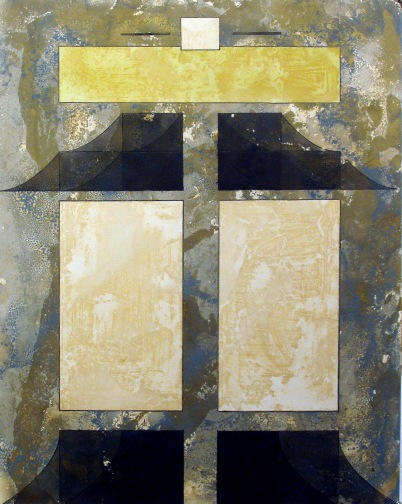
The push and pull is not between the different intensities of blue, but rather in the greater activity of brush strokes, using warm sienna brown and tones of umber to suggest movement in the surface. Again it is not clear if one is standing directly in the middle of the picture as the view point is very high.
Stout has taken to adding calligraphic lines to the surface to indicate divisions and to separate the planes. The work has the rapidity and sketchiness of wet in wet, but is surely a studio production. In some way the speed and rush of the blue is given to the seascape-as this may be interpreted.
The main movement into this period can be seen in the choice of new subject matter, the sea, and this is announced in the 1959 work entitled I went down to the Sea, the work is unusual in that the throne like structuring of the cliff, or headland to the right of the picture is blocked out with the usage of heavy impasto and palette knife, with the whites being slightly muddied, and the usage of different yellows and umber to suggests areas of differentiation in the values of light. The bright yellow cadmium also gives a high accent to the picture which seems like an isolated descant, and there is the feature of using very thin and calligraphic lines of color to suggest brace and structure, such as the slight hood of green at the inner plane against the sky, which also has loose brush work raining down on the left of the picture. There is a variety of different touches here, and the smoothness of the foreground sets off the more massive volumes of the overhanging land.
With the second sea work of 1960, the treatment is much more abstract and organizes the surface as horizontal bands, with a scumbled white for the sky, and stripes of yellow, black and violet and a bottom register in spumy white and gray. Here the referent is almost to the progression of horizontal bands of color from the declining sun, with no particular order.
The interpretative freedom leaves a certain unrest, and in two further studies to do with the sea, Stout returns eventually to a more conservative and structured approach, treating the Study for the Arctic, (1961) with its simple distribution of two kidney shaped areas of black, indicating rock outcroppings, or a projecting coast area, and confining the main color accents to blue, and black and white, with slight touches in the shadow areas of warm tones in brown and violet. In the second of the studies (1961-5) these are left out, and the whole is simple and more structures, using white at the edges of the communicating dark shapes, painted in ivory black, which gives greater weight and volume and avoids the flatness of the earlier study.
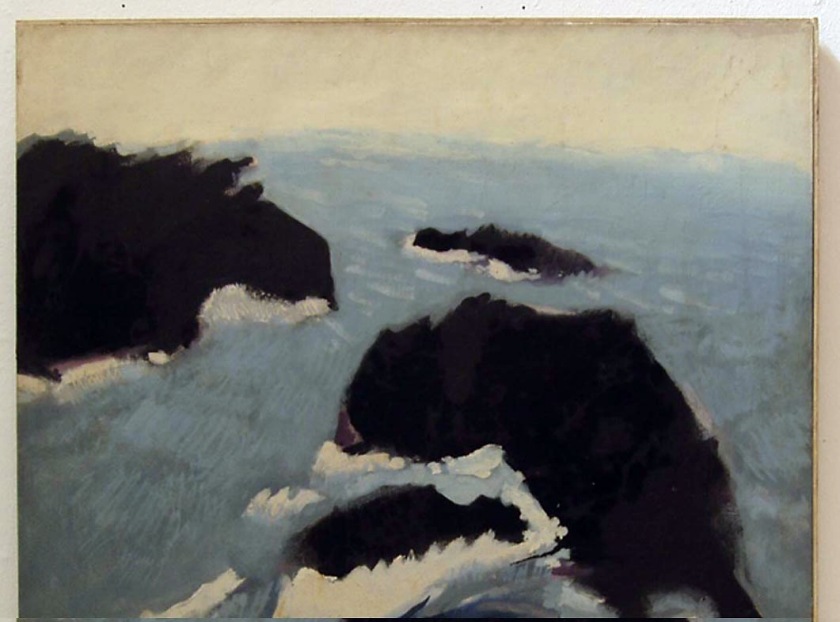
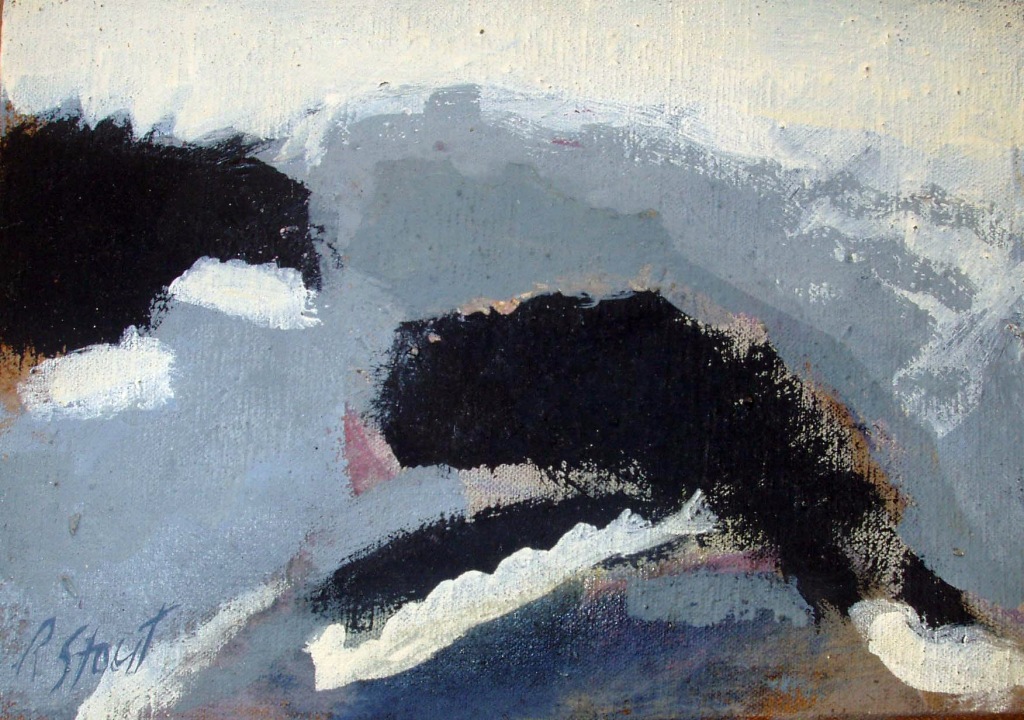
The appearance of the work entitled Remember the Race,or, Remembrance, returns to the problem of space and planes, but also releases it from his earlier treatment in the 50’s.
Instead there is an accordion of space, and this usage of planes like folding screens, becomes a significant device in the late 80’s and in later development.
The remembrance is a releasing and challenge: to the right the clear structure of a white block shape, and then the overlapping and intercommunicating planes, falling away, like a deck of cards, from green-gray, to gray yellow and a very hot red which juts towards the pink and beige of the upper register.
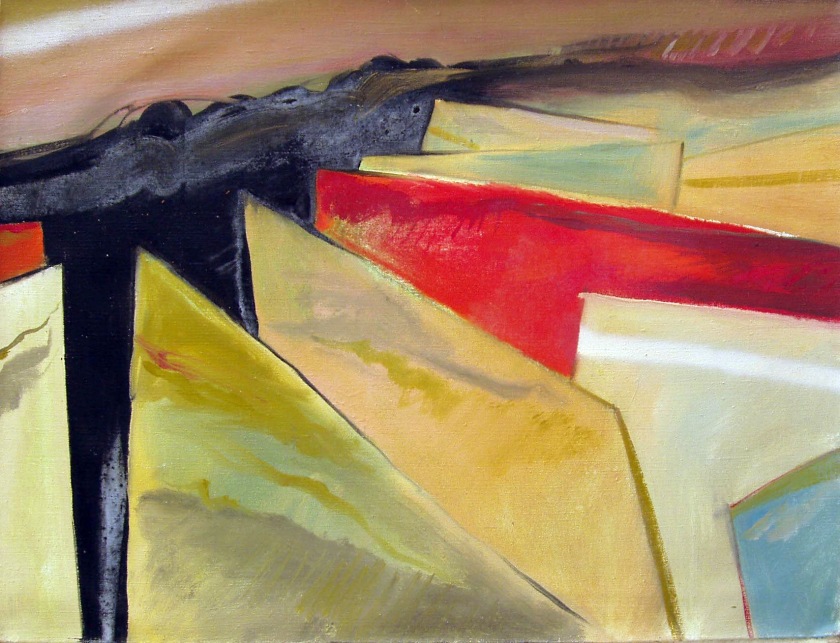
Between the rectangular planes and the block of white Stout has placed a sluice of space into which a black -blue seems to pour, although it is also a pictorial weight against the aggressive diagonals of the rectangles. At the very right corner the use of a light cerulean blue seems deliberately weak, and hardly able to protect the integrity of the picture from the internal dynamic which is overlapping in increasing color emphasis, and that seems as if the planes are a kind of desperate defense, like a protective net work against the left side of the picture, and an aggressive intrusion. The small area of light blue functions like a plug, which if removed would cause the whole picture to collapse and escape.
Mc Evilley has commented on this work, and seen it as indicative for a development which he traces through this decade. He cites the work Remembrance, sometimes called Remember the race, as one which introduces the work Trees past Water, also from 1961, ‘ a preoccupation with the triangle, or with accumulations of rectangles, often seen as floating planes, more of less vertical to the picture plane and seeming to accumulate force as they multiply”. He relates this to the 1965 work Remember, (1965) in which there is a horizon line in the mid-point of the composition, again with rectangular planes in front, green, orange and white, and rough suggestion of land form at horizon, they are also mostly inkling towards one direction, like canvasses leaning against a wall in the studio, which may be indeed the real prompt of these works-what he calls floating planes, that would later come into prominence ‘ bearing both epistemological and metaphysical elements of meaning’. The meaning suggested by Mc Evilley is epistemological in that the floating planes can be taken as a series of perceptual screens through which vision is distilled, and metaphysically they may suggest the generation of serial planes of existence. Even if that is not granted, it is at least clear that ‘they suggest an upsurge of complexity within space itself”… which increasingly becomes the subject of Stout’s work.
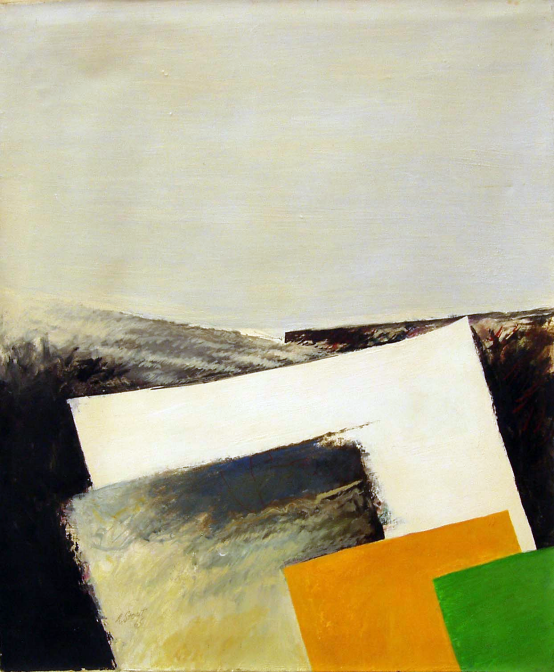
The other work also entitled Remembrance, which has the beige flat toned sky, with criss-cross hatching strokes in white in the lower register has the interesting device of a green rectangle cutting though the horizon line, and acting as what Stout would call “ the prompter’s box”.
The lower area of the picture has bold meshing and over lapping strokes that could form a reticulated net but is left disconnected, the colors of the violet, green and beige are set off against the primal yellow, blue and white, and the power of the small rectangle which occupies both register, like a figure of ascension, is that the sensation of this emerald green belongs also to experiences of landscape especially at sunset, with the green going almost to black.
What Stout seems to do is introduce non-naturalistic combinations, with some topographical suggestion, which still functions like a flag of abstraction and maintains a unified surface. The title of the work, must be seen as a significant inscriptive practice, and it too has the function of the prompter’s box, not just what is remembered, but can be re-stated in intense abstract relations, a function also accomplished by the naming of the picture.
The energy of the vertical which is strongly instantiated by the penetration of the heavy green with its internal marbling flourishes is taken up again in the work of 1961/2 where the main tonality is different shades of blue, and the stress is significantly on the vertical. Through a small series of pictures, we have seen relatively flat shapes, cubic massing and heavy palette treatment, smooth flag like bands, and complex geometrical folding and expanding screens, which also gives way in some instances to a very mobile almost congealing surface of thick paint, which runs across the mid-area of the canvas and seems suspended in motion.
Stout is exploring all the ranges of shape and color, and weaves his way from different preoccupations back to flower paintings, for example his treatment of the Magnolia, whose shapes are not unlike the landscape of Gibraltar in its early version.

The Magnolia is a plant from his early childhood, and its thick sensuous buds, and heavy petals of the white pink tipped flowering was a kind of push to the geometrical also for Stout. It is like the manner in which Blossfeldt views in his photography plant and organic shapes as industrial and man made. Stout takes the form of the Magnolia and literally hardens the shape away from its soft bulbous and fleshy form, and makes it rock like and deeply attached to the dark blue atmosphere of the sky.
Houston was known as the Magnolia City, and for the South in general, thanks perhaps to Tennessee Williams, the Magnolia is a most emblematic flowering shrub.
Not only does he turn to flowers but one also finds a virtuoso display in painting in his homage to Van Gogh and Monet.
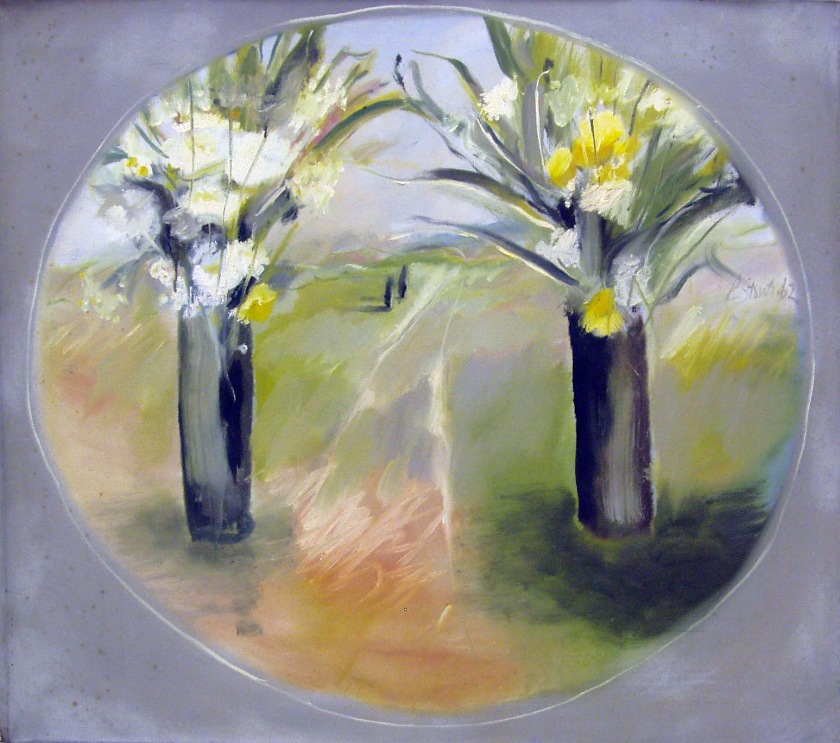
However, the most fascinating contrast with the works around the sea, and remembrance is the paintings from Mexico, and there one sees that Stout has in mind real atmospheres and places, and the luscious warmth of the Mexican landscape, the clearer light of the mountains, produces a richer, denser structure in the relation of color and shape, which results in also a much more expressive palette.
Whilst one can point as Mc Evilley does to the way elements of the geometry, and the line and circle emerge in this decade and contributes to what he takes as a great flowering of art from the late 90’s this runs the risk of seeing works only in a teleological movement to ‘late mastery’, but also downplaying the complete pictorial and painterly achievements of the other works under review. In other words paintings which do not fit the developmental scheme, which at best is schematic, often are undervalued, since they cannot be relevant documents for such a driven thesis.
Taking for example what may be one of the least successful pictures of the decade Time after
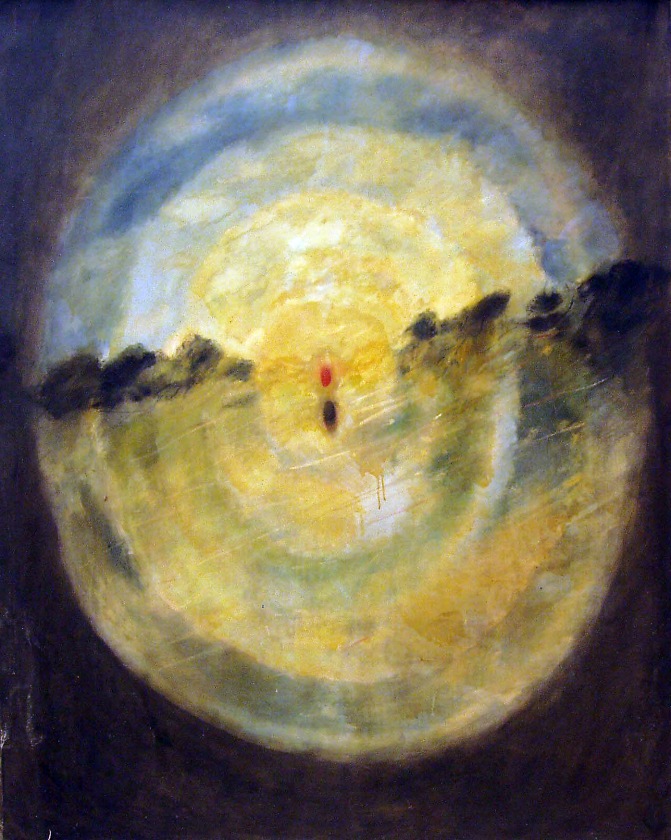
The relation of the yellows and blue has become muddied, and the large cosmic egg, reminds one of the theosophical effusions of Schonberg, with the oval remaining somewhat irregular and limpid.
Nevertheless the move to this shape, starts to become a significant exploratory impulse, one can see in the works dealing with Mexico, Oaxaca 1962.with its heavy raw sienna and deep purples and oranges two serrated shapes breaking up the outer edge of the , which can be set against the blinding light and plumb pinks of a picture with the same referent from 1963/6. The dome really makes its first appearance, rather shyly in the lovely spread of the painting from 1962/6 where the large yellow dome and the tiny focal pink spot, and lower register of blue, holds a kind of nostalgic warmth in the mind from Mexico, neither a rising nor a setting sun, not a rising moon, the expanse of the yellow hovers as warmth and light., the vast response to Mexico, leads it seems to the great disc and circular lunar pictures with their surreal light and sometimes almost poisonous suggestion, especially the picture Green Moonrise.
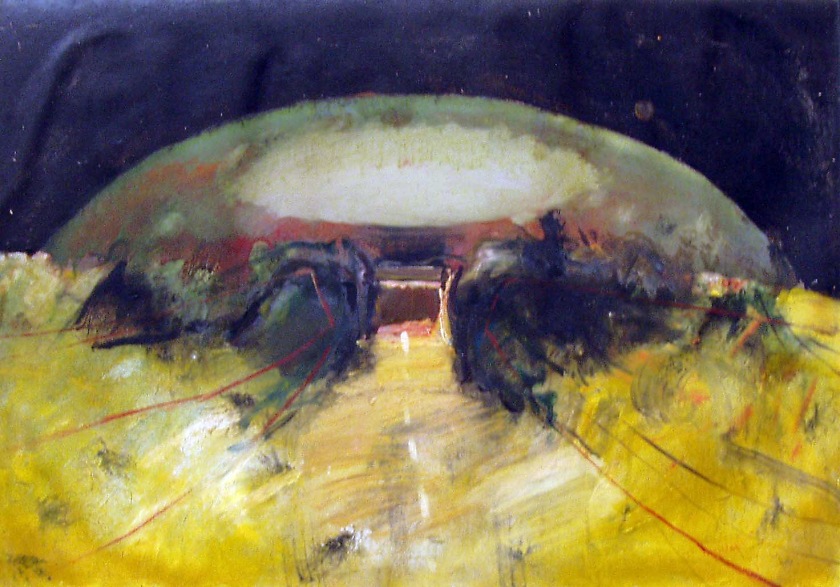
It is also clear that pictures generate new pictorial ideas. There is also the discovery of a new color, one can see his fascination with green emerging, and it is obviously used to great effect in the after Vincent work, however its most subtle and deeply felt usage is in the picture curiously entitled Village Creek, from the Mexico, 1962-7 with a wonderful use of cool pistachio green and lime and sap green mingled in lovely tonal painting, very different in its evocation of value to the more schematic and rigorous primaries a slightly later pictures. Lovely horizontal blocks of white that give the whole picture a very settled and beautiful effect. The interest in colors can also be pushed to act as planes, and not just the more precise rectangular forms.
Like the flower pictures of Nolde, which Stout must have known, the colors here are ringing, and have the eye catch of pansies.

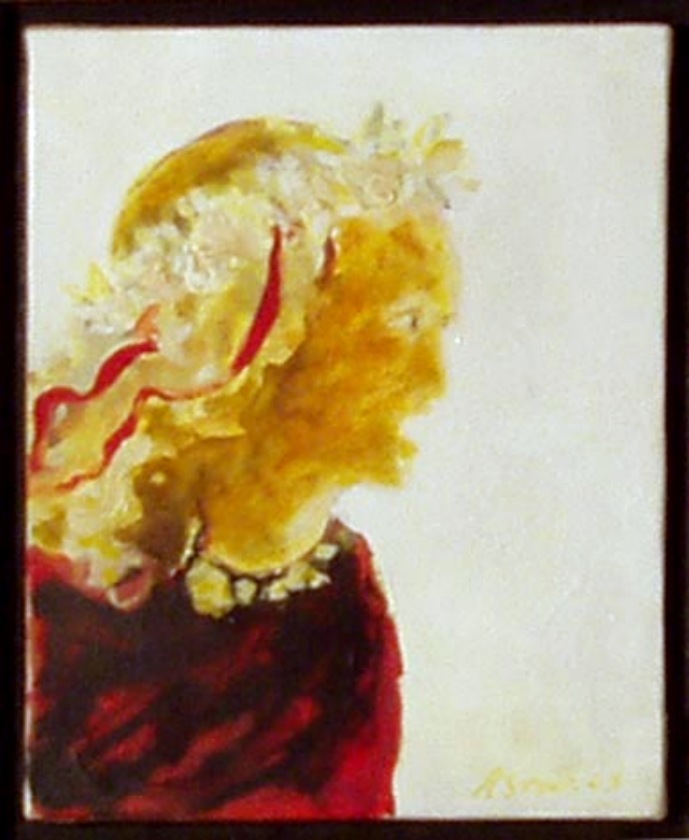
This is also a moot point in understanding why Stout does not go to color field at this date.
Indeed it is in this year one feels his rejection of that option. Not only is it the years which produces the doubling of the motif, but also where the work goes to an abstract limit, Stout literally veers in the other direction and produces a figure entitled Angel, 1963, which is shown in heavy profile, with one eye bulging, and the slight dome of the head and flying banderoles reminiscent of Raphael angels.
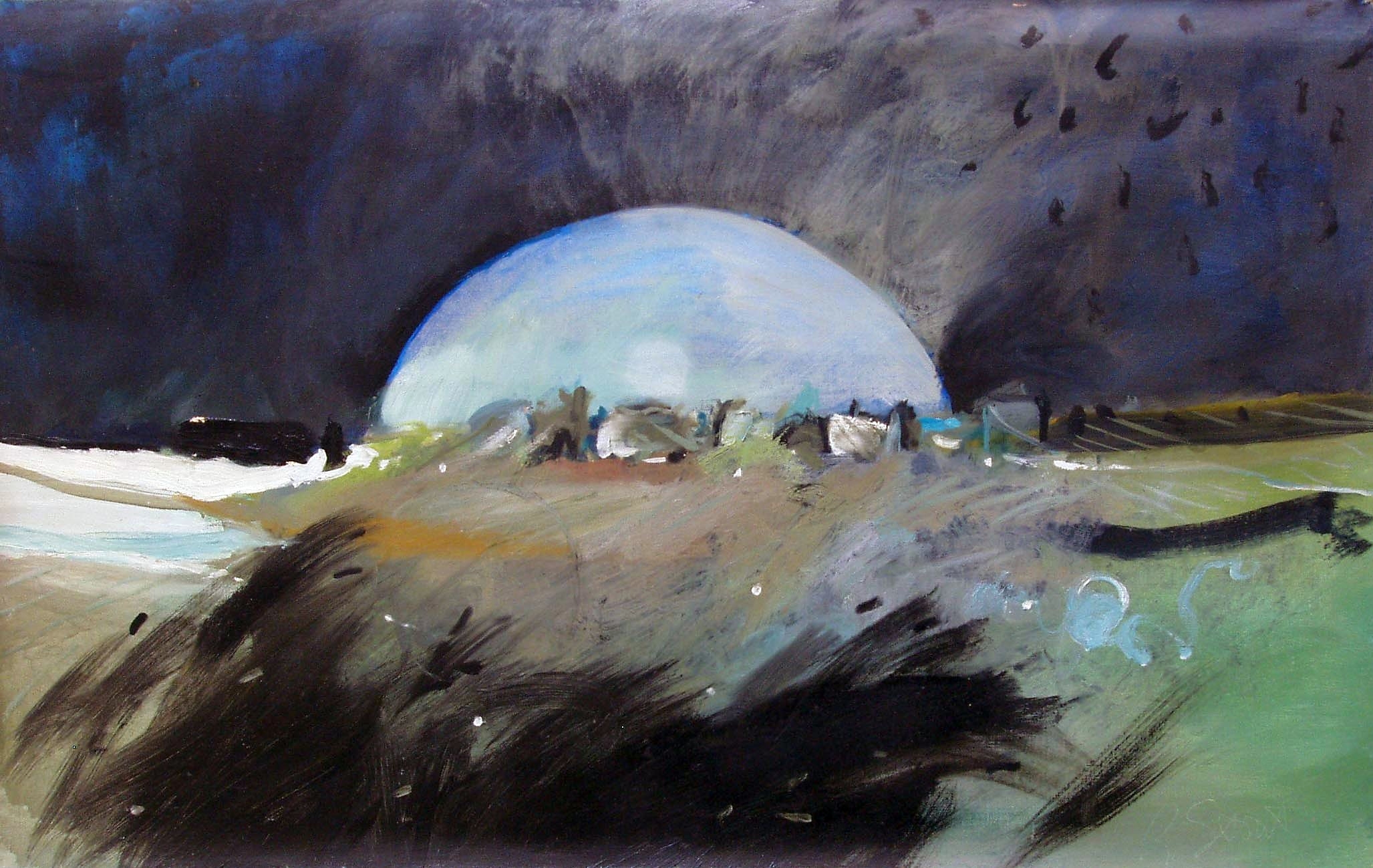
The circle with the flying ribbons is literally transformed into the angel figure of the same year, a work which followed in execution; the clue to the source and change being the streamers, and the play with the dome of the head which is also explored in the moon-light, and moon works of which there are a few from this period, the most beautiful of which might very well be the Blue Dome of 1964.
There are many comparisons, negative for the most part, which explains why Stout does not move to ‘color field’. His relation to the viewer is very different from the practice that requires immersion on the basis of scale. Stout allows a nearness which also preserves a distance. Rothko it is known used immense scale in order to immerse the viewer in the painting. Robert Hughes points to the very strong demands on the viewer from the works of Barnett Newman and Clyfford Still along with Rothko, ‘the theological side’ of Abstract Expressionism. ( phrase is from the Australian critic Robert Hughes) Stout does not work with vast fields of unbroken color, at most there is the inclusion of such a field, and small, in the work Remembrance, with the red rectangle, which has almost no admixture in the color. However much Stout works with the contrasts of local and universal color, of cold against warms, of suggestions of the local color especially in the Mexico inspired works, it is not just the hue and luminosity of the paint which is the main offering for the attention of the viewer.
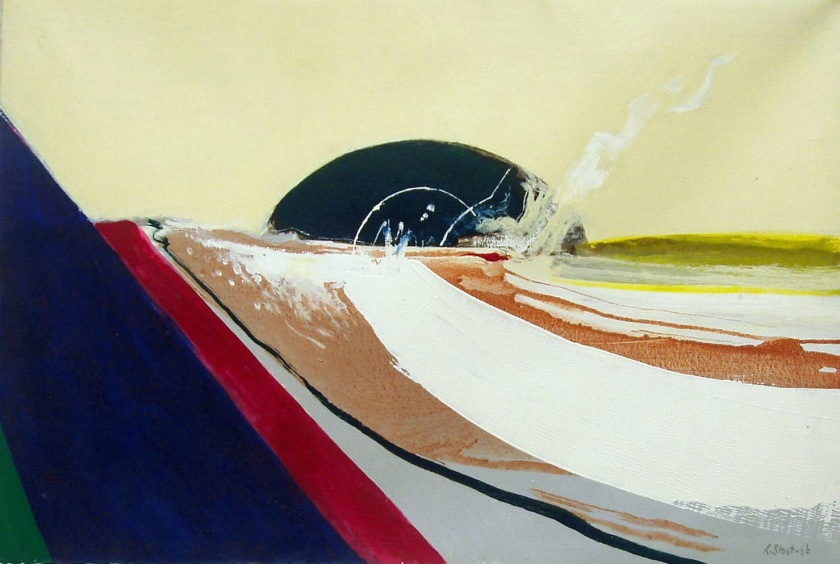
There is the more symbolic and meaning laden suggestions, which however ambivalent, still evoke for the viewer real referents, and places.
With the Color Field painters, part of the power of the image lay in the sheer scale and size of the work.
In his book on the art and invention of color, Bright Earth, Philip Ball, who has recently written on music, notes this as taking Kandinsky’s vision to its extreme. The object had disappeared completely and the only thing left was color.
Nevertheless it is difficult to not find, even in works of Rothko landscape reference, as Ball says, even Ochre and red on Red ‘ has echoes of landscape simply be virtue of the horizontal format of the color fields: we are looking out into the shimmering heat haze of a desert.
For Rothko this is wrong, these are not sky or sea, or even abstractions, the luminous rectangles are just ‘things’.
Mansbach noted the doubling of the motif being used in this period. His reading of the significance of the motif. The double runs throughout in sum sense the whole of the work, not only in the explorations of obvious polarities, but also in the shift of thematics, in the ricorso to the earlier work, in the repetition of motifs, often in the actual twinning of motifs, such as one finds in pictures of Courbet, a point first noted by Mansbach. There is also the movement to the outward in that the interest in landscape has become more pressing, yet it is accomplished in the interior of the studio.
Further he chooses deliberate contrasts in terms of powerful guiding shapes, from bands of horizontal to the arc of the semi-sphere, to the full dome, rectangles and triangles are also fully deployed and for very different reasons. Looking at the emergence of the dome and the triangle; there seems to be a direct citation of the monumental Egyptian forms of the late 18th century architect Boulleé, who may have been a direct source, and have come to Stout’s awareness via his friendship with Dick Wray.
The choice against color field does not stop the exploration in a much more intimate, easel painting scale by Stout of the values of color, the difference between their mingling and the drive for expressive purity. It is hardly accidental that the blue dome painting of 1964 has the suggestion of an architectural monument. In the dark blue background of the upper section of the painting, which is almost divided in half in terms of its register of dominant interest, the almost transparent quality of the blue dome with its light Marian Blue, ultramarine and white and to its right curious flecks of black, like after images of bird-flight, the simple relations of blue, green and black in the lower register of the picture all point towards a large almost megalithic structure which one could enter, and the suggestion is reinforced by the directional traces of the brush movement to the left and right below the low horizon line, acting as a divider of the space. It also centers the viewer’s access, and allows a kind of transparent through view in the high lights of the semi-circular dome with its setting not lacking in monumental suggestion. Were this all to be rendered in three dimensional volumes then one might very well speak of a cenotaph of Boulleé, something with the monumentalizing and massive volumes of Egyptian funerary architecture.
This play between warm and cold will be seen in a number of the landscapes of this date, especially in 1963.It is also in this year, 1963 we see the significant ricorso to the work Maldoror and what Mansbach was the first to signal as the creation of compositional means adequate to his own internal paysage. The notion of paysage here is richer in suggestion than landscape, and suggests that notion easier to express in French of a mental space, of an intellectual milieu, that is to say space and place attached to what are not projective psychological effects. One can also see the emergence of a distinctive palette which allows maximum range of mingling, and at the same time allows his shuttling between the warm and the cool.
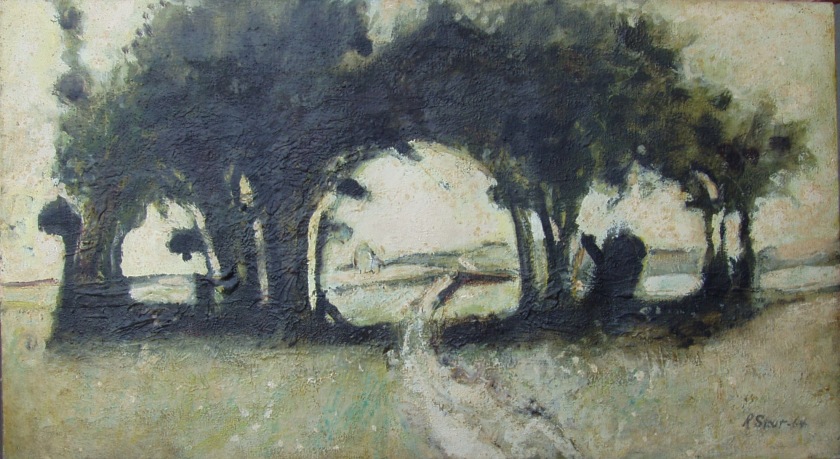
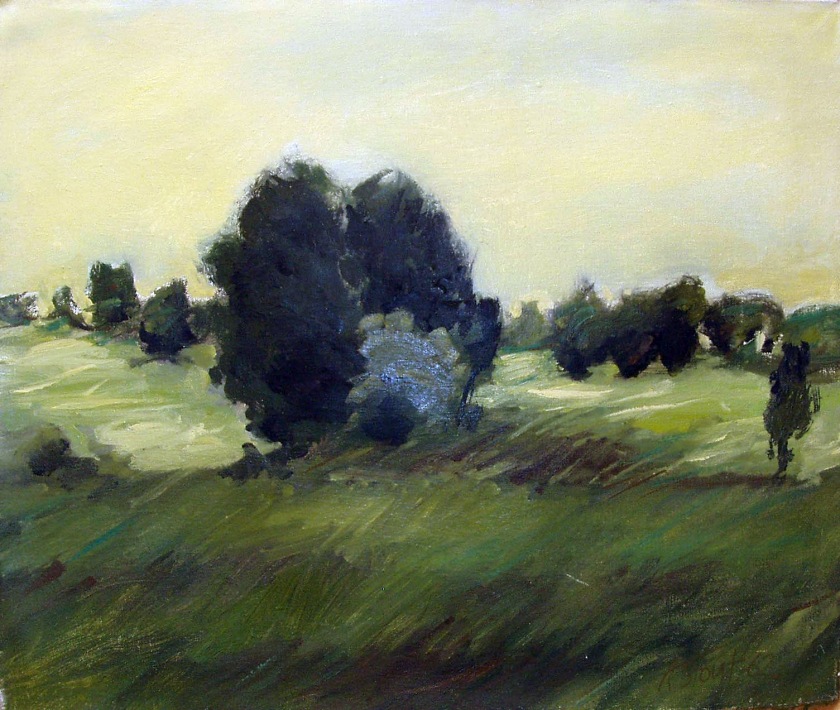
Eventually it can be seen to consist of a small number of preferred colors; cerulean blue, burnt orange, titanium white, primrose yellow, red oxide and raw Siena. He treats the green, such a Jenkins green as warm and towards the grey, the primrose yellow as colder than the cadmium, the darker blues as cool, with the cerulean as warm. Sometimes he distributes metallic powder in some of the colors to add brilliancy, and through later refinements adds Hansa orange, and begins to explore the use of raw umber.
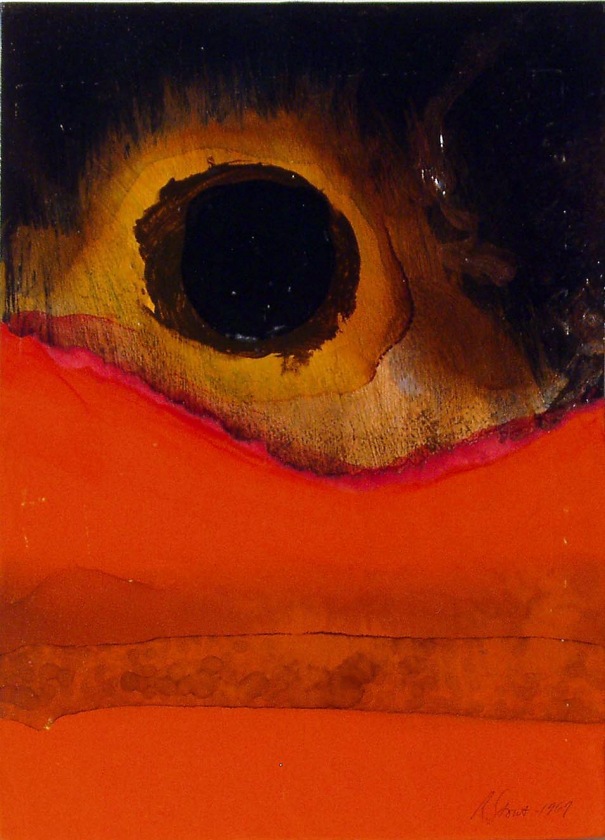
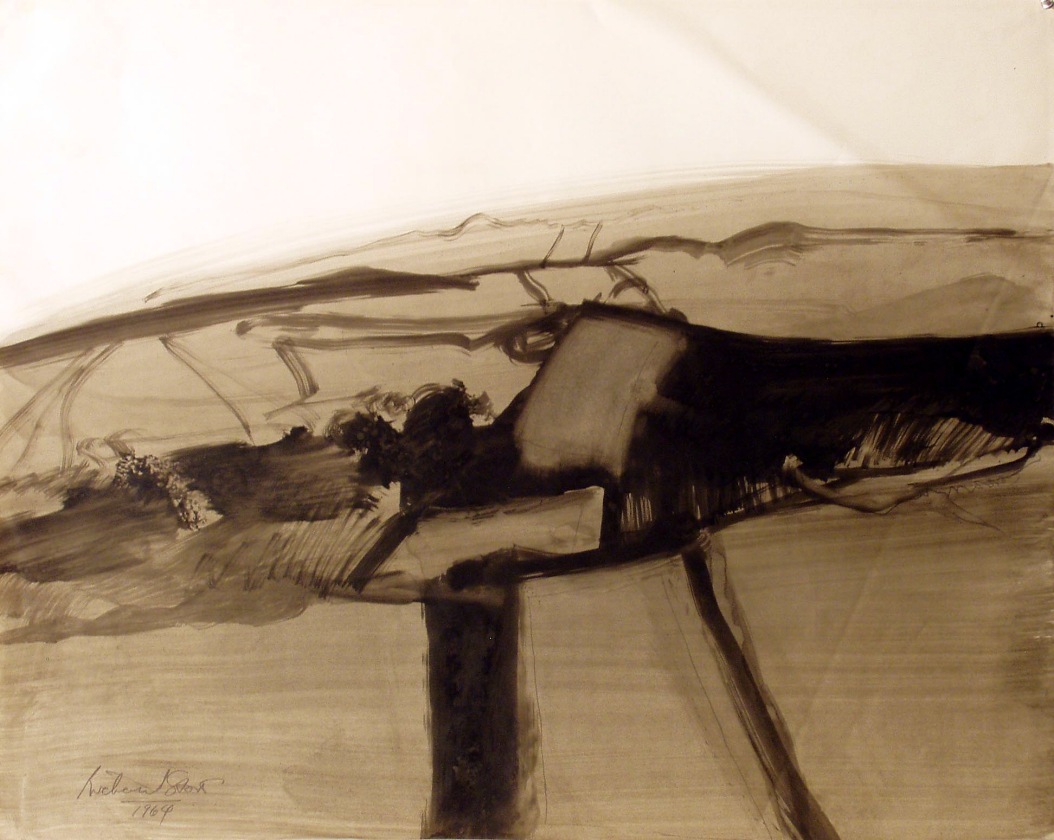
If one were to fast forward to the end of the decade, and then compare what had eventuated at the beginning, it would be difficult not to see it as a kind of mirror opposite.
The linear has reasserted itself, and there is instead of an open exploration of nature, a highly sophisticate and knowing reference to historical works, and famous art creations.
Further there is no doubt of the influence of Malevich and Suprematism in this later work, and remarkably Stout will choose the sequence of 25 works in exhibitions of drawings in 1971. The fulcrum of change in the 60’s can be detected in his returning to drawing and etching at this time, and also a going back to basics which was probably motivated not only by his increasing work-load as a teacher, but by the necessary re-examination of his own roots and development.
One can also point to his biographical situation at this date which has the bachelor painter sitting in a 13 room house, which is being renovated and transformed, and he is occasionally dating girls under relatively strict conditions. This was not for the moment the ‘permissive’ society of pop fantasists. In 1964 he met Anne Winkler before his first trip to Europe, and within a year they were to marry. Stout later recalls that this was the most marvelous thing to happen in this period. His two close friends of the period were Dick Wray and Michael Tracy, whom he did not meet until he started with the University of Texas, where he was taking a Masters Degree in fine art.
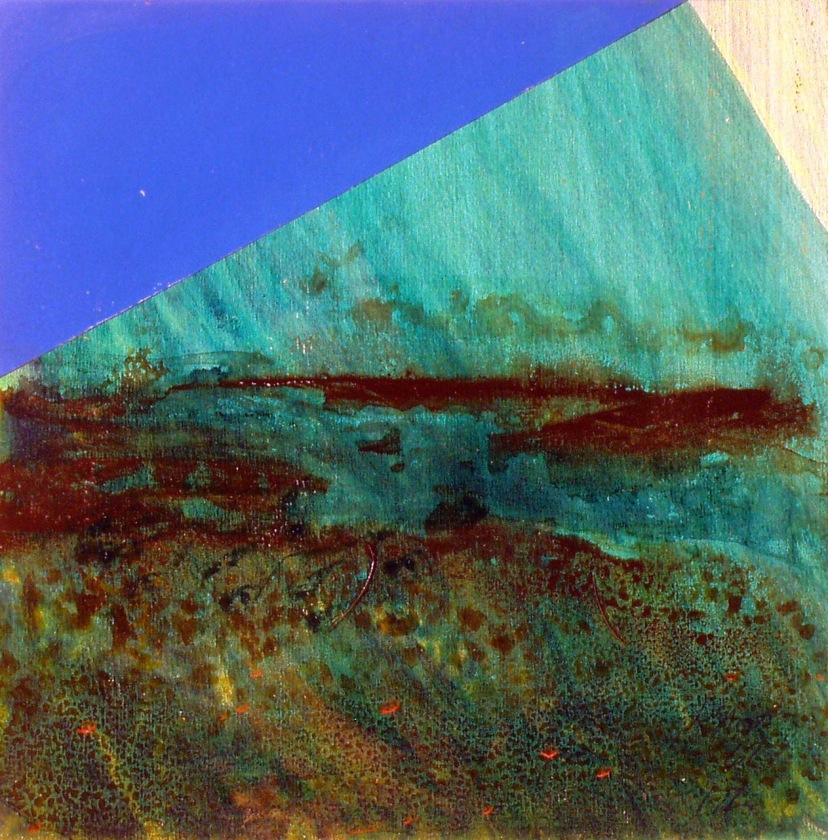
This study arose out of the suggestion of Peter Guenther at the University of Houston, Art Department, where Stout was teaching part time, at instructor level, which took up to eighteen hours per week. On the recommendation of Guenther he enrolled in the University of Texas, where in order to gain entrance to tenure track he upgraded his qualifications.
Guenther was the son of the distinguished Alfred Guenther, and had been born in Dresden in 1920. His insistence to Stout to upgrade his qualifications came from his own harrowing story , in which as he was preparing to finish his doctorate war broke out, and when he returned to Dresden after the war he literally had to dig his mother out of the rubble and moved then to Stuttgart. He moved to San Antonio with his four daughters in 1955, and worked as a laborer. He was unable to have his credential sent from Breslau, now Polish Wroclaw, and was given part time employment in St. Mary’s, and eventually began studies at the University of Texas, where he earned a master’s degree, and then moved in 1962 to the University of Houston, and in 1962 became a doctor. This period of marriage, the birth of two children, Claire and Stefan, and commuting to Austin Texas from Houston was obviously enormously time consuming. It is almost unbelievable, in Stout’s words as to how he managed with all of this, something of the dizzying pace and confusion of being constantly on the go is well indicated: I commuted – that is from Houston to Austin-. I would teach at the University of Houston from 8-30 until 5-30 – three hour classes. Taught nine hours.
I’d come home pick up my bag, brush my teeth, get in the car and tell Anne goodbye, peck Stefan on the cheek, and get in the car and drive to Austin. I’d usually get there around ten o’clock.
A friend of mine had an extra bedroom. He gave me a key to his apartment.
I’d let myself in, go to bed, wake up the next morning at five o’clock, go down to the Art buildings, let myself in, work until about eight o’clock, and then go over to the Tea House on Waller Creek and have breakfast and come back and work. Depending on the schedules the teachers had, I’d work until about seven; get back on the freeway and drive back home. Teach class on Wednesday and then go back on Thursday. Our classes were on Tuesday and Thursday and I was at the U of H on Monday and Wednesday.
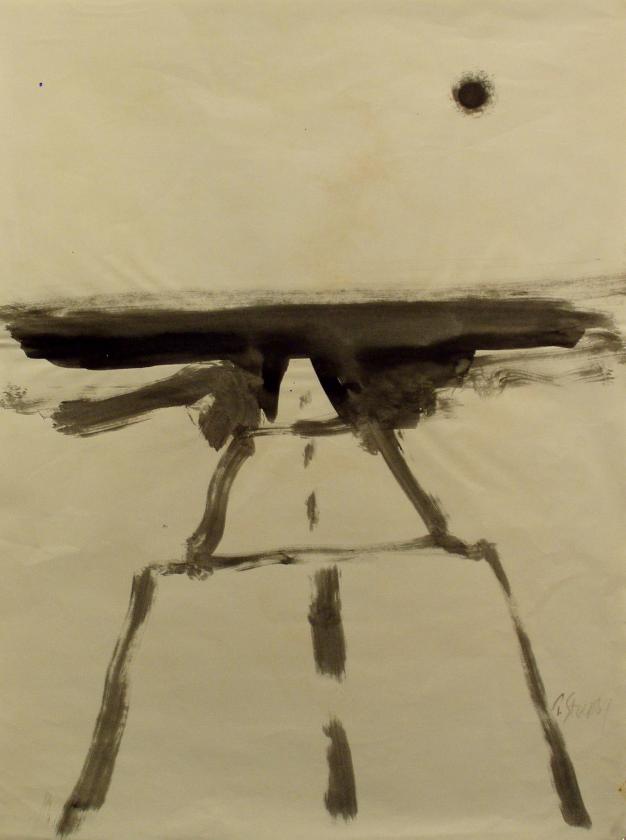
And sometimes I would go back up on Friday and spend the weekend if I had to spend time at the library, which I did some of. And that schedule went that way for two years.
Stout referred to his friendship with Dick Wray, and although the relationship with Michael Tracy was obviously much more ‘baroque’, his work as an artistic affinity was more with Wray, and he himself referred to his two friends as being like ‘chalk and cheese’. In an essay from 1975 contributed to a Wray show at the Contemporary Arts Museum, one can infer the relation with Stout, which must have been of some impact on the mid decade shift in direction which we see in the work.
James Harithas noted that Wray’s abstract expressionism had an immediacy and power which was achieved because of his gestural grasp, shown in his radical juxtaposition of linear form and painted field. Wray had a broad range of stylistic devices, even including a recurrent symbolic motif of a crow, and was clearly directly influences in his action and gestural work by Tapies, De Kooning and Pollock; he also had a lively eye for the work of North West Coast Indians, and was admired by the new director of MFA James Johnson Sweeney. From the early 1960’s.
Works from Wray with their careful use of circular gesture, and interest in new grid structure, also had a tachist fascination, the gesture and the tactile of the surface were of considerable concern to the trained architect turned painter. The shapes however never became constructivist or purely geometrical.
In some way Stout turned away from the almost histrionic expressivism of Tracy, and it will be as late as the end of the 80’s before we find direct homage to that friendship – in Still Life with Michael Tracy box, 1987-and did not really practice the kind of gestural freedom of action painting such as evinced in the work of Wray until almost ten years later.
This slow gestation of influences can be seen throughout the work of Stout. The linear, constructivist and the return to drawing was also a bulwark against new impact, and a way of coming to terms with the looming weight of the art historical inheritance which he experienced during his first travels in Europe. Several landscape drawings in large washes of color, and almost monochrome point to the return in Stout. From his earliest days he had sought inspiration in landscape, and it is also clear that when he came to the risk of repeating himself, the danger of over-production in these years he stopped short and took a close examination of his work, this often leads to unexpected risks and new directions.


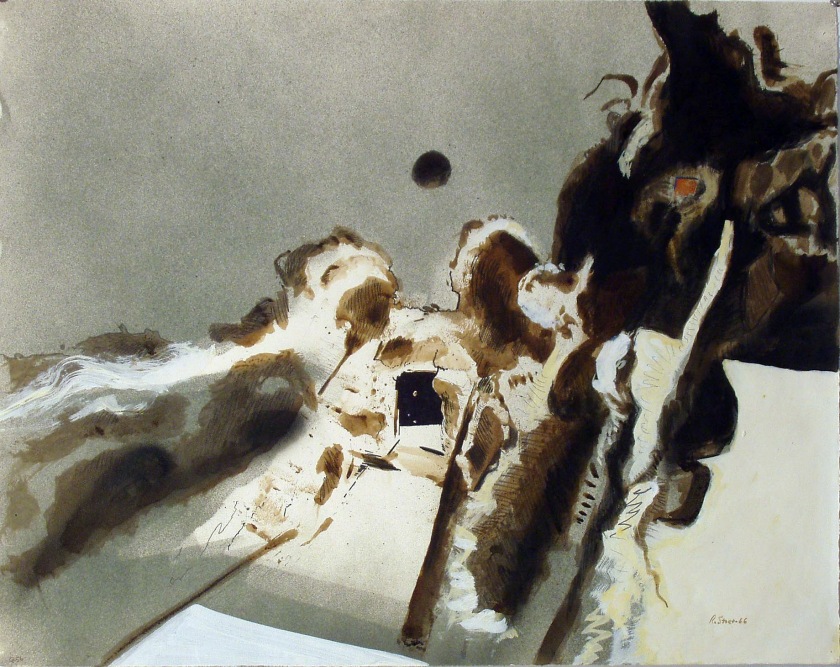
As seen earlier from the 56 abstract work of the road, again there is a work leading to a rugged and insistent motif.
The treatment of Night Road, with its strange black circle almost at the very dead center of the picture, allows the ground maximum play, and the swelling treatment of the brown Siena has some more gestural and less controlled input than in previous works.
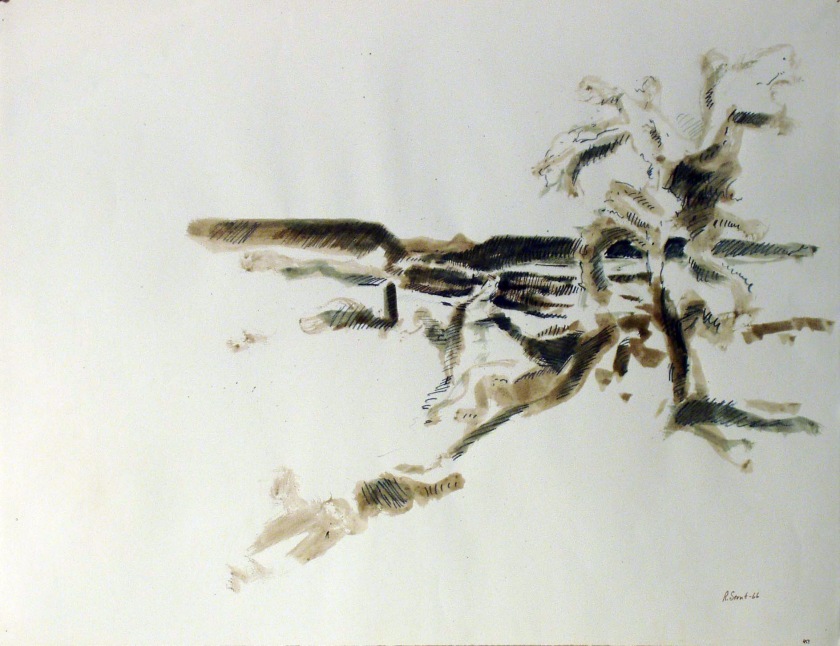
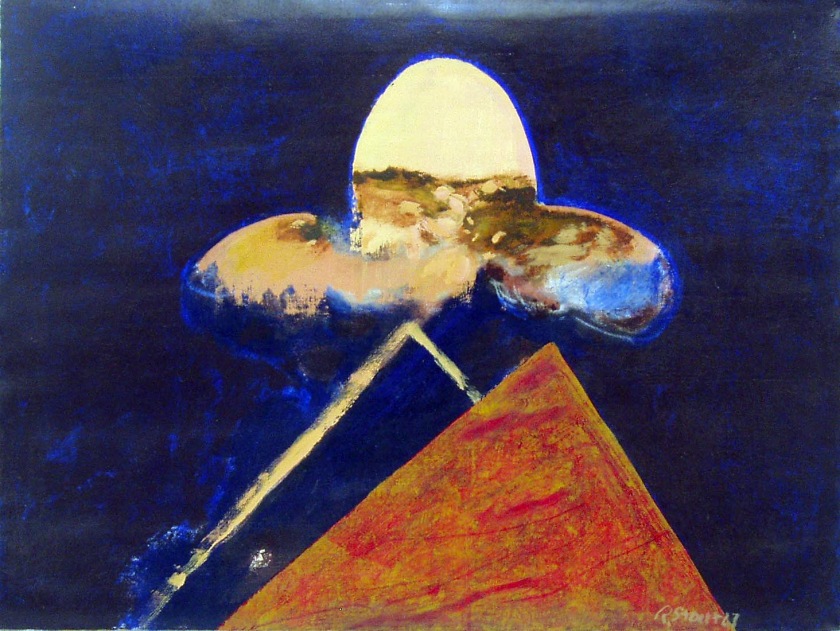
This movement seems to give him a breather, and in light of the enormous demands on his time as a teacher, it is remarkable to see through the years 66 and 67 a movement to the pyramidal and large geometric forms which will become again in the late 90’s of such significance for his work. One could say that in the end, the mathematical and the dynamical sublime are joined, he lets landscape and the sea meet with the geometry and monumental artifacts of the man-made world fuse.
The work which he entitles the great Orange Mountain can be taken as a key document in the shift to the more tectonic fascination. The violet maroon sky and the Hansa orange of the pyramid seem on the basis of a simple visual illusion to lie behind the long horizontal of the front plane. Through the 60 Stout has effectively had to deal with the horizontal emphasis that landscape imposes. One can see the forms of the verticals as trees in doubled motif and the introduction of the circular and triangle as ways to rise above the horizontal.

In the work entitled the Great Emblem,above, the doubling of motif is again seen, and floating above the two inclined triangles is a triform shape which suggests within it a view through the dark ground into a lit world. Again there is a suggestion of landscape in the upper section of the trefoil, however it no longer dominates the composition as a horizontal band, and with that Stout can re-consider the abstract facture of the paintings he is making. An exhibition held in the Houston Gallery in 66 shows something of the diversity of his work at that date, and the jumbling of motif and work with which is engaged. The work Athena has the triangle literally float to the top of the picture and introduces a rich smooth magenta at the upper right corner, which is offset by the loosening of form on the left and below, it, is as if the stability of the figure has been surrendered.

Stout then in a series of 25 works, exhibited in 1971, and whose sequence can be constructed thanks to the careful work of the curator of the show., return to the surface, to construction to art as being about art. What can be shown is that he is engaged in renewing his own creative sources, and that he is conceptually busy with acts of translation of the space of older pictures as a source of pictorial work for himself.
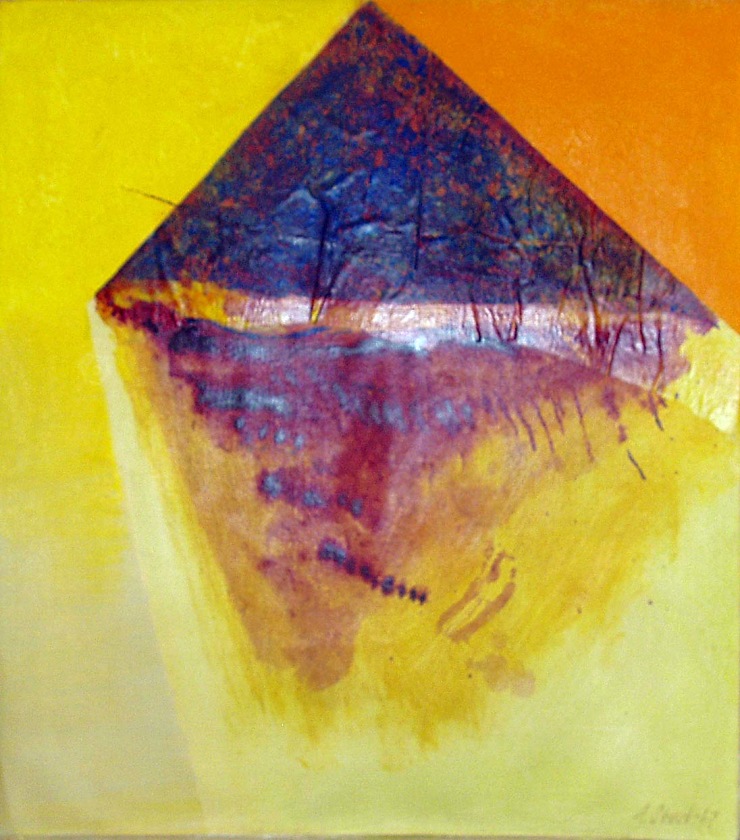
By the end of the 60’s one of the works for which Stout is to be best known in the Houston is probably one which gives the least sense of the previous twenty years of work.
It however is a work which seeds the development in the early 70’s in which Stout almost reverts to the work of a painter like Juan Gris, who in his synthetic cubist phase combined color and shape in a specific response to previous analytic work. The work exhibited as part of the National Bank’s use of outdoor advertising billboards located on Houston freeways. The bank which used outdoor advertising had leases on five painted billboards, which were 14 feet by 48 feet wide. The project was to use these billboards as giant canvases, reproducing original paintings by five nationally known Houston artists. The artists chosen were William Anzalone, James Boynton – whose work announced in stark letters M DUCHAMP LIVES, David Hickman, Dorothy Hood, and finally Richard Stout.
The paintings were commissioned by the National Bank especially for the ‘The Larger Canvas” roject. The organizers arranged that the paintings would two months the five larger canvases would be moved from one location to the other, until each painting had been displayed at each location, that is Southwest Freeway at Louisiana, Memorial at Capitol, North Freeway at West Road, Eastex Freeway at 1.10 and West Freeway at Studemont.
It was anticipated that up to 650,000 motorists would see the paintings.
Dr. Peter Guenther was responsible for the choice of artists, in his capacity as Chairman of the Art Department of the University of Houston. The transfer of the paintings to the 14’ x 48 ‘billboards were done by outdoor craftsmen working in conjunction with each artist.
A photonegative of the original was made, and projected onto outdoor panels.
Using this as a pattern the painter blended his oils as he painted the billboard by hand.
The aim of the Bank was as a ‘ good corporate citizen’ to set the pace on every front, and especially in the arts/ This was advertised as an awareness raising campaign by the Bank in its broadsheet publication, and it hoped that this would beautify the city and make people prouder to be Houstonians.
Stout’s delivery of one of his ‘drawings’ should come as no surprise. He had probably correct understood that a work with a very strong design and largely linear would serve the scale best, as he worked in a much more intimate scale for the most part with his paintings. The work which would appear again on the cover of an exhibition held in the Marion Koogler McNay Art Institute, San Antonio, Texas as part of an exhibition from the 7th of February to the 7th of March,1971 had as its title Fra Filippo Lippi.
John Palmer Leeper wrote a brief introduction to this show which adverted to the difficulty of the term ‘drawing’, rather than using the designation of ‘works on paper’ which he though would be a more accurate description of the group of twenty five compositions by Richard Stout, which were complete by 1970. His reservation was that the term drawing was the one insisted on by Stout for the exhibition, since Leeper was of the view that basically, though not necessarily, one thinks of drawing as being monochromatic, linear or tonal, more intuitive and less formal than a painting.
Therefore in the eyes of the purist, Mr. Stout’s work here might scarcely qualify as drawings, which is the term he prefers.
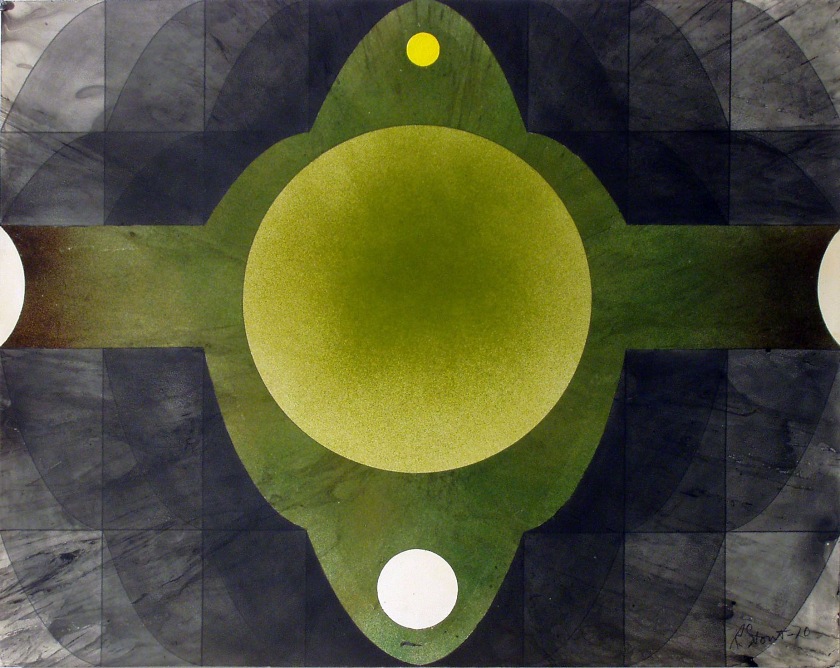
Only the earliest were monochromatic, and subsequent drawings Leeper notes acquire rich textures and brilliant colors. Even in some of the drawings the surfaces are intricately realized with pencil and powdered graphite, rubbed erased and adjusted.
Some powdered metallic are blown on and varnished in layers. Papers are dipped in mixtures of enamel and water to achieve marbleized textures.
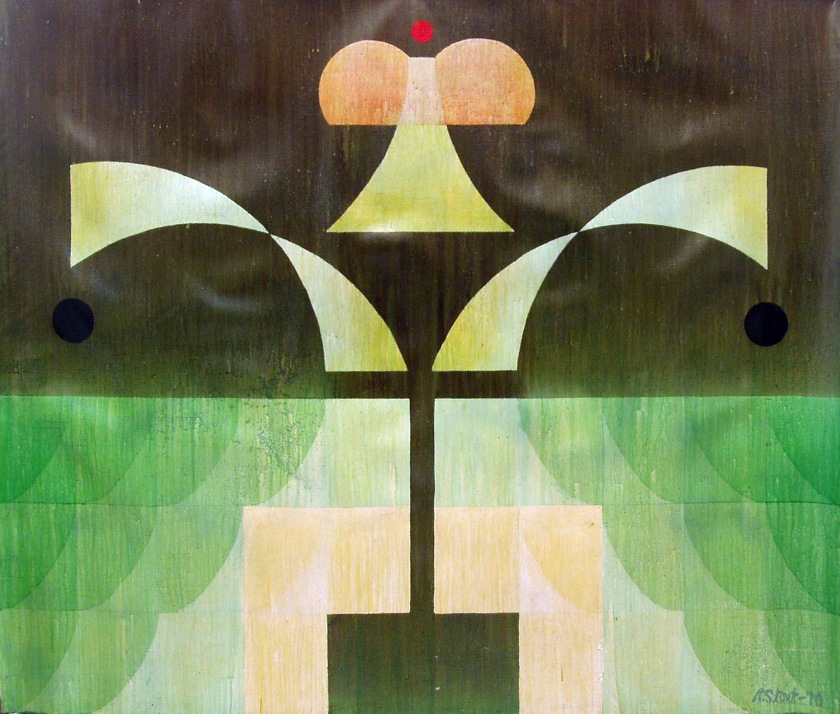
The linear structure was firm and for the curator even rigid in it’s confining of the sumptuous surfaced areas. He accepted that they were strong, clear and rational, suggesting that they confirm Mr. Stout’s belief in the simultaneous existence of freedom and order. The drawings he accepts were formal, calculated and even self conscious.
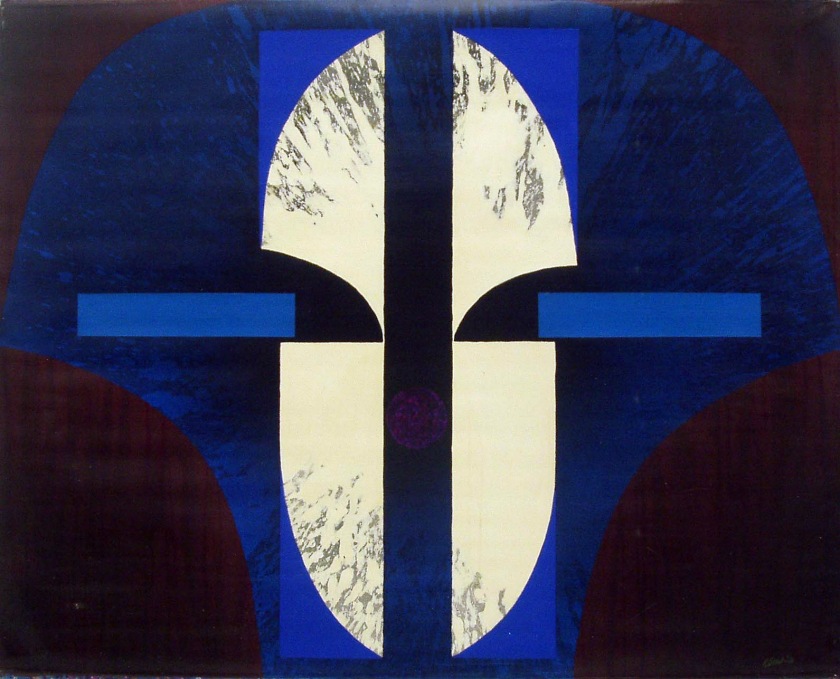
They are deliberate rather than intuitive; they ‘are stately exercises rather than spontaneous notes’. He will add again that the drawings are intellectual studies produced with command and dexterity.
Stout has made no effort to conceal his sources, and at the same time his approach to the very sources is not always that far from Duchamp’s moustache on the Mona Lisa, The sources, or target works, were given in the catalogue list, which also was arranged chronologically, thus the first two drawings were related to Georgia O’Keefe, whose flower works are significant even for the larger abstract forms of Stout, for whom the translation of pictorial forms is often based on simple use of shapes that exist in other settings; thus the figure of a flower can be put upside down and by analysis create monumental suggestions of hills and space in the work, or a human figure on its side can be abstracted as contours which are then laid horizontally across the canvas and so forth.
The game of shape and gestalt is played by Stout throughout the period of the 70’s, when the linear and search for good gestalt combine. In that sense the synthetic phenomenon of Gris is a relevant template for his work. Further references include those to a Gothic drawing, Malatesta, which is a direct reference to Alberti, Malevich, a drawing from Chatsworth House, and several which analyze the School of Athens by Raphael, there is also influence from tantra mandala art, and Lorenzetti.
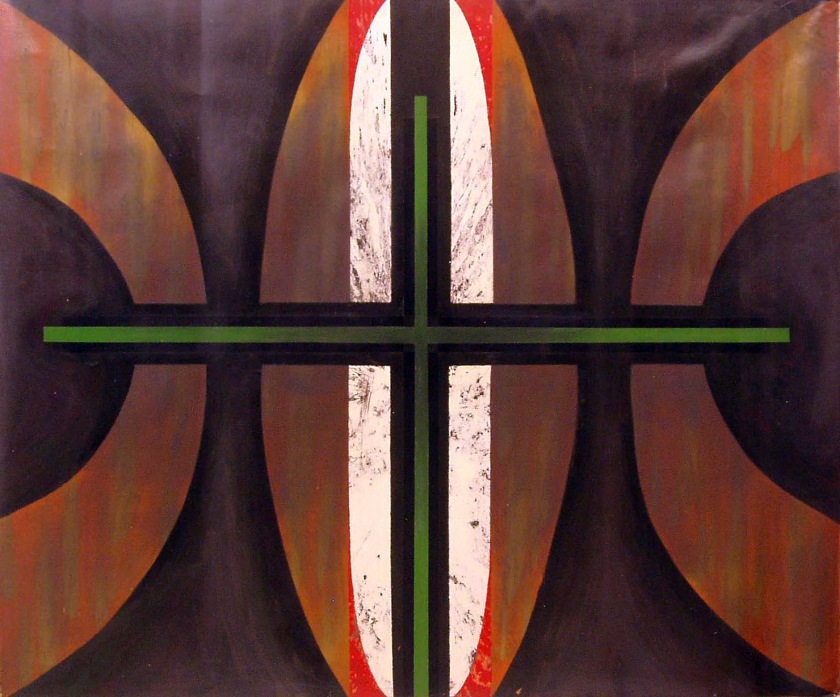
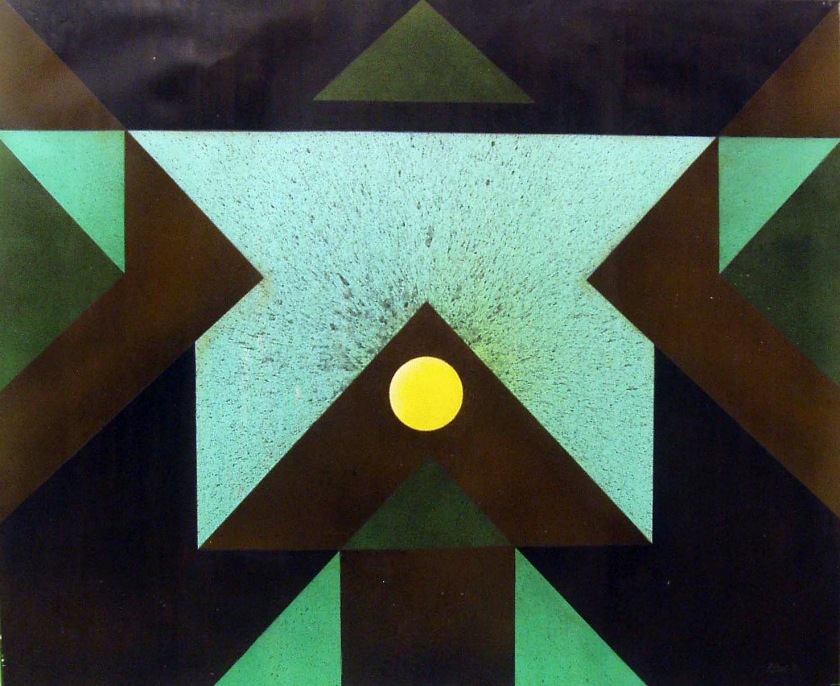
At San Antonio he had exhibited before, and they were canvases of bold and explosive colors, it was not surprising that there was a certain hesitation on the part of Leeper introducing the second show. This hesitation also sounds the beginning of critical reception of Stout, which sometimes expresses bewilderment, and even a sense of betrayal, that he has taken new directions, has left paths which were becoming recognized and collectable for many art lovers in Houston. Through the 70’s as the art world became inevitably more competitive, critics sometimes delighted in ‘scalping’ what was being designated as the ‘ old avante garde’ which by the late 70’s would even include Michael Tracy and Richard Stout.
What is of most significance in terms of medium for the artist is his use of metallic powders.
This is clearly a direct influence from Michael Tracy, who had made the use of metallic powders One of the masters of using bronze powders and coal in Texas was Virgil Grotfeld, who although not born there, became a local by adoption, a practice in which Houston was easy and generous. Stout was trying to get away from himself.
He had even registered in this formal insistence a movement away from the work of the mid-60’s which he started to view with distaste.
In interview he frankly suggested that he had ‘lost it’.
Looking at the work from the mid-60’s he now only saw catastrophe, landscape in landscapes. It was as if his own work had just become a series of internal references to itself, had been boxed in, and there was just sun setting and exploding, a coruscating display for him of futility. The lone existentialist voice returns in these notes. The clarity and symmetry of the work from the early 70’s also seemed futile, “ I lost it. I lost the point of it”.
He found his way out be what can only be described as a kind of self rage. He started he said ho throw things at it, meaning the canvas, and found with a large X across the canvas he was able to experience voids in the corners, and this released again for him a sensuous surface, with forms moving towards the odalisque and the arabesque line which he so admired from Matisse. Later diagonal abstractions were surrendered again to a certain loss of energy and loss of direction. What he had admired in Matisse, the way in which energy released itself from points at which it congregated without every losing the flow of the line, was not possible, within his own idiom, to achieve.
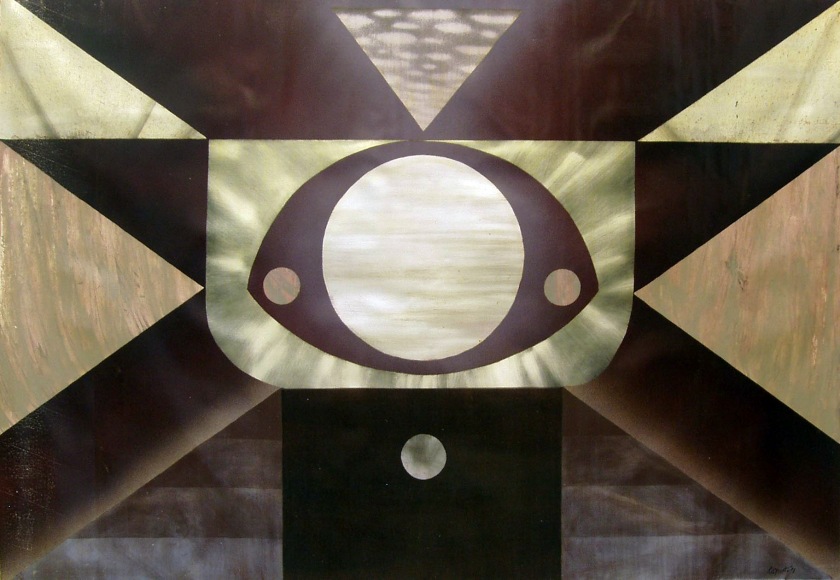
When he compared himself he did so not with his contemporaries, but with recent ‘ancestors’ especially Manet, Matisse Cezanne, and not only did he have a dangerous tendency to underestimate himself, but he always fell short by comparison.
Part of his escaping from the work of the 60’s was to abandon the coloristic in favor of the line, and one can say that the compositional is his motif at this stage, and not for the first time, becomes crucial in his forward progress However by 1976, he had almost run out of steam, and in his desperation took an earlier series of paintings and started to paint over the. His life had led him inexorably from overwork and constant production to a stand-still. Where in his earlier years he had celebrated the young ‘hero’ in himself setting out on the journey with a powerful image guiding him for his painting, namely that of the metaphor of the seething and eruptive volcano, he had also nurtured a sense of profound guilt in his work.
The theme of Oedipus as sounded for him was not just the guilt about the familial relations, but also must have included a sense of betrayal of his own ‘heroic’ status. He had literally given up the path set out for him by his youthful teachers, and the moving away from home, the leaving aside the demands of realist painting in favor of the abstract and ‘modern’ also could be registered as a betrayal.
Nevertheless he had taken the path, and now found himself having balanced out the demands of figuration, landscape, even pure painting, left in a quandary.
Part of this may simply be exhaustion, and further his encounter with contemporary work in Europe, especially that of Richter, Baselitz, Lüpertz, indeed much German art which drew also on expressionistic sources and in the case of Richter was knowingly conceptual and intellectual with regard to artistic practice itself.
There was also for Stout a strategy of self-protection which no longer made any sense, if it ever did. He had seen painting as a kind of secret public life –his expression-in other words he thought that he could do his work, and do so ‘without exposing myself”.
By the end of this decade he will not only expose himself but literally tear himself apart in a release of savage imagery and figuration which completely shows the direction this rage and self-disgust will take.
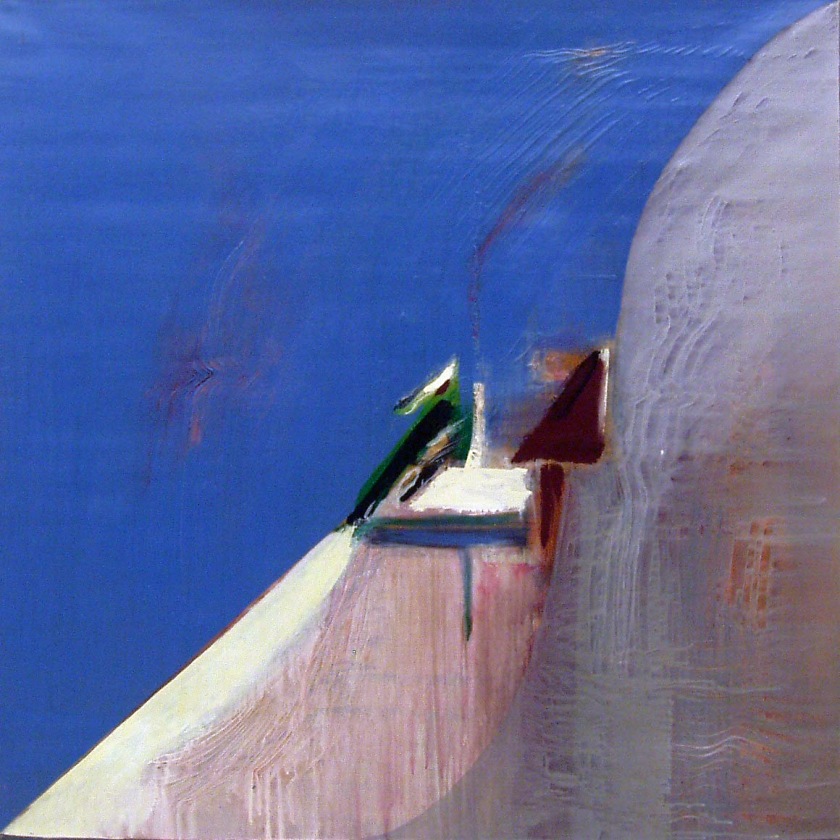
The tremendous violence of the later imagery is also what he chose to represent this work in exhibition abroad, and it is as if the surrendering of his youthful hero image is also a reaching for a new level of frankness and engagement, a complete denial of the high values he placed on his more academic work. This ‘outburst’ if one may call it that, lasted three years, and it is also as will be seen a little later, a cry against ‘fate’, towards which he feels innocent but which had doomed him to continue, perhaps serve a higher purpose of which he has not the remotest inkling.
His deepest desire is to go ‘home’, to find in life and work the harboring harmony which will allow him cross over the horizon to his ‘other’ life. The good death he seeks must also be a final release in his work. The theme of Oedipus also resonates in the sense of the loss of meaning which he experiences here, not what the so called subject matter of the painting is said to be, or even the reflexive interest in the way of painting itself, rather, there seems a loss of direction and value, a collapse of the early ‘heroic’ self which could sustain the isolation and austerity of his self-imposed vocation.
There had clearly been a movement towards color field, from which he resiled in the late 60’s, and he made the explicit disavowal that he could never go in the direction of Kenneth Noland. There was clearly in retrospect a feeling in Stout for the work of Arshile Gorky, or Matta. We can see that the color field had really come more into play during his Graduate School work in 66-68.
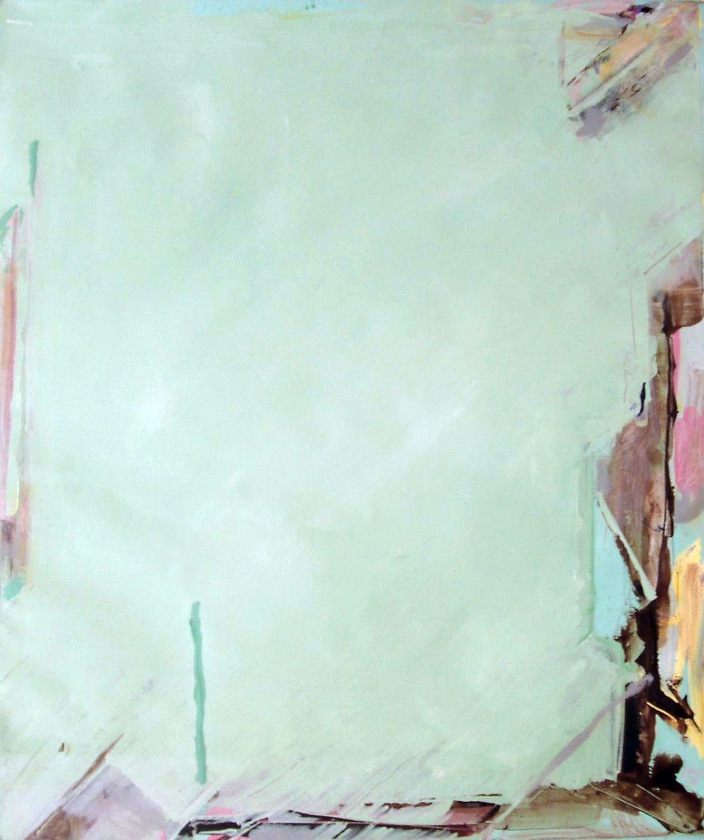
One can even associate it with the work, directly below, which he entitled Hamlet. The hesitation and doubt in the work is precisely how it refuses to become broad areas of color and monochrome. If the earlier Remembrance could be construed as canvases stacked against a wall, and even a direct response to Gorky, here the rectangle is balanced so precariously, and against sloping and dissolving shapes, that nothing holds the painting together except the play of light and dark, the Helldunkel, which his also the deeper relation of the colors themselves.

The landscape seems always to insist that it is there, it is what is at stake. The white upper register inevitably suggests sky and light. Stout was essentially set against Rothko, whose work he had first seen in 55, and who as an artists became a major source of discussion between Michael Tracy and Stout from the time of their meeting in 1966, when Stout was 32 years of age, and Tracy was about 24. Once there could have been a point of direct contact in their artistic aims, but Rothko had seen what the consequences of leaving the line away for painting, something which Stout was not prepared to abandon.
It could also be noted that the geometrical is also ‘natural’ for Stout. The range of domes and pyramids, the bands of color explored in many of the works of the sixties, celebrate both a freedom in respect of color, and also adds enormously to the complex weave of form and shapes which Stout has ruggedly developed over long years. One could trace it very roughly in the following terms, and see how much then the compositional is itself motival, and the subject of painting is also painting as its own subject, which is where the crisis of the 70’s leads, and the disturbance in the work, that release another wave of enormous creative novelty and energy from the early 80's, which seems then to flow uninterrupted to the present day.
Unfortunately the script of a lecture given by Stout from the season 68/69, entitled ‘Composition in Painting’, has not survived, if it ever existed. Given the pedagogical fluency of Stout it is entirely possible it was given without any notes. The talk was reported in a notice in the Houston Chronicle for 68, and took place on September 23rd .
The notion of a critical re-engagement with what his work had brought faced with the exigency of teaching and the heavy demands of students must have been an added strain in his life.
In one sense he sought refuge again, where he did not have to disclose himself, and where the upsurge of creativity, so celebrated in the images of the volcano pictures, and the burning heat of his Mexico inspired landscapes, needed a period of respite, a time of rest. Instead it led to even more fervent questioning, and a struggle that would go on for some years.
The paintings which had acted for him as supports and even indications of paths had in the past been the works with the titles Gibraltar, the painting Oedipus, and some which he had called passage. Indeed many are reminiscent of the tholos tombs of Greece, Malta, even the burial mounds in Ireland of Newgrange and Knowth.
The consciously made self that sustained his own image was dissolving in light of the demands of real life. If he had set out on a journey, there was no knowing where it would go, and the existential crisis which was definitely rooted in his period of returning to study and the greater involvement in teaching, and exposure to the academic life at the University, meant that he had effectively lost his bearing. Further there were no compensatory projective places for his shadow side. He was an esteemed public artist, with press interest in his home life, social meetings, and almost always favorable reviews of his work. He still won prizes, but remained for himself unsure, and hesitant.
The early compositions became in his understanding more abstract, and so the work about volcanoes’ was seen as abstract. It would not be until the death of his wife, that he would release the pent-up forces and energy which still lay within him and the direction of that work was full of loathing, hatred, nausea, and even physical savagery and violence.
Commenting on his work again from the 60’s his severe criticism places this work at a great distance from the early 80’s and thus makes of the main work in the 70’s a kind of buffer zone between a more lyrical and even pastoral concern and the wild expressionist cleavings of a whole new romantic and even aggressive imagery.
When that eruption is over, and has calmed down he returns again to a bright and sunny world, a world not populated with any forbidden presences, or something of the sinister melancholy that a critic like Mc Evilley would later detect, as a kind of presentiment, a foreboding in some of the earlier canvases.
Thomas van Nortwick the Professor of Classics at Oberlin College, has suggested in his book Oedipus The Meaning of A Masculine Life,(University of Oklahoma Press,1998) that Oedipus is the first tragic intellectual hero, part of a story that reveals and explores the darker aspects of his kind of heroism, ‘ the desire to control the world by imposing order through the structures of intellect’’.
The play of intellect which equates knowledge with power inevitably leads to self-aggrandizement and hubristic stances-with a concomitant loss of authenticity. Self-scrutiny, in this cases leads to an enemy, which turns out to be Oedipus himself.
Stout makes the same discovery. The move to the ‘drawings’ is a frank admission of his inability to withstand the whole gamut of sensations which he had enjoyed, and to which he had surrendered. It was as if this lacked the emboldening strength of the man of action, he had given way to passive knowledge, had left aside his own ferocious resolve, the ambition and competitiveness of youth. There was always a danger in luxuriating in color for its own sake, and yet not surrendering then to the completely inchoate and sensual demands that a color field without line or external referent would lead to. It is also a direct running up against the limits of what was available to him socially, and dealing with the real consequences a decade later of his living in Houston.
Oedipus in Nortwick’s reading is indeed ignorant of his real identity, but in the scene where he blinds himself he will assert agency and proclaim innocence of wrongdoing, but either way he still cannot face reality What good were eyes to me? Nothing I could see could bring me joy.. (1329-1335) He will judge and punish himself, and there may be no compensatory gain in insight, as is often attributed to blindness; he will address the situation in the austere, unrelenting voice of the traditional self-destructive hero who has transgressed and cannot, as Nortwick says, live with the shame invoked by his acts. There is no sense of hope, no way out.
The journey of the hero must then be to the underworld, and the gifts he will finally bestow on the community when he returns are as much those given by the gods as emanating from the way in which previously his own will and power were set into motion.
By becoming blind and vulnerable, a singular phase of re-birth is possible, the tragic hero must then be re-born, and even perhaps in the form which has already beckoned to him, in the play of Sophocles it is the figure of Tiresias.
The discovery that creation/destruction were equally available at this time, that the artist in his own mid-life as it is called, could see the divergent path, where human and inhuman could both be in the same person, was a shock and causes him to repudiate much of great beauty and love in his earlier work.
It is then that the strange apposition he made about the volcano drawings and his fear of water makes sense. He feared the sea, the flatness of water, the terrible mirror of the liquid.
The drawings of the volcano again were urges to stability. In the shift of the 70’s the massive parade of geometrical, large shapes, he is trying to anchor himself, find a base line from which to start out, the immersion in color has triggered his childhood fear of drowning. The guilty secrets and shameful acts he will not name are enmired in the unspoken, unclarified relations with his wife and children, and consequently with his own parents. The sense of having left home and ‘realism’ for art is a double betrayal, where the heroic quest has had to absorb the evil of the world, like Parsifal to reach his goal.
The struggle would go on and take turns that merely showed within the tragic situation of the artist, that in some way he could not know himself, and that this the deepest tragedy of all. Everything was given out; the riddle of the Sphinx was also a double one, not just the question which was to be answered, but the existence of the Sphinx itself.
The earliest compositional motifs are associated with the volcano, Gibraltar from 1957, by 58 the dominant move is to create a path moving into space and with the work Feast of 59, the space of the foreground and the high horizon sky becomes more compartmentalized.
With the Mexican inspired works, from around 61, the arc-en-ciel, the brown in the sky, or suggestion of a hemi-sphere allows the space to move into a floating world, take on the aspect of image and mirage, become more deeply illusionistic and colorful. Time after Time, is a work which turns the semi-sphere into a complete oval, a kind of baroque ovoid of space which becomes self enclosing and hermetic.
It is really only in 66 that the compositional lay out breaks with this enclosure, and pushes different shapes against a wall; it is not until the end of the 70’s that the composition reverses direction, and large looming eruption moves into the powerful doubling and figurations of the 80’s, works which Mansbach and Camfield both comment on, and which remain full of powerful energies, doubling of images, self-consuming, works which in their rapid execution and powerful frontality, show that the play which had gone on over such a long period on the central axis could be abandoned without any loss. He could swim even if the fates did not let him head finally to the shore.
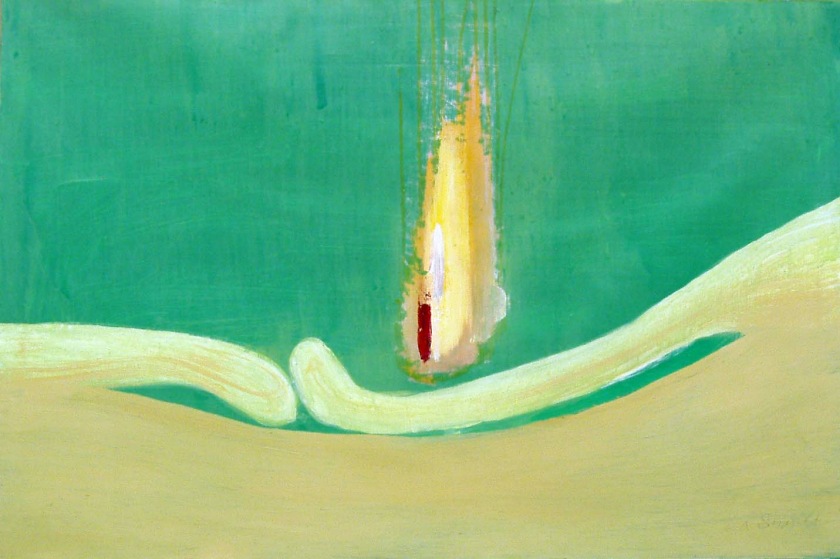
Looking at the work entitle Morocco we can take it that he has finally re-conciled the tensions of geometry and line and color, and set towards a different direction.
These works were the subject of lively review on their first showing, and it is interesting to see how critical response to Stout in the 70’s begins to intensify and generate richer reflections on his work.
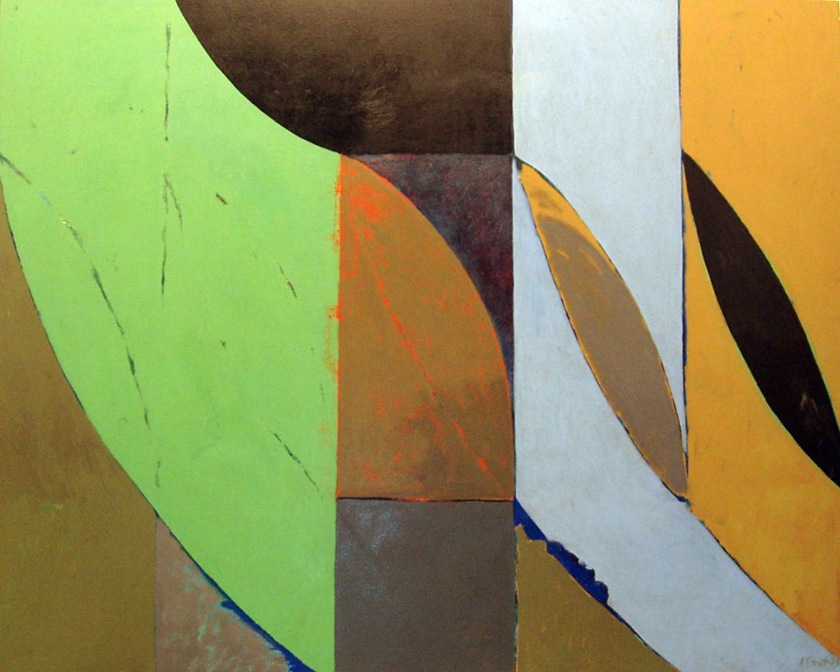
Anne Holmes in an article from 1971, which appeared in the Houston Chronicle, was probably the first to note the shift in Stout’s work in the early 70’s.
She referred to 26 pictures on display at the Meredith Long Houston Galleries, and noted they displayed three stylistic shifts, the ‘latter one’ being the more immediately appealing. She takes her cue from the publicity attaching to the Billboard of the Large Canvas series, and notes ‘Stout’s painting – so widely publicized in one of the billboards in …..the ‘Larger Canvas” eries of Houston National Bank – range from his ritualistic works suggestive of altar and chalice forms ( what one might call his “Parsifal’ series) to a middle group of geometric canvases, and a brand new series in which a webbing effect can be noted, a Pollock like veining, with slashes of yellow.” Her comments in December 1971 also indicated the force and dramatic power of the muted colors, referencing the red, dark gray and rich greens. The images of Stout were said to thrust dynamically forward.
The Houston Post ‘art writer’, Mimi Crossley picked up on the theme of the muted palette some 4 years later in an assessment of the then 40 year old Stout – which clearly incorporates a direct interview, and allows some re-construction of Stout at 40 and his view on where he was going, in her article ‘On being more of what we are’, which appeared in the Sunday edition of July 27, 1975. A Post photograph by Bill Thompson shows Stout in an easy chair, with sandals and a horizontal matelot short sleeved t-shirt, looking away from the photographer, and in his studio. It is a picture of relaxed and concentrated Stout, and gone are the ties and suits of earlier depictions.
The principal demand for painter in the current situation, he claimed, was that they needed to allow themselves the freedom to paint.
Crossley noted that the ‘wine dark abstract landscape paintings have established him (Stout) as one of the leading painters in the Southwest, with a score of important exhibitions whilst taking top honors this summer (i.e. 1975) at the second annual Houston Area exhibition (HAE). Stout shows nothing of the anguish which is seizing him in his work, as to its direction, value and meaning, and with the idiomatic raciness of a football coach encouraging the team, he is quoted as saying that the purpose of the
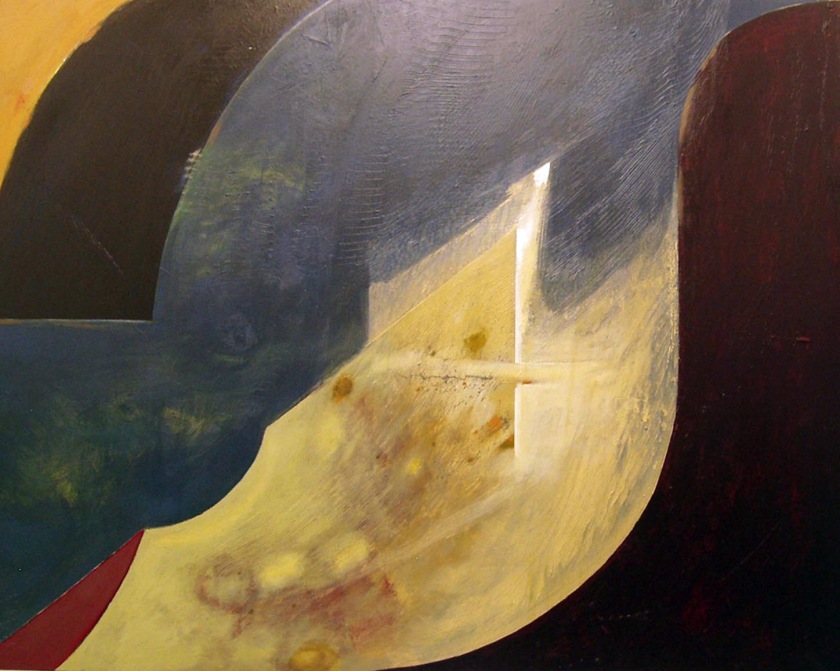
HAE in an are rapidly becoming a n painter’s centre was “to get everybody off their tails to paint, to prime the pump and have them show the best they can do”.
In the course of the interview one senses that Stout has made some kind of decision in the mid 70’s. Which is basically to soldier on. He adverts to the difficulties painters can face and notes” The dilemma all artists have is not an external one of deciding which movement to follow or the ‘crisis’ in where painting is going. It’s (sic) being able to be more of what we are in our own work…
Crossley then analyses the recent developments as they are termed: “Although he has moved in several directions over the years, Stout’s recent work has given him critical acclaim for the strongest painting he has accomplished, much of it echoing some of his painting in the 50’s. …….. The recent paintings are the pure, structural forms of landscape, without relevance to background color, horizon or contained shapes.
Each has the rich somber “Renaissance” colors known as the Stout trademark, with strong painterly interest in the brushwork.
Starting from strictly repeated forms Stout’s final result is a tight, flowing, completely shape filled canvas with variations and subtle plays on his original rhythms. He avoids details and ends with burnished, glowing primal forms.” tout also disclosed something of his working method to Crossley, indicating that he worked to achieve his forms on canvas through a series of paintings on top of each other, eliminating unessential details. He said that he wanted to keep himself free to return to an earlier series of contained shapes in his paintings, which he calls his ‘Odalesque”(sic) works, “ he said he is concerned about getting hung up on individual motifs or “expertly applied touches”.
Crossley quotes Stout, “I believe when you construct in black and white, it anticipates the exact color that follows and achieves very carefully balanced color… I work with structures over and over until I finally forget it and somehow the painting makes it… There is a large amount of magic in it, but I am distrustful of magic… Life is already surreal enough. Logic and clarity need to be brought to bear on what we do by knocking out the hard sense so long that it finally stands out by itself.” ne is reminded of the Dutch saying 'normal is gek genoeg', normality is crazy enough in itself, and the Calvinist insistence on rationality and work.
Stout has obviously braced his muscles, and taken a much more gung-ho approach than seen in any previous interview, the slightly blustering, and uncharacteristic machismo of his tone shows indeed the depth of the ‘crisis’ he was in.
Houston critics were alive to the direction of Stout’s interests, and indeed one published piece by Charlotte Moser reviewing a show of Stout’s at the Meredith Long Gallery was especially aware of his influences and contemporary associations.
Stout was seen as consciously aware of the traditions in art, and that:’ his flowing geometrical shapes fell into patterns with mechanical logic like Stella or Diller. Wide textured planes soar onto others like Diebenkorn or Zox. And pure color with bold value contrasts echo the best of Matissse.” oser also expressed some reservations after the glowing compliment of the comparison with Matisse, allowing that the greatest strength of Stout’s painting lay in a sense of ‘rightness’ whether triggered by historical familiarity or by the precision of the unfolding forms. While, she noted, the movement of squares transforming into rectangles, and then into curves ‘ flows with a steady rhythm, the same precision at times becomes too dictatorial, hardening the painting into too rigid a scheme” or Moser the best paintings were the ones most architectonic in composition and color.
Her commitment critically was still to the push-pull of the best abstraction; ‘ Slithers of color appear like shadows on stylized volumes, giving the flat canvas three-dimensional play. Contrasts between flat and textured paint equally sets up an abstract spatial push-pull” She concluded her notice by saying that Stout knows what he is after, ‘and his paintings reflect a cautious intelligence and sophistication However, in the very same period Stout was to receive a blistering review from Donna Tennant of the Houston Chronicle, it also stands as one of the most negative assessments made of the artists in his long productive years. Looking at the paintings in the Meredith Long Gallery on show, which had been also reviewed by Moser, she notes that if they are evidence for anything, they show that it has not been an easy year for the artist. They reveal the struggle of the artist to assimilate new forms into his favored format of the past few years, the lyrical landscape based abstraction. For Tennant the new paintings don’t work any better than the old ones. She notes the return of the horizon line, but finds that it does little more than separate awkwardly painted mountains and rivers from over simplistic bird and cloud forms.
Further the light seems to have gone out of many of the paintings, or ‘they are dull and drab things’.
Even when the dull palette is relieved by oranges and pinks etc. these colors have ‘a disturbing discordancy’.
The review become more strident and explicit, the experimental and disjointed work of the artist show a groping incertitude, in paintings that border on ‘the visually offensive’.
Some are seen as embarrassingly revealing in their blatant sexual allusions, and the casting around for meanings results in images that just constantly elude him:” the world he paints is not particularly inviting, either visually or intellectually” here are amoebic swirling shapes, and a ‘a phallic form arises from a broad expanse of desert landscape’, abruptly as the critic notes. There is a not so subtle take off of Rorschach tests, and in some mounting desperation she asks, “Does Stout need to expose each and every canvas he applies paint to?” n what in the politics of another country would be called an old fashioned hatchet job, Tennant continues with the assault, Stout is a busy man, he may be seduced by the ability to show into overwork, maybe he should have spent more time thinking about it before exposing himself to the public, maybe he has wandered into the box that abstract expressionists had wandered into like William de Kooning thirty years ago, and which they climbed out of; her final advice, Stout should either get down to work and so the same, or accept the possibility that his contributions to the art world lie in other areas> The break with the work of the preceding five years can be seen in the 1976 Mountains.
Here the compositional introduction of the crossed diagonals, release Stout literally from what was becoming, as Moser had noted a kind of dictatorial hardening into too rigid a scheme. It is also possible that Stout was prompted by the critical edge of commentary in 75 to make the move to leave behind these works. From a notice by Mimi Crossely again we know that Stout has been leading as he puts it ‘a double life’, winter in Houston and summer in Germany. The last years of the 70’s with his teaching, and home acting as a place for young artists to gather, hosted by Stout and his wife Anne. Crossely mentions the Hans Hoffmann show at the MFA, which brought her to a direct acknowledgment of the impact of this work for Stout, and this is really the first critical link made between the two. ‘Deeply influenced by the intensity and emotional impact of Hoffmann and the Abstract Expressionists, Stout’s own painting has concentrated on pared down gesture and luminous color.
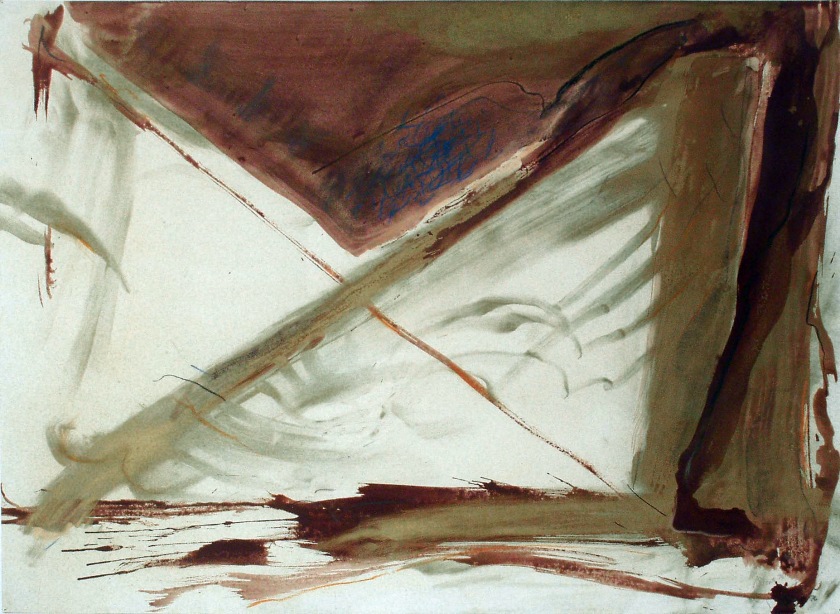
Crossley had noted in a 76 piece that one of the basic concerns of Stout’s work was the ‘why’ of abstract art, the exploration of the central force that makes an abstract painting coupled with the concern Stout’s exploration of the line and color as the distillation of an expressionistic response to nature. Whilst his work had gained in reputation for polished wine-dark abstractions, with a tight composition using a ‘torque’, a twisting form, as his structural device, it was the case that many of the paintings seemed to have a single ‘skin’ a kind of lacquered look, from which the eye could easily as it were glide off the surface.
The power of the thematic exploration in Stout was his ability to negotiate influences such as Surrealism and the Futurists, but that what he showed in 1976 was literally the peeling of the skin from his own work.
He was again prepared to show veils and layers of color, and allow dripping and washed effects. Several of the torque works as they can be called, with the twist in the composition, being slowly released from ledge lines, or frame from windows, are freer and move even towards rhythmic bio-morphic forms. With the material weight of the color used to add texture and increase volume and movement What can be seen in the mid 70’s is the way the paintings on a ‘window’ theme use structures looking like the abstract edges of buildings to rim a fluid totally abstract painting.
For Crossely this device forced a return to the center of a subtle interior.
For her this is a tour de force by the painter, and a kind of reverse visual psychology, in which the exterior scaffolding is dropped, and this allows the a paintings simply in layers of surface color that achieves a lyrical effect, which holds a balance between lateral and horizontal movement. Moser will comment on these works of 76 and despite her previous positive endorsement of Stout, moves to another view in a review she contributed in August 1977 for the Houston Chronicle. She takes exception to the design of the works ‘It is Stout‘s designs that deflate his plusses. Except for ‘Monument Valley” an open and exceptionally unpretentious painting, Stout’s other works blanket the vitality of the brush strokes and color with a wash of flat color in the dead center of the canvas that absolutely screams “ Art theory”.
Stout has called these “window frame’ paintings to me, they’re more like window shades, blocking from vision an unfettered ,sensuous delight in painting” .. (Houston Chronicle, August 6th 1977) She had found the work of 76 churning and confused imagery… And Crossly making the pertinent discovery in her round up of Art in the galleries, where she reviews Stout and Hofmann, showing 36 works on paper, which anticipated the Hofmann retrospective to by organized by the MFA Houston and the Hirschorn Museum in Washington, that Hofmann ‘ did ‘ as she puts it everybody else before they themselves did it. ‘ There are drip paintings done on paper before Jackson Pollock, and this show reveals Hofmann was using black paint was a negative and positive space before Pollock claimed it as his own. There is an exquisite green-washed work that pre-haunts Morris Louis. There are small works that are bright, Cubist grids and his famous ‘push-pull” abstractions”.
However with the showing of the Hofmann and almost simultaneously of Richard Stout in Houston, the critical view become more settled, Moser withdrawing her reservations, and seeing the work of Stout as ‘classical abstractionist”.
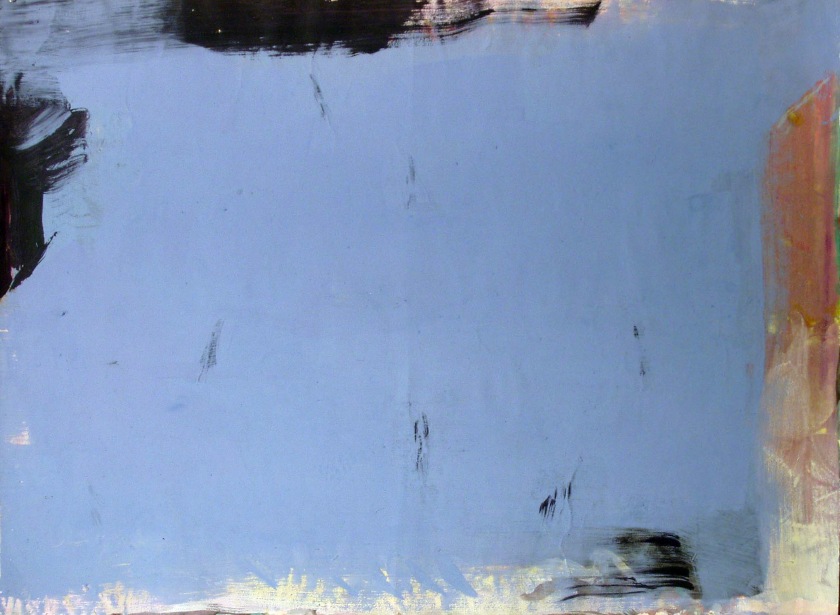
Whilst one can track though the year 76 the whole effort at freeing up the compositional strait jacket, it is really in the work Mountains 1976.
Once again it seems the echo of the motif of Gibraltar, the memory of Monte-Sainte Victoire calls the artist way from himself to a deeper encounter one that is outside of him, and in which his subjective doubts can for a while be allayed. By the following year he has turned again, largely under the influence of his European experiences, to a different work, making direct reference to place and subject, and returning from the architectonic to a more descriptive looser treatment.
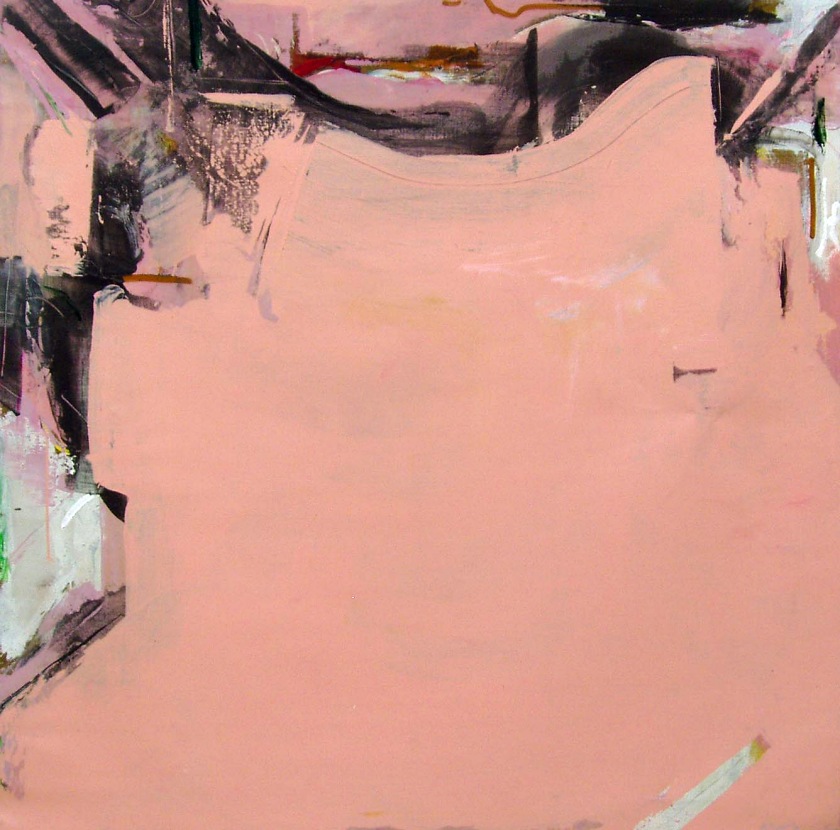
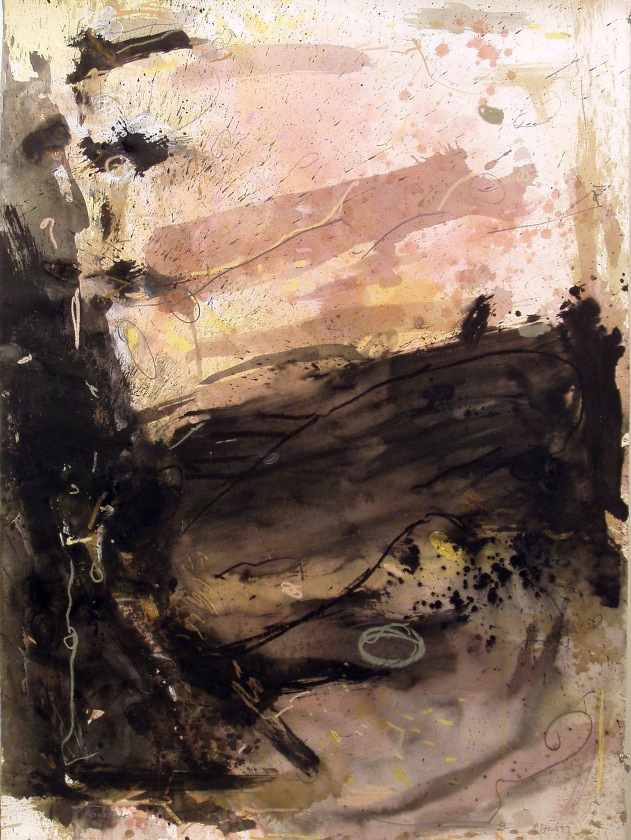
The work above, entitled Düsseldorf indicates the shift at this date.
Stout has allowed the liquidity of the paint more play. The linear element is absorbed in treads of calligraphic and undulating streaks of paint which move though the pictorial space, with the highly lit surface adding freshness and openness to works in the end of 1978, again one illustration must suffice to indicate this.
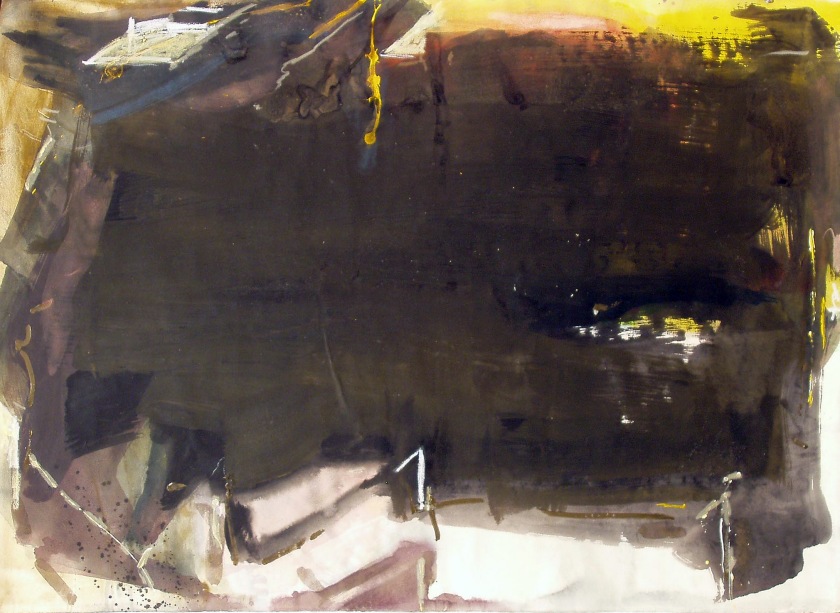
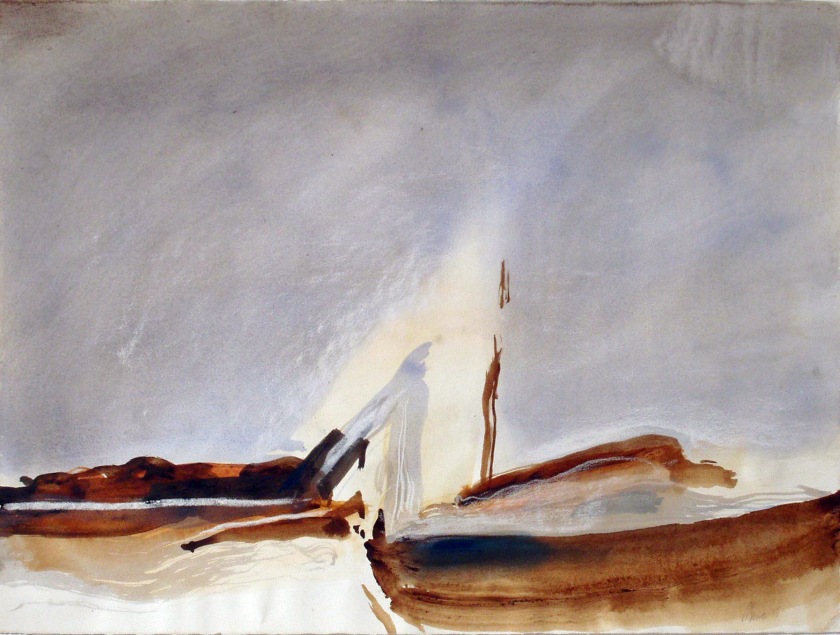
There is a suggestion of Derain, in the light simplicity of harbor scenes here, and in the work above, the play of shape is much more ambiguous and anamorphic; which also indicates the way the artist moves out from settled directions to explore new paths.
This as shown before often requires him to go back and reach into his own past, or, in this case, to explore in the medium of free and fast flowing acrylic effects which are normally executed in the rapidity of washes of water-color. The subtle grading of the brown, with inflections of dark blue, and the slight layering of the image, give it a more radiant and luminous appearance, without resort to the metallic powders of the beginning of the decade. Stout has become more ‘malerisch’, again allowing himself to experience the touch of the paper, and the fluidity of the paint to guide him in his work.
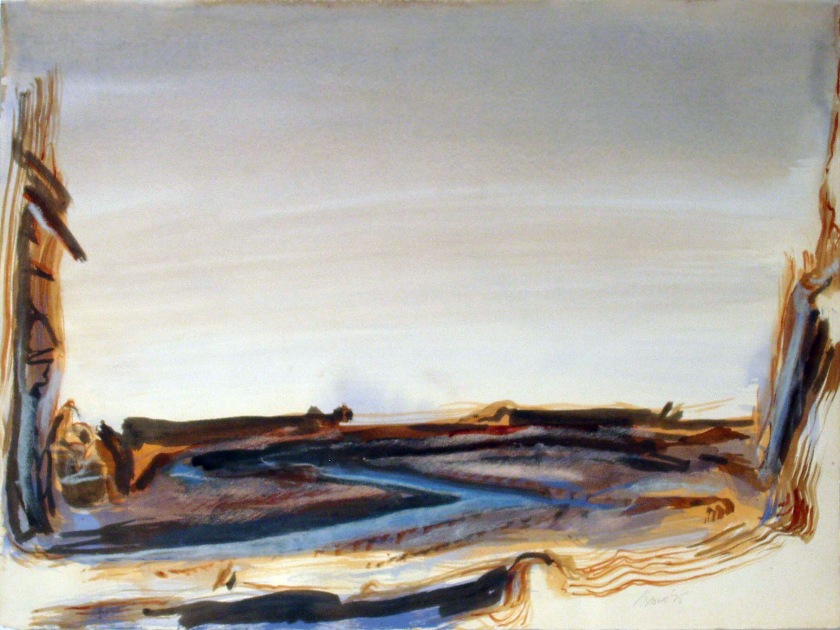
In a picture at the very end of the decade, Stout bids a kind of farewell to earlier concerns.
The painting contains within it citations of earlier pictures, and what could almost be seen as a parody of the work Remembrance – above –In a remarkable self-referential act he has painted a still life of his own miniaturized pictures, laid on a bed as it were of a sweeping passage of abstraction, pointing to the powerful paradox, that paintings are in paintings, and that art is always capable of being just about itself.
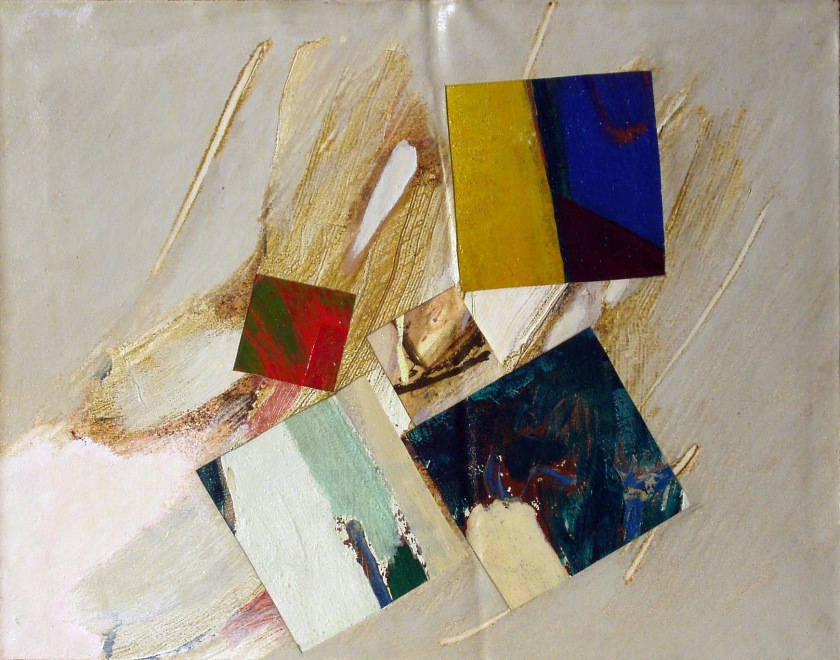
Within a year, he has braced himself to move into the most substantive and explosive shift since the mid-fifties and also the most unexpected. In some ways it is the most exciting decade of his entire oeuvre. There is a return to meaning, to intense allegory, to symbolic and fictional persona, human presence enters, the cool remoteness of the intellectually acute artists has apparently vanished. It is a period of singular astonishment in which the range of Stout’s talent and abilities explode in the most remarkable pictures. Perhaps the range and meaning of the sublime noted by Mansbach can also be more precisely interrogated.
One of the deepest fears of the artists, and Lyotard argues that Kant’s reading of Burke strips it of this central consideration, is the fear ‘that nothing will happen’. By the late 70’s even allowing for the distortions in the critical responses, Stout’s work was being placed in a kind of past, and within the burgeoning world of Houston art, he had had as much recognition as would be given. There could be no expectation of a major one man show at the leading Museum, as happened for artists in New York. The works represented by Meredith long sold, he had been able to go as far as Houston required.
It is clear that Stout has managed to deal with many formal problems in terms of his work, but there is also the sense of his arriving at an impasse.
Lyotard gives the following account of the sublime feeling; ‘ Here then is an account of the sublime feeling: a very big, very powerful object threatens to deprive the soul of an ‘it happens’, strikes it with ‘astonishment’, ( at lower intensities the soul is seized with admiration, veneration, respect) The soul is thus dumb, immobilized, as good as dead. Art, by distancing this menace, procures a pleasure of relief, of delight. Thanks to art the soul is returned to the agitated zone between life and death, and this agitation is its health and its life. For Burke the sublime was no longer a matter of elevation (the category by which Aristotle defined tragedy), but a matter of intensification.
Lyotard reads Burke and to a lesser degree Kant as having outlined a world of possibilities for artistic experiments in which the avant-gardes would later trace out their paths. Lyotard’s reading, as I have argued elsewhere, is closer to Bataille than Burke, arguing as he does that the arts whatever their material press forward by the aesthetic of the sublime in search of intense effects, can and must give up the imitation of models that are merely beautiful, ‘ and try out surprising, strange and shocking combinations”.
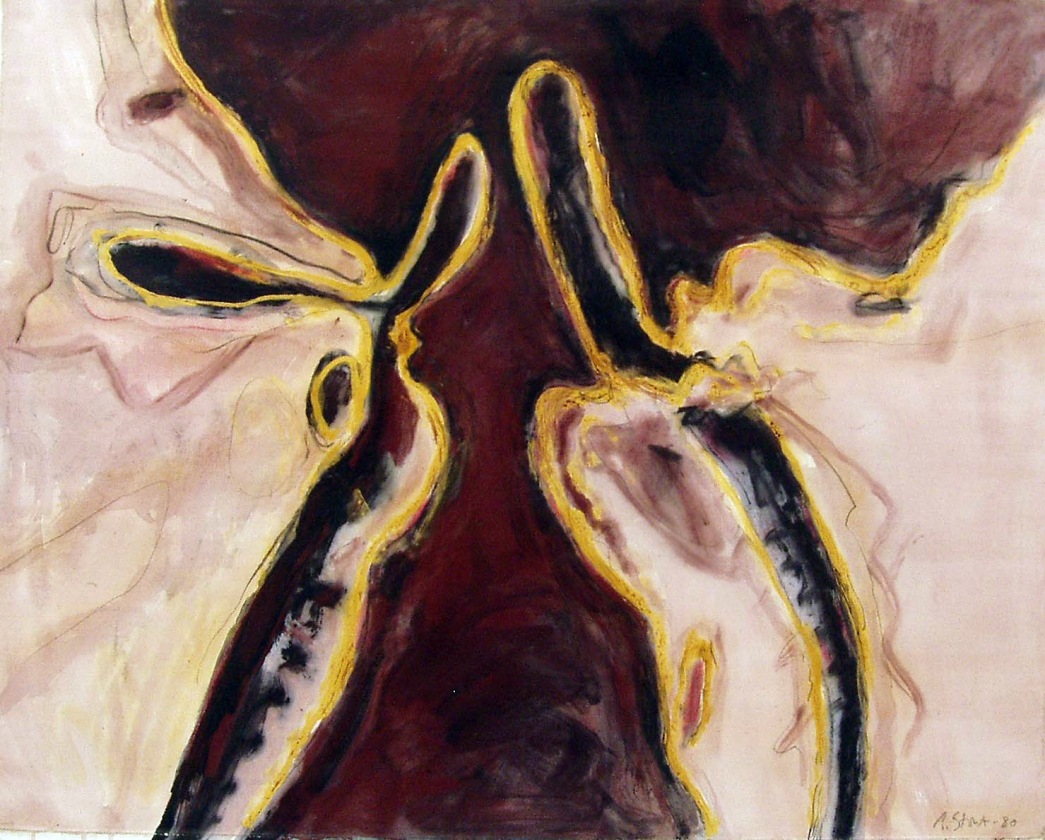
Shock is par excellence the evidence of something happening, rather than nothing, or suspended privation. Such intensities lead to ontological dislocation in Lyotard’s argument, since the artist no longer caught up in the imitation of models, the work of art has now to present a fact that there is an ‘ unrepresentable’.which is its necessary presenting of the indeterminate.. Lyotard’s reading is really closest to Part Two of Burke’s Essay. The passion caused by the great and sublime in nature, Burke maintains, is ‘astonishment’. He provides a definition; ‘astonishment is that state of the soul in which all its notions are suspended, and with some degree of horror. In this case the mind is so entirely filled with its object that it cannot entertain any other.
Astonishment is the effect of the sublime in the highest degree. ‘Burke, however, does not use the term ‘shock’; rather he prefers to use the word ‘terror’. Terror robs the mind of its power of acting and reasoning, “indeed terror is in all cases whatsoever, wither more openly or latently the ruling principle of the sublime’ (p.97) Burke in suggests that it is terror which is the common stock of everything that is sublime.
Taking then Mansbach’s interpretation one can track through this densely busy period a whole new range of work in Stout. The struggle between the sacred and the profane emerges in the work of Stout in a dramatic way. Somehow the concerns of Michael Tracy now also seem to become the concerns of his older friend. Stout moves in a direction that will literally defy the criticism of Moser and others from the late 70’s. It is as if he wants to stay one step ahead, and at the same time needs to return inwards to do so. Speaking to Elise LaRose in 1983 he disclosed again the significance of his reading of the The Chants of Maldoror and also of George Batialle, Death and Sensuality.
There is also the unexpected fact that Stout at the end of the 70’s had produced a series of etchings in response to his reading of the Lord of the Rings.
The work of Michael Tracy, the boon-companion of Stout in these years should also be briefly considered. Camfield had included Tracy as a kind of brilliant outsider, or at least had difficulty in placing him in the clusters which he had arranged for his showing of Houston artists in the exhibition of works on paper. This show returned to Houston in 85 during the exhibition Fresh Paint was still up, at the Museum of Fine Art, organized by curators Barbara Rose and Susie Kalil, which had 56 paintings by 44 Houston artists. The term Houston School was in vogue, although everyone disagreed with it, emphasizing rather the stark individualism of the contributors.
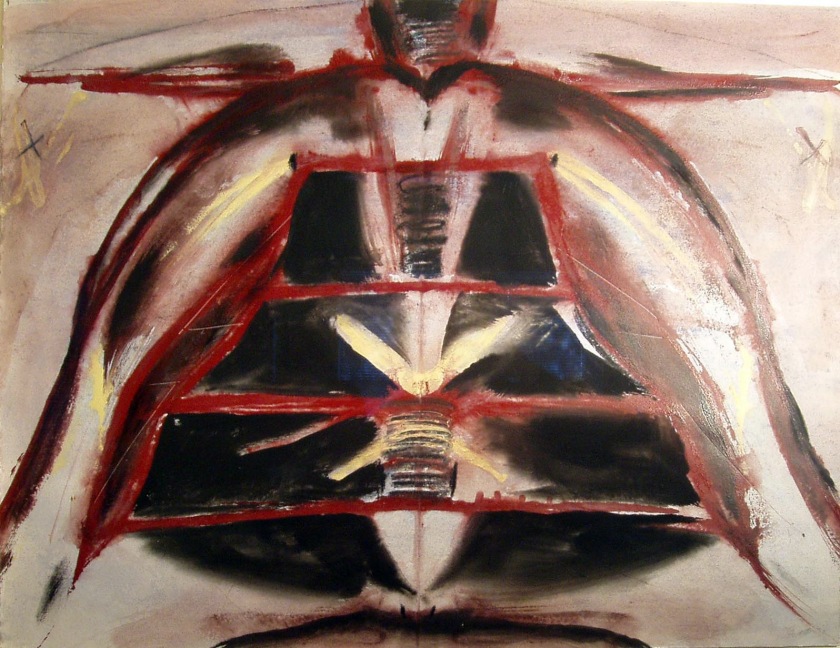
Reine Hauser who reviewed the show for Art News made the point that the strength of the work was often in drawing. He was also enthusiastic about Camfield’s selection, noting that Richard Stout’s searing sexual drawings are much harsher than his cool, composed painting.
The strength of his work on paper lies in the contrast between that harsh vision and absolute technical control, adding ‘these are powerful acrylic and pastel works by a master’.
It is Hauser who spots the similarity in Tracy, the disjunction or simple conflict between the technical and the harsh subject matter; Tracy’s religious iconography, mostly from a Catholic background, and liberal application of metallic powder created shimmering tableaux. He used reproductions of Sienese paintings and postcards, with their delicate coloring and ethereal suggestion, and alters them to work out personal obsessions.
Stout as we have seen took a similar manipulative approach to ancient works.
Hauser notes that the drawings are physically attractive ‘but the subject matter is at times frightening’, as in Rome, You Bastard Bruno, in which a naked male, his eyes covered with a black stripe, stands holding his penis.” amfield account written in 1982 overlaps with the same period in which Stout and Tracy one can say are closest in concerns and themes.
Tracy is concerned with art, sex and religion. Tracy had been brought up in an all-embracing catholic world, attending parish school in Lakewood Ohio, later college at St.
Edward’s University in Austin, where he studied English, philosophy and theology being taught by members of the Dominican Order. In 1967 he had returned to Austin for the MFA program at the University of Texas, where he met Stout.
Camfield suggest that the intimate, confessional nature of his work was well set by the end of his MFA, and could be seen in his work, Aphasic, an autobiographical illuminated manuscript.
His expressionist style, theatrical flair and fulsome social criticism, Camfield argued, could be fully seen in his designs for The Death and Trial of Pope Formocus, a play by Joseph Dispenza, dealing with papal violence, intrigue and murder during the 9th century.
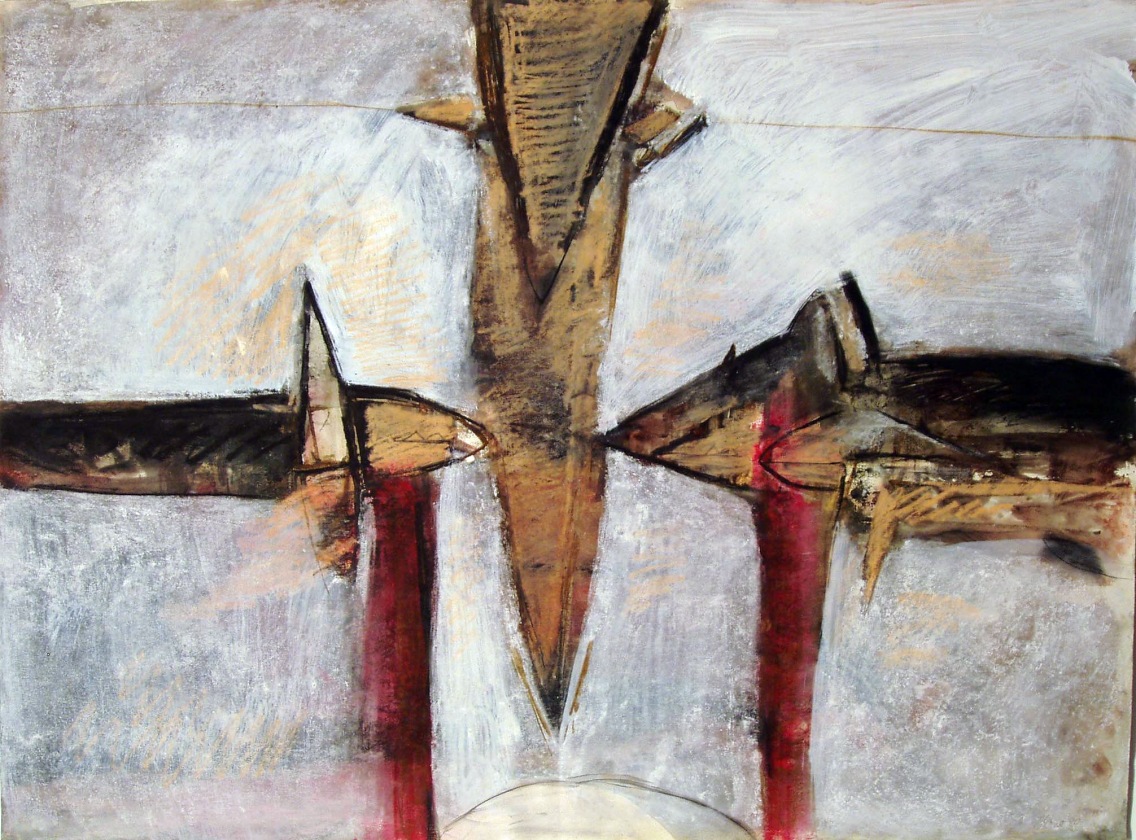
The shocking work to which Reine Hauser makes reference Rome, ‘You Bastard Bruno’… contains all the themes together, including a porno star, and Giordano Bruno, whose heretic doctrine some have thought was that he suggested that salvation was possible even for the Devil, and that Satan would be saved: for which he was condemned to be burnt at the stake-although the idea had solid Patristic warrant – (Origen) Bruno is placed between the Scala Reggia (at St. Peter’s) and a detail from the Michelangelo Last Judgment, with inscriptions running along ‘ no hope’ ..’no fear’.
Tracy, who was also reported as deeply admiring of Caravaggio, nevertheless was more than capable of assault and abuse towards the ‘icons’ of the past: covering the groin of a postcard reproduction of Michelangelo’s statue of the youthful David, with the inscription; “Hate David hate it hate it. Hate David”.
Tracy was not just engaged in bawdy desecration, the erotic energy of excess, sacrifice and transgression -so much a part of the libidinal economy in the metaphors of Georges Bataille, -suggests an overt and deeply preoccupied sensualist, in which the energy of toxic demons, and the sexual excitement of blasphemy, associated with revolt, is taken as a source of aggressive energy.
The repression of sexuality in Catholic discipline, is a place for outrage and protest by Tracy, and his work palpitates with a intelligent, bruising mockery and anger: at the same time feeling hopelessly caught in the compelling and powerful seduction of the world of images harnessed by an expert and fierce religious Imperium, towards which futile and abject gestures convey a complex sado-masochistic strategy of self-denigration seen in the sabotage of his own work, which he ritually sacrificed and burnt.
The earliest reports on this are from the mid-70’s.
Stout can point back to the 50’s and his concern with Maldoror, however it must be the case that the work of Tracy has direct impact, and through the early 80’s although from very different religious and social backgrounds, their work and concerns are almost synchronic.
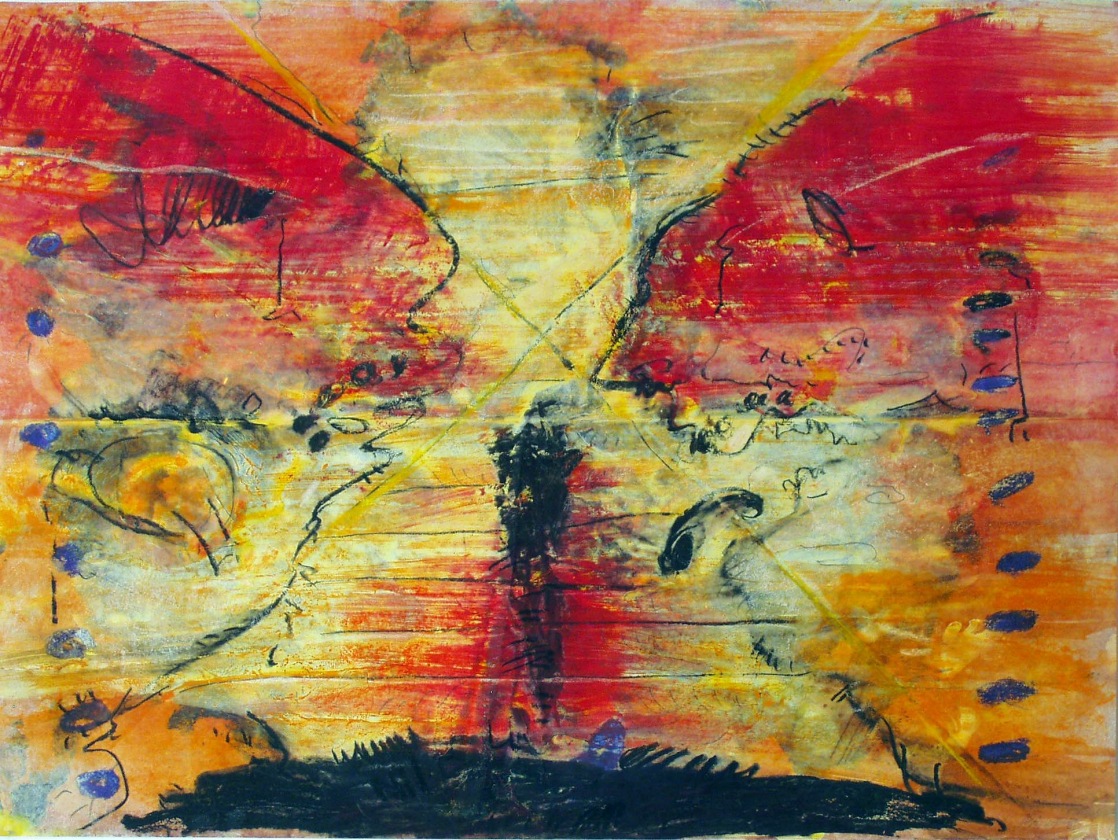
Nevertheless the profound shift in direction for Stout is most clearly to do with his experience of the suffering and pain of his partner and wife, whose death he would continue to grieve over long years, and even in the 90’s would sit in chairs in his house making paintings of the interior from positions she sat in, in order to remember her and keep her present.
In The Birth of Tragedy, Nietzsche pointed to the Oedipus myth, and noted that the Dionysiac wisdom is that the man, who solves the riddle of nature, must also transgress the sacred codes of nature. The primal myth of the Fall and the story of Prometheus are sibling for Nietzsche. The tragic heroes are all masks of the God, and in the figure of Prometheus from Aeschylus, one sees how the formula is stark and clear, and expresses the two-faced nature of being: all that exists is just and unjust, and equally justified in both. The theft of fire was also a plundering of divine nature, and so the first philosophical problem created a painful and insoluble contradiction between man and gods, and placed it like a boulder at the gate of every culture. Thus Prometheus shows that the highest achievement of man is won through sacrilege, and the contradiction at the heart of the world is that there is a confusion of different worlds; the human, the divine. What is tragic is that both worlds are right, but are still ‘individual’ along side each other… Prometheus wants to escape individuation to overcome the alienation of these worlds and thus he commits sacrilege and suffers.
Nietzsche as philosopher/artists made an assessment of what he had sought in his Birth of Tragedy, about 16 years after the publication of the work, and explained what he meant by the justification of the world as an aesthetic phenomenon, setting against his doctrine of the aesthetic justification and interpretation of the world, Christian doctrine.
He finds that Christian doctrine is only moral and seeks only to be moral… it is the embodiment of disgust and antipathy for life disguised as the belief in the other, better life. It exhibits a hatred of the world and condemns the emotions, it, Christianity, fear beauty and sensuality. It invents, Christianity, a transcendental world in order to slander this world, it yearns for non-existence. The Dionysian is a fundamentally opposite doctrine with a different valuation of life. The Dionysian involves losing one’s way in the cognitive world of appearance – in a way it is also set against the beautiful illusion of the dream world which is the beautiful, the domain of Apollo.
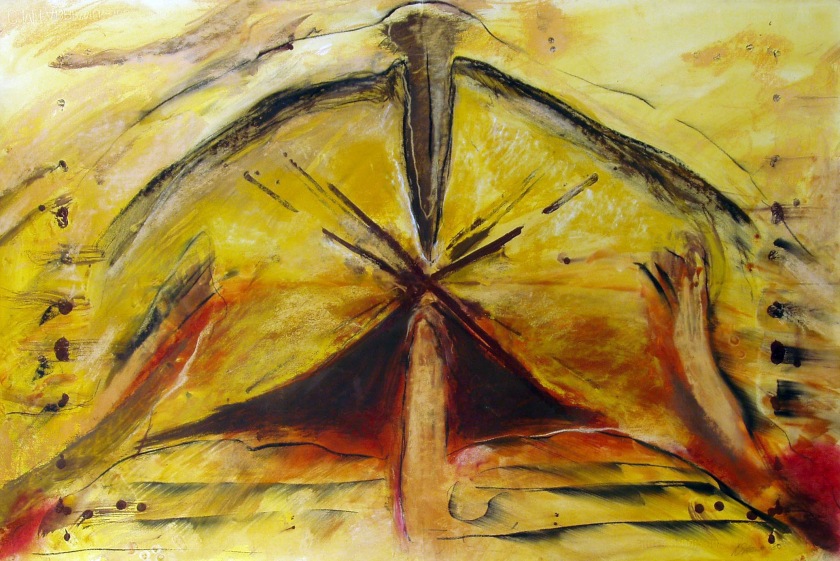
It is even the image of the God Apollo that prevents the beautiful world, the dream world, becoming pathological; where the sense of illusion is lost. In the Dionysian however there is the experience of dread, which at the same time is the experience of a blissful ecstasy. This account of Nietzsche is not distant from the ‘delightful’ horror of the sublime in Burke, except that in Nietzsche subjectivity is increasingly expelled by the intensification of the Dionysian. It is overwhelm, and the world of illusion is gone along with the sense of the self, there is a mysterious primal oneness and sense of community in which nature and man is reconciled, and the human being becomes a world of art in the revelation of such primordial oneness.
In this account of the ecstasy of oneness, Nietzsche shows that even as the artist sinks down, lonely from excess and transgression, and even drunken mystical self negation, he comes to sense the unity in the core of the world in a symbolic dream image.
Dionysus was ‘the foreign God’ that came and had to be dealt with by the settled Apollo religion; the drama for Nietzsche is how this was effected, and his major pint that the in the dithyramb the symbolic faculties were roused to their maximum tendencies, and there was a destruction of the veil of illusion, and pain is experienced as a joy and in the very moment of jubilation there is a scream of horror, or a keening for something lost.
How the Dionysian-Apollonian come together reveals to Nietzsche a stunning inversion of artistic being, namely that the origin of art is not in the ‘subject that exercises will’, but we, are ourselves images and artistic projections, and that our highest dignity lies in the meaning of works of art. This is why it is only as an aesthetic phenomenon that meaning and existence are eternally justified. There is an endless longing for illusion, and a desire for redemption by illusion.
The metaphysical consolation is that life is at bottom fundamentally powerful and joyful.
Art is a healing enchantress where there is a supreme menace to the will.
Thoughts of repulsion towards the absurdity and horror of existence are turned into the sublime, the taming of horror through art and comedy: the artistic release from the horror of the absurd.
Looked at in terms of his artistic exposure the 80’s remains a highly productive social time for Stout. He has a busy time as a Trustee of the Museum of Fine Arts, dealing with an exhibition in 1980 of ‘Te Legends and Symbols of Christmas”, in the same year exhibiting work with Meredith Long, which will cease to be his gallery by mid-decade, and Jurgen Schweinbraden in Berlin, and the Gallerie Thommen in Switzerland.
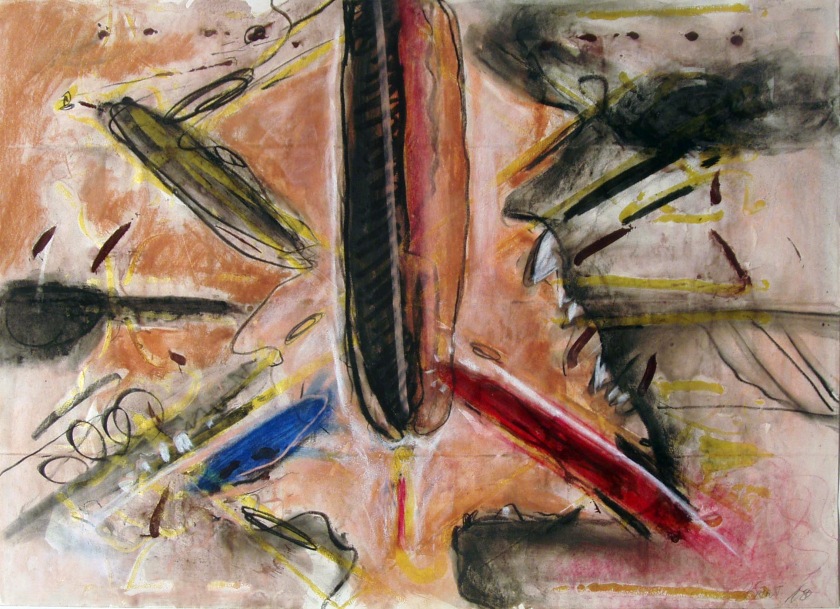
On the home front he also exhibits at the university of Houston, and further afield again in the group show Eros, with Julius Hummel Kunshandlung, Vienna.
One of the earliest notices of what was taking place in Stout’s work, apart from the remarkable lecture of Mansbach, was by Roger Green, reporting for the Picayune Times in 1983, who noted that: “ paintings by Stout, picture crudely rendered human figures whose anatomical distortion and smeared intentionally ugly execution recall the work of the contemporary British painter Francis Bacon. Stout’s style of painting may indeed have inspired Schnabel (Although the examples on view are quite recent) is in many ways echoed by other coarse, primitive looking paintings on view”.
Julian Schnabel had been a student of Stout, one of his most famous.
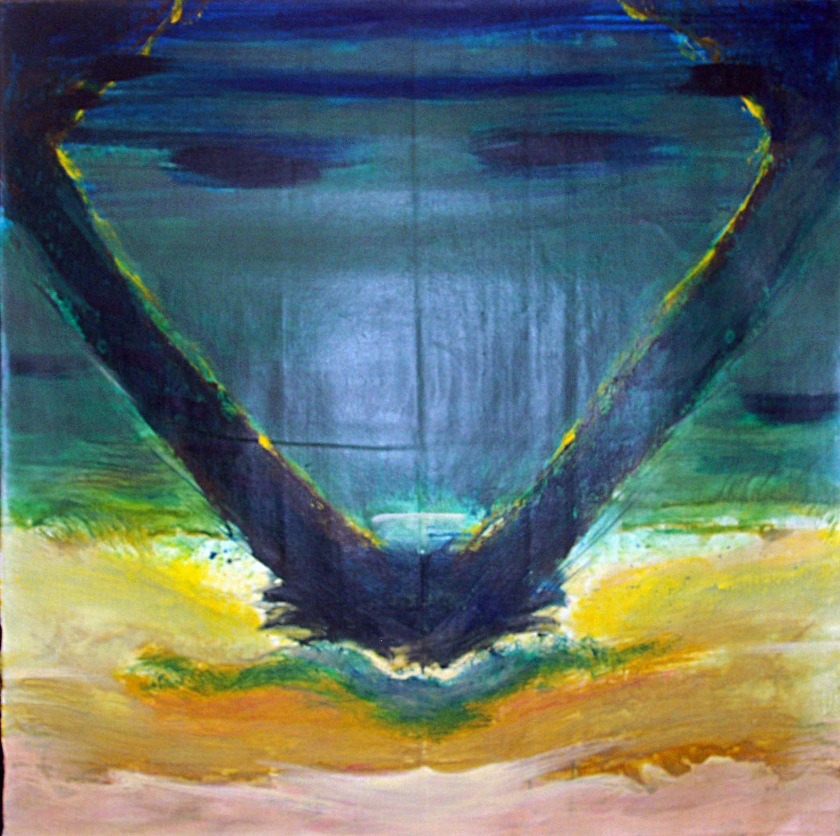
The work Paradise Dream of the year 1983, is a work where the breathtaking explosion of the previous 3 years comes to a halt in the ‘dream-illusion’ of the Apollonian.
The early 1980’s brought a series of works which read like a handbooks of the deadly sins of medieval theology, there are works called Rage, Gossip, Lust, Succubus, Hate, with bow shaped forms and grotesque images in abundance, much of this is also directly provoked by his experience of Berlin. It was eruption and coruscating blasphemy and in some way the gulity of the transgression was experiences as a secret perverse joy, breakdown and breakthrough, raw emotions eventually won, and the spewing of work was a kind of emotional relief for decades of restraint and fastidious self-control. He restabilised himself and turns towards the work of Juan Gris and others, and by the end of the decade is creating still-life works made of collage imagery, and restoring his own tranquility after some years of 'wild' life.
The full scale of the work at this date is extraordinary, with dozens of painting every month.
One can of course point to the sense again of a precise reprise in the work of Stout, so that as can be seen in the years 55-7, so again in 80-83, there are the same absorptions by dramatic, symbolic themes, and landscape. What can be seen is that there is a frenzied production in Berlin, which has the energy of Ensor, and Rouault, in its color and directness in which a screaming and howling vehemence, the torture, and
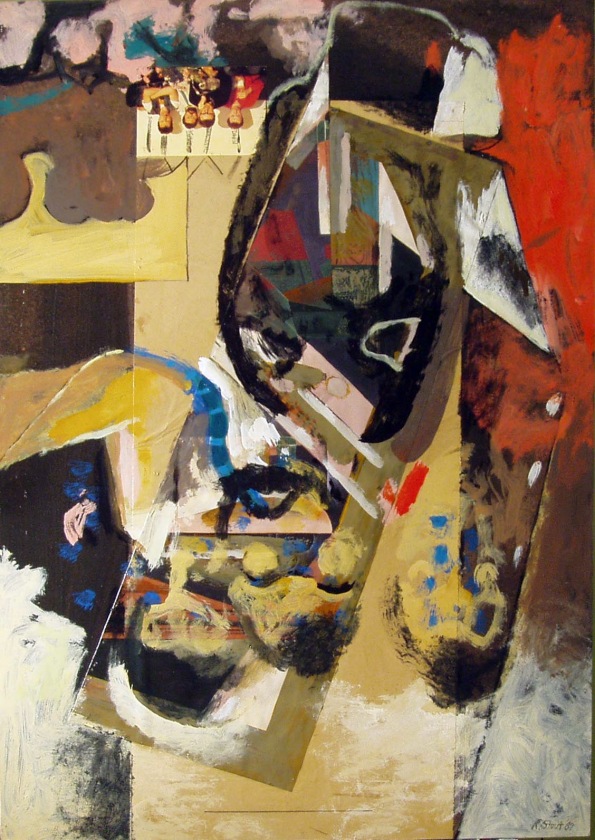
In the work Destruction of 1980 – the key component to this creative outpouring is indeed the relation of creation to destruction. Stout is destroying his own image, and moving into unmediated territory of raw expression, and yet somehow there is still in the background of the picture with the overwhelming double of the shapes which seem like bird heads or blaspheming tongues, across the horizon indicating what looks like carefully composed steps. And the light indicated could also suggest water over stairs.
Whilst the work at this period is very direct, it also still holds Stout’s ambiguity and mysterious reserve in place. The immense outpouring of this early 1980’s is startling Rage, 1982. and so fully developed, that one thinks the reference to Maldoror from the 50’s has been literally lying in waiting, attending on a traumatic experience and event, to unleash its full fury. There is a kind of vengeance and gall in the images that spews at times demonic frenzy and direct unadulterated hatred. The amalgam of religious suggestion and personal even social enervation culminates in a short and intense creation of powerful expressionist images which remain as a kind of strange space in the work of the painter. They are the storm that had been gathering. They place him, as will be indicated later, in the ranks of his best European contemporaries. The work below, Rage, expresses something of the intensity of his feelings at this time.
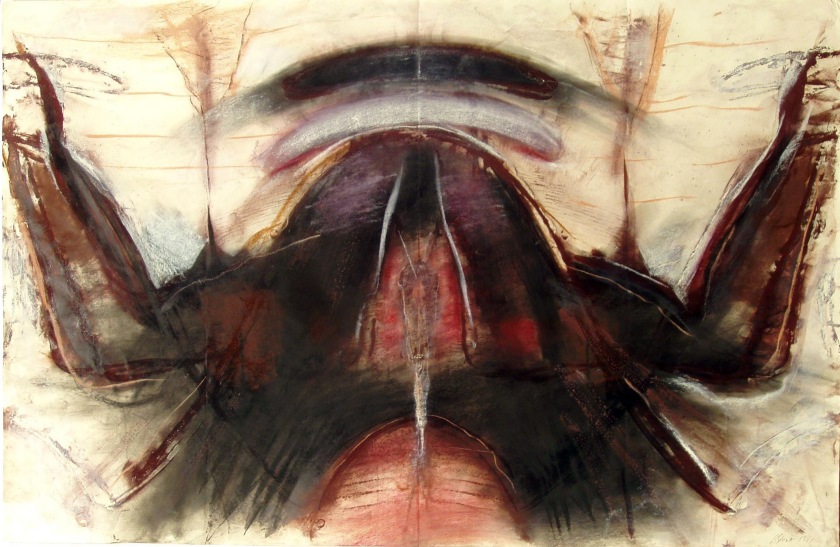
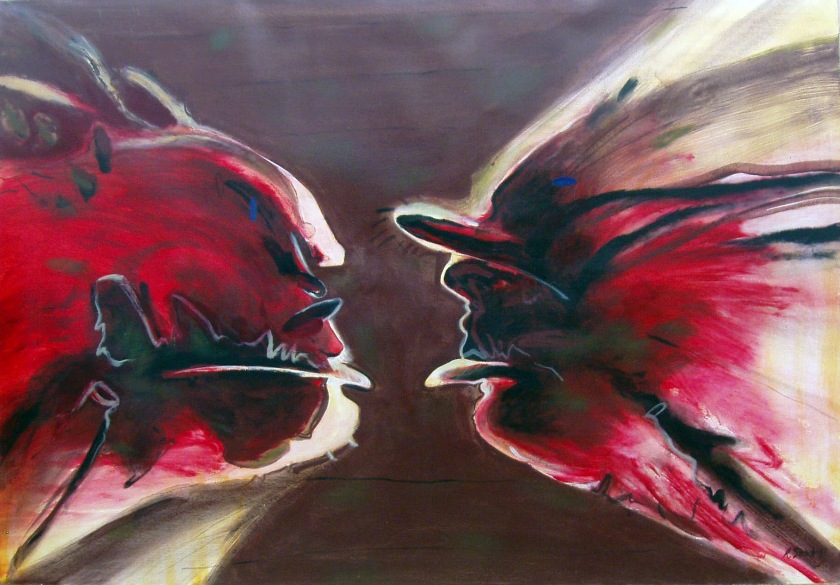
The Fate of Knowledge,(above) is suggestive of the deepest layers of Stout’s crisis, where indeed he has to reach deep into this own past and with a figure whose supplicating gaze and inverted anatomical crouch, with the profiling and reverse direction of the foot, saturated in burgundy reds and almost given a disguised skin of pale lilac and lavender and light blue, pleading with a long upright figure whose stance and shape show reference to Cameroon figures in the work of Kirchner, early expressionist theme, the long distended limbs and the indifference of the erect figure, suggest what can be seen in all the doubling and pairing of the period: a suggestion of linkage and separation, of supplication and rejection, of deep psychological ambiguity.
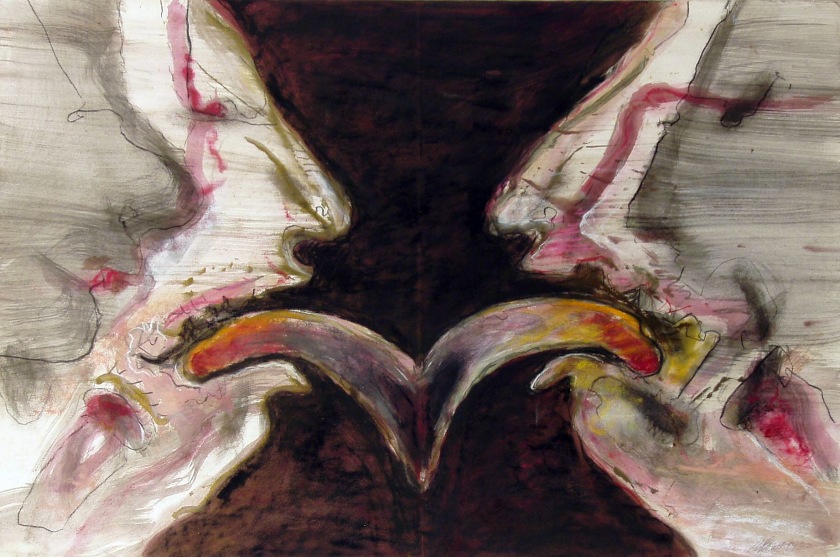

A key document to consider in this period is The Gulf Stream of 84. It is directly related to torso studies of the date, and the work entitled Grief.
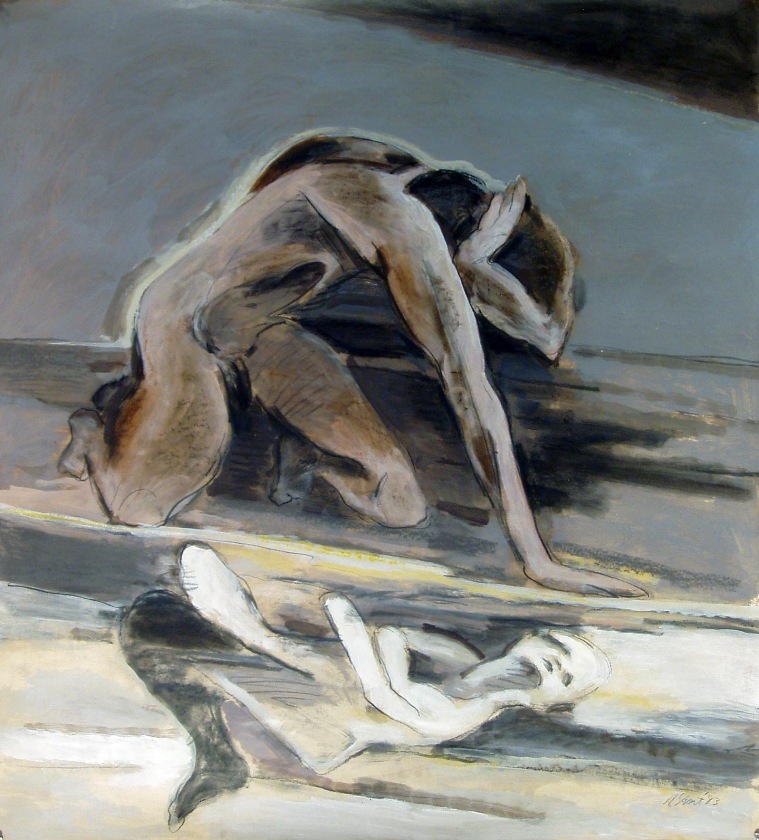
Where there is a magnificent expression of visual ambiguity in that viewed from a certain distance the rib cage could seem within the pose shown as a hand clasping the torso.
This is a complete figure, and the volumetric treatment of the head, and the almost deflationary interpretation of Rodin heroic young soldier pose – also echoes the Thinker of popular imagination.
The crouched posture and the reverse direction of the leg pushing deep into the picture space as if clambering against the box of blue and black, or the swirling movement of the rectangles, beginning to interfere in the cubic rotations that begins at the opposite knee, makes the torsion and tension of this pose so vivid.
Even the flesh tones are moving to peach and salmon pink, but kept, thanks to the long streak of titanium white moving across horizontally, to a generally illuminated form.
One detects a scenographic illusion; the banana leafed shape at the lower left corner gives the clue; this figure is somehow on a boat at sea, the raft of the Medusa is present, and it shows one of Stout’s most compelling even claustrophobic images of the early 80’s.
One small detail which indicates the enormous composition cunning of the painter, and the way in which he deploys his play of shape and color, is the way the treatment of the head is used to pull in the horizon line, which is then picked up, again, on the shoulder: all the horizontals in the picture become limits for other forms and start to create depth, upon depth in varied places in the picture. After considerable attention one can see the figure crouched in the boat, the spume of the sea about to tilt over the side of the raft/barque, and the enclosing balance created by the simple treatment of the lower area color which moves between a dark blue, edged with black, and violet purple richness, a compression of the darkening sea color which adds to the struggle of the isolated figure, naked and exposed.
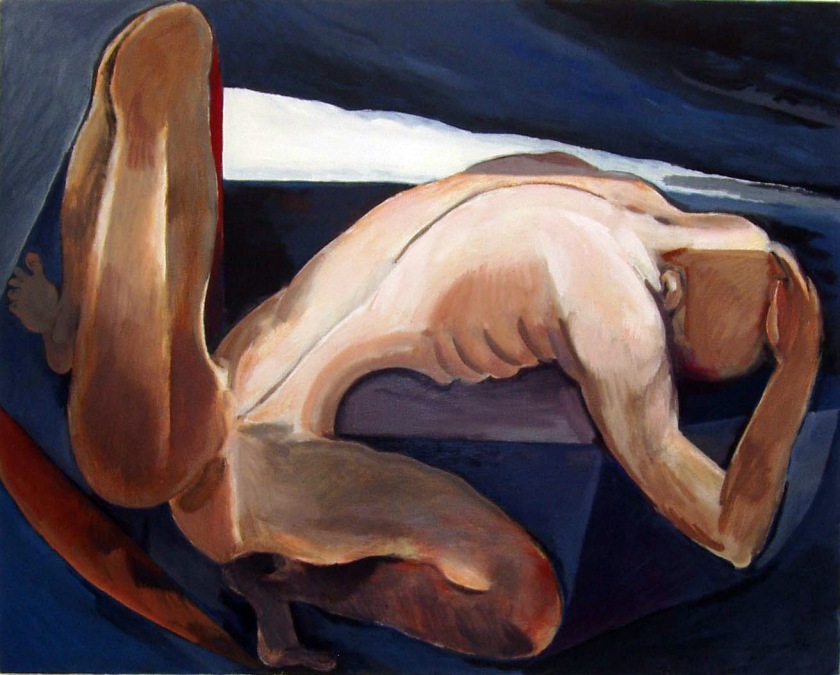
In the figure of Janus the study of expressive figurative form is also displayed, and was the subject of a perceptive remark by Michael Berryhill, at this date.
One can see at the right of this picture immediately the bio-morphic forms that Arp had made into a major study in his work. . The picture is dated at 84, and is another key document in that the figurative, landscape and the architectural are joined in what is also a strangely concocted, surreal illusion of a screen which is a picture or a window, again immense clarity and ambiguity in the picture.
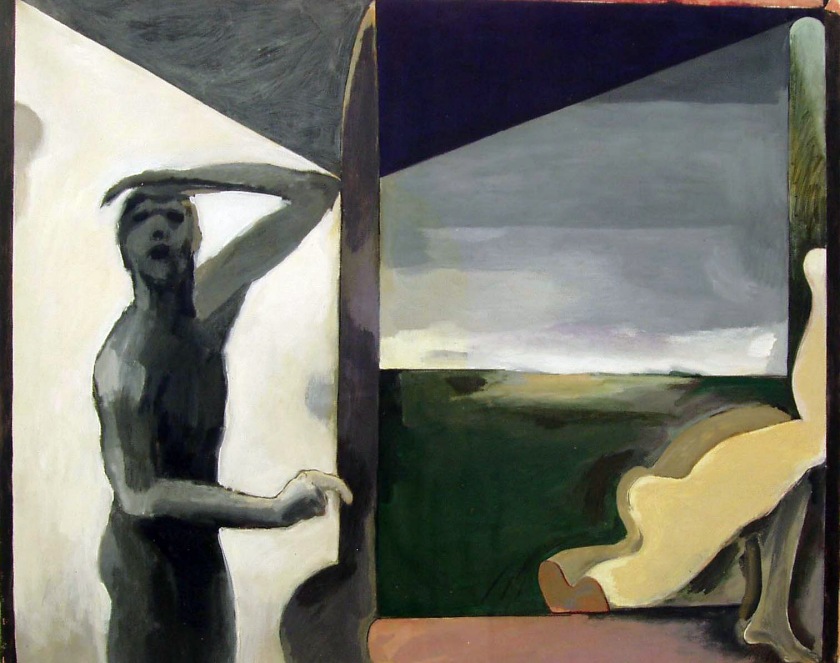
Janus is the title of the picture and is a definite clue to its reading, Berryman provided one such interpretation of this study in expressive form, seeing the picture as featuring a nude, really what he calls ‘ the shadow of a nude’. ‘With one hand he looks forward towards life, and with the other he gestures backwards towards death. His portal is a knife like phallus that borders a landscape. Beneath the landscape is a fragment of an ancient Greek statue, its legs in impossible disarray….the colors are grey, green and blue, and the effect is classical, serene formal. The color palette leaves the hot reds and oranges of the earlier emblematic and allegorical works, and restores for Stout a unity through the melding of a figurative ambivalence, the bi-frons of Janus, and his own situation as an artist, looking backwards and forwards. He had at the beginning of the 80’s made a reprise of some works from the 50’s and indeed Stout often observes the ‘reculer pour mieux sauter’ of the old French proverb, which in this context we might render as reversing to leap forward. The highly lit small rectangle of the fields against the horizon line, we have seen from the early 70’s, and the torso and figure obviously echo work from 56.
By one of those curious co-incidences, or, maybe it would be better to say ‘fate, the image of Janus was chosen by Christos M.Joachimides in his article for the exhibition Zeitgeist, as the international Art Exhibition of Berlin 1982. to express the passionate debate running through the art world at the beginning of the 80’s, ‘ Many people think that they have a double-faced Janus before them, confused, disoriented, bereft of the familiar order, they are frightened by a turbulent change which has broken through every barrier of aesthetic decorum” Joachimedes suggests in his essay that most of post-war art was about creative recurrences, what today would be called cover versions or retro-and reactions to the art of the earlier part of the century, saying that there had been little innovation, a rare event in any case in the arts. Joachimedes in referring to the show which included forty five artists said that there was in the concept Zeitgeist a metaphor for the profound change in the visual arts that was being experienced ‘today’. People are looking for an immediate, sensual relation to works of art, Subjectivity, the Visionary, Myth, Suffering, and Grace have all been re-habilitated.”
Robert Rosenblum whose work on transformations in late 18th century art, was a template in academic research, took the view that the new generation of artists were in open revolt against the ‘ spare, cerebral, abstract styles that dominated the 70’s”, and that ‘ everywhere, a sense of liberating eruption can be felt, as if a turbulent world of myths, of memory, of molten ragged shapes and hues had been released from the repressive restraints of the intellect which reigned over the most potent art of the last decade’ (p.11) Rosenblum noted that visual culture high and low was mixed in this exhilarating medley of iconographic mix, fueled by the glut of published information and visual access.
Artists were grasping at imaginative relief, from earlier restriction, and it gave rise to a wind swept, chaotic and bizarre profusion, in which the myth of art itself was part of the expansion to the mythological. Curiously one can say that these tendencies taken as exemplary for the most advanced avant-garde in Europe had been very much at work in Texas.
For Stout there was an obvious affinity with Baselitz, and his more remote influence in the work of Nolde, Kirchner, Schmidt-Rotluff, Pechstein. There is raw color, angular hatchings,and a sultry evocative atmosphere.
Stout could easily be linked directly to works by Clemente, especially his Two Lovers of 1982, Cucchi, for example his Lo Zingaro (The Gypsy of 1982) Baselitz, and even to Siegfried Anzinger, who uses the double motif in his Todesengel of 1982. In the exhibition one can see the impact on Rainer Fetting of El Greco, and there is a remarkable overlap with a work of Stout from the 70’s, namely the Am Strand, of 1982 by Dieter Hacker. Or again Bernard Koberling, studies of Volcanic landscape areas from 1982, or his work Spannenweiten 111.The single standing isolated male nude figure is also a feature of Markus Lupertz’s work for this date.
Schnabel’s Untitled for Alan Moss, was exhibited in the Zeitgeist show.(p.228) Stout will amplify his own search again and introduce a theme which has not been of direct reference since the early 50’s namely the threshold, it is almost a premonitory work, and the pointing forward even supplicating gesture of this work had a consequence that was to be seen in the massive change again at the very end of the decade: his return to the intimate world of interiors which then exploded out into sublime and mysterious works of vast clarity, space and suggestion.
Patricia Johnson, who as gallerist and critic was becoming a powerful voice in the Houston art world, and who also worked as a journalist for the Houston Chronicle, took the work from 1984 as a ‘stunning revelation of a mystical self”.
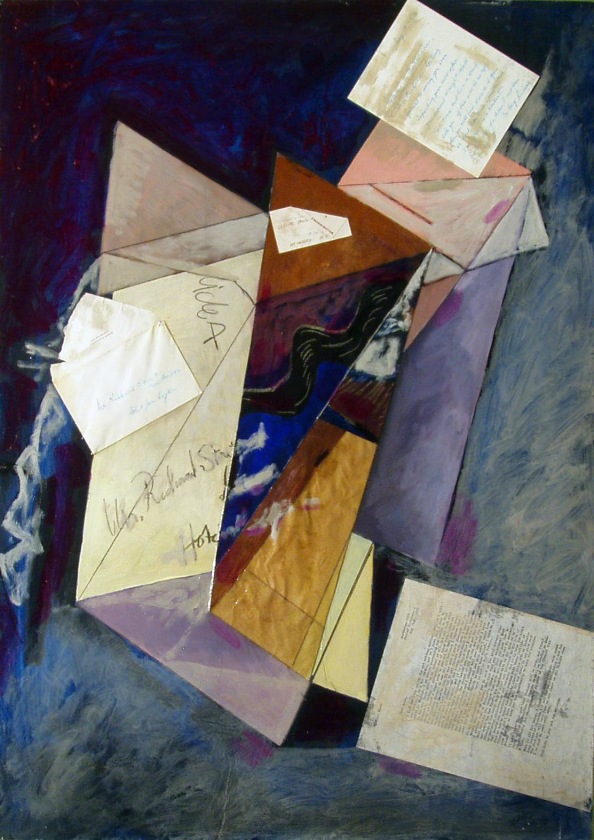
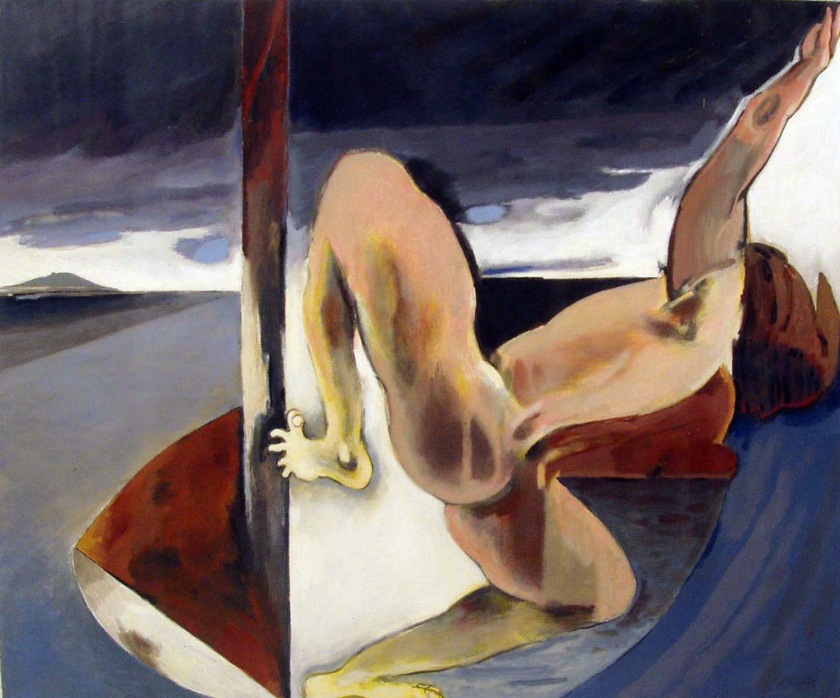
With what almost seems in retrospect a strange symmetry, by the mid decade, as had happened in all preceding one’s there is an anchor picture which indeed functions as a Janus moment, further the explosive figuration and doubling motifs of the first half of the 80’s moves in the second part to still life studies, and landscapes again, but in the main still-life’s, and much of them could be seen as direct homage to Manet and Cezanne as the decade come to the close he is painting almost naïf renditions such as at the very beginning of the 1950’s and as I will argue the next section, it is as if the long journey is heading to a last holy place, where like the aging Oedipus in Oedipus at Colonus, the artist can finally and mysteriously disappear, and take refuge beyond time and place.
Two concluding observations for the 80’s can be made. The power of the artists search also continued to find himself in other subjects and moods of expression. In a sequence of he was still dealing with the problematics that had preoccupied Juan Gris, and he turned to painting still lives. There may be a subtle reminiscence towards the wonderful, edible, Monet of 1882, Les Galettes, although it should be said that Stout’s reverting to still life painting, was not just a whimsical and extravagant display of painterly brio, just at the time when he was being nominated as the older and significant source of abstractionist art and sensibility, from the 1987 show in University of Houston. It was a commission, from Martha Terell, for a food show in New York, and it was gladly accepted by Stout, who in interview said that he frankly enjoyed the return to realism, the verisimilitude. This move to realism would be intensified in the next decade, but it would be a realism of relations and feeling as much as any descriptive mimesis.
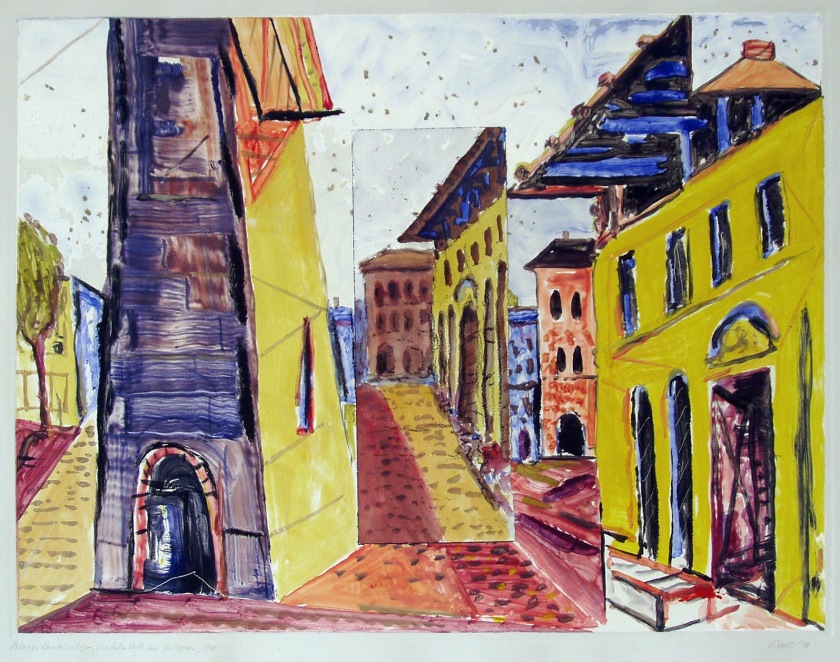
The still life in Amsterdam, above, again plays with the abstract work Remembrance, and the envelopes which had had such an impact on his sense of spatial arrangement, not unlike the way in which volumes were often direct citations of sail boats and apple cuttings.
The documents are related to his wife, letters addressed to her and family matters.
This makes of the work a poignant memento mori, as he remains to this day a widower.
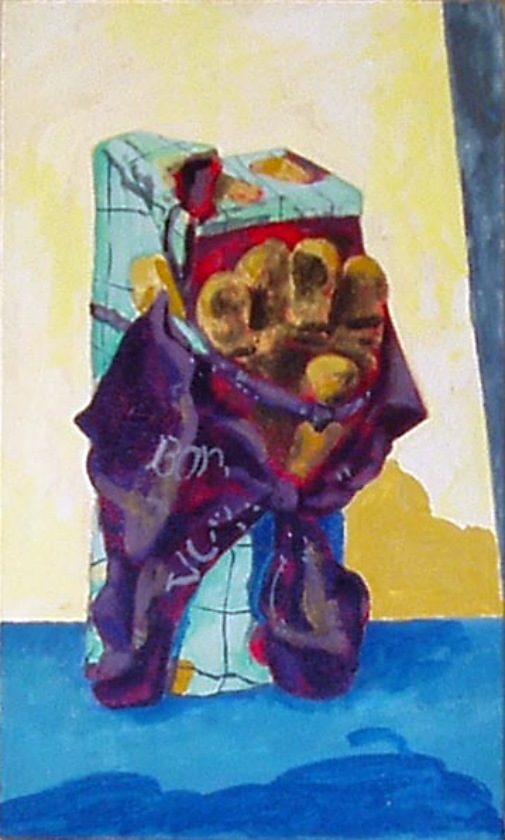
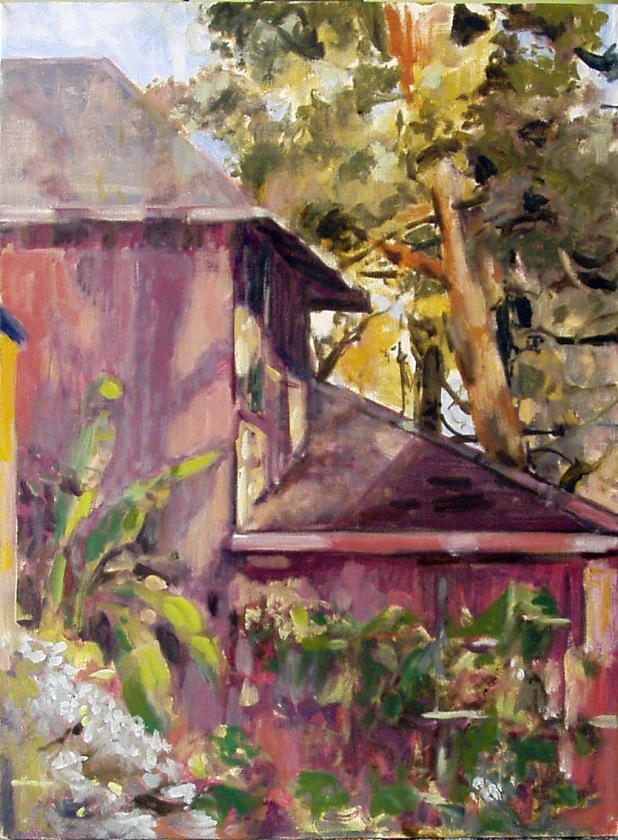
He said he really enjoyed painting Rock and Roll, and especially the area of blue and the white of the bag.
The quietness which descended shows itself in the meditative concentration of the work.
The precisionist rendering and the individualized objects became of greater release to him, than the wilder work of the early decade. In the still life’s and interiors he worked his way again to deal with houses of the family, things that belonged to his grandmother, made collages and one or two landscapes of Galveston Bay. He had felt that he should have gone with his wife, and guilty that he hadn’t.
His way of holding on, was just that, to notice letters left behind, personal belonging, and in some ways his melancholy was able to concentrate on these tiny objects as points of remembrance for her, whose presence he would invoke and hold in these pictures more than in any other form of expression.
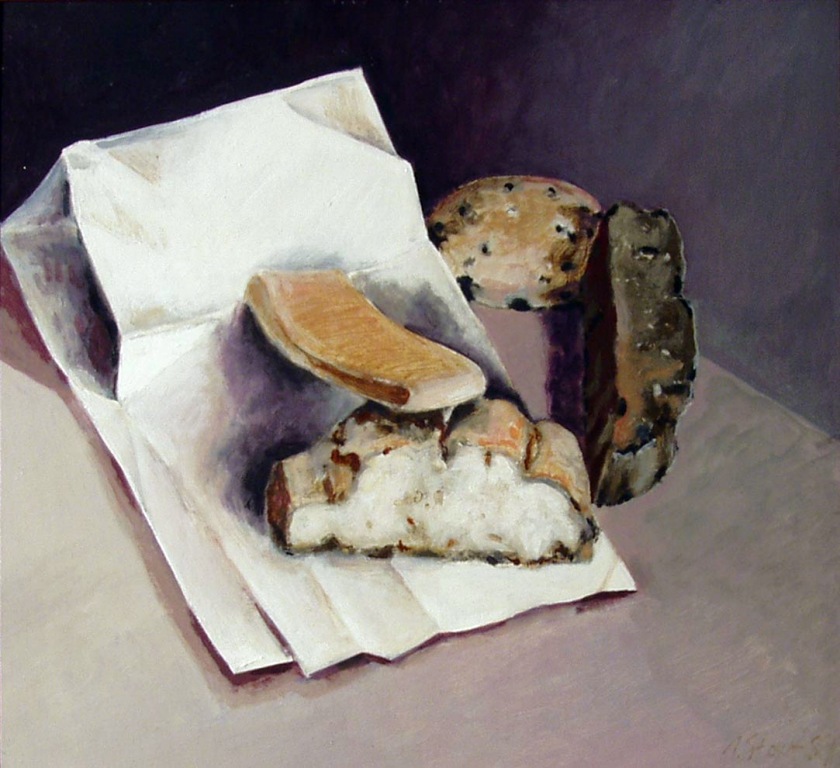
In 88 he did a series of monoprints, and was also busy paintings houses that had once been of his uncle, or other family mementoes. There is the painting Belvedere, (1988), Uncle Gus’s House(1988) Yaddo (1988/9), Brun Street (1988), Deaborn St. (1988) and the charming vignette Bay House(1988)
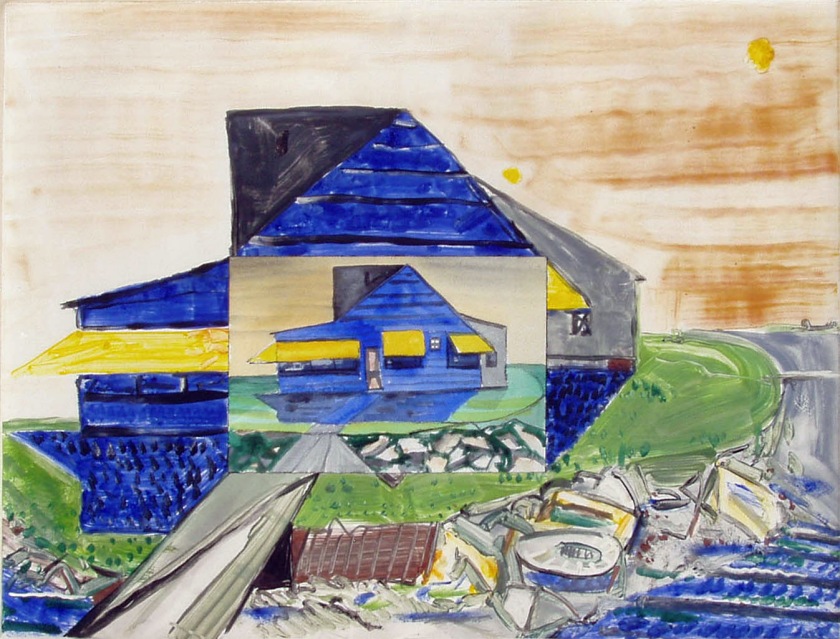
His life now faced the journey again, and more alone than he could ever have imagined.
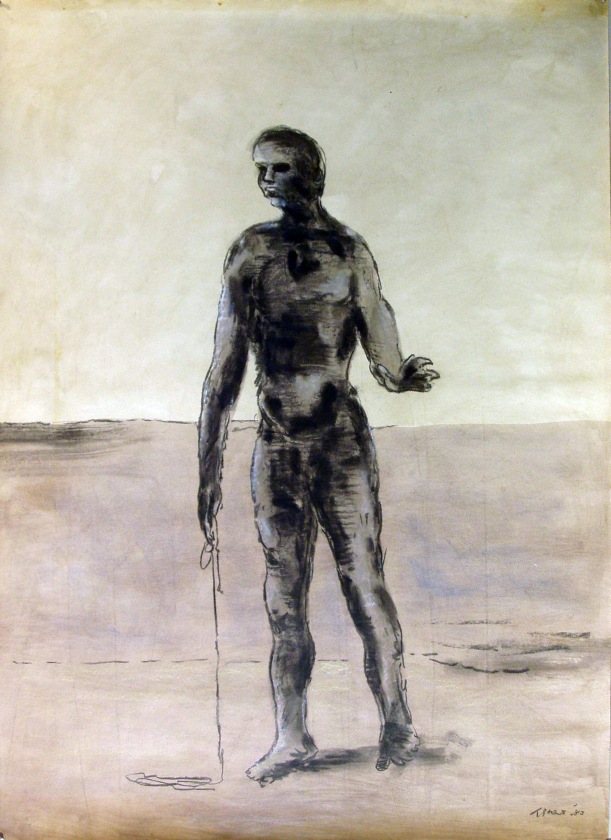
The importance of the 1960 purchase of the house became more and more pronounced after the death of his wife, 1984. He had painted the work Embrace in the early Fall of 1984, just three months before his wife’s sudden death. He returned to work in the late Spring 85.
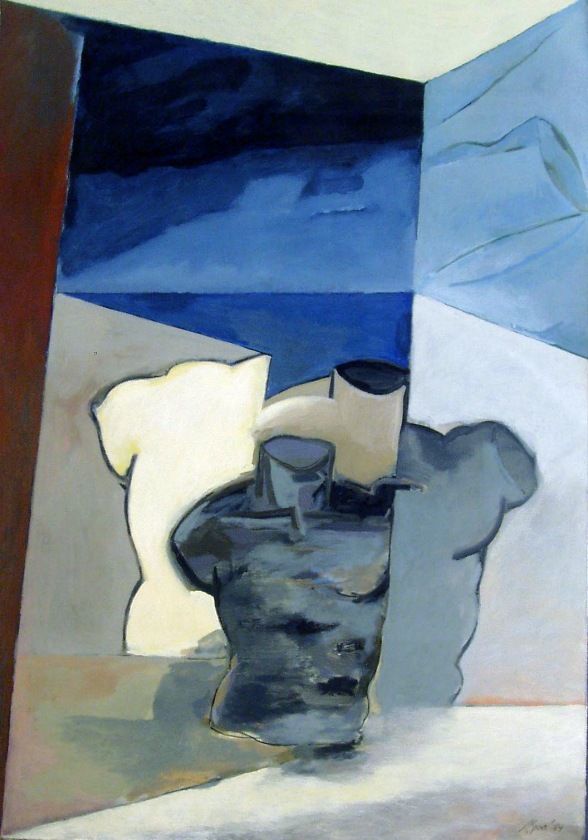
The motif of the torso had pre-occupied him from museum visits to Berlin, Munich etc.
His treatment of the torso was as a memento mori, it was also a box within a box, of memory, of the play of shape and shadow, of pictures included in pictures, of all the things said and unsaid, because every relationship could only be a fragment of the image of love it held as an ideal. We can see studies based on classical kouros figures, and Roman and Greek statuary in works especially at this date, for example – such as Dilemma of 1983, emerges from these studies; Significantly when Stout had purchased a house it was a matter of note in the Houston Chronicle to which an article was devoted. It is worth detailing simply because it illustrates something of profound importance in considering the life of the artist that his relations to place and objects and the elements of his work are of as much significance as any other ‘psychological’ event that takes place. The emphatic search for means to express his world is always concretely situated in the rooms he inhabits, the places he loves, as much as his relations with people. In some senses this has led to a mysterious detachment in the artist’s life. Although one can speak of his artistic involvements in Houston, he would modestly eschew the title of founder of the Houston School.
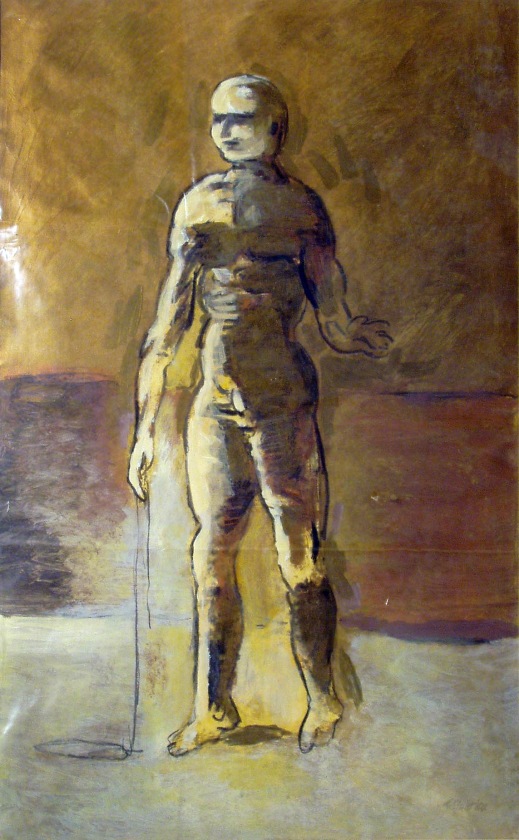
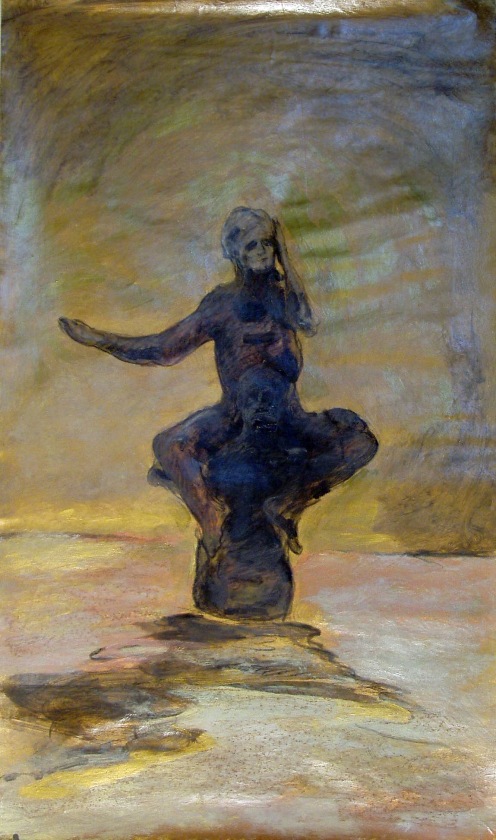
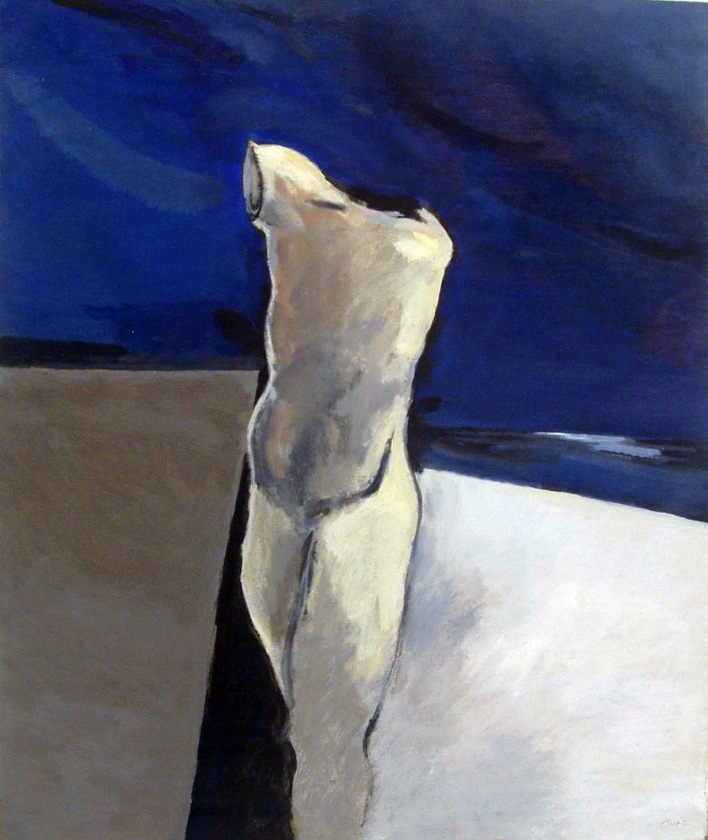
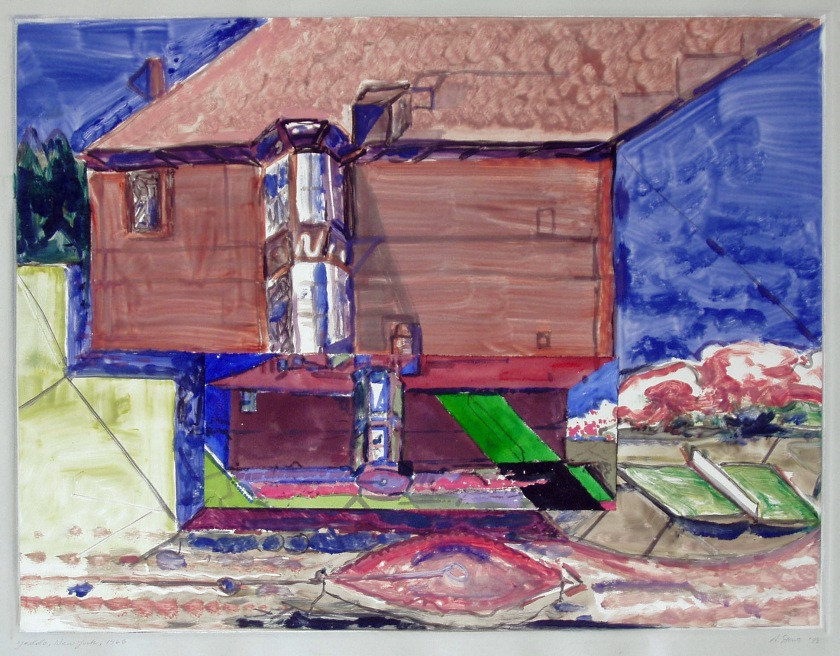
Broadly speaking one can see that the various directions which had been developed in the 50’s were also settling into a unified direction. The purchase of the house may indeed have been a much more substantive trigger than any other consideration. One can detect a movement in Stout towards the intimate reality of home, what the philosopher Bachelard calls topophilia, namely a love of the spaces which we have inhabited, the images that remain simple and of powerful assurance, fundamental images of well-being.
The phenomenological study of the values of the house and the home for Bachelard is a privileged place: which supplies us both with dispersed images and a body of images. By body of images Bachelard means to show how it is that one inhabits the ‘corner of the world’ which we live out or day to day vital life, and the concretion in image that this produces. This is because the house is our corner of the world, and as one has often said, it is also our first universe.
Again from the vantage point of the 60’s one can say that the earlier topographical and interior studies take on another meaning. It is as if though a harder edge, and a deeper geometry Stout is attempting to give a more permanent place to his own past.
One can see that he also wants to stabilize his memories, and find that as he does his imaginative resources grow. One can see in the works of the early 90’s such as, Mother Love, here below. There are tender picture dedicated to his son, and even memories of the works of friends, such as Dorothy Hood. One feels the marauding demons of the doubts and insecurities of the past are away, at least in real abeyance.
Memory and deep humanity of the acceptance of nature and the immensity of the life task and the artistic struggle are balanced in works of great beauty, power and depth. It is a majestic unfolding which continues apace over almost un-interrupted period into the next century.
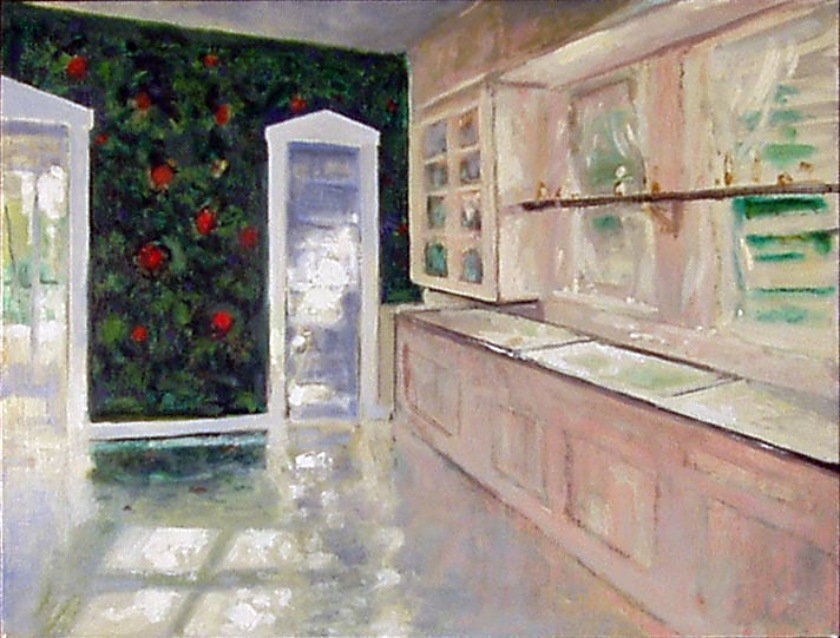
Or works such as Apartment next door (1990) The Beds (1990), A Wicker Chair (1991) When I was Young (1991) Sunday Morning (1993), My Father’s Room (1993), Northern Light (1994) Private Conclusion (1994) Chair at Dicks (1998) can be set against works often at parallel times which point out, not only to the seascape, and the night, but to the mysterious world in which the horizon is no longer the unreachable and fearful; take for example Imposed Memories (1991) On the bay, illustrated below, (91) Night Storm (91) Evening (91) the powerful and enigmatic Looking North (96) and the mysteriously evocative night Sailing (97) Night Sightings (97) The Light of Providence (97/) and the truly magnificent and utterly captivating sequences of paintings throughout that year, The Citadel (97) East Wall (97) and Beacon(97) Perhaps the work entitled Haven (98) is where like the prayer of the poet Hopkins he has found a place where…..
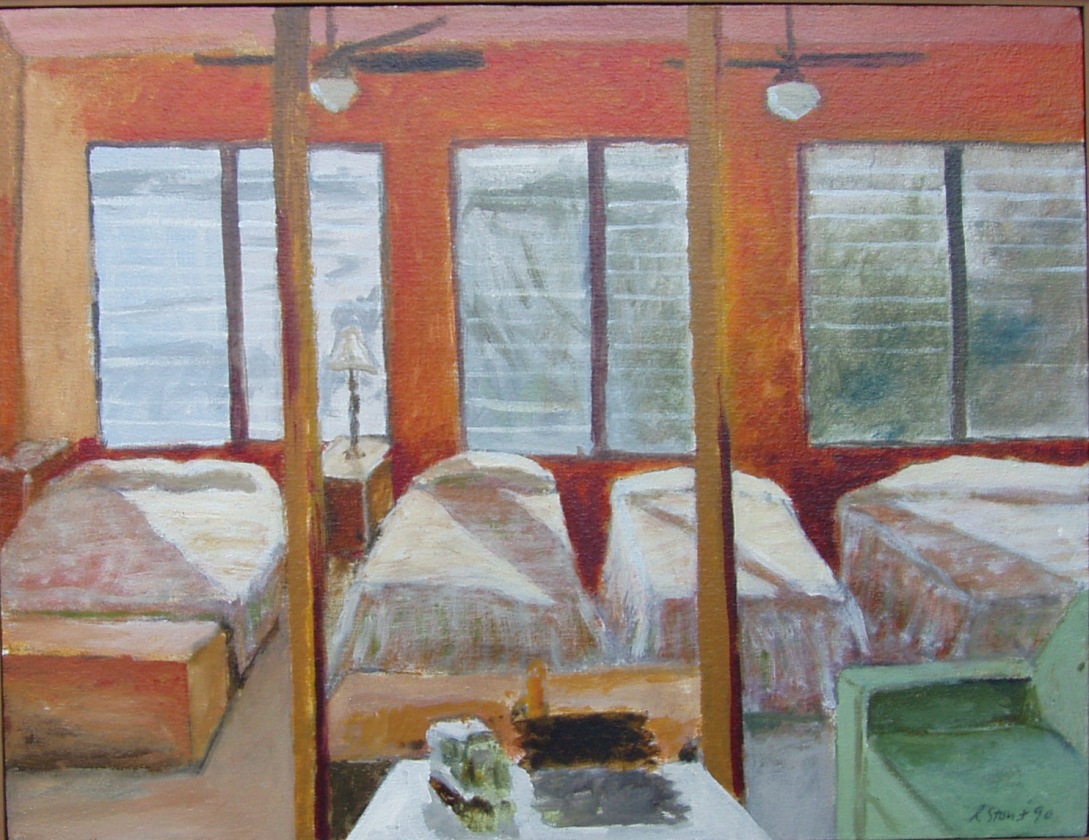
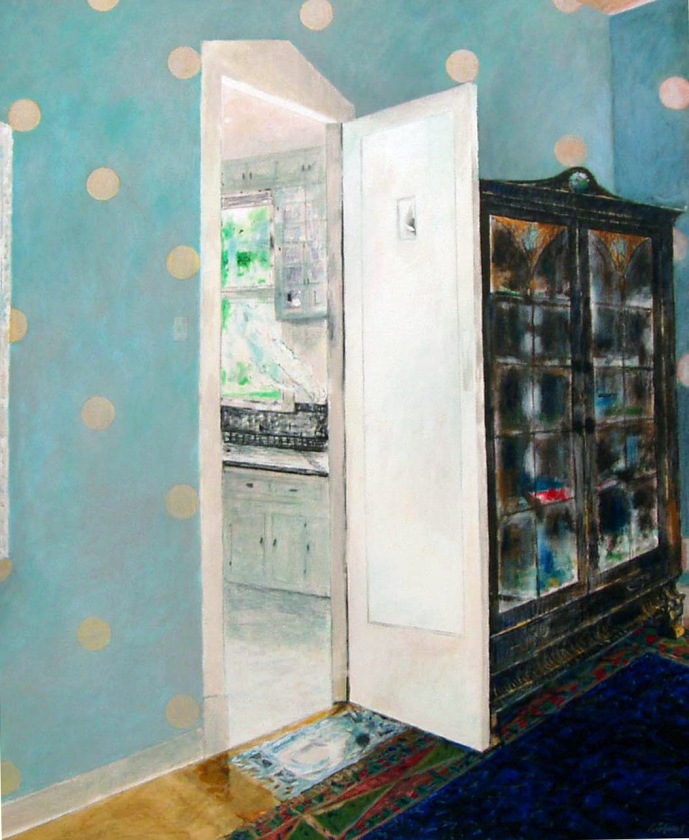
Spring not fails/ Far from the sharp and sided hail/ and where a few breezes blow…… where ships are in the havens dumb/ and out from the swing of the sea…
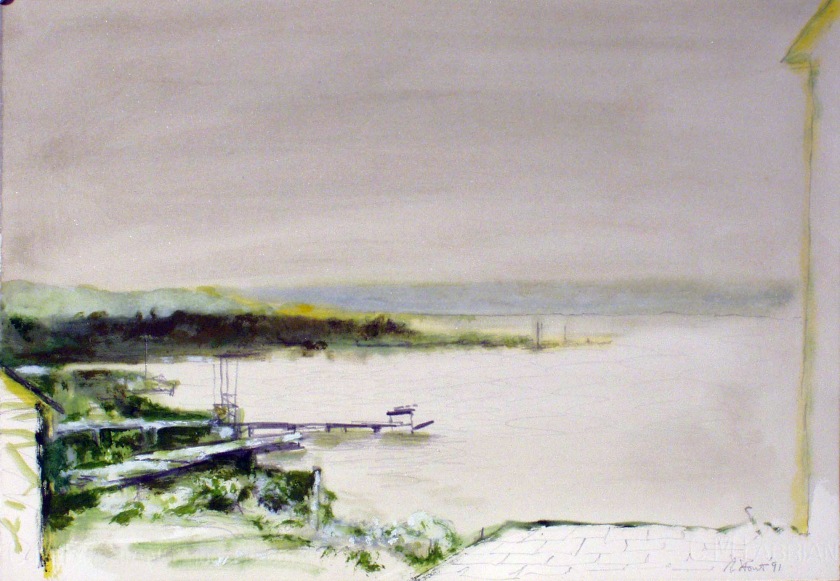
The register of place and the deeper relation to the memory of his own past orient the artist to what will become one of the greatest subjects of his work, the space of rooms, the interiors of his own habitation which over the decades will release images of exceptional strength and assurance. There is some significance in the reading of Bachelard for the whole work of Stout, in that the role of the imagination and the elements become a form of oneiric reverie. In speaking of the resources of a phenomenological enquiry then, following Bachelard, one can ask: How is it we inhabit our vital space, how is it we take root day by day in ‘our corner of the world”? It can be argued that this question is the fundamental driving force in the work of Stout at this point.. Night Storm below points outward and marks a corner of view. point.
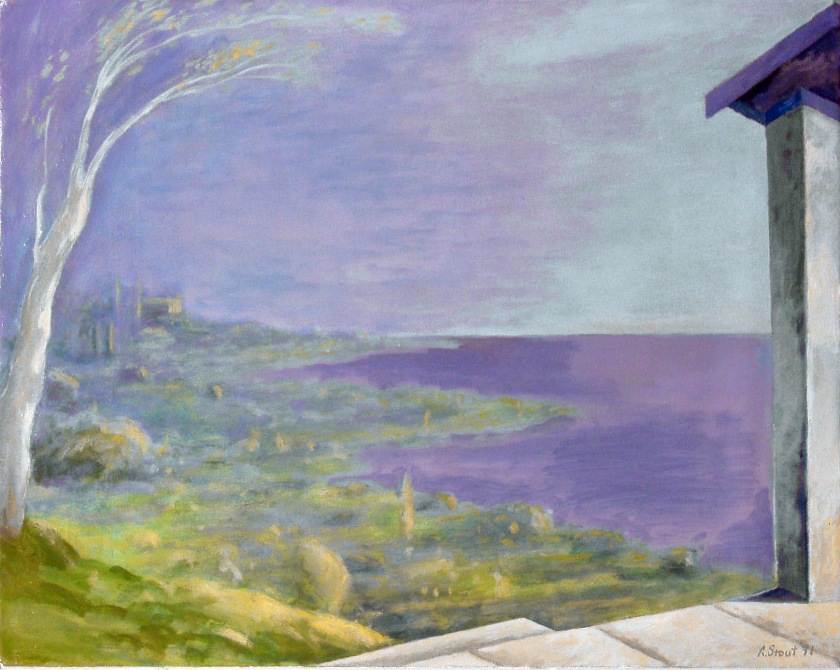
He has found his corner of the world, and it is a house in Houston. From there his imagination will grow. It is not the case that he is involved in a merely descriptive exercise.
The house is not de facto lived as a psychological document; the Wunderkammer of traces and tracks that signify identity. Rather the experience of the house is the very means of thoughts and dreams. It is an incubator for reverie, and always goes beyond itself, it seeks as it were to find a deeper stand of the imagination which alone unites the powers of reason and understanding, and points to a more fundamental ‘image’ for the artist himself, that of inhabiting. This can lead to concrete awareness of the impersonal, the not-I, which actually shelters the day to day turmoil of living.
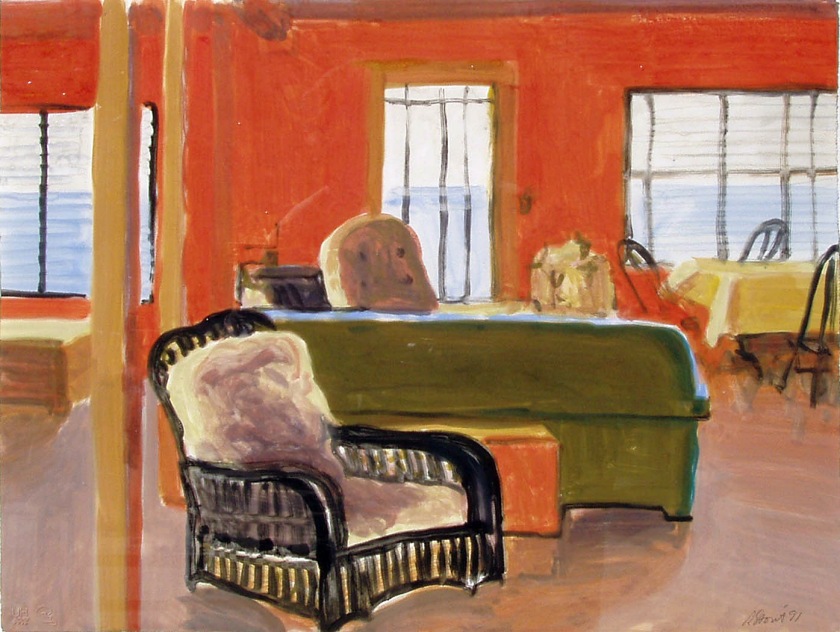
Bachelard is intellectually engaged in finding the expressive, non intellectual, and primary experience for place and space, and does so through a concretized image; that of the home, the house, the habitat. Where one says Bachelard here, one could also say Stout, as the analysis seems to be such a perfect fit for the preoccupations of the painter that it would allow one consider an enormous part of his oeuvre and provide as it were the radical phenomenological underpinning of his individual quest. This does not exclude even the hut, or a temporary shelter. For this analysis the experience of the house in its reality and virtuality is, as already remarked, the means of thoughts and dreams.
Means here is not an instrumental conception, and cannot be made operative in a rational way. What is suggested by Bachelard is that all our images of protected intimacy have the home as the attraction and concretion in ‘image’.
This is not a Jungian sense of archetype; rather there is no other way to figure or given an imaginative account of intimacy that does not contain the home as image and memory, which forms a community of feeling that we call belonging, place, home. If we do not disturb this fundamental solidarity, or understand its imaginative force, then the tonality which home, house, adds to our dreams enriches immeasurably the image of shelter, whilst at the same time it gives perceptible limits to our sense of shelter. Part of this is also to be set against the fact that our feeling of being at home also contains what is unheimlich, what is not at home. We seek to work through means of repetition and memory the sense of belonging somewhere, even if we sense we do not belong at all.
What comes to dwell in a new house is an entire past.
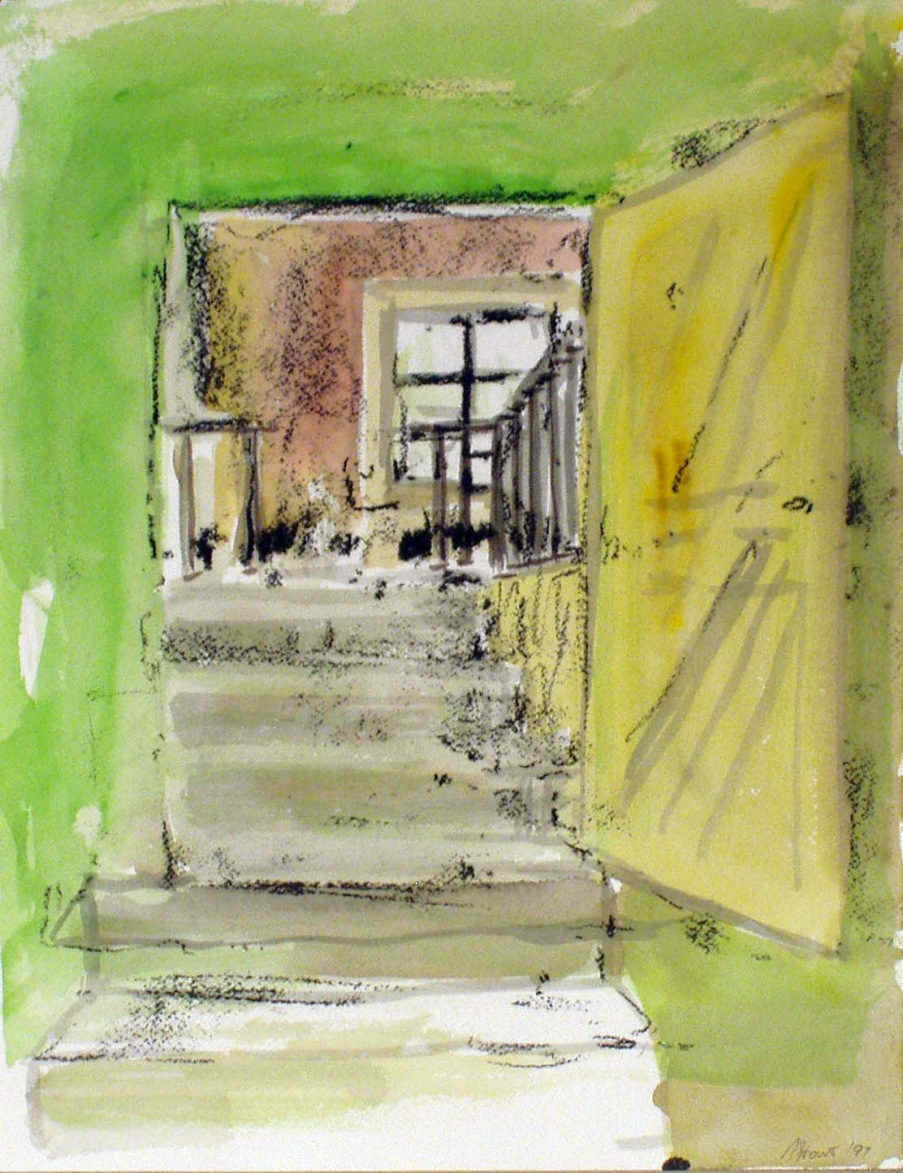
The house is the greatest power of integration for thoughts, memories and dreams.
Without it we would be dispersed beings. Much of the contemporary problem of living is that the forces of distraction and dispersal keep us from the experience of being at home, at peace, and deprive us of the protection and solitary power of image that allows us a sense of well-being, because such a sense is the adequate equivalence of the primal image that makes the material imagination have its roots and interconnectivity with all of place, and ultimately of world itself. The enigma of the house is the capacity to disperse and integrate. The world is, as it were, sheltered in the individual imagination, and this gives it its awesome responsibility, because it can also imagine itself as meaningless and a mere speck in the vastness of material being.

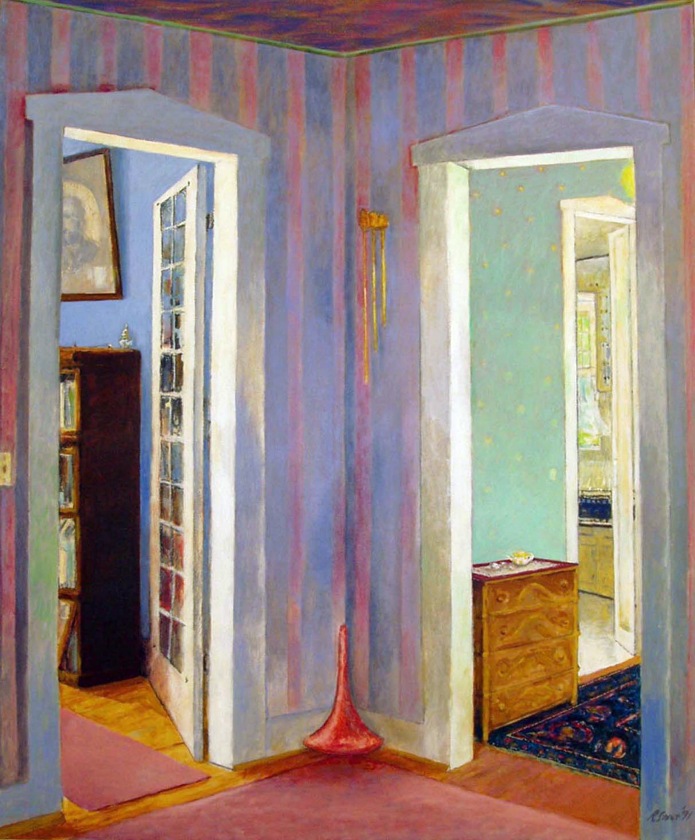
Value, fact, become enclosed and coalesced in this very protection and the value of Being is well-being. There is then a double movement, the memory of houses to which all day-dreaming returns is also the housing of memory, which gives the setting to the site of our intimate lives.
When questions are asked about the largeness or smallness of the rooms we inhabited, their warmth, how they were lit, the way in which one could achieve silence and sleep, then it is the case that time cease for memory. We cannot, according to Bachelard’s argument, record concrete duration, all we could do, at best, is think of it as line of abstract time, think of time as an abstract t line without thickness. What is urgent for memory is the localization of spaces, and this is where the knowledge of intimacy emerges.
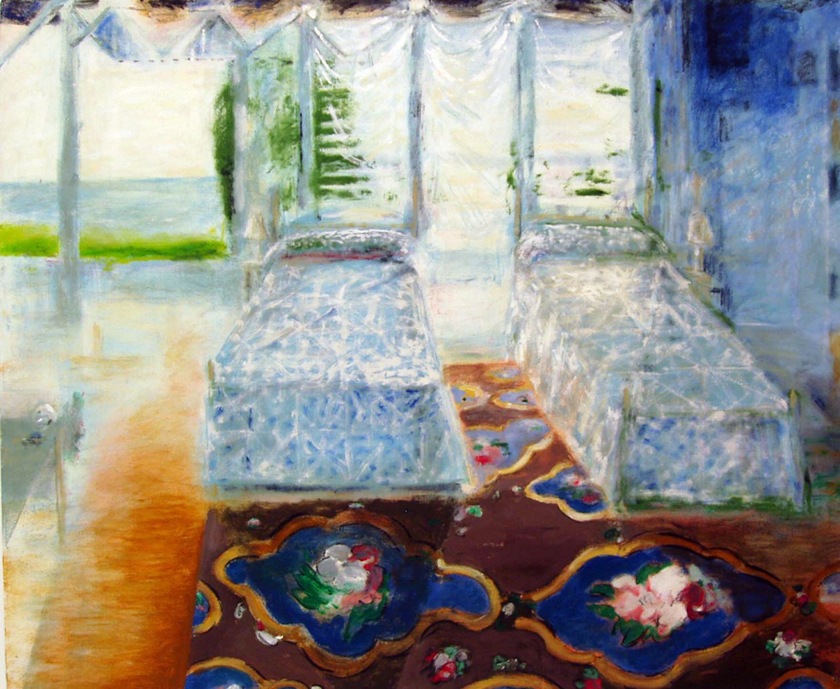
What we re-compose and dream in solitude is hardly available to another as something to be told. The limit of this story is that it passes over to an act of evocation, that when one can show this as space then it makes the dream transport available for another.
The paintings of Stout, however, although tied to his own individual memories achieve this magi effect: it allows everyone dream of their rooms, their lives, and their own intimacy.
It can be argues that the situation of our dreams so shared belongs inevitably to the function of poesis, of the poetic making. The house one is born in is more than an embodiment of home, it is also the embodiment of dreams, and furnishes us with both dispersed images, and a ‘body of images’ at the same time. It could not be the case that the room one has lived in could be expressed by merely drawing a plan of this room, rather there is a more complex retrieval, namely that we live in memory what we once inhabited as dream. There is a double face to this, since the very body of memories gives proofs on one hand, or illusions on the other, of stability.
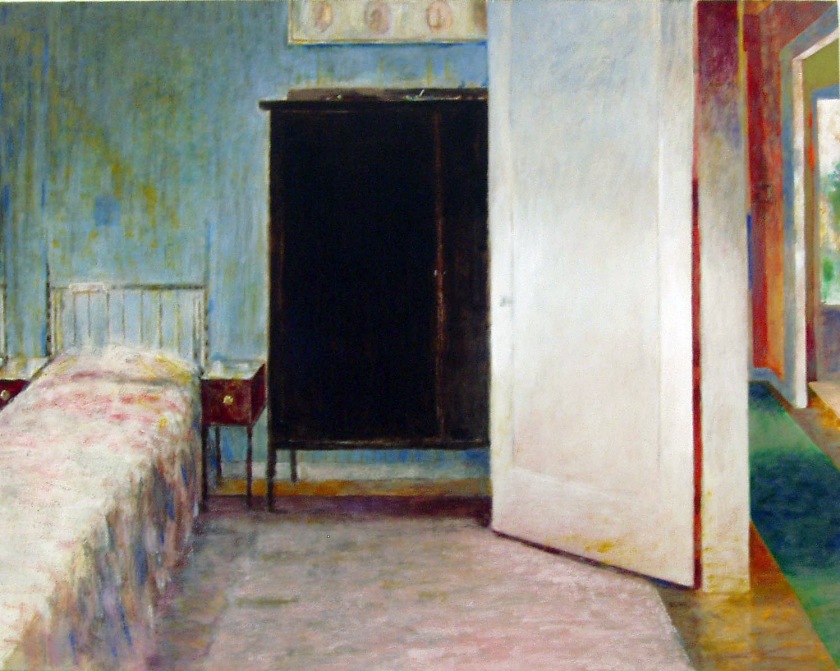
Stout faces this directly. He faces it by grasping not a formal vocabulary that is available for architectural forms or typologies, rather he brings order into the various images, of concretion and dispersal, by understanding how this is fundamentally available as two main connecting themes, one, the vertical being of the house, that is the house imagined as a vertical being, and secondly the house imagined as a concentrated being. Thus the two themes signaled by Bachelard, verticality and centrality can be seen in the paintings of the 60’s to bring Stout to new compositional and formal resources. He will buttress the feelings of insecurity and the darker, wilder explosions of some of the work of the 50’s by taking on directly the polarities of what is imaged in the vertical, which is also that between darkness and clarity. As will be seen his first formal move will be to double the vertical and release as it were the fear of dying as geometry of forms.
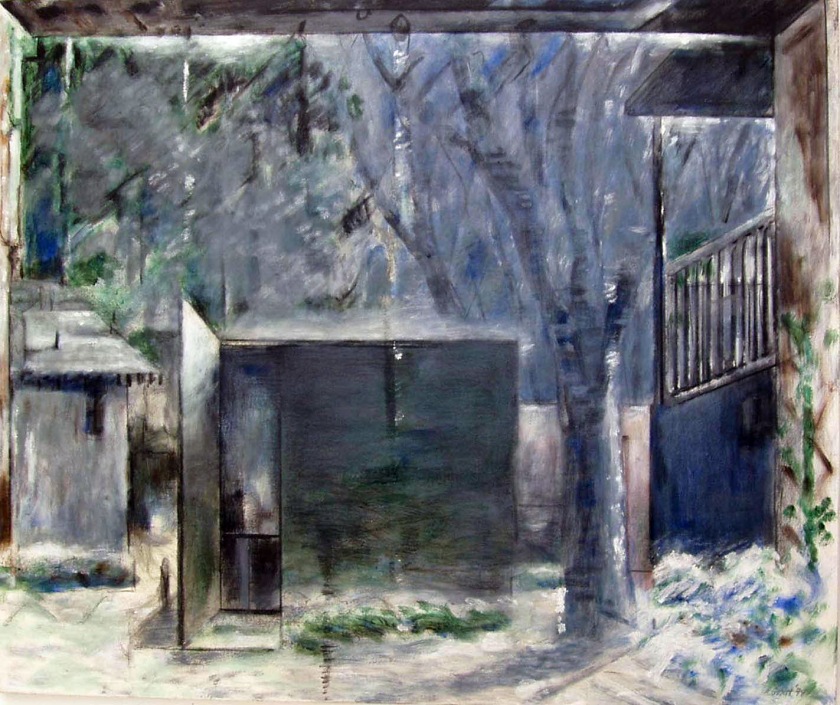
The struggle for the painter as for every living being is to recover another attuning, in which one can live the image directly. A house that has been lived in is not an inert box.
Inhabited space transcends geometrical space. Stout’s early picture of the shed at the back of his house from 1952, commented on above, seems in retrospect like a primal image, with the solitary figure in the ramshackle doorway, and has indeed the kind of effect that Bachelard speaks of when speaking of a light in a distant window seen from afar, in what we take to be a hermit’s hut. The hut becomes in the life of Stout the den, or in Auden’s celebrated phrase, ‘the cave of making’.
What is significant about the example is that it is redolent with the solitude which is essential for day-dreaming. Perhaps it is better to say that day-dreaming is most attracted to such solitude, even if it occurs in the boredom of a school-room, surrounded by others, as one looks out the window, or takes its exalted command during periods of deep concentration in study, and one is suddenly elsewhere. This elsewhere is never named, it is the some-place that is not an actual place, it is the deep space between everything we feel and see, between things. We still, however fear to live our space of day dreaming. Commenting on a passage from a childhood memoir of Henri Bachelin, where the narrator in his Moravian village imagined the moment of living in the heart of the woods, there is a displacement of the house of the narrator for the image of the hut, and the house replaces the hut, ‘ it sheltered me from hunger and cold’.
The image of the hut seems to be there the tap-root of the function of inhabiting, and so when we are lost in darkness and see a distant glimmer of light, Bachelard asks: ‘ Who does not dream of thatched cottage, or to go more deeply still into legend, of a hermit’s hut”?
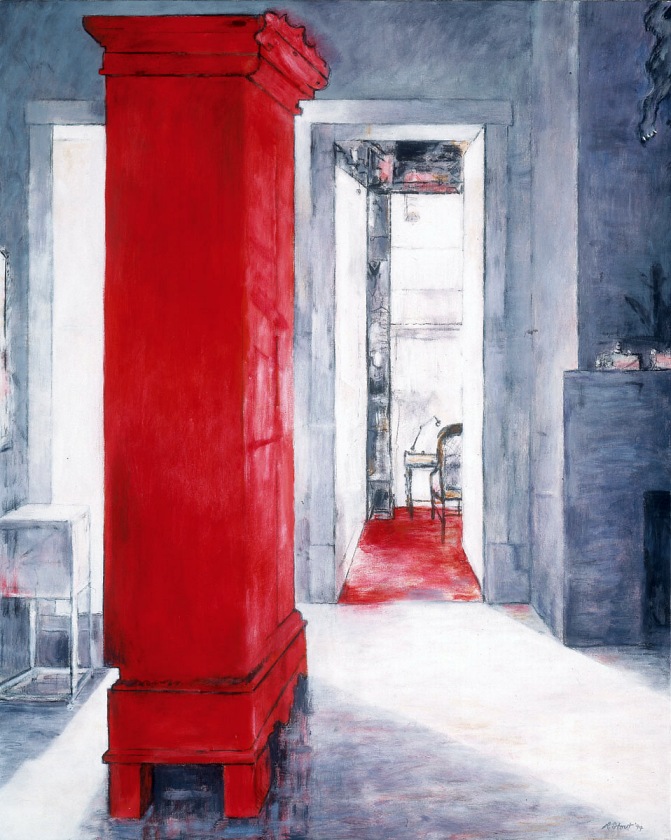
The hermit’s hut is a theme that needs no variations, for at the simplest mention of it there is a phenomenological reverberation, which obliterates all mediocre resonances, cruder images cannot muffle the depth and sonority of such simplicity. Even the weight of the greatest architecture returns to this, the hut of Romulus on the Palatine Hill, the imagination of the simplest structure, an image that brings us to complete solitude.
The image possesses the felicity of intense poverty to which the riches of the world can add nothing, and thus offers us access to absolute refuge.
However the image also has an unfathomable oneiric depth, to which the personal past adds special color. Perhaps it is not until late in life, Bachelard says, we really revere an image, and thus in the realm of absolute imagination we grow young late in life, as we live in paradise we have lost through the reality of the image, of a sublimation beyond passion.
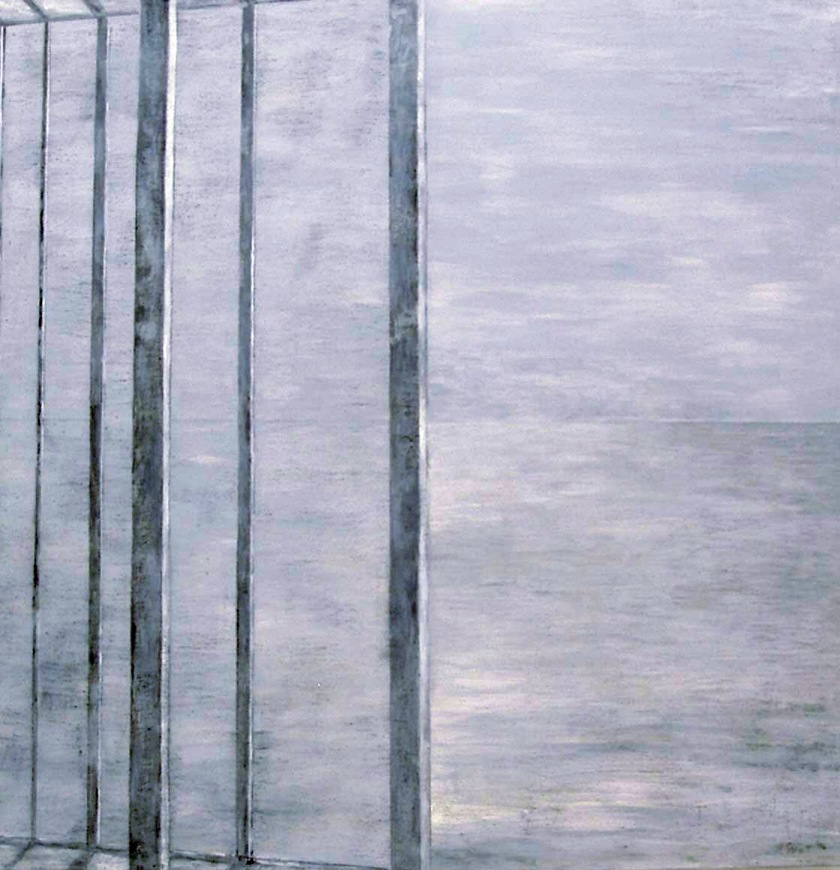
But if this were the only aspect of the relation to the house as the image of well being we would have lost in the ‘topoanalysis’ important aspects and elements. Firstly Bachelard emphasizes that the category of intimacy must be advance.
However, as Bachelard observes, one must set against this intimiste view the plan fact that the house is primarily a geometric object, visible and tangible, made of well wrought solids and fitted framework. It is dominated by straight lines, the plumb line marking it with discipline and balance.
The argument around the painting of Stout and his intimiste view of things has been explored by Mc Evilley. The argument centers on the painting of 1992 titled Living together.
Susie Kalil in an exhibition catalogue for the Beaumont. Texas Art Museum of Southeast Texas, 1999, made the claim about the work of Stout “His work comes directly out of French ‘ Intimism’.” Kalil assumes that “the ordinary relationships of an artist’s private life – its coziness and order, its covert gestures, its moment of deep-rooted habit and fragile intimacy-is profoundly interesting as a subject for painting’.
The key references are obviously to painters such as Pierre Bonnard, Edouard Vuillard, and Henri Matisse.
Mc Evilley rejects this reading not in terms of the fact that Stout as shown above was conscious of the work of Matisse and Bonnard, from an early age, but rather in what the treatment of the interior in Stout suggests, or captures. In Mc Evilley’s reading ‘there is a dark side Stout’s domestic interiors that moves in otherworldly directions”.
For Mc Evilley what is happening in the work of Stout is an ineluctable move to transcendence, and to the monumental sublime of the later work. He will track the motif of the desolate, emptied rooms, and the relation to what could be termed dystopic space as the direction to which the works of Stout lead.
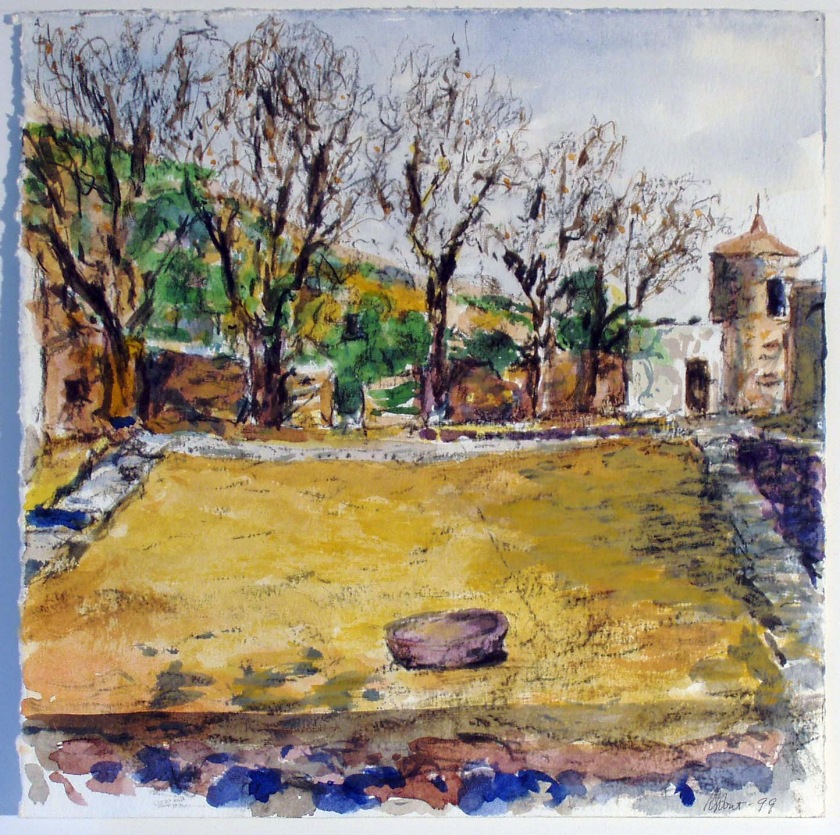
The tension which Bachelard points to show that there is also something contested in topoanalysis that the geometrical object of the house ought to resist metaphors that welcome the human body and the soul. He adds that once there is a proposal of intimacy, transposition takes place immediately to the human plane, and independently of all rationality the dream world beckons. This dialectic is never resolved. Further it goes through every relation, not only between the geometrical object and the human plane of intimacy, but for the terrestrial house and the areal surround, the relation of light to wind. In the main the philosopher will argue that the different characteristics of the house ‘it is inclined to be hospitable to fragmentary dialectics’. Houses can be as weightless as dreams. There is something recoverable uniquely in the mellowness and intimacy of the inner life which is figured as such an entity. It is not just that the world of the interior is construed as a place of shelter, somehow also in its arrangement, it keeps death at bay.
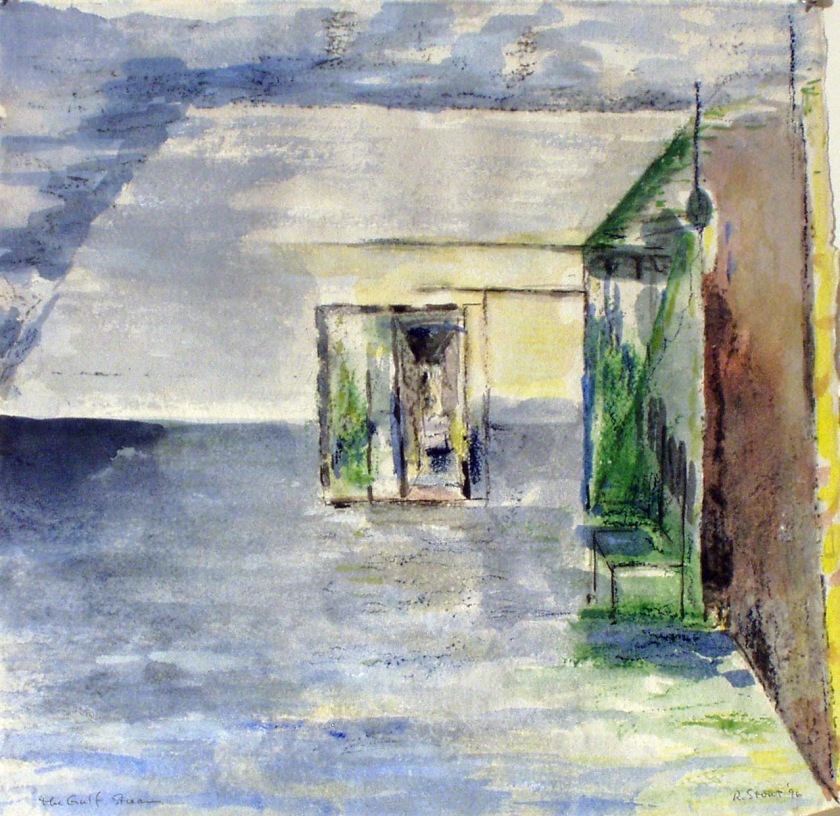
Further there is a house of breath, of wind, of voice, even a house of mourning.
However many houses so named, they all return one to a primordial dwelling, the crypt of the house we are born in, and the primordial dream that belongs to all day dreaming with it translation to which the imagination alone gives access.
The dream house also defies geometry. This first emphasis on centrality and verticality gives way to more paradoxical and even simpler image. The track and trace of rooms and interiors, the world of what is outside belong also to the inside of the dream place.
Thus the hospitality to dialectic fragments also has another dimension, namely that the imagination seeks ineluctably ‘primal images’, so that even where there is a rational paradox something can be communicated that comes not only from the clash of the geometrical and the intimiste, but also sends one in another direction. Thus, a nest which is open to the sky and very fragile, still communicates an image of security, and despite being a precarious thing sets us dreaming of stability and protection. If one thinks of the nest and the house, it is not to create an analogy, rather it is to seize what thinking of both gains for one’s awareness, and this Bachelard names that neither know anything of ‘the hostility of the world’.
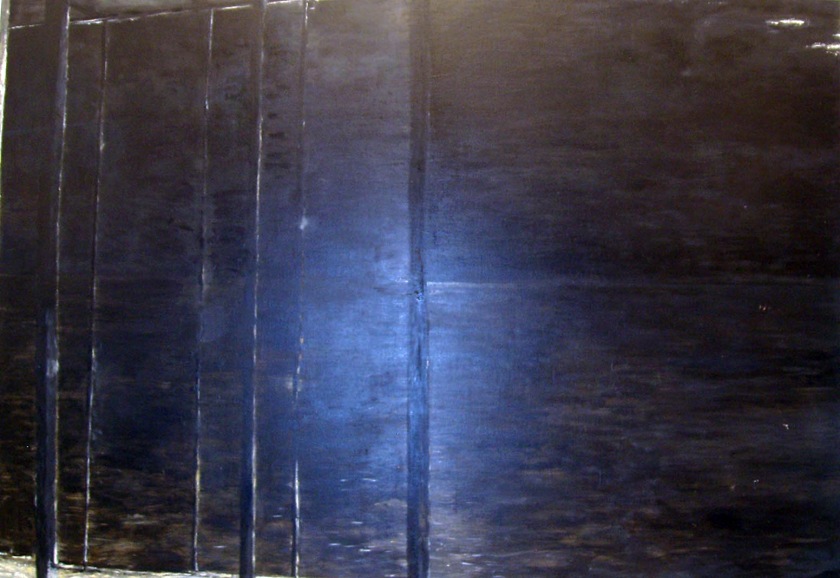
The tensions of the artist which can be the experience of the hostility of the world. The intractability to the artist’s will of material things, of social facts, of personal achievements in terms of the ideas being developed, is a later phenomenon. The primal phenomenon which does not require dreams of defense or aggression is that the germinal form, the forms that give life its renewed and emergent richness, is ‘wellbeing’.
Being starts for Bachelard with well-being.
One needs then to turn also to a consideration of the space of the image.
What can be seen a red line running through all the work of Stout from his earliest surviving works to the very latest sculptures and paintings, is the sense of being one who needs to return home. However like the dialectical images of which Bachelard speaks, the problem of the image of past spaces and places, of home to return to is defied by the singularity of his experience. There is no home to go to, literally, since the past will never be the same. The return can only be the magical illusion of the painting, which miniaturizes the space of the imagination, and hopes to release it to an immeasurable non-place, or have it dissolve into the horizon, like a dying into the light, which remains a move to start again.
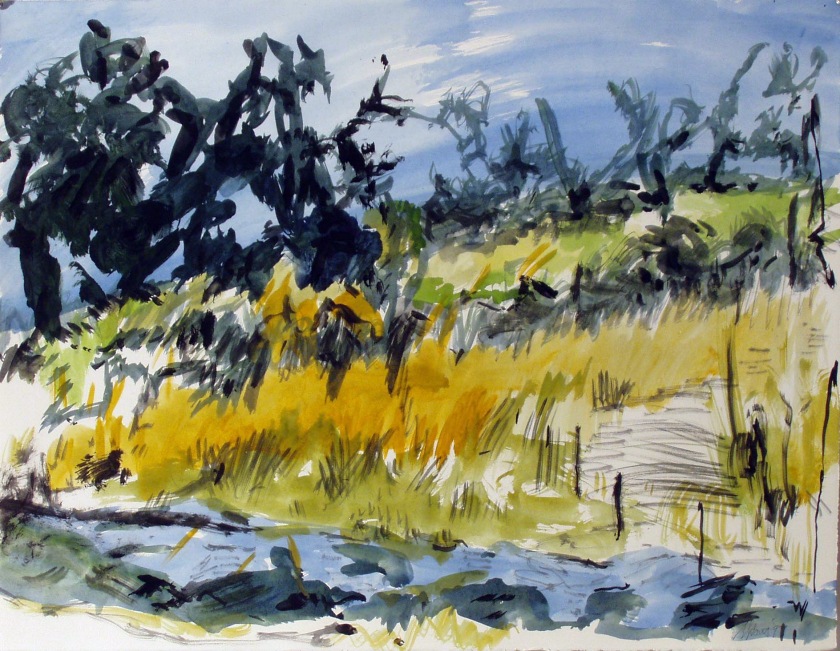
It is clear that the lived space of the daydreamer who wants to return, home, is not of geometry, or, it already includes geometry and dreams beyond it. Images cannot be measured, and even when they indicate space they constantly change in size, they are always a suggestions beyond themselves, because they depend on the outside from which they are viewed as much as what they show within, and share the fate of all visible reality, namely it cannot be fully grasped in any one view, or in any accumulation of views, there is always what remains invisible, and the illusion of depth that needs to be salvaged.
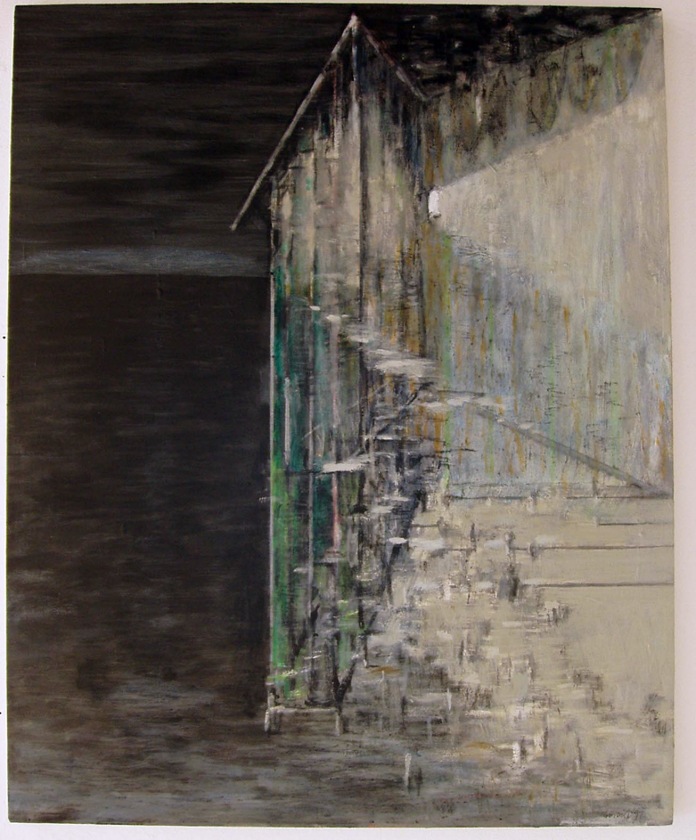
In the perplexing dialectic examined by Bachelard, and which is so much the work also of Stout, there is throughout the silence and solitude of the image.
The solitude is not a self enclosed isolatorium, a mutant bubble, but communicates with other solitudes, and is deepened in solitude through the profound alliance of the material imagination and the daydream. Bachelard adds to this another crucial observation, which is moot for the entire later expansion in the work of Stout, namely, that even if it is true that reverie, the daydream can feed on all kinds of sights, there is a natural inclination to contemplate ‘grandeur’. One could say, he argues, that immensity is a philosophical category of daydream, that immensity belongs to its ‘sublimation’, in that it transports the dreamer outside the immediate world to a world that bears the mark of infinity. However the characteristic of daydreaming is that we do not see it start, which is to say it flees the object nearby and is far away, in that sense the one who is on the way finds his idea of return and home when he is ‘away’, elsewhere, in the space of elsewhere.
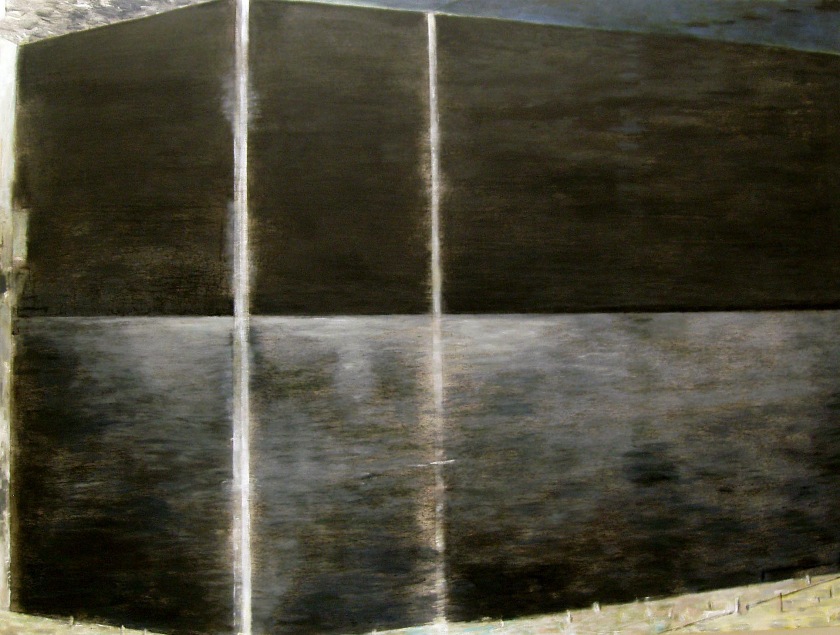
The question of how we could analyze the impressions and images of immensity, and what indeed immensity contributes to an image – one can think of the whole work of the 1990’s in Stouts’ oeuvre as the decade of the immense-brings the viewer again to the critical paradox that has constantly seeded the work of the artist, that there is a richly productive imagining consciousness, and that the works of art created are the result of this existential feeling of the imagining being. The immensity is within the self alone.
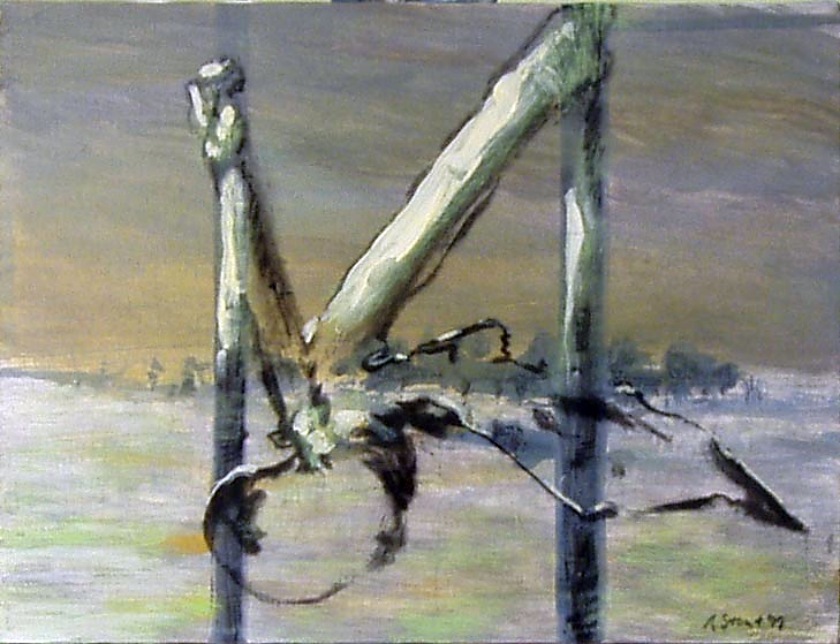
There is a consciousness of enlargement. All the dream of the expansion of being is arrested by the facts of life is curbed and cautioned from emerging. Given the inner immensity the real trigger is being alone. Thus the spaces and interiors of Stout require absence of human figuration, and the room is given again to the imagination as the place of this interior immensity. In that sense the tension of the abstraction and figuration, is resolved in the dialectic images of absence and oblivion with its open architectural reference.
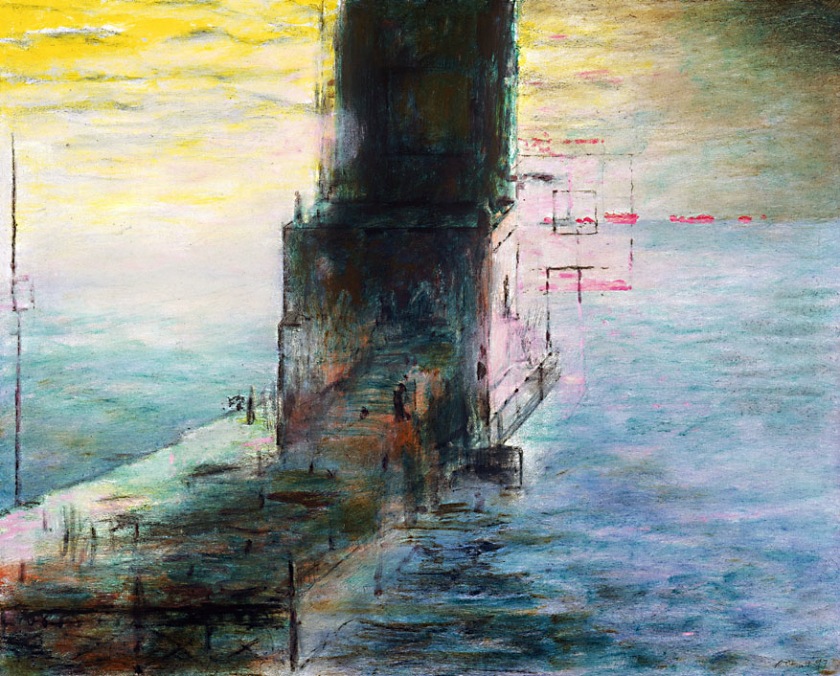
Certain expressions of the visible world can only be adequately suggested through such immensity, even if the scale of presentation is always miniature, in other words no scale model, can avoid also the same drama of abstraction and geometry, and even the three dimensionality only facilitates an awareness of experience through movement .Perhaps this is what Baudelaire understands by Correspondences, when different impressions of the senses enter into correspondence. Bachelard comments that in finding the correspondence ‘the sense of existence is immensely increased’. This suggests that we discover the immensity in the intimate domain is intensity, and this is an intensity of being, and the intensity of being that is evolving in a vast perspective of intimate immensity. The principle of ‘correspondences’ then is to receive the immensity of the world, which they transform into the intensity of our intimate being, and thus is instituted transaction between two kinds of grandeur. Imposed memories below also is a direct homage to the great 19th century paintings of Martin Johnson Heade(1819-1904) such as Thunderstorm on Narragansett Bay of 1868, now in the Amon Carter Museum, Forth Worth, Texas.
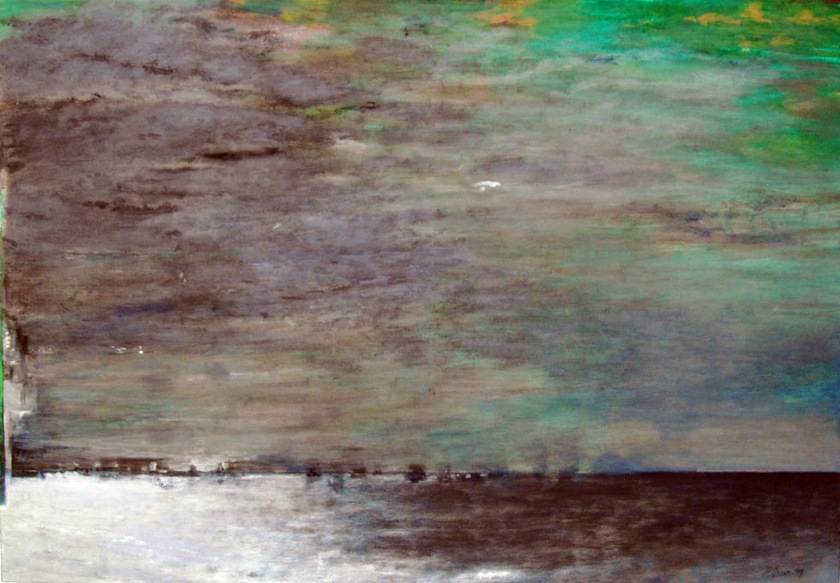
To image is to be away, it is underway to a new life. Again the reprise of the creative instant which is the real, gathers into itself, in its own present the rhythm which constructs time along with space. The inter-play of destruction and creation is how the artist accepts that time is only continuous as a possibility. At various stages he punctuates the memory of memory to release it to a new immensity. One can place along side over a period of 50 years the view of the shed at the back of the house, of the single bed in the room of his dying father, the space of the coffin viewed from above down, the retrieval of such images of home again through all the work, and most significantly the transformation of the house which settled him in Houston, and which eventually became the abiding work of his life, acting finally as the receptor of his imaginative actions, as a home, a refuge, a studio, a theater of memory, the place of dying and birth, the image within his images of the fatal intensity of being that kept working towards the horizon that will one day arrive. All these actions and events have a density, not just duration. There is a saturation in the material elements chosen, in the composition, line and color, which raises the question of home to that of the abiding motif.
Time has to be attached to things for them to be real. Therefore the work of Stout is making physically present the presence which he retains, giving a frequency to the scale and dimension of his longing, and even self-control.
He lives though the decade with all the rhythm of aggression and conciliation, love of the self and love of the other, and keeps always in mind the possible childhood which opens a dream of an indefinite future. But it is the imagining which is ‘away’, so the home, and the return are also a longing that needs material imagination, and this shows itself in the explosive joy of instants of decisions. Here is where the access to the poetic dynamic of the imagination itself is rooted. It is the penetration to the material results which gives the dreaming its center. All the poetic images of Stout, so many of them suggested often retrospectively in the titles of his works, discloses that perception and imagining are also as opposed and paradoxically antithetical as presence and absence. Thus the struggle for the mastery of the largest abstract forms in this decade, the movement to the shaping of an immense outer world of space, framing a decade of unremitting work, can be set against the theme ‘nostos’ which ends somehow when in the early 2000’s he calls some sculptures Ithaca. He has come home, to where as Bachelard says ‘in this activity of poetic spatiality that goes from deep intimacy to infinite extent, united in an identical expansion, one feels grandeur welling up. As Rilke said, “Through every human being, unique space, intimate space, opens up to the world."
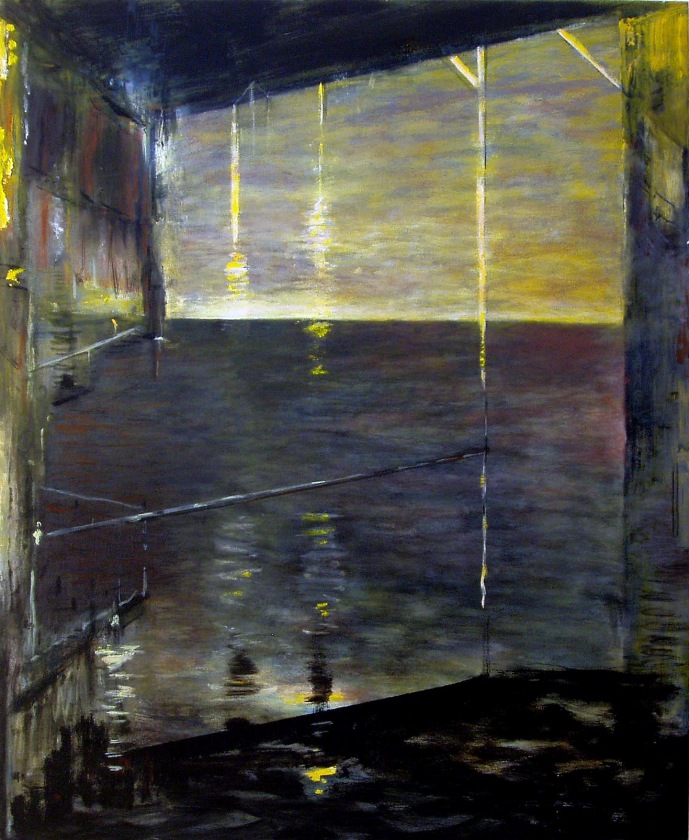
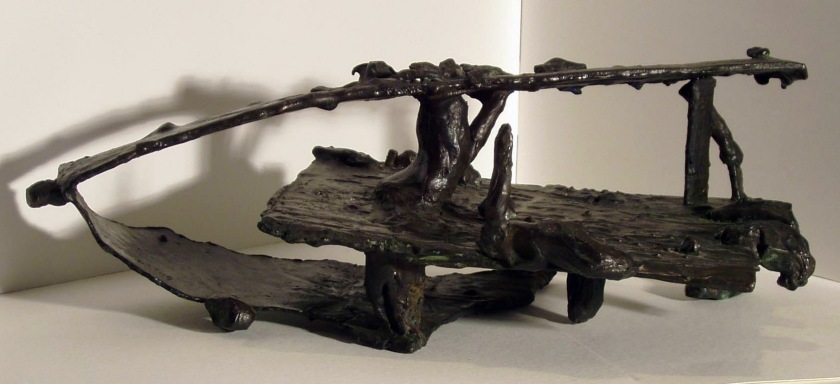
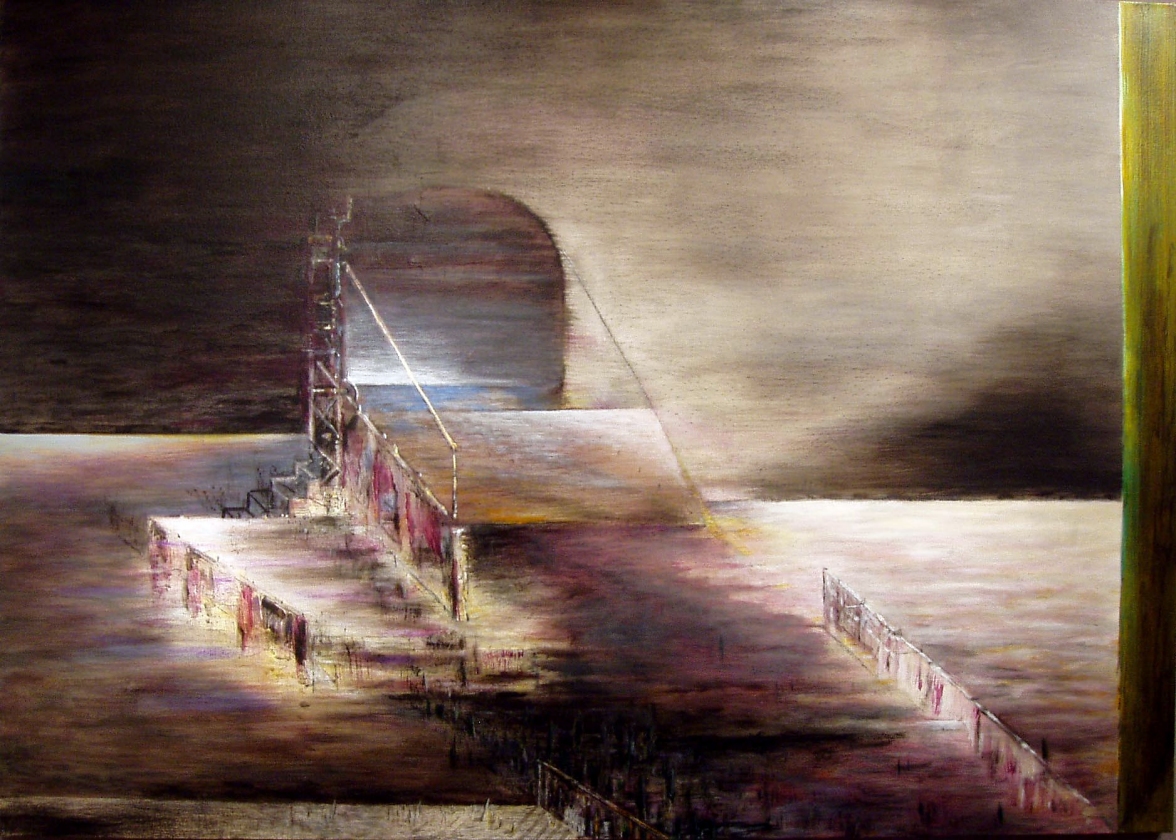
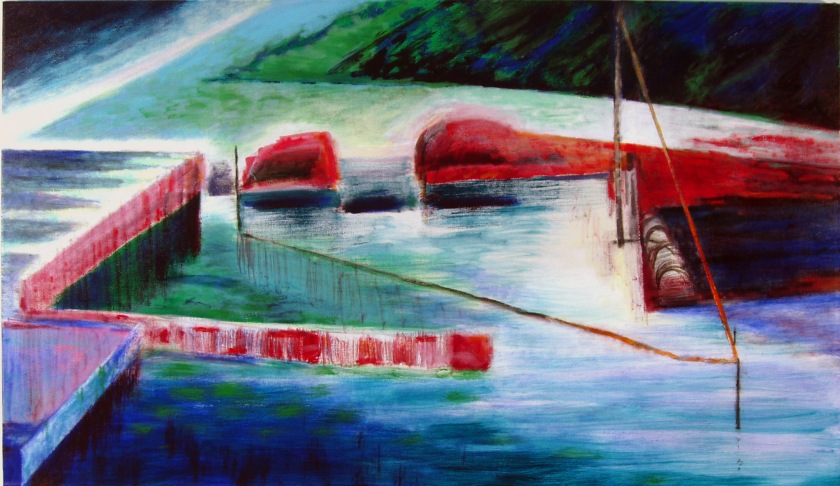
Acknowledgements: To all at FIU A'dam my best thanks. To Richard Stout I am deeply obliged by his courtesy and willingness to discuss his work. I would like to thank the Department of Theory, Architecture and the Built Environment, TU Delft, for every support in writing up this research. Finally to Stephan Waldo who has worked as research assistant at the FIU Amsterdam, and helped enormously in the final edit of this overview essay. Patrick Healy, Amsterdam, 2018.